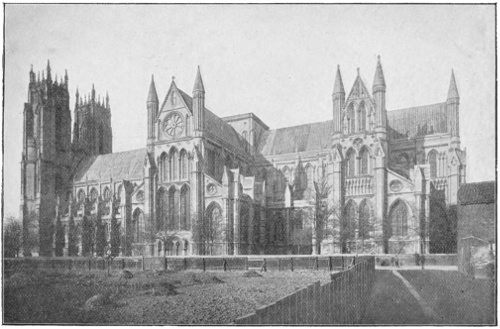
The Pride of the East Riding.
Beverley Minster from the South-East.
The illustrations have been moved to fall between paragraphs. Full page illustrations were counted in the pagination, but, given these adjustments, are unnumbered here. On several occasions, the order of the illustrations is reversed, to better follow the text. The page numbers in the table of illustrations serve as links to the correct locations.
The footnotes, which were marked using the typical symbols (e.g., asterisks), have been numbered consecutively for uniqueness, and placed following the end of the text. They are linked for ease of reference and navigation. On several occasions (44.8, 48.10, 59.13, 229.59), a single footnote is referenced multiple times in the text. The reverse navigation to the page will position the reader at the first of them.
Minor errors, attributable to the printer, have been corrected. Please see the transcriber’s note at the end of this text for details regarding the handling of any textual issues encountered during its preparation.
A typical Press Opinion.—"We have nothing but praise for this charming book. It has well been said that ‘to master thoroughly the story of the city of York is to know practically the whole of English history,’ and the authors of this new history have demonstrated the truth of this opinion. No pains have been spared by the publishers to give the letterpress a perfect setting; binding, paper, illustrations, and general finish are alike admirable."

The Pride of the East Riding.
Beverley Minster from the South-East.
The author wishes herein to acknowledge his indebtedness:—
(1) To the published works of local historians, and to the publications of local learned societies, into all of which he has delved, and from many of which he has ‘lifted’ such local records as it served his purpose to use.
(2) To Mr. John Bickersteth, of the East Riding County Council, for valuable help in the chapter on How the East Riding Governs Itself, and in the general planning of the book; to Mr. John Suddaby, for much information that is embodied in Chapters XXIV.-XXVII.; to the Wardens of the Hull Trinity House, and Mr. E. J. Heseltine for extracts from the records of the Trinity House; to Mr. J. H. Hirst, Hull City Architect, for the draft of the illustration on p. 167; and to Mr. W. G. B. Page, for revising the proofs of The East Riding Roll of Honour.
(3) To Col. Mark Sykes, M.P., Canon Grimston of Stillingfleet, Alderman John Brown, Dr. J. Wright Mason, Mrs. Watson, of Hedon, Mr. W. Morfitt of Atwick, the Curator of the Hull Museums, and others, for permission to take photographs of objects in their possession.
(4) To the Editor of the Transactions of the East Riding Antiquarian Society, the Hull Scientific Club, and the Hull Museum Publications, for the loan of several blocks; to xProfessor Collingwood and the Editor of the ‘Yorkshire Archæological Journal’ for the loan of blocks for the illustrations on pp. 55, 63, 64; to Mr. T. A. J. Waddington of York, and the Editor of the ‘Port of Hull Annual’ for that of the blocks used on pp. 236 and 248; and to the Head-Masters and Head Mistresses of the East Riding Schools for that of the blocks used in Chapter XXX.
(5) To his friend, Mr. E. Haworth Earle, and to his colleagues, Mr. C. Bazell and Mr. J. V. Pugh, for reading the proofs of the entire book and correcting many errors that would otherwise have escaped detection.
(6) To his friend and old pupil, Mr. C. W. Mason, for the great amount of time and care which he has bestowed upon the taking of special photographs.
(7) To the Publishers of the book, who have placed in his hands every possible facility for enriching its pages with whatever illustrations they thought would prove of interest, and who have thereby produced a book which it is hoped will reach the high-water mark of excellence in artistic production.
Hymers College, Hull,
1912.
| CHAP. | PAGE | |
| I. | WHAT THE EAST RIDING IS | 1 |
| II. | HOW THE EAST RIDING WAS MADE | 3 |
| III. | MEN OF THE STONE AGE | 8 |
| IV. | MEN OF THE BRONZE AGE—THE ANCIENT BRITONS | 20 |
| V. | MEN OF THE IRON AGE—THE ROMANS IN EAST YORKSHIRE | 29 |
| VI. | OUR ANCESTORS | 40 |
| VII. | HOW THE MEN OF THE NORTH BECAME CHRISTIANS | 47 |
| VIII. | THE COMING OF THE NORTHMEN | 56 |
| IX. | IN THE YEAR OF OUR LORD 892 | 65 |
| X. | TWO FAMOUS BATTLES OF LONG AGO | 74 |
| XI. | HOW THE NORMANS CAME TO YORKSHIRE | 85 |
| XII. | HOW OUR ANCIENT PARISH CHURCHES WERE BUILT | 95 |
| XIII. | THE BIRTH OF HULL AND THE ROMANCE OF THE DE LA POLES | 111 |
| XIV. | MONKS, NUNS, AND FRIARS | 123 |
| XV. | SAINT JOHN OF BEVERLEY AND HIS MINSTER | 135 |
| XVI. | SANCTUARIES | 145 |
| XVII. | HOW TWO KINGS OF ENGLAND LANDED AT SPURN | 155 |
| XVIII. | LIFE IN A MEDIÆVAL TOWN | 162 |
| XIX. | THE TRADE UNIONS OF THE MIDDLE AGES | 179 |
| XX. | THE SUPPRESSION OF THE MONASTERIES AND THE PILGRIMAGE OF GRACE | 188 |
| xiiXXI. | HOW THE GREAT CIVIL WAR BEGAN AT HULL | 202 |
| XXII. | HOW HULL WAS TWICE BESIEGED | 212 |
| XXIII. | SOME ANCIENT EAST RIDING FAMILIES | 223 |
| XXIV. | STAGE COACH AND RAILWAY | 238 |
| XXV. | ENGLAND’S THIRD PORT—THE MODERN GROWTH OF HULL | 253 |
| XXVI. | FAMOUS SONS OF THE EAST RIDING | 269 |
| XXVII. | SHIPS OF THE HUMBER | 284 |
| XXVIII. | FOLK-SPEECH OF THE EAST RIDING | 301 |
| XXIX. | HOW THE EAST RIDING GOVERNS ITSELF | 311 |
| XXX. | EAST RIDING SCHOOLS | 321 |
| XXXI. | THE EAST RIDING ROLL OF HONOUR | 344 |
| PAGE | |
| The Pride of the East Riding | Frontispiece |
| The Three Ridings of Yorkshire | 2 |
| One of the First Inhabitants of the East Riding | 4 |
| Relics of the Ice Age | 6 |
| Skull and Antlers of a Red Deer | 7 |
| Bone Implements and Weapons from Barrows on the Wolds | 9 |
| Section of Howe Hill, Duggleby | 12 |
| Polished Flint Knife found in Duggleby Howe | 14 |
| Flint Implement and Weapons | 15 |
| Unfinished Stone Adze Head and Whinstone Axe Head | 16 |
| Food Vessel from a Barrow on Acklam Wold | 17 |
| The Rudstone Monolith | 18 |
| The Earliest Kind of Axe used in East Yorkshire | 19 |
| Bronze Celt or Axe Head found at Swine | 21 |
| Plan of a Barrow on Calais Wold, and Ideal Restoration of the Site of Burial | 23 |
| British Gold Coin found at Atwick | 24 |
| How a British Chieftain’s Wife was Buried in Garton Slack | 25 |
| A British War Chariot | 26 |
| Earthworks at Skipsea Brough | 28 |
| Statue of a Roman Soldier in the York Museum | 30 |
| Section of a Roman Military Highway | 31 |
| Roman Roads Around the Humber | 35 |
| Roman Pig of Lead found at South Cave | 36 |
| Roman ‘Pens’ found at Brough | 36 |
| Relics of Roman Feasts found at Easington | 37 |
| A ‘Safety-Pin’ Sixteen Hundred Years Old | 38 |
| Design of the Pavement of a Roman Villa at Harpham | 39 |
| Iron Knife and Bronze Spoon from an Anglian Cemetery | 45 |
| Child’s Toys found in a Burial Vase at Sancton | 45 |
| ‘Finds’ in an Anglian Cemetery near Garton Gatehouse | 46 |
| Goodmanham Church (From an Old Engraving) | 52 |
| Two Sides of an Anglian Cross Shaft at Leven | 55 |
| Danish Settlements in a Portion of North Lincolnshire | 60 |
| Danish Cross Head at North Frodingham | 63 |
| Danish Sun-Dial built into the Wall of Aldbrough Church | 64 |
| Plan of the Battle of Stamford Bridge | 81 |
| Holderness in the Domesday Book | 93 |
| A Norman Font in Kirkburn Church | 96 |
| A Piscina in Patrington Church | 97 |
| Part of the Foundations of the Tower of Holy Trinity Church, Hull | 99 |
| xivFiley Church, Showing the Lines of the Original Roof | 100 |
| The ‘Beverley Imp’—St. Mary’s Church, Beverley | 101 |
| Different Forms of Arches | 103 |
| ‘Norman’ and ‘Early English’ South Doors | 105 |
| Part of the South Wall of the Church at Garton-on-the-Wolds | 106 |
| ‘Churchwarden’ Restoration at Welwick Church | 108 |
| A Grotesque ‘Poppy-Head’ at Holy Trinity, Hull | 109 |
| Brass of Thomas Tonge, Rector of Beeford | 110 |
| Arms of Kingston-upon-Hull | 111 |
| Silver Penny Coined at Hull in the Reign of Edward I. | 112 |
| Photograph of the Hull Charter | 113 |
| Effigies of Sir William and Dame Katherine De la Pole | 117 |
| Arms of the De la Poles | 118 |
| Common Seal of the Corporation of Kingston-upon-Hull | 119 |
| Seal of Edmund De la Pole | 121 |
| Pedigree of the De la Poles | 122 |
| Arms of Bridlington Priory | 123 |
| A Cistercian Monk | 124 |
| A Benedictine Nun | 125 |
| Plan of the Cistercian Abbey of Kirkstall | 127 |
| The Priory Church, Bridlington | 129 |
| A Corner of the Cloister Court at Kirkham Priory | 131 |
| The Bayle Gate, Bridlington | 132 |
| A White Friar in His Study | 133 |
| Arms of Beverley Minster | 135 |
| Beverley Minster in the Eighteenth Century | 137 |
| ‘Early English’ Doorway in the South Transept | 138 |
| Small ‘Decorated’ Doorway at the West End | 139 |
| Part of the Arcading on the South Side of the Nave | 141 |
| ‘Hey-diddle-diddle, The Cat and the Fiddle’ | 142 |
| Plan of Beverley Minster | 143 |
| Sanctuary Cross at Bishop Burton | 147 |
| The Beverley Frith-Stool | 150 |
| Sanctuary Knocker at All Saints’ Church, York | 151 |
| Henry of Lancaster’s Cross | 161 |
| Present Seal of the Borough of Hedon | 162 |
| North Bar Without, Beverley | 163 |
| Part of a Fourteenth-Century Plan of Hull | 165 |
| High Street, Hull | 166 |
| Sections of a Mediæval and a Modern Street | 167 |
| Parish Stocks preserved in Beverley Minster | 169 |
| Arms of the Hull Trinity House | 172 |
| A Miracle Play in the Olden Time | 174 |
| Noah’s Ark | 175 |
| A Fourteenth-Century ‘Show’ | 177 |
| Bear-Baiting | 178 |
| The Beverley Minstrels | 185 |
| Arms of the Hull Merchants’ Company | 186 |
| The Gateway of Kirkham Priory | 190 |
| Ruins of the East End of the Church | 191 |
| xvBadge of the Pilgrimage of Grace | 193 |
| Howden Church from the South | 196 |
| Howden Church—Ruins of the Chapter House | 198 |
| All that Remained of Meaux Abbey in 1900 | 201 |
| A Bird’s-Eye View of Kyngeston-vpon-Hvll, A.D. 1640 | 206, 207 |
| King Charles I. at the Beverley Gate, Kingston-upon-Hull | 211 |
| Sir John Hotham | 216 |
| Medal Struck in Memory of Sir John Hotham | 219 |
| Hull’s Water Gate | 221 |
| Wressle Castle | 225 |
| The Percy Tomb, Beverley Minster | 230 |
| Burton Constable Hall | 232 |
| Brass of Sir Thomas de St. Quintin in Harpham Church | 233 |
| Burton Agnes Hall | 234 |
| Effigy of a Knight in Plate Armour at Swine | 235 |
| Effigy of a Knight in Chain Armour at Howden | 236 |
| Coat-of-Arms of the Stricklands | 237 |
| On the Road in 1812 | 238 |
| Hull and York Coaching Bill, A.D. 1787 | 241 |
| Coaching Roads and Early Railways | 243 |
| Pistols and Holsters formerly used on the Hull and Patrington Coach | 245 |
| The First Time-Table of the Hull and Selby Railway | 248 |
| The Hull and Beverley Stage Coach | 251 |
| On the Road in 1912 | 252 |
| Whitefriargate Bridge and the Victoria Square, Hull | 255 |
| Plan of Docks West of the River Hull | 258 |
| Plan of Docks East of the River Hull | 259 |
| The Wilson Liner ‘Eskimo’ Getting up Steam | 260 |
| Grain Ships Discharging their Cargoes | 261 |
| Agricultural Machinery on the Way to Russia | 264 |
| A Steam Trawler | 265 |
| N.E.R. Riverside Quay | 267 |
| The Garden Village, Hull | 268 |
| John Alcock, Bishop of Ely | 270 |
| John Fisher, Bishop of Rochester | 272 |
| Andrew Marvell | 273 |
| Birthplace of William Wilberforce | 275 |
| William Wilberforce | 277 |
| Sir Tatton Sykes | 281 |
| Charles Wilson, First Baron Nunburnholme | 282 |
| Arthur Wilson | 283 |
| An Ancient ‘Dug-out’ found in North Lincolnshire | 285 |
| A Viking Ship on a Church Door | 286 |
| Ancient Seal of the Corporation of Hedon | 287 |
| English Warships in the Time of the Armada | 289 |
| A News Sheet of 1837 | 291 |
| The Hull Whaler ‘Truelove’ | 293 |
| The First Steamship Built on the Humber | 295 |
| A Humber Pilot Boat | 297 |
| xviShips Old and New—The ‘Southampton’—‘Bayardo’ | 299 |
| Entrance to the Old Harbour | 300 |
| Ancient Arms of Beverley | 311 |
| Modern Arms of Bridlington | 313 |
| Local Government Areas in the East Riding | 314 |
| The Hedon Mace—the Oldest Civic Mace in Britain | 316 |
| Crest of the East Riding County Council | 318 |
| Council Chamber at the County Hall, Beverley | 320 |
| Arms of Beverley Grammar School | 322 |
| Arms of Howden Grammar School | 322 |
| Arms of Bridlington Grammar School | 323 |
| Arms of Hull Grammar School | 324 |
| Arms of Pocklington Grammar School | 325 |
| At School in the Fourteenth Century | 325 |
| Part of the Seal of a Lincolnshire Grammar School | 326 |
| Ancient Cock-Fighting Bell of Pocklington School | 328 |
| A Boys’ Play-Ground in the Seventeenth Century | 330 |
| The Old Grammar School, Hull | 333 |
| The High School for Girls, Bridlington | 335 |
| Seal of the Girls’ High School, Hull | 336 |
| Bridlington Grammar School | 339 |
| Arms of Hymers College | 340 |
| Hymers College | 341 |
| A Typical School on the Yorkshire Wolds | 342 |
| A Modern City Council School | 343# |
| Map of the East Riding of Yorkshire | End Cover |
That an English county which is nearly as large as the ancient kingdom of Wales should become divided into separate portions for the purposes of local government is only what one would expect. But it is not obvious why the number of these portions should be three, and there is even an air of mystery about the name given to them. ‘North Riding,’ ‘West Riding,’ ‘East Riding’—what is this word ‘Riding’?
For the answer to this question we must go back many centuries, to the time of the hardy Norsemen who, as we shall see, settled in such large numbers in Yorkshire and Lincolnshire. It was common among the Norsemen of old to divide lands into three portions for the purposes of government, and their name for each portion was thrithjungr.[1]
This mysterious word means in our tongue ‘a third part,’ and from it arose the English word Thriding as companion to feorthing, another word which we use to-day in a very slightly altered form. But the difficulty of pronouncing distinctly and easily the combination ‘North Thriding’ is 2evident, and the troublesome word suffered the same fate as commonly then befell the troublesome man—it got, quite naturally, beheaded.

The Three Ridings of Yorkshire.
A glance at the small map on this page will show how the county of Yorkshire is divided. By no means are the three Ridings equal in area, the East Riding being far the smallest. In order of size they stand as follows:—
| West Riding | 2,766 | square miles. |
| North Riding | 2,128 | " " |
| East Riding | 1,172 | " " |
| —-—-—-—-—-—-— | ||
| 6,066 | square miles. | |
3The map shows another point of contrast between the three Ridings. Whereas the West and North Ridings have numerous ranges of hills and correspondingly numerous water-channels, the East Riding is, with the exception of its northern extremity, an eastward extension of the ‘Vale of York’ and very nearly as flat as the proverbial pancake. Its only rivers are the Hull and the Derwent, and the latter for more than half its course forms the boundary of the Riding.
An uninteresting part of the county it looks to be, does it not? But, nevertheless, it has an interesting history behind it, and men and women have been born and bred in it—men and women who have helped to make our country what it is to-day. Who they have been, how they have lived, and what they have done in the ages before we ourselves were born, it is the purpose of the following pages to show.
Stand on the very highest point of the white limestone cliffs that stretch northwards from Flamborough Head, and realise that you are standing on what was once the bed of the sea.
Strange though this be, it is nevertheless true. Countless ages ago what now towers up 450 feet above sea-level had over it the ceaseless rolling of the waters of the ocean, and during countless ages it was slowly formed out of the shells and teeth and bones of the creatures that lived in these waters.
Men who know tell us that the layer of chalk at the bottom of the ocean to-day is composed principally 4of the remains of creatures so minute as to be visible only by the aid of a microscope, and that this layer grows in thickness at the rate of not more than one-tenth of an inch per year. They tell us also that the layer of chalk which extends under our county is not less than 1200 feet in thickness, and thus a simple calculation will help us to form some idea of the extent of time necessary for its formation. But however long this time actually was, it came to an end with a tremendous upheaval of a portion of the ocean bed, and the formation of a new area of ‘dry land.’
All the coast line of the East Riding, however, does not consist of chalk cliffs. North of Bempton and Speeton lie cliffs of sandstone and clay, which have yielded the fossil remains of living beings that once inhabited the water and the shore. Such are the belemnites and ammonites—the ‘thunderbolts’ and ‘St. Hilda’s snakes’ we may have heard them called—and the Ichthyosaurus, whose skeleton was recently discovered embedded in the clay cliffs at Speeton and may now be seen in the Hull Museum. Not a very handsome gentleman in the flesh he must have been, unless appearances are deceptive.

One of the First Inhabitants of the East Riding.
Actual length about twelve feet.
Again, walk southwards from Flamborough Head, and the chalk cliffs are found to get less and less in height until 5they disappear altogether, and their place is taken by cliffs of clay. Then these disappear, and are succeeded by the long, flat bank of sand and shingle which is known as Spurn Point; and if we round this point and follow the river bank, we find it nothing but mud and clay until we get past the mouth of the river Hull. At Hessle the chalk cliffs break out once more, and we know, from investigations, that the bed of chalk comes to the surface completely westwards of a line drawn from Flamborough to this point.
Draw on a map of the East Riding a line from Sewerby, through Driffield and Beverley, to Hessle, and you are drawing the line of the old sea-beach when the upheaval previously mentioned had taken place. This was the shore of a land inhabited by races of animals now found living only in tropical regions. The elephant, rhinoceros, hippopotamus and hyena ranged the land for food, and bones of these creatures have been found in considerable numbers in the caves that exist at Kirkdale in the North Riding.
Then came a great change. The climate of Northern Europe became colder and colder till there prevailed what scientists call the ‘Great Ice Age.’ This was the time of formation of huge glaciers which spread from the mountains of Scandinavia, Scotland, and north-west England southwards and eastwards into the sea, until they met and made its whole area a slowly moving mass of ice. With the ice were carried sand, gravel, clay, boulders torn from projecting rocks, and bones of Arctic animals, such as the walrus, the reindeer, and the Irish elk; and as the ice gradually melted, all these were deposited at the base of the line of chalk cliffs, or even on the summit of the cliffs where these were low. From the gravel pits at Burstwick excavations of ballast for the embankments of the North Eastern Railway brought to light animal bones in such 6quantities that many tons were sold to chemical manure manufacturers, and it is probable that many tons still remain undiscovered.

| Photo by] | Relics of the Ice Age. | [C. W. Mason |
A walrus tusk from Kelsey Hill and the tooth of a mammoth from the cliffs at Atwick.[2]
In this way was formed the ‘great mass of gravel, clay, and sand ... east of the Yorkshire Wolds’ which we know as the Plain of Holderness. Here is what one of our foremost local geologists has to say of its beginnings:—
‘Let us imagine the probable appearance of East Yorkshire on the final melting of the ice. Huge fans or sheets of gravel occur at Bridlington and other places as a result 7of the floods. Rounded hillocks of gravel and clay stand out in all directions; the hollows in between are filled with water, forming miniature lakes or meres. Of animal or plant life there is little or none. The climate gradually becomes milder; at first Arctic plants and animals exist in small numbers. Later, the margins of the meres become clothed in vegetation; peat is eventually formed, and huge trees of Oak and Fir thrive. The Red Deer, Beaver, Short-horned Ox, Otter, and Wild Horse, haunt the woods, and finally primitive man makes his appearance.’

Skull and Antlers of a Red Deer found in the Hornsea
Peat-bed.
What sort of man was it who first inhabited Holderness and how did he live? Artists in his day were few and far between, and the few who did exist in Europe gave pleasure to themselves and to their companions by drawing portraits of reindeer and horses on pieces of bone. To draw portraits of their fellows was probably the last thing they would think of doing. Reindeer and horses are graceful creatures, but the artists’ fellows were anything but graceful.
As far as we know, the first inhabitants of Holderness were a race of short, dark-haired men, who depended for their food and clothing on the animals of the forest and the mere, who pursued their prey and fought one another with weapons of stone, and who lived in dwellings built on piles driven into the bed of a lake in exactly the same way as the New Guinea islanders live to-day.
Something definite about their dwelling-places we know; for what is appropriately called a lake-dwelling was discovered thirty years ago at Ulrome. This was a structure made of tree trunks laid side by side and held together by piles driven into the bed of what was then a large mere.

Bone Implements and Weapons from Barrows on the Wolds.
| A, B. | Hammer head and pick made from the shed antlers of a red deer (1/1, 1/4). |
| C. | Bodkin or needle (1/1). |
| D. | Dagger made from a man’s thigh-bone (1/3). |
On this rough sort of platform, which measured 90 feet by 60 feet, dwelling-places had been constructed, and a ‘popular watering-place’ it must have been; for there was evidence that it had been built in the first place by a race of people whose tools were of flint and bone, and that this race had been ousted many years later by another more advanced race who had weapons and tools of bronze. That the dwellers here were mighty hunters and mighty eaters was proved by enormous accumulations of animal bones 10under and around the platform. That they were also cannibals is likely from the presence of human bones among this refuse.
So much for the ‘lake-dwellers’ of Ulrome. Up on the Wolds there were men living a somewhat different life. These hunted and ate the same kinds of creatures, and they used the same kinds of weapons, but their dwellings were dug out of the soil—shallow circular or elliptical pits each covered over with a conical roof of branches and turf, supported on a central post; or deeper troughs covered over with sods and scrub laid on slabs of chalk, so that the roof was level with the surrounding earth and indistinguishable from it.
Of the former kind of pit-dwelling an example has been discovered in the hollow known as Garton Slack, the pit measuring rather less than 9 feet by 6 feet in length and breadth, and 5 feet in depth; while one of the latter kind has come to light under Kemp Howe, a few miles north of Driffield.[3] The underground chamber here measured 25 feet by 4½ feet, had a depth of 6 feet at its deeper end, and was approached by a sloping passage 11 feet in length, the entrance to which would doubtless be hidden with scrub. The roof had been supported on six upright posts, and for twelve feet along one side of the chamber ran a stone ledge—this last being evidently a luxury.
It is probable that these two kinds of dwellings may have been respectively the summer and winter houses of the same people. For the Roman historian Tacitus says of the ancient tribes on the other side of the North Sea:—
11Besides their ordinary habitations, they have a number of subterranean caves, dug by their own labour and carefully covered over with soil, in winter their retreat from cold and the repository for their corn. In these recesses they not only find a shelter from the rigour of the seasons, but in times of foreign invasions their effects are safely concealed.
Of the men who lived on the Yorkshire Wolds we know a great deal; for it was their custom to raise over the burial places of their chiefs circular mounds of earth, some still very large, others now only a foot or two high. The relative size of a burial mound, which we speak of either by the Latin name tumulus or by the English names barrow and howe, marks the importance of the chieftain whose body or ashes once lay under it.
These tumuli, or barrows, are very plentifully strewn over the Yorkshire Wolds, and for more than fifty years the late Mr. J. R. Mortimer, of Driffield, devoted all his leisure time to their excavation. The results of his labours are to be seen in his private museum—the Mortimer Museum—and details of his ‘finds’ are recorded in his large book on the Burial Mounds of East Yorkshire, some of the illustrations in which are here reproduced.
A general idea of how a barrow has been constructed, and of what it may contain, can be gained from the illustration on the next page.
Howe Hill, Duggleby, is one of the larger barrows, built on a sloping hillside, and having at its base a diameter of 125 feet and at its flattened top one of 47 feet.

Section of Howe Hill, Duggleby.
| A-K. Skeletons in position as buried. | |
| O. Cremated remains. | Y. Band of blue clay impervious to water. |
| W. Inner mound of clay. | Z. Outer mound of chalk. |
| X. Bed of chalk grit. | * Probable summit of the barrow when built. |
From the diagram we see that the bodies first interred have been placed at the bottom of a cavity dug out of the solid chalk. This hole not proving large enough for the numbers to be buried, an extension has been 12begun, but not finished. Time was evidently pressing, for some bodies have been buried above the surface of the 13ground. They have been placed in different positions, but the legs of all have been bent at the knees and all are enclosed in a low mound of clay. Above this lie the remains of numerous other bodies, which have been burnt before burial; and over them comes a twelve-inch layer of a blue clay which is impervious to water. Then a large mound of soil and pieces of chalk has been raised over all, the mound being originally much higher than it is to-day.
Such has been the building of Howe Hill. But it must not be thought that all barrows contain the remains of a large number of bodies. Most contain one only, and the body has either been buried as it was when life left it or been burnt and the calcined bones gathered up in an earthenware vessel, or pinned in a skin garment. The eight full-grown skeletons discovered under Howe Hill are those of men, and we may suppose that they represent a chieftain and his relatives killed in the onslaught by a hostile clan. The cremated bodies, forty of which were discovered in the digging of a trench through the barrow, would be those of his dependants, who died fighting in defence of their lord and master.
But the barrow contains evidence of the lives of the people of the time as well as of their deaths. Scattered through the soil under the band of blue clay were found many broken bones of the ox, roebuck, red deer, fox, goat, and pig, the remains of the burial feast; and among these were human bones which had quite evidently been broken and cooked. It is horrible to think of the people of our East Riding as having once been cannibals, but the evidence to that effect is indisputable.
Here and there were also found portions of the weapons with which the defenders of the settlement had fought—the 14hammer head shown on page 9, made from the shed antler of a red deer, and the broken javelin head of flint shown on page 15. In this barrow was also found the wonderfully made flint knife represented below—an implement fashioned out of a piece of flint with no other tools than such as are mentioned below, and yet fashioned so delicately that its greatest thickness is only one-sixteenth of an inch.

Polished Flint Knife found in Duggleby
Howe (1/1).
A clever workman he must have been who made this wonderful knife. But such beautifully wrought implements are very rare. Only one similar knife—found in a barrow at Aldro—was known to its discoverer, and he had himself superintended the excavation of no fewer than two hundred and eighty-eight barrows.
The weapons and tools which have been buried with their owners are more commonly of the rougher types figured on the opposite page. They include knives, chisels, spear heads, saws, and arrow heads, all made from flints by the processes of chipping and flaking, with hammer heads, picks, needles and daggers of bone.
15Compare the figures A and B given on page 9 with the illustration of the antlers of a red deer on page 7, and see how cleverly the hammer head and the pick have been fashioned. Equally clever has been the adaptation of a bone in the making of the very primitive dagger figured at D on the same page. But in this case it has been not the antler of a red deer that has been brought into use, but the thigh-bone of a man.

Flint Implement and Weapons.
A. Chisel from Aldro (1/1). B. Barbed arrow head from
Grimston (1/1) C. Javelin head from Duggleby Howe (1/1).
So far we have spoken of weapons and implements of bone and of flint. Others were then in use made of whinstone and greenstone, such as the axe heads figured overleaf. Notice the different arrangement of the cutting edge in these two implements, and notice also that in the first one the hole intended for the insertion of a wooden 16handle has, for some reason or other, not been finished. Perhaps the maker was killed before he had time to finish it, or perhaps he grew tired of his work and threw it away. At any rate this unfinished adze head was found loose on the surface of the ground, and not buried under a howe as was the other.
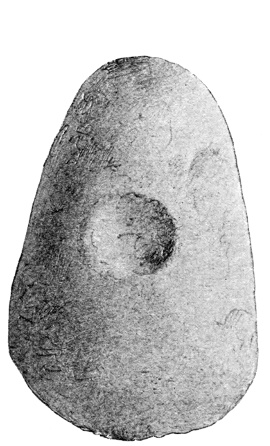
Unfinished Stone Adze Head
picked up on Acklam Wold (1/1).
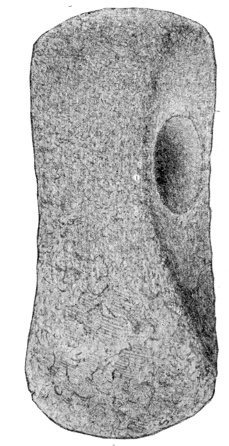
Whinstone Axe Head from
a Barrow on Calais
Wold (2/3).
Weapons and implements of stone! May we not justly call their makers Men of the Stone Age? They lived before man knew how to dig metals from the earth, and how, having obtained them, to melt and mould them to his wish.
17But besides these weapons which have lain buried with their owners for some thousands of years, there are yielded up by the barrows earthenware vessels of different sizes and shapes. Some, like that shown below, are wide-mouthed and have a thick rim; others are narrower, and their rim is not thickened. Then others have an overhanging rim; and others, again, are small, only an inch or two in height, and have from two to six holes perforated in their sides. All are marked with simple patterns, made by pressing the pointed end of a stick or the thumb-nail into the moist clay, or by pressing round it a twisted thong of hide. There has been no glazing and no attempt to make use of artificial colour.

Food Vessel from a Barrow on Acklam Wold (1/2).
Each of these vessels has had its particular use. The 18first-named vessels, which are by far the most common, are always found to be stained with some decomposed matter on the inside of the bottom, and their use has undoubtedly been as food vessels. So also we may consider the second group to be drinking vessels. The food and drink which these two contained when they were buried have been intended for their owners in the new life to come, when food and drink would be again required. The vessels of the third kind are always found to contain remains of a body which has been cremated before burial—hence their name cinerary urns—and the last-named and smallest, which are found with them, have probably been used to hold the precious spark of fire which lit the funeral pyre.

The Rudston Monolith
19Let us leave these howes and barrows and examine another example of the work of the Men of the Stone Age. Close to the wall of the village church at Rudston stands a huge upright stone, or monolith. Twenty-five feet is its height above the ground, and sixteen feet its girth, while it is said to be embedded in the ground as deep as it is high above the surface. Its weight is estimated as not far short of forty tons. What is it doing in a village churchyard, and who put it there? When and how was it placed where it now stands?

The earliest kind of Axe used in East Yorkshire.
It is impossible to give any definite answers to these questions. A century ago, however, the village people answered them all very easily. The Devil, they said, objected to the building of the church, and flung this stone to destroy it before its completion. But his aim was not so accurate as it was intended to be, and the missile missed its mark. Asked for a proof of their wonderful story, they would point to the stone itself. There it was for everyone to see. What further proof could be needed?[4] Whether we believe this legend or not, two things are certain. First, that the stone is as old as the barrows in the surrounding wolds; secondly, that there is no rock 20of the same nature nearer to it than Filey Brig and the Brimham Rocks. Was it brought down by the great ice sheet and then erected by the men of the Stone Age to serve some purpose in their heathen rites, or did they bring it up from Filey or down from the hills of the North Riding on wooden rollers? Perhaps it is not more difficult to conceive of their doing this than of their raising such a huge barrow as that which stands unopened at the foot of Garrowby Hill—a mound 250 feet in diameter at its base and 50 feet in height.
With the coming of Julius Caesar to Britain in the middle of the first century before the birth of Christ, we reach the time in the history of our country when definite facts about its people begin to be recorded.
Thus we know from Caesar’s own writings that the Britons lived in houses like those of the Gauls, that they had great numbers of cattle, that they used copper coins, that many of the inland tribes did not grow corn but lived on milk and flesh and went clothed in skins, that in war time they dyed their bodies with a blue stain to give them a more terrible aspect, and that they wore long hair on their heads and their upper lips.
So also, with regard to their religion, Caesar tells us that their priests were called Druids; that if any crime had been committed, or if there were any dispute about an inheritance or a boundary, it was the Druids who gave judgment; 21that they had vast stores of learning, all of which was committed to memory and none committed to writing; and that their chief doctrine was that the soul of man did not perish, but passed after death into another body, so that no man should fear death.

Bronze Celt or Axe Head found at Swine.
From these accounts we see that there had been great progress made since the times described in the last chapter. This was due to the migration westwards of a new race of people—the Kelts—who had gained a knowledge of the use of metal, and who, consequently, had weapons and implements made of bronze instead of stone. Their greater knowledge gave them greater power, and the extinction of the men of the Stone Age was only a question of time. For not often was the bronze-weaponed warrior slain by a weapon of stone.
But the account written by Julius Caesar refers to the inhabitants of the southern parts of our island. ‘Many of the inland tribes do not grow corn, but live on milk and flesh and go clothed in skins.’ This passage may be taken as true of the tribes living north of the Humber, known—so later Roman writers tell us—as the Brigantes, the wildest and most savage of the tribes inhabiting Britain.
Let us see what Mr. Mortimer’s discoveries have to tell us of these Brigantes. The most interesting discovery, perhaps, was that made in a barrow on Calais Wold, the highest point of the Yorkshire Wolds, 807 feet above sea-level. Here, on the mound being removed, a double row of stake-holes was exposed in the surface of the ground. These were from 3 to 15 inches in diameter, and were arranged in circles having diameters of 21½ and 28 feet. Outside these were four other stake-holes, and beyond these again a 22circular trench 100 feet in diameter, 3 feet 9 inches deep, 9 feet across at the top, and 1 foot across at the bottom. Within the double circle of stake-holes was a cavity cut in the chalk and containing a skeleton lying on its side, with its knees bent.
The plan on the opposite page shows the arrangement exactly, and the drawing which accompanies it gives Mr. Mortimer’s clever conjecture of the meaning of the stake-holes. The space enclosed between the inner and outer walls would be used, Mr. Mortimer thought, as a storage place for food, skins, and weapons. It would also serve to keep the inside living-room warm in winter.
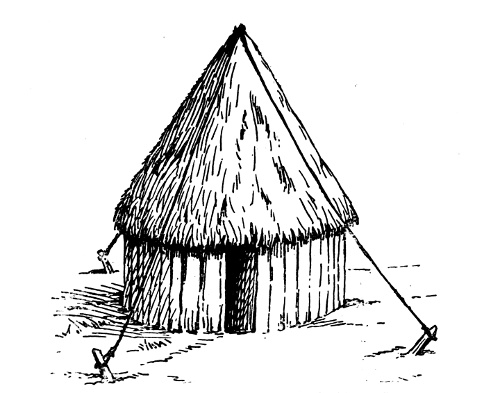
Ideal Restoration of the Site of Burial.
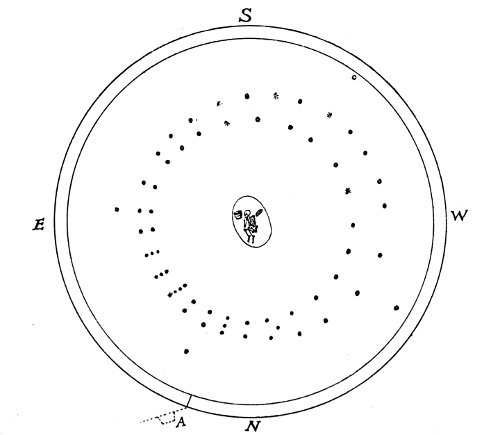
Plan of a Barrow on Calais Wold, showing the Encircling Trench and Stake-holes.
‘We will bury our chieftain in his home, which no one after him shall have power to defile.’ So, probably, thought those who buried him. But, if so, time has played them false; for men of a race undreamt of and speaking a tongue of which he would understand hardly one word, have ruthlessly laid bare his burial place, and have carted away his bones to be measured with tape and pencil, and his skull to have its brain cavity estimated with grains of millet seed. What an insult added to injury!
A mighty chieftain he had doubtless been, and it must be his favourite weapon that lies buried with him, so placed that he should be buried as he slept—grasping its handle firmly in his right hand. One wonders how many of his enemies’ skulls that weapon of his had beaten in before its master ceased to use it. Perhaps it had been wielded against the Roman legions brought north of the Humber by Ostorius Scapula in A.D. 50. Who knows? If you would see the head of the weapon you must go to the museum at Driffield; its likeness you will find on page 16.
The Brigantes buried their dead chiefs just as the earlier tribes had done, and the photograph on page 25 shows very clearly the curious way in which the legs were doubled and 24the head bent back. This skeleton was obtained from a barrow in Garton Slack, and here is what its discoverer says of the pains taken to obtain it:—
‘Being desirous of possessing this skeleton in its entirety, we obtained a quantity of stiff, mortar-like material, scraped from the adjoining high road, with which we covered the remains, in order to keep all the bones in position. We then passed three broad pieces of sheet iron under it without displacing any of the bones. The remains were then lifted on a prepared board, and conveyed to Fimber. After being carefully cleaned, the skeleton was mounted in a glass case, and now, with its relics, and part of the ground on which it was found, forms a highly interesting relic in the museum at Driffield.’
The skeleton is that of a woman, and with it, you will notice, are two objects. There is no need to say what has been the use of the bone ornament lying behind the head, but the use of the flint implement placed before the jaw is not so obvious. This is one of a class of implements known to us as scrapers—roughly chipped pieces of flint used by the women of a household in scraping the insides of animal skins when preparing them for human wear, and in scraping the roots that went into the ‘stock-pot’ with the flesh of the animals that provided also garments and beds for the household.

How a British Chieftain’s Wife was buried in Garton Slack.

| Photo by] | [C.W. Mason |
| British Gold Coin. | |
| Found at Atwick by Mr. W. Morfitt (1/1). | |
In neither of these two barrows was there any sign of a bronze implement. Weapons and implements of bronze are rare among those found in the barrows of East Yorkshire, and the few discovered are dagger or knife heads and prickers. The Brigantes were far behind the Britons of the south in their knowledge of the use 26of metal; and at the time when the latter were making use of bronze, the wild and savage tribes of the north were content still to make use of greenstone and flint.
Personal ornaments, too, are rare, and were found accompanying only fifty-seven out of eight hundred and ninety-three burials that Mr. Mortimer excavated. They include dress-fastenings, such as rings and links of jet, and buttons of amber, jet and bone. With only one British interment was gold found, and of silver ornaments none were discovered at all.

A British War Chariot.
Especially interesting to a Yorkshireman are the discoveries of what are called ‘chariot burials.’ The Britons were renowned for their war-chariots, of which the chieftain Caswallon is recorded to have had 4000 when he fought against Julius Caesar. To the Briton himself 27his chariot was known as an essa, a word which his Roman conquerors latinised as essedum. An essedum was drawn by two horses, and driven by a charioteer who was very expert at running out along the pole between the horses. The essedarii, or charioteers, were held in high esteem among the tribal armies, and when they happened to be captured by the Roman soldiers were great favourites among the spectators of the gladiatorial shows.
On the death of a British chieftain who was a renowned chariot warrior, it was the custom for him to be buried in his chariot together with his horses and their trappings; and the East Riding has given more evidence of this custom than any other part of our country of equal area. The ‘Yorkshireman’ even then, it seems, loved a horse.
Remains of British chariot burials have been discovered at Hesselskew and Arras, near Market Weighton; at Beverley Westwood; at Danes’ Graves; and, most recently, at Hunmanby. In all these instances there have been interred two horses standing in their harness, and in the barrow opened at Danes’ Graves in 1897 there were two human skeletons, proving that in this case the charioteer, as well as his chieftain, was buried.
Of course in all these interments the remains of the chariots themselves have been small, little existing but fragments of the bronze naves and iron rims of the wheels, and of the bridle bits of the horses. But these have been sufficient to show that the diameter of the wheels varied from 2 feet 8 inches to 2 feet 11 inches, and that the horses themselves were of a much smaller breed than those of to-day.
With three, at least, of these chariot burials, were also found remains of an iron mirror, a thing not found elsewhere. We are accustomed in these days of motor-cars to make use of mirrors for a knowledge of what is happening 28on the road behind the driver, and these remains point to a similar practice among the charioteers of the Brigantes. Really we are not, perhaps, so far advanced in the twentieth century as we thought we were.

| Photo by] | Earthworks at Skipsea Brough. | [C.W. Mason |
Further evidence of the Brigantes in the East Riding is to be seen in the wonderful series of entrenchments that are so noticeable in the Wold districts. Dikes, double dikes, and treble dikes once covered the whole of the Wolds, says Mr. Mortimer; in fact, in the area of 75 square miles which he explored there are 80 miles of earthworks existing to-day. These consist sometimes of one ditch and one rampart only, but commonly of three ditches and four ramparts; and in one case, in the neighbourhood of Huggate, the entrenchment consists of a series of six parallel ditches and seven ramparts.
By far the most remarkable of these ancient entrenchments is the so-called ‘Danes’ Dyke,’ which, 2½ miles in length, cut off the rocky promontory of Flamborough Head, 29and converted it into an impregnable fortress 5 square miles in area. In making it, advantage was taken of a natural ravine—a relic of the Ice Age—which ran down to the south; but in its northern portion, where the ground was naturally level, a huge ditch roughly 60 feet wide and 20 feet deep was dug, the soil from this being thrown up to form a dyke or rampart on its eastern face.
At Skipsea Brough, near Hornsea, may be seen other British earthworks, consisting of a central mound 70 feet high, having a flat top one acre in extent, and covering altogether an area of 5 acres, together with a series of entrenchments forming the segment of a circle. The outer rampart is half a mile in length. Other much smaller earthworks exist at the ‘Castle Hill,’ Sutton, and the ‘Giant’s Hill,’ Swine.
In the last chapter we saw that the later Britons had some knowledge of iron, as well as of copper and tin. But with the Romans the use of iron was much more extensive, and hence they may be called Men of the Iron Age.
The first Roman general to enter the territory of the Brigantes was Ostorius Scapula, who came north in A.D. 50. Twenty-eight years later came Julius Agricola, who penetrated as far north as the rivers Forth and Clyde. By Agricola the ancient British camp Caer Eburac—the camp on the Ebura, or, by its modern name, the Ure—was 30made into a Roman walled city under the latinised name Eburacum.
From this time Eburācum,[5] or Eborācum as later Roman writers spelt its name, became the proud capital of Britain—altera Roma, a second Rome in importance. Here died the great Roman Emperor Severus in A.D. 211, and here was born the still greater Emperor Constantine, under whose reign Christianity was established in the Roman Empire.

Statue of a Roman
Soldier in the York
Museum.
For nearly three and a half centuries the Roman armies ruled the land of the Brigantes, during which time great alterations were taking place in the lives of its people. Northwards came troop after troop of German and Italian soldiers to subdue and enslave the people of the land north of the Humber, and to wage incessant war against Rome’s enemies still farther north. And southwards marched troop after troop of the men of the Brigantes, on their way to Gaul and Italy and Spain, there to serve as Roman soldiers. In A.D. 117 came to Eboracum the famous Sixth Legion—Legio Sixta, surnamed Victrix, the ‘All Conquering’—and Eboracum was its headquarters thenceforth till A.D. 406, when it was withdrawn to help in defending Rome against the enemies mustering on her threshold.
For the constant movement of troops the Roman invaders needed roads, and the military highways which they 31constructed across Britain remain foremost among the evidences of their occupation of the country. The fact that their roads have existed for so many centuries—centuries of hard use but of constant neglect—is due to the great care bestowed upon their construction.
When a Roman road was made, the first thing done was to mark out its course by the digging of two parallel ditches. This course was from 15 to 21 feet wide, and on it as the gremium, or foundation ground, was placed a layer of large stones 5 inches deep. This, known as the statumen, was followed by a fifteen-inch layer of broken stones cemented with lime. The rudus thus formed was succeeded by the nucleus, a similar layer 10½ inches thick and constructed of small fragments of brick and pottery. Last came the pavimentum, made of large irregularly-shaped blocks of very hard stone fitted together and cemented with lime so as to form a perfectly even surface. The pavimentum was 5 inches thick, thus making a solid road raised about 3 feet above the level of the surrounding land.

Section of a Roman Military Highway.
Such was the usual method of construction of a Roman highway. Where the natural surface of the ground passed over was hard rock, the two lowest layers, or strata, were dispensed with; but where no safe natural foundation existed, the labour was increased by the driving of piles into the soft ground to afford this.
Over hill and down dale were constructed these wonderful 32roads. No obstacle save an impenetrable marsh or an unbridgeable river baulked the Roman engineer; and the outward distinguishing mark between the Roman road constructed sixteen centuries ago and its modern successor is often the fact that whereas the latter goes round a hill, and thus makes things easy for the traveller, the former climbs in a straight line right over the summit.
What engineering skill the Romans must have possessed to build their roads! Straight from one military station to another miles distant over the hills did they succeed in driving their road. How did they judge its direction so accurately? We know not. And what immense labour was needed for the construction of their roads! Think of the cohorts of Roman soldiers engaged in building them, and of the slave-gangs of Britons toiling under the lash of the task-master as they quarried the materials for the use of the soldiers working many miles away. So hard was the work of the Roman soldiers in Britain, we read, that they ‘wished for death to relieve them from their insupportable toil.’
But human life stood for little in those days. What Roman engineer cared whether thousands of lives were spent in the making of his road? His one concern was to build it in such a way that for centuries to come the Roman legions should be able to march, and the Imperial Post to ride, along its hundreds of miles at the greatest possible speed. One hundred and sixty-five English miles were covered by Caesarius, a Roman magistrate, in the space of one day on a journey from Antioch to Constantinople, the whole distance of 665 miles taking less than six days. There is little wonder that Rome had become ‘Mistress of the World.’
Let us now see what the Roman road-makers did in East Yorkshire. Stretching north from Londinium ran the 33military highway known in later times as Ermin Street. At Lindum Colonia this branched in two directions, both branches meeting eventually at Eboracum. Skirting the impassable marshes around the meeting-places of the Yorkshire rivers and the Trent, one branch reached Eboracum by bridges or fords across the Trent, the Don, the Aire, and the Wharfe, where now stand Littleborough, Doncaster, Castleford, and Tadcaster. The crossing-places were protected by military stations which have since grown into these towns.
But directly north from Lincoln the second branch reached the Humber at Winteringham, whence the river was crossed by ferry to Brough, where also was a military station, named Petuaria. From Brough to York the road passed through South Cave, South Newbald, Houghton Woods, Thorpe le Street, Barmby Moor and Stamford Bridge. Along this second branch would travel the Roman Emperors and Generals, the Imperial Post, and the slave-carried litters and chairs of the Roman aristocracy; round by the former would march the foreign troops drafted to Eboracum to replace the wastage in the Sixth Legion, and the British levies on their way to fight and die in other parts of the Roman world.
At South Newbald this Roman road branched to the right, passing by Londesborough, Warter, Millington and Acklam, to a camp at Old Malton. From Stamford Bridge eastward ran another road by Garrowby, Fimber, Cottam and Kilham to a Roman station on the cliffs at Sewerby. Higher up on the Wolds ran an alternative route by Fridaythorpe, Sledmere, Octon and Rudston. These two roads are to-day known as the Low Street and the High Street.
Smaller roads ran from Stamford Bridge to Old Malton, and from the latter to Fimber and possibly farther south 34in the direction of Beverley. Round the coast from Bridlington there was probably a road—long since washed away—to a military station on the headland which then existed about a mile to the east of the present Kilnsea.
In North Lincolnshire Ermin Street is a typical Roman military road, and for the greater part of its course it is to-day the ‘king’s highway.’ But its northerly portion has, since the establishing of the Ferry at New Holland, been disused, and is now but a green lane, whose very surface is lost to view as we approach the Humber.
When we enter the territory of the Brigantes the road is not so distinguishable, and its course is in some parts uncertain. But even then the name of ‘Street’ given by the successors of the Romans to the Roman paved way—the way made of strata—survives; and on the map of the East Riding we shall find Garrowby Street, Humber Street, Wharram le Street, and Thorpe le Street, each name being significant of a Roman road. In some instances the road itself has been uncovered, as in the building of Drewton Bridge 60 years ago, and in building operations at Londesborough Park, where it was found to be 24 feet wide, and to show plainly the marks of wheeled carriages.
At many places in the East Riding have been discovered evidences of Roman commerce and domestic life. Bronze and silver coins buried in vases or boxes have been unearthed at Cowlam, Warter, Nunburnholme, Skerne, Wetwang, and Brough. At the first-named place more than 10,000 coins had been buried in a large black vase, the finds at Warter and Nunburnholme numbered about half that at Cowlam, and the Copper Hall Farm at Skerne owes its name to a similar find.
35So also Roman coins have been unearthed at Hornsea, Aldborough, Withernsea and Hollym, on the line of a coast road from Bridlington to Kilnsea, though the road itself has long since been washed away.

ROMAN ROADS AROUND THE HUMBER
Of particular interest, as pointing to the fact that the road leading southward to Brough was an export trade route, is a ‘pig’ of lead weighing 9 stone 9 lbs. discovered twenty years ago in a field adjoining the road at South Cave. 36This bears in raised letters an inscription, which, written in uncontracted form as
would mean in our tongue [The lead] of Caius Julius Protus, British [lead] from Lutuda, [prepared] from silver.
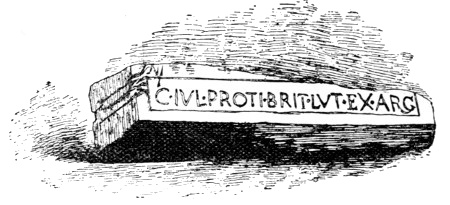
Roman Pig of Lead found at South Cave.]
The lead mines of Derby were famous in Roman times, and much lead was exported from Britain to Italy; so we may easily suppose that this particular pig was lost in transit to the place of shipment.
As evidences of domestic life we have hypocausts, or underground heating-chambers for the supply of hot air and hot water to the rooms of Roman villas. These must once have been numerous—for no wealthy Roman could do without his warm bath—but so far only a few have been discovered. Again, we have examples of the Roman writing-implements, styli by name, two of which, found at Brough, are illustrated below.

Roman ‘Pens’ found at Brough.
37When a Roman wished to write, his implements were very simple—a tablet of wax and a stylus. With the pointed end of the latter he scratched his letters on the surface of the wax; and if he made mistakes he had only to smooth them out by using the other end, which was flattened for the purpose. The Roman schoolboy probably found the stylus a very convenient instrument.

Relics of Roman Feasts found at Easington.
Humbler evidences of domestic life have been discovered in the ‘kitchen middens,’ or refuse heaps, which the incursions of the sea have exposed at Easington and Kilnsea. From these have been obtained numberless oyster shells and fragments of pottery, the relics of dining-room feasts and kitchen breakages. The former are very interesting, because they show the method by which the Roman cook overcame the natural reluctance of the creatures within them to ‘come out of their shells.’
How very curiously such discoveries of ancient relics may be made is seen in the recent case of an inhabitant of South Ferriby. A half-witted man, by name Thomas Smith, but known locally by the more familiar name ‘Coin Tommy,’ made it his practice for several years to walk along the shore of the river just after the periods of high tide, and to pick up all metal objects which he happened to see. Whether horse-shoe or brace-button did not matter to ‘Coin Tommy.’ Into his pocket went everything of metal which he found; and on his reaching home after each of these expeditions, his ‘finds’ were transferred to a stock 38of tin canisters, and packed away on the shelves of his cupboard never again to be looked at by their finder.
Now it was known by Coin Tommy’s associates that his finds were not all horse-shoes and brace-buttons. But few of his friends expected that after his death would-be purchasers of these finds from distant parts of the country would vie with one another for their possession. Yet so it happened; for Coin Tommy’s miscellaneous collection included no fewer than 3000 Roman coins of gold, silver and bronze, and bronze brooches, finger-rings, bracelets, tweezers, spoons, earpicks and styli innumerable.
The explanation of the occurrence of all these objects along this portion of the south bank of the Humber is that there had been at this spot a Roman cemetery, and that changes in the currents of the Humber have caused each high tide during the last few years to wash away some portion of the bank, and thus bring to light treasures buried sixteen centuries ago. And though South Ferriby is not in East Yorkshire, Coin Tommy’s finds may fitly be mentioned in the story of the East Riding; for it is probable that many of the owners of the bracelets and brooches and finger rings had lived at Petuaria, on the Yorkshire side of the river.
Very interesting are the fibulae, or brooches, here discovered. Some have engraved upon them the name of their 39maker, AVCISSA, and one, having blue enamel let into the bronze surface, is constructed in the form of a fish.

A ‘Safety Pin’ Sixteen Hundred Years Old.
This may be taken as evidence of its wearer’s being a Christian, for in early days the fish was an emblem of Christianity. In other cases the brooch is made of a single piece of bronze wire, twisted to form a spiral spring, and having one of its ends flattened out and bent over to form 40a catch for the pin—an illustration of the oft-quoted saying ‘There is nothing new under the sun’; for here is an exact model of the safety-pin invented, or rather re-invented, in the nineteenth century.

Design of the Pavement of a Roman Villa discovered at Harpham.
To come back to the East Riding, our last mention of relics of Roman times shall be that of the mosaic pavement which was discovered in a ploughed field at Harpham in 1904. This pavement formed the floor of the atrium, or square hall of a Roman villa, and was in use probably about the year A.D. 300. It is constructed of small tessarae, or cubes, of red sandstone and chalk, with a few others of dark blue clay, red clay, and yellow limestone in the centre-piece of the design, and makes an ingenious piece of work in the form of a maze.
This Roman pavement has been removed to Hull and reconstructed in the Hull museum. On it when found lay the flat sandstone slabs which had once formed the roof over it. Many iron nails with large flat heads were also found, and in one instance the nail remained fast in position through a hole in one of the slabs.
From the time when Roman soldiers first penetrated into the territory of the Brigantes, the land which we name Holderness was troubled by the piratical attacks of a people from the other side of the North Sea; and in the early years of the second century the low-lying marshes of this district were inhabited by a tribe whom the Romans called Parisii. In our language they would be called Frisians.
41These early Frisian settlers have left us evidence of the places they chose for settlement in the village names Arram, Newsom, Hollym, and Ulrome. Their settlements would probably be peaceful, for the lands taken would be unoccupied pieces of ground rising just above the level of the surrounding marsh.
But as time went on, the eastern and southern shores of Britain were assailed by numerous other bands of plunderers and would-be settlers; and in the later Roman times we find that, beside the army stationed at York under the command of the Duke of Britain to repel the Picts and Scots of the north, there was an army under the Count of the Saxon Shore whose duty it was to defend against invaders the coast from the Wash to the shores of Sussex.
Under Roman rule Britain as a whole prospered exceedingly. Agriculture and commerce were extended, so that we find the lead-merchants of Derby exporting lead to Italy, the chalk-merchants of Tadcaster exporting chalk, and the corn-merchants of the Rhine provinces importing corn from Britain in large quantities.
But beside the export of lead and chalk and corn, another export of trade was going on—the export of the warlike youth of the country, who went to furnish with men the Roman armies in Spain and Gaul and Germany. Those left at home were forbidden by law to carry arms; so there is small wonder that when the Roman legions were withdrawn from Britain Roman towns were sacked and burnt, and Roman civilisation blotted out by hostile invaders. ‘Tragedies can still be guessed at from heaps of ashes and from skeletons of men, women and children found ... in crouching attitudes in hypocausts and other places of concealment; and the human bones frequently discovered 42at the bottoms of wells ... enable us to see the ruthless savage removing the traces of a murderous raid.’
Petuaria, Praetorium, Derventio—all were sacked and burnt by the hosts of Engle who sailed up the Humber and the Derwent, or landed at Bridlington Bay. Roman houses were generally one-storied buildings roofed with tiles or thatch, and the destruction of a town by fire would be complete. It was also, in most cases, lasting; for the destroyers were men who cared not for a life passed within walls and fortifications. ‘They liked better to hear the lark sing than the mouse squeak.’ So the Roman cities, towns and camps ‘remained in ruins, to be haunted by the owl and the fox.’
But an exception was made by the invaders in the case of the greatest of the Roman cities. Eboracum, Londinium and Lindum Colonia became the chief centres of life for the tribes that captured them; and thus the Eboracum of the Romans became the Eoferwic[6] of the Angles—a dwelling-place in the haunts of the wild boar. Smaller towns were blotted out; and their sites are known to us only by the finding of the family store of coins, or the personal treasures once placed for safety in a little recess in the wall or buried in a vase under the floor—to be overwhelmed with debris, and to remain undiscovered for many centuries.
The hostile tribes who invaded Britain during the fifth and sixth centuries in such numbers as to conquer the whole country from the Isle of Wight to the Firth of Forth, except the mountainous districts of the west, were known as the Engle, the Seaxe and the Iute.[7] Angles, Saxons and Jutes these are to us. The Iute landed on the shores of, and 43established colonies in, Kent and the Isle of Wight, the former of which developed into a kingdom; the Seaxe established three kingdoms distinguished from one another in name by the adjectives South, East, and West; and separate bands of Engle formed the kingdoms of East Anglia, Mercia, and Northumbria.
It is with the last-named of these ‘Seven Kingdoms’ that we are most particularly concerned. The huge kingdom of Northumbria stretched northwards from the Humber to the Forth, and was at different times either ruled by one king or divided into two separate kingdoms—Deira, from the Humber to the Tees, and Bernicia, from the Tees to the Forth.
How complete was the conquest of Britain by these invading tribes is seen in the account written by Bede, the eighth century monk of Jarrow:—
They burned and harried and slew from the sea on the east to the sea on the west, and no one was able to withstand them.... Many of the miserable survivors were captured in waste places and stabbed in heaps. Some because of hunger gave themselves into the hands of their enemies, to be their slaves for ever in return for food and clothing; some departed sorrowfully over the sea; some remained fearfully in their native land, and with heavy hearts lived a life of want in the forests and waste places and on the high cliffs.
The completeness of the conquest may be seen also in the fact that the language of the Britons was replaced by that of the invaders. The Angles, Saxons and Jutes spoke a language entirely different from the Keltic language of the Britons; but except in the Highlands of Scotland, in Wales, and in the Isle of Man—the parts to which the invaders did not penetrate—the language spoken to-day is English 44and the name of the country itself is Engla-land, the land of the Engle.
Very definite evidence of the places chosen by the Angles for settlement can be found on the map of the East Riding. Where the head of the household decided to ‘pitch his tent’ a piece of land was enclosed with a tūn,[8] or hedge, and the dwelling erected within it became his new hām,[8] or home. Such was the origin of our numerous towns and villages whose names now end in the syllables ton and ham. In many cases the name of the family is enshrined in the name of the settlement. Thus the Locings—the sons of Loc—the Essings, the Brantings, the Eoferings, and the Hemings gave their names respectively to Lockington, Easington, Brantingham, Everingham, and Hemingbrough.
Besides the endings ton and ham, others which tell of Anglian settlements are worth and bald (a dwelling), cote or coate (a mud cottage), stead (a place), brough or borough (a fortified place), wick (a village), wold (woodland), field (a place where trees have been felled), ley (an open place in a wood), mere (a lake), fleet (the mouth of a river) and ford. Examples of all these can be found on a map of the East Riding.
In their burial customs the Angles were little different from the peoples whom they dispossessed. Like them they often cremated the bodies of their dead, afterwards collecting the charred bones and burying them in earthen vessels, accompanied with the weapons or personal treasures which were to be used again in the life to come. A man was buried with his spear and shield, or with the long one-edged knife whose name—seax—gave rise to the tribal name of the Saxons; a woman with her knife, shears, bronze box containing 45thread and needles, and beads of glass and amber; a child with his toys, such as the tiny tweezers, knife and shears found with a child’s bones in a burial vase at Sancton.
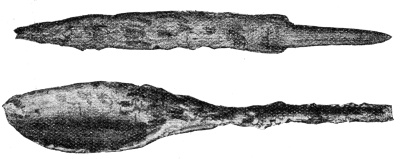
Iron Knife and Bronze Spoon from an Anglian Cemetery
near Garton Gate House (1/2).
Not always, however, did the Angles cremate the bodies of their dead. More often they buried them near the surface of a British burial mound. From one of the mounds at Driffield, known as ‘Cheesecake Hill,’ was taken a necklace consisting of 219 beads, of which 141 were of amber, two of glass, three of carefully cut crystal, and five of cowrie shells.

Child’s Toys found in a Burial Vase at Sancton.
Not very far from Garton Gatehouse, and near the memorial to Sir Tatton Sykes some three miles farther north, were accidentally discovered two Anglian cemeteries, one of which contained more than sixty bodies of men, women and children. Here all but a few had been buried not with their limbs bent, as was the custom among the Britons, but with their limbs stretched out at full length; 46and all but one had been buried with their heads to the west. Probably these were Christian burials.

‘Finds’ in an Anglian Cemetery near Garton
Gate House.
A. Bronze ring (1/1). B. Silver brooch (1/1). C. Bone comb (1/2).
From this Anglian cemetery at Garton were obtained many implements and personal ornaments—iron knives and bronze spoons, bronze ankle-rings and buckles, necklaces of glass, amber and amethyst, silver ear-rings, a gold button set with a precious stone, and, luxury of luxuries, a bone comb. What a great advance is thus shown to have taken place in the centuries between the British burial at Garrowby and the Anglian burials at Garton! With the former were weapons of flint and bone; with the latter, implements of bronze and iron, and personal ornaments of silver, gold, and precious stones.
During later Roman times the worship of God had been introduced into Britain, and the discovery of the Roman bronze brooch figured on page 38 shows that Christianity had reached the shores of the Humber.
But the invaders who were to give a new name to the country and to become our ancestors were heathens, and chief among their gods was Woden. We of the twentieth century still preserve, the names of Wōden, Tīw, the god of war, and Frīg, the wife of Wōden, in our ‘Wednesday,’ ‘Tuesday,’ and ‘Friday’—the Wodenesdaeg, Tiwesdaeg, and Frigedaeg[9] of our Anglo-Saxon ancestors.
In the passage from Bede’s Ecclesiastical History of the English People which was partly translated in the last chapter, we are given an insight into the way in which the heathen Angles and Saxons despoiled the worshipping-places of the Christian Britons:—
Everywhere priests were slain and murdered by the side of the altars. Bishops together with their people were slain without mercy by fire and sword, and there was none to give the rites of burial to those who were so cruelly murdered.
Thus Britain became again a country entirely pagan, and it was not until the closing years of the sixth century 48that Christian missionaries from Rome once more set foot in it.
To understand the events leading up to the arrival of these missionaries, we must bear in mind that among the Angles and the Saxons slavery was a common custom. Social ranks of life were very marked, and all men belonged to one of three distinct classes. He who could trace back his descent from the gods ranked as an eorl,[10] or man of noble birth, and all others were divided into two classes—the free and the unfree. A free man, who had the privilege of owning land by virtue of his freedom, was known as a ceorl[10]; but he who was, body and soul, the property of another was called a theow,[10] or slave.
Slaves must have been very numerous in our country during Saxon days; for wars were constantly being waged between the different tribes, and prisoners of war naturally became the slaves of their captors. So also, a man who had fallen into debt and who could not release himself became the theow of the man to whom he owed money; and when he became a slave, his wife and children became slaves likewise, and could be sold by his master. Worst of all, a free man had the right to sell his own children into slavery until they reached the age of seven.
Now it so happened that this horrible custom of selling children as slaves was the direct cause of Christianity’s being re-introduced into our country. A regular export trade in English children was carried on, and about the year 580 there were one day standing exposed for sale in the market of Rome some boys of fair complexion and beautiful hair. Along the market chanced to pass a monk, who was struck with their light-coloured hair and blue eyes, so different from the dark hair and brown eyes of the South 49European peoples. On his asking the slave-dealer from what country they had been brought, he was told that they came from Britain, and that the people of that island had fair complexions. Unsatisfied with this information, he asked of what race they were, and was told that they were Angli.
‘Non Angli, sed Angeli,’ replied the monk. ‘For their look is angelical, and it is meet that they should become joint heirs with the angels in heaven.’
Then he sought further information concerning them.
‘What do you call the province from which the boys were brought hither?’
‘Deira,’ was the reply given him.
‘Deira!’ said the monk; ‘that is well said. De ira eruti—they shall be snatched from the wrath of God!’
Again he asked: ‘What is the name of their king?’
‘Their king is named Aelle.’
‘Alleluia!’ replied the monk, playing on the name of the king. ‘It is most fit that the love of God our Creator be sung in those parts.’
Fifteen years after this conversation took place in the market of Rome, the monk had become famous as Pope Gregory the First. Then, in fulfilment of the plans he had formed for rescuing the Angli from the wrath of God, he chose a monk named Augustine to make a journey to Britain with some companions. Augustine, with his small band, set out, but on reaching Gaul was so dismayed by the reports of the savage character of the people to whom he was bidden to go, that he turned back, and sought release from the task which had been imposed upon him. This Gregory refused, reminding him that ‘the more difficult the task, the greater is the reward.’
Augustine once more set out, and landed at Ebbsfleet, in the Isle of Thanet, in the Spring of the year 597. The king 50of Kent was then Aethelberht, who had married a Christian princess, the daughter of the king of the Franks. Thus the way had been made clear for the mission of Augustine, and Kent soon became a Christian kingdom.
King Aelle of Northumbria died in 588, and thirteen years later his son Edwin became king. Edwin had married the daughter of Aethelberht of Kent, Aethelburga by name, and with her there came to Eoferwic Paulinus, a monk.
For long this monk was unable to persuade Edwin to become a Christian; but in 626 there was called a meeting of the king’s Witan, or ‘wise men,’ each of whom was asked what he thought of the new doctrines then being preached by Paulinus.[11] After Coifi,[12] the king’s high priest, had expressed his opinion that the gods they worshipped had no power, one of the king’s counsellors broke in with these words:—
‘Thus it seems to me, O my king, that the life of man on earth, in comparison with the life unknown to us, is just as if you were sitting at table with your ealdormen and thegns in wintertide—when the fire was kindled and your hall made warm, while it rained and snowed outside—and there came a sparrow and quickly flew through the hall, coming in by one door and passing out by the other. During the time that he is passing through the hall he is safe from the winter’s storm, but it is only for the twinkling of an eye, and in the shortest space of time he passes from winter into winter.
‘So seems the life of man—it is ours for a little while, but what goes before it and what follows after we know not. Therefore if this teaching makes anything clearer and more certain, it is meet that we follow it.’
51What an apt comparison—the life of a man is like the brief flight of a sparrow through a pleasant room! Many a time must those present when the words were spoken have seen a bewildered sparrow fly swiftly through the king’s hall, entering it to seek shelter from the storm without, and leaving it to seek safety from the smoke of the fire and the noise of men’s voices within. And what more suitable illustration of man’s ignorance of the hereafter could have been chosen? We can imagine its effect upon Coifi, who, on hearing the words of the king’s counsellor, exclaimed:—
‘I see clearly that what we have been worshipping is but naught. For the more earnestly I have sought the truth through our worship, the less I have found it. Therefore, O king, I now advise that we speedily destroy and burn with fire the altars which we hallowed without receiving any benefit.’
Thus were King Edwin of Deira and his Witan converted to the true religion, and the temple which contained the heathen altars destroyed. Coifi himself sought permission to be the first to cast down the idols it contained, and the king granted him weapons and a horse for the purpose. Riding to the temple, he first cast his spear against the altar, and then called to his companions that they should pull down the idols and burn them. ‘The place is yet pointed out,’ wrote Bede one hundred years later, ‘not far east from Eoferwic beyond the river Derwent, and is to-day called Godmundingaham, where the high priest, through the inspiration of the true God, cast down and destroyed the altars which he himself had previously hallowed.’
‘Not far east from York, beyond the river Derwent’—such was Bede’s description of the place of this memorable deed. Godmundingaham, he says, was its new name, 52and Goodmanham it is in our own day. Tradition says further that the present church, dedicated to All Saints, stands on the exact site of the heathen temple which Coifi, the heathen high priest, was the first to profane. But whether tradition speaks true we have no means of knowing.knowing.

Goodmanham Church.
(From an old Engraving).
The immediate results of the adoption of Christianity at Goodmanham were the building of a wooden church at York, and the baptism in it of King Edwin on Easter Day 627. This wooden church, dedicated to St. Peter, was shortly afterwards succeeded by a larger and loftier church of stone, which, in its turn, was destined to be succeeded by another yet larger and loftier—the Minster that we count to-day as one of the glories of Northern England.
Six years later King Edwin was slain in battle against 53Penda, the heathen king of Mercia, and Cadwallon, a British king, ‘more fierce and cruel than the heathen, for he was a barbarian.’ The head of Edwin was taken to York and buried in the stone church of St. Peter which he had begun to build; and Paulinus, the first Archbishop of York, fled by sea southwards to Kent with Edwin’s widowed queen and their two children. Then for the whole of an ‘unhappy and godless’ year Northumbria was wasted by Cadwallon.
At the end of the year Edwin’s nephew Oswald, with an army small but strengthened by belief in Christ, fought against Cadwallon. Now Oswald was ‘a man dear to God,’ and before the battle he caused to be made a hastily-constructed cross of wood, which was erected in a pit dug in front of his army. With his own hands he set up this cross and held it till his men had made it firm with heaped-up soil. Then did Oswald call to him all his men and gave them his command: ‘Let us all bend the knee and together ask the almighty, living, and true God to defend us with His mercy from this proud and cruel foe; for He knows that we are justly fighting for the safety of our people.’
This they all did; and in the fight which followed, Oswald gained a complete victory, and Cadwallon was slain. The place of Oswald’s victory was called ‘Heavenfield’; and, says Bede, ‘many people to-day take chips and shavings from the wood of that holy cross and put them in water, and sprinkle the water on sick men and beasts, or give them it to drink, and they are at once cured.’
With the accession of King Oswald Christianity returned to the people of the north. This time, however, it was brought not by the monks of Rome, but by British monks from a monastery which had been established by Columba, 54an Irish saint, on the tiny island of Iona, lying off the west coast of Scotland.
It was to this monastery that Oswald sent asking for teachers for his people. In reply there was sent him a monk of hard and stern nature, to whom the people would not gladly listen; so that he was able to effect little, but returned to Iona and reported that he could do nothing because the people of Northumbria were unteachable. ‘Was it not, brother,’ said one of his fellow monks, ‘you who were not sufficiently patient and gentle with those untaught men?’ The question made all present turn to the speaker, and they quickly decided that he was worthy to be sent as teacher to their friend, King Oswald.
So came to Northumbria the saintly Aidan, whose success in converting the heathen Angles was due chiefly to the fact that as he taught so he himself lived. For, says Bede,
he in no way desired or sought after the things that are of this world; but all the worldly goods that were given him by kings or by rich men he gladly gave to the poor and needy who came to him. Through all the land he travelled, visiting towns and wayside villages, and never on horseback, unless there were special need, but always on foot. And wheresoever he came and whomsoever he met, whether rich or poor, he turned to them. If they were unbelievers, then he invited them to believe in Christ; if they were believers he strengthened them in their belief, and with word and deed stirred them up to almsgiving and the performance of good deeds.
By the labours of Aidan and his fellow monks the men of the north again became Christians; and such earnest Christians were they that they hallowed with the ‘Sign of 55the Cross’ the places at which they held their meetings for the purposes of government.
A British burial mound was often found convenient for an Anglian mōt, or meeting,—whence the name ‘Moot Hill’—and its purpose was marked by a large trench in the form of a cross cut through the mound down into the chalk. The four arms of the trench were made roughly equal, and always pointed north, south, east, and west. Cowlam Cross, near which the village church was afterwards erected, is cut seven feet deep in the solid chalk, and another similar cross with arms twenty-one feet long has been discovered at Helperthorpe.

Two Sides of an Anglian Cross Shaft at Leven.
Where no convenient mound existed, the place of meeting was sometimes marked in the opposite way. Instead of cutting a deep trench they raised at right angles two ridges of earth and stones, entirely surrounded by a shallow ditch.
Such crosses have been named Embankment Crosses, and eleven have been discovered within a radius of fifteen 56miles from Driffield. A favourite name for them among the country folk is that of bield, or shelter, because they were supposed to have been built up to serve as shelters for the cattle. There is one near East Heslerton, known locally as the ‘Old Bield,’ the arms of which measure 45 yards each, north and south, and 50 yards east and west. Another formerly existed near the site of the ancient village of Haywold. Ploughing operations have caused this—and probably many others—to be destroyed; but its name, ‘Christ Cross,’ is still preserved.
With the introduction of Christianity there took place great development of the arts of peace in home and village life. ‘The English forged the ploughshare rather than the sword. They built weirs, and fished, and set up watermills by the rivers. Boat-building, brewing, leather-tanning, pottery, dyeing, weaving, the working of gold and silver, and embroidery, grew and soon began to flourish. The days of merchandise succeeded the days of plunder; life became gentler, nearer in spirit to the homes of England as we now conceive them.’
Two hundred years pass onwards from the coming of Saint Aidan to Northumbria, and we are again among scenes of famine, sword, and fire. Let us see what the records of the Anglo-Saxon Chronicles have to tell.
| 57A.D. 787. | In these days first came three ships of the Northmen, and when the bailiff rode down to them, and would take the men to the king’s town—for he knew not who they were—he was slain. Those were the first ships of the Danish men that came to the land of the Angles. |
| A.D. 833. | In this year King Egbert fought against the crews of thirty-five ships at Charmouth, and there was great slaughter, and the Danish men possessed the battlefield. |
| A.D. 851. | In this year the heathen men first remained over the winter, and in the same year came three hundred and fifty ships into the mouth of the Thames, and broke into Canterbury and London, and put to flight Beorhtwulf, King of Mercia. |
| A.D. 867. | In this year the heathen army went from East Anglia over the mouth of the Humber to York ... and there was immense slaughter of the Northumbrians, some within York, and some without, and the survivors made peace with the heathen army. |
These records show that the history of the fifth and sixth centuries was being repeated at the close of the eighth century, and during the ninth. They tell us of the inroads of a new race of free-booters, men of Northern Europe—coming from Denmark, Norway, and Sweden—men among whom was a passionate love of the sea and an overwhelming desire for the plunder of other lands. Sea-pirates they are now often called, but we must remember that among them what we should call piracy was looked upon as the most honourable career in life.
Each year as Spring came round these Danish sea-rovers would gather together their men, take advantage of the north-east winds, and sail away to Britain, or the northern coast of France, or even to the shores of the Mediterranean 58Sea, and return laden with plunder on the coming of Autumn.
One thing the records which have been quoted make very clear. In 787 ‘first came three ships of the Northmen’; less than fifty years later King Egbert of Wessex was fighting against the crews of thirty-five vessels; and in 851 the fleet of ships entering the Thames numbered no fewer than three hundred and fifty. What does this astonishing increase in numbers mean? It can mean only one thing—that the Northmen found their marauding expeditions to England profitable. England, in other words, was worth plundering. In fact, England was so prosperous a country, and its churches and monasteries contained such treasures of gold and silver, that the Northmen found it worth their while to build more ‘long-ships’—as their ships of war were called—in order that they might plunder it more completely.
But as time passed away the Northmen came not merely to plunder and return home, but to seek new homes in the fertile lands of Britain. In later records we find mention of peace being made between the Angles and the Danes without the fighting of a battle:—
| A.D. 872. | In this year went the heathen army into Northumbria. They also took up winter quarters at Torksey, and the Mercians made peace with the invaders. |
| A.D. 876. | In this year Healfdene divided the Northumbrian land, and the Danes gave themselves up to ploughing and tilling the land. |
Two years after the last record Alfred, King of the West Saxons, made with Guthrum, the Danish leader, a treaty 59by which all Northern and Eastern England—all England, that is, north of Watling Street, the Roman road leading from London to Chester—was ceded to the Danes to be ruled according to their laws. Henceforth this district becomes known as the Danelagh.
So history goes on repeating itself. For just as the Angles and Saxons had warred against the Britons, and then made settlements and turned to forest-clearing and ploughing, sowing and reaping; so a few centuries later came the Danes to make war upon them in turn, and finally to take possession of uncleared and hitherto unclaimed lands whereon to make for themselves new homes.
Very numerous settlements were made by the Danes in the part of England known as the Danelagh, and most of these may be recognised by the village names of to-day. What to an Angle were a tūn and a wīc[13] were to a Dane a bȳr[13] and a thorp. Hence the name-endings by and thorp denote respectively the sites of a Danish farmhouse and a Danish village; and it is interesting to pick out such names on a large-scale map, and see how they occur in groups or succeed one another along the line of an old highway.
Thus in the East Riding, within a radius of five miles of the Anglian settlements of Bridlington and Hessle, we shall find the Danish names Hilderthorpe, Wilsthorpe, Fraisthorpe, Haisthorpe, Caythorpe, Carnaby, Bessingby, Sewerby; and Anlaby, Willerby, Skidby, Wauldby, Tranby, Ferriby. Other groups will be found round York, Malton, and Pocklington. The best example of the occurrence of a succession of Danish names along the line of an ancient highway is to be found on the other side of the Humber. Here, along the road from the Humber to the old Roman station 60at Caistor, passing through the Anglian settlements of Horkstow and Brigg, there are no fewer than fifteen villages whose names end in by, and one of them has in addition the suffix Thorpe.[14]
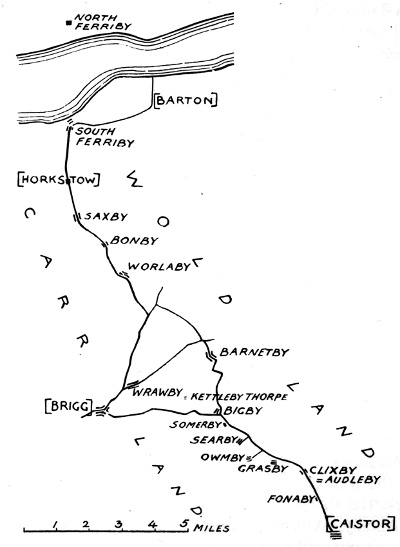
Danish Settlements in a portion of North Lincolnshire.
61Place names ending in by and thorp by no means exhaust the list of Danish settlements. A complete list of name-endings which are Norse in origin would include the following:—
| beck | a stream. | |
| by | a farmstead. | |
| fell | a hillside. | |
| force or foss | a waterfall. | |
| garth | an enclosure. | |
| gill | a ravine. | |
| holm holme |
} | an island, or a piece of firm land rising out of the surrounding marsh. |
| how | a hill. | |
| lund | a sacred grove. | |
| ness | a headland. | |
| scar | a cliff. | |
| tarn | a small mountain lake. | |
| thorp or thorpe | a village. | |
| thwaite | a forest clearing. | |
| toft | an enclosure. | |
| wick or wyke | a bay or creek. |
Examples of all these can be found on the map of Yorkshire, and most of them occur in the East Riding. But it must be remembered that the modern place name is not always a sure guide in this direction. Names have in many cases changed during the course of centuries. For example, the name ‘Nunburnholme,’ which looks Danish in origin, was originally Brunham; while, on the other hand, ‘Kilnsea’ and ‘Withernsea’ have replaced the older Danish names Hornes and Witfornes.
The two name-endings which conclude the list given above are very interesting, because it was the Danish word vīk[15] 62that gave rise to the name by which the sea-rovers became generally known in our country. Vikings, or men of the creeks—so they were called; and so may we call them, if we remember that their letter v stood for the sound of our w, and that their name is to be pronounced Wik-ings and not, as it is so commonly mispronounced, Vi-kings.
A hardy and a daring race were these old Vikings. There were no ‘wasters’ and few ‘slackers’ among them. When a Viking’s son was born, the babe was shown to its father for his approval or disapproval. If the father liked the look of his babe, and thought that it showed signs of growing up into a manly and sturdy boy, it was taken back to its mother to be ‘raised.’ But woe betide the babe that looked puny and sickly, or that showed signs of deformity! The father’s orders were that it should be taken outside his dwelling and exposed to the cold so that it died.
‘What a cruel custom!’ you will think. Yes, so it was. But the Vikings lived in an age when men looked upon things very differently from the way in which we look upon them. In a cruel age the Northmen were so cruel, and the fear that they inspired in the hearts of the people whose lands they plundered was so great, that the monks inserted in their Litany the prayer:—
There is little wonder that, with such a rearing as the children of the Vikings received, a race of warriors grew up among whom was the unwritten law that ‘a Dane who wished to acquire the character of a brave man should always attack two enemies, stand firm and receive the attack of three, retire only one pace from four, and flee from no fewer than five.’
63Social distinctions among the Danes were similar to those among the Angles. In place of the Anglian eorl, ceorl, and theow were the Danish jarl,[16] karl, and thrall; with this difference—that the Danish jarl was a military commander and not a man who could pride himself on being descended from the gods. It is from the word ‘jarl’ that our English word ‘earl’ has arisen.
Like their cousins the Angles, the Northmen were heathens when they invaded our shores.
The Wōden, Tīw, and Frīg of the Angles were the Odin, Tȳr and Freya of the Danes. But their greatest god was Thor, the Thunderer, whose name will be recognised in the name for the fifth day of the week.

Danish Cross Head at North
Frodingham.
Like the Angles, also, the heathen Northmen eventually became Christians, and evidences of their Christianity have come down to us. In the vicarage garden at North Frodingham is a broken cross head of Danish tenth-century workmanship, and in the churchyard at Nunburnholme is preserved a broken cross shaft sculptured with figures of men, women, children, and animals.
But the most interesting relic of Danish Christianity is a sun-dial now built high up in one of the interior walls of the 64church at Aldbrough. Round it, in Anglian letters, is the inscription:—
Put into modern English this would read:—

ALDBROUGH
Danish Sun-Dial Built into the Wall of Aldbrough Church.
Though written in Anglian letters, the names Ulf and Gunvör are both Danish names, and the word ‘Hānum’ is likewise a purely Danish word. Who this Ulf was we do not know, for the name was a common one. One jarl Ulf married the sister of King Cnut, and another was the owner of lands at Aldbrough and Brandesburton during the reign of King Edward the Confessor.
The year of Our Lord is eight hundred and ninety-two, and the scene lies a couple of miles north of the village of Hessle, on the Yorkshire bank of the Humber.
Twenty-five years before this date a heathen army had crossed over the Humber on their march to York, and a good number of broken heads and hewn-off limbs had been the result of their visit to the province of Deira. Then, like sensible people, the invaders and the invaded had come to terms. Villages of the Angles were not too numerous in the district. At any rate there was plenty of unoccupied land lying around them, and this was just what the invaders wanted; for their brothers and sisters had grown so numerous in the lands across the sea that those who had left their homes had no great desire to go back to them.
Among the band of heathen Northmen had been a jarl named Anlaf, and between Anlaf and the ealdorman at Beverley it had been agreed that the former should choose land whereon to settle his men somewhere in the four miles of unoccupied country lying between Hessle and Cottingham. Also his men were to be allowed to choose wives from among the maidens of these two villages or the neighbouring ones of Weighton and Riplingham. In return the Northmen were to give their attention to clearing and tilling the land they had chosen, and to conduct themselves, as 66far as could reasonably be expected, in a manner harmless to the people of all the surrounding villages.
Such had been the beginnings of Anlafsbyr. The land for settlement was chosen—nice dry land on rising ground with a natural drainage to the river—rough shelters for the men were first made, and the ground was then marked out for the building of Anlaf’s hall. Three times was the ground measured for this, and each time after the first the measurements proved slightly larger than the previous ones. This boded good luck, and the work was therefore entered upon with spirit.
In the course of time the building of the hall was finished. Then came the rewards to Anlaf’s men for their labours. The surrounding land was marked out and divided up, each karl receiving a portion, large or small in accordance with his own worth; and a considerable portion was left over to belong to all the karls in common. The thralls of course got no land—they did not count as men but as cattle. Probably some of them were exchanged with the ceorls of Hessle for four-legged cattle.
In three years’ time Anlafsbyr was a thriving settlement. The omens had promised good luck and the good luck came. Meanwhile Ketil, the son of Anlaf, chose himself a wife from Riplingham. So did others for themselves; and some, not finding the looks of the maidens of Hessle and Beverley and Weighton and Riplingham to their liking, went farther afield and made raids on the villages of Hotham and Sancton, only to retire with several cracked heads and broken arms for their pains.
But this was an exception to the general rule. In most cases the Anglian maidens were quite willing to wed the handsome strangers, even if their language was at first difficult to understand, and their methods of wooing somewhat rough and unpolished. In fact they rather approved 67of the roughness than disapproved of it, and to be singled out for one’s good looks and carried off by one of those bold Northmen was something for a maiden to be proud of.
The result of the frequent marriages between the Northmen and the Angles quickly became apparent. Husband and wife spoke languages sufficiently alike for one to make out the other’s meaning in most cases. But the children were, quite naturally, brought up to speak the tongue of their mother and not that of their father; so that as time went on the language of the Northmen disappeared, or rather became merged in the language of the Angles. Thus although Anlaf and his karls spoke the Norse tongue, their grandchildren spoke the English. But for all that, they lived in the Danelagh, where Danish customs and Danish laws were observed.
When Anlaf died in 871, Ketil Anlafsson began to rule his father’s settlement. His two sons, Ulf and Hrafn, went, as custom decreed they ought to go, on Viking raids as soon as they reached the manly age of fifteen or sixteen. Four years of these raids sufficed to prove the prowess of Ulf Ketilsson, and his right eventually to succeed his father as jarl. Then he settled down to help his father, who had become a man past middle age; but Hrafn his brother continued at sea. In 890 Ketil Anlafsson died, and his son Ulf was proclaimed jarl. Hrafn was then away. But now in the Spring of 892 he has just returned, to be honoured by all men as the first among them to make the perilous voyage to an island lying far to the north-west, whose name was spoken of as ‘Iceland.’
Great therefore are the rejoicings at Anlafsbyr. Jarl Ulf has ridden at full speed to the river-shore on hearing that three ships have been sighted coming up the river with red, blue and green sails like those of his brother’s ships. Before 68he leaves home he has given instructions to his wife Helga that the hall is to be got ready for a great feast in case the ships are his brother’s. A messenger has quickly brought back the good tidings, and preparations are being pushed on rapidly, that the welcome Hrafn and his men receive shall be one fitting to the occasion.
Let us now glance round the hall built by Anlaf and see what it is like.
Picture to yourself an oblong hall built entirely of wood, and with a steep roof supported by upright and cross beams. It is built east and west and at each end is a door, one the men’s door, the other the women’s door. Along each side there is a low aisle, which is partitioned off into small sleeping-rooms for the jarl’s family and guests.
Down the middle of the hall are long stone hearths on which are smouldering three fires of wood and turf. Above each fire is a hole in the roof through which the smoke makes its escape after eddying round the rafters, which are covered with a thick layer of soot. The windows are high up, of just sufficient size for a man’s body to be able to squeeze through, and the holes are covered with the membrane obtained from the inside of a cow, which is almost as transparent as glass.
Along the hall will be two long tables, constructed of planks resting upon trestles. At the middle of the south side stands the high seat of the jarl, and opposite it is another which is always reserved for the most honoured guest. Thralls in white woollen clothes are now running hither and thither placing the long tables in position, and coaxing the smouldering fires into a big roaring blaze; for the nights are still very cold.
Adjoining the hall are numerous other buildings—the women’s sleeping rooms and the kitchens and storehouses. The last two are a scene of bustle. Bondwomen are hurrying 69about in all directions. If you look at this one you will perhaps notice that she has lost an ear. It has been cut off for an act of pilfering, but she tries to hide her loss by arranging her hair over the place where the ear should be. In the distance is another bondwoman who cannot possibly hide the marks of her punishment. Three times has she been caught pilfering, with the result that she now has to manage as best she can without an ear at all and without a nose.
But outside there is a great noise of shouting and the trampling of horses and of men. Hrafn Ketilsson has arrived with his men, and welcome is being given him by Jarl Ulf and his wife, Helga Eiriksson. It is not yet time for the meal now being prepared, and Hrafn declares that he is not hungry one little bit; so sports are hastily arranged on the green in front of the hall. There shall be a great horse-fight; for two of Ulf’s karls have horses which have been thoroughly trained to fight, and neither of which has yet been beaten.
The horse-fight takes place accordingly. Each karl makes his horse rise on its hind legs and attack the other, biting it wherever it can. As the contest goes on, the horses get enraged and their masters incite them by blows on their hind quarters. Finally one of the horses gives in and runs away, leaving the other the victor.
Then there is a running contest. Hrafn the Viking has among his troop a man from Ireland, named Gilli, whom he wagers to beat any horse in speed. A dozen horses are immediately offered, and the best of them, a horse belonging to a karl named Hrolf, is chosen. Gilli will race Hrolf’s horse; and if the horse wins, its owner shall have a gold ring given him by Hrafn. For half a mile they race along, Gilli being all the while at the horse’s shoulder, and the result being therefore a dead heat.
70‘But,’ says Hrolf, ‘you had hold of the strap of my saddle-girth, and my horse pulled you along.’ ‘Then,’ replies Gilli, ‘we will have it over again.’
This time Gilli starts a yard in front of the horse, and at the end of the half-mile he is still the same distance in front. ‘Did I this time take hold of your saddle-girth?’ asks Gilli. ‘No,’ is Hrolf’s answer, ‘but my horse had no chance. You were just in front of him all the way, and I was afraid of riding you down.’
‘Very well,’ says Gilli, ‘we will have the race over again.’
So for the third time they race, and this time the horse is given twenty yards start. But Gilli catches Hrolf up, passes him, stands still till the horse is again in front, then starts again, and finishes ten yards in front. There is tremendous cheering, and Jarl Ulf gives Gilli a gold ring of weight equal to that offered by his brother to the horse’s owner.
Next a game of ball. Sides are chosen, and a hard wooden ball and two wooden bats are brought forth. The bats are given to one man on each side. The ball is thrown up into the air, and one of the batsmen hits it with all his force in the direction of the other. The second batsman tries to hit it back and not let it pass him, but before he can hit it he is pulled down by the men of the other side. So the game goes on. It is by no means a gentle game, for the occasion is a special one and all the players are on their mettle. When ‘time’ is called and bruises and wounds are reckoned up, it is found that the players have sustained three broken arms, a broken thigh-bone, and the loss of one eye. Lesser injuries go uncounted.
By this time the feast is ready, and so are the men. If good appetites are any indication of good health, the uninjured men are all in a state of very vigorous health. Jarl Ulf Ketilsson leads the way to his high seat, and Hrafn the 71Viking is shown to the high seat opposite. Swords, shields, and axes are hung on nails driven into the walls above the side benches. By the side of Ulf sits his wife Helga. The scene is one of varied colour, the blue, red, green, scarlet, and purple kirtles of the freemen contrasting strongly with the white garments of the thralls who serve the food.
Huge joints of beef and pork are brought in from the kitchens, and there are numerous calls for the former; for there has been little or no fresh meat since the beginning of last November, and men’s stomachs have a way of getting tired of salted pig, when they have fed on it for five months without a break. Plates are of wood, fingers serve for forks, and each man cuts off with his knife-dagger the amount of meat and of bread that he feels himself capable of eating. Ale is served to the jarl and his family in bullock’s horns adorned with gold and silver bands, to the others in wooden drinking-cups. Half-way through the feast Helga leaves her seat, fills a horn with wine, and offers it to Hrafn. As the Viking drains it at a draught there is a great cheer, which takes a long time to die down.
So the meal goes on. There is little variety in the food, but there is plenty of it, and that is the important thing where hungry men are concerned. As they eat, all are talking. This karl is describing to another how he has just been ‘had’ by a fellow at Weighton, who sold him a thrall guaranteed sound in wind and limb. But the thrall cannot run twice round Jarl Ulf’s hall without getting the stitch. His new master is vehemently explaining that he intends to get his money back.
Another is telling how he has seen a karl’s wife and her bondwoman take the ordeal at Hundmansbyr. The bondwoman had accused her mistress of wrong-doing, and the mistress had challenged her bondwoman to go to the ordeal.
72So the priests had got ready a bucket of boiling water, at the bottom of which were placed two sacred stones. In sight of all, the mistress had plunged in her hand and brought up one of the stones. And her arm showed no signs of a hurt. Then the bondwoman had attempted the same. But her arm had been frightfully scalded. Thus the innocent had been distinguished from the guilty, and the bondwoman had been taken to the nearest ditch and drowned.
Meanwhile Hrafn the Viking’s karls have been pouring into eager ears tales of their adventures among the snow and ice of the seas far away to the north. One has a walrus tooth to show, and others have the claws of a huge white beast that can walk on its hind legs and can squeeze a man’s body in its arms till every bone is broken. They have the skin of one of these fearsome creatures on board down at the river-shore, intended by their Viking chief as a present to his brother’s wife. A fine bed it will make, but it cost the lives of three men to obtain. Would their listeners hear wonders? There are plenty to tell. In the seas from which they have returned they sailed for four days without a night, while the sun went round and round in a great fiery ring.
While this talk is going on, a shame-faced fellow is trying to slink in unobserved at the men’s door. But he is greeted with cries of ‘Nithing!’[17] and receives a volley of beef bones that first bowls him over and then makes him depart more hurriedly than he had come in. Some of Hrafn’s men follow him, for he has been guilty of stealing from a comrade on one of the ships. His head will be shaven to-morrow, then dipped in tar and covered with eider down, so that he may remember for the future that honourable karls do not steal the belongings of their comrades.
73Tables are eventually cleared much more quickly than they were filled. Places are now changed. The jarl and his brother play chess, others play at dice. A wrestling-match is soon fixed up, in which the combatants are strapped together at the waist and each will try to throw the other.
Following this there is a tug-of-war across the fire. An ox-hide is brought in and an end seized by each of two men standing on opposite sides of the hearth stones. Each tries to pull the other into the fire. But they are fairly equally matched, and for some time neither succeeds. Then tempers rise. The shouts of the supporters of each urge them on, and one succeeds in pulling the other on to the fire. As he has drunk deeply of strong ale, he is not content with his victory, but throws the ox-hide over his fallen opponent and then jumps upon him to mark his defeat. When the defeated karl’s friends succeed in pulling him out of the fire, he is, naturally, somewhat scorched.
Now comes in a juggler. He can perform many tricks, and among them is that of keeping three daggers in motion, so that one is always in his hand and the two others in the air. Further, he offers to show his skill on the following day by stepping from oar to oar on the outside of a ship while it is being rowed. He will step thus from stem to stern and back again, and moreover will keep his three daggers moving all the time. The challenge is accepted and he shall have his choice of presents from Hrafn if he can succeed in doing what he says he will.
Challenges are in the air, it seems. Here is Bersi, one of Hrafn’s karls, challenging Egil, a karl of Ulf, because he finds that while he has been away from home Egil has married the maiden to whom he was betrothed. And Bersi is not at all pleased with the course of events, so he has challenged the other karl for his wife. To-morrow they will go to the 74holmgang,[18] and fight it out; and if Egil is not the victor, he will lose his wife and Bersi will gain one.
The excitement caused by Bersi’s challenge is dying down when further excitement arises from the entrance of a karl with news of a strange sight to be seen in the sky. It had been a dark, cloudy night, but suddenly the clouds broke up and there between two clouds appeared a star with a long light streaming from it like a tail of fire. It is there for all to see if they don’t believe him.
So a rush is made for the men’s door and the hall is left deserted. Outside there are groups of wondering men looking upwards at a bright ‘hairy star,’ and asking one another with bated breath what evil fortune to their land this marvellous sight portends.
In 901 died Alfred, King of the West Saxons, and Edward, his son, succeeded him, to be succeeded in turn by his son Aethelstan in the year 925. King Alfred had, it will be remembered, agreed with Guthrum the Dane to divide England into two parts, one of which each of them should rule.
But Alfred’s son Edward enlarged his power so greatly that he was in 924 ‘chosen to father and lord by the Scots King and all the Scots people, by all the men of Northumbria—both English and Danes and Northmen—and by the 75King of the Strathclyde Welsh.’ To Aethelstan was accorded still greater honour, for it fell to his lot to be the first king crowned as ‘King of England.’
Now in the reign of Aethelstan there took place the greatest battle that had yet been fought between the English and the Northmen. The compact of Edward’s reign was short-lived; for in 937 the Danes of Northumbria entered into a league with Constantine, King of the Scots, and Owen, King of the Strathclyde Britons, against the King of England. Their league was joined also by two Norse Kings from Ireland, named Anlaf, one of whom had married the daughter of Constantine. To meet these disturbers of the peace Aethelstan marched north, and at a place known as Brunanburh the famous battle between them was fought.
So great was the victory here won by King Aethelstan that the chronicler who records it bursts into song when he tells how
All day, from the rising of ‘God’s candle’ until its setting, went on the fight; so that the battlefield streamed with blood, and many a Northman lay on the ground struck down with spears. Weary and sated with the fight fled the Scots, pursued by the West Saxons with swords new-sharpened on the grindstone. To none of those who, doomed to death, accompanied Anlaf over the sea did the Mercians refuse the hard hand-play. On the battlefield there lay five young kings put to sleep by the sword, with seven of Anlaf’s 76jarls and an uncounted host of shipmen and of Scots. Then fled the Northmen to the shore of the yellow flood; and so also fled Constantine, who had left behind his son, borne down with many wounds.
Thus departed in their nailed ships those of the Northmen whom the spears had left alive, and the King and his brother sought again the West Saxon land, exulting in victory. Behind them they left the dusky-coated kite, the swart, horny-beaked raven, the white-tailed eagle, and the grey wolf—all eager to feast upon the corpses of the slain.
Such is the picture of the battlefield painted in words by the Saxon chronicler. And when we read it we wonder to ourselves: ‘Where was Brunanburh, at which this great battle was fought?’ But the question is one to which no certain answer can be given. The name ‘Brunanburh’ is lost, and the nearest approach to it among the village names of to-day is Bromborough, on the Cheshire shore of the Mersey.
This may possibly be the site of the battle; but it is curious that two writers of old chronicles, both living within two hundred years of the actual date of the battle, agree in saying that the Norse fleet invaded England by the Humber. So also said the Bridlington monk, Peter of Langtoft, who certainly ought to know; and a Lincolnshire hermit, who translated Peter’s Norman-French into English, is very definite about it:—
If Brunanburh did lie ‘on Humber,’ on which side of the river was it? Some claim that the battle took place at Kirkburn near Driffield, and others put it at Little Weighton, nearer the river.
77But one thing is certain. King Aethelstan and his men must have marched north by either the Watling Street or the Ermin Street. If the Norse fleet did come into the Humber, he must have come north by the Ermin Street, and his army could hardly have crossed the river under the circumstances. However much, therefore, we should like to assert that the greatest battle of olden times was fought in the East Riding of Yorkshire, it would be wiser not to do so, but to let our somewhat despised sister-county of Lincolnshire have the benefit of the doubt.
A glance at the map given at the end of this book will show about four miles from the Humber, on the road from Barton to Caistor, a village named Burnham. At this village there are still to be seen the remains of an ancient entrenchment enclosing a space of about 64 acres. One of the half-dozen ancient spellings of the name of the manor of Burnham is Brunan, and the suffix burh means ‘a fortified place.’
Further, men’s bones, Saxon coins, and a Saxon sword have been ploughed up on the adjoining fields; while just south of Burnham there was in the eighteenth century a road known as ‘Bloody Gate’ and just north of it there is still a ‘Dead Man Dale.’ So we shall have to concede that the southern bank of the ‘yellow flood’ has some considerable claims to the possession of the site of the famous battle of Brunanburh.
Let us pass on to the middle of the next century. For twenty-eight years England had been ruled by Danish Kings, when, in 1042, the Saxons came into their own again and the third Saxon Edward began to rule in London.
But Danish jarls still ruled at Jorvik[19] and Jarl Siward, the eighth of these, was the greatest of them all. In 1054 78he took a large army and a fleet into Scotland, where he fought against the Scots in Aberdeenshire, and slew their king Macbeth. Siward’s son Osbern was also slain in the battle, and when news of his son’s death was brought to the old jarl, he rejoiced that his son had died a worthy death. In Shakespeare’s play Macbeth it is put thus. Ross, a Scots nobleman, has just broken to Siward the news that his son ‘has paid a soldier’s debt’:—
One year later Siward’s own death took place, and these were his words when he felt that he was fated to die not on the battlefield but in his bed:—
‘I feel shame not to have fallen in one of the many battles that I have fought, and to have been preserved to die like a cow. Close me in my mail of proof, gird my sword on me, fit the helmet on my head, and put a shield in my left hand and a gilded axe in my right, that I may die like a soldier.’
So died the lord of the manors of Barmston and Holmpton, and the greatest of the Anglo-Danes of Northumbria. After his death his earldom was given by King Edward to Tostig, the son of Earl Godwin the West Saxon; and if one-half of the stories told about him by the old chroniclers are true, the Northumbrians must have felt the change acutely.
One of Tostig’s little jokes was played at his half-brother Harold’s hall at Hereford. The two had quarrelled at Windsor in the presence of King Edward, and Tostig, expelled from the Court in disgrace, had ridden to Hereford, 79where he found his brother’s servants busily making ready for a visit from the King. To vent his anger on his brother he killed the servants—so the story goes—chopped up their bodies, threw the legs, arms and trunks into hogsheads of wine and barrels of cider, and gaily sent word to the King that ‘he had provided against his coming plenty of salt meat.’
Small wonder that the proud Anglo-Danes of the north refused to submit for long to such a one of the despised West Saxons. In 1064 they rebelled against their unpopular jarl, outlawed him, slew his servants, both English and Danes, seized all his weapons and his gold and silver in Jorvik, and sent for Morcar, the son of Jarl Aelfgar, to be their jarl. Tostig fled to Baldwin, Count of Flanders, vowing vengeance on his half-brother Harold, who had advised the King to fall in with the wishes of the Northumbrians.
Two years passed away. Edward had died and Harold, Tostig’s half-brother, had been chosen by the Witena-gemōt to be King of England. Now was the time for Tostig to have his revenge. So he enlisted the aid of another Harold—Harold Hardrada, King of Norway, a warrior huge of stature and dauntless in courage, who had, when an exile from Norway, won fame in Sicily, Greece and Africa, and who had formed at Constantinople a bodyguard to the Emperor, consisting of five hundred Northmen. Together they would conquer England, and Harold of Norway should be its king, as Cnut, King of Denmark, had been before him.
With a fleet of 240 warships Harold of Norway set out for the conquest of England, his royal banner, the ‘Land-Waster’ proudly flying aloft. But omens of misfortune to come were not wanting; for he and his men had bad dreams at night—dreams of the English host marching down to the sea-shore led by a wolf on whose back was seated a 80‘witch-wife.’ Moreover, the witch-wife fed the wolf with the corpses of Northmen; and as fast as one was eaten, another was ready.
To a superstitious people, such as the Northmen were, these omens must have seemed to bode terrible ill-luck. But Harold had never yet turned back from an expedition, and he did not mean to start turning back now. So over the sea to the Shetlands and the Orkneys his fleet sailed, then down the eastern coast of the mainland till they reached the mouth of the Tyne. Here they were joined by Tostig, and soon afterwards the ‘Land-Waster’ was unfurled in the North Riding of Yorkshire.
So far Harold of Norway had met with no resistance. But the fisherfolk of Scarborough did withstand the attack made upon their little town; whereupon, so the old Norse account of Harold’s invasion tells us—
He went up on a high rock near the town, and set fire to a large pile which he made. They took large poles and lifted it up and threw it down into the town; soon one house after the other began to burn, and the whole town was destroyed. The Northmen slew many people, and took all the property they could get.
Then southward along the coast the fleet sailed, until they reached a place called by the Northmen Hellornes, which was probably our Hornsea. Here a pitched battle was fought; but the men of the East Riding were no match for the invaders, and Harold and his Northmen got the victory.
Next the mouth of the Humber was reached. Sailing up this and up the Ouse they cast anchor at Riccall. Here one-third of the Norwegian host was left to guard the ships while the remainder set out on a march to Jorvik.
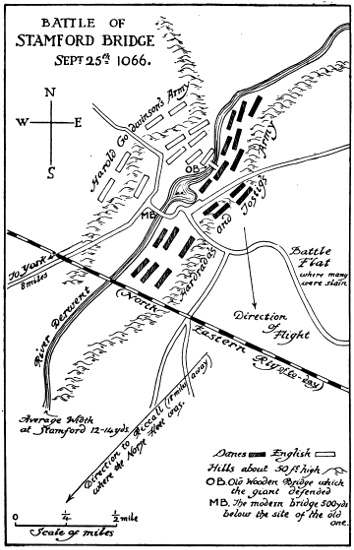
BATTLE OF STAMFORD BRIDGE
SEPᵀ. 25ᵀᴴ 1066.
But at Fulford, two miles from the city, they were met by the forces of Morcar and his brother, Edwin of Mercia. 82The ensuing battle was fought on a strip of land lying between the river Ouse and a ditch which was ‘deep, broad, and full of water.’ As at Hellornes, victory lay with the North men; and so great was the slaughter of the Northumbrian and the Mercians that the Northmen walked across the ditch ‘with dry feet on human bodies.’ Four days later—September 24th—Jorvik surrendered, and the Northmen moved their forces along the Roman road leading to the Derwent, and took up their quarters at Stanfordbrycg.
Meanwhile news of the invasion had reached Harold of England. Gathering together what forces he could muster, Harold hurried north. Up the Ermin Street, and round by Doncaster, Castleford and Tadcaster, he marched. On the day on which York surrendered he was at Tadcaster; the next day he had passed through York and had surprised the Northmen at Stamford Bridge.
The battle that took place between the two Harolds was preceded by negotiations. To his half-brother, Tostig, Harold of England sent envoys offering peace:—
‘Harold thy brother sends thee greeting, and the message that thou shalt have peace and get Northumberland; and rather than that thou shouldst not join him he will give thee one-third of all his realm.’
‘Then something else is offered than the enmity and disgrace of last winter,’ answered Tostig. ‘If this had been offered then, many who are now dead would be alive, and the realm of the King of England would stand more firm. Now if I accept these terms, what will my brother Harold offer to the King of Norway for his trouble?’
‘He has said what he will grant King Harold of Norway. It is a space of seven feet, and it is so long because he is taller than most other men.’
83Tostig’s reply to his half-brother’s terms was a noble one:
‘Go and tell my brother, King Harold, to prepare for battle. It shall not be said among Northmen that Jarl Tostig left Harold, King of Norway, and went into the host of his foes when he made warfare in England. Rather will we all resolve to die with honour, or win England with a victory.’
After the failure of these negotiations, both sides made ready for battle. And then happened another omen boding ill-luck for the Northmen; for their King, who was riding a black horse with a white mark on its forehead, was thrown to the ground by the stumbling of his horse.
In Roman times the passage across the Derwent at the spot where the battle took place had been made by a stone-paved ford; but this had, in later times, been replaced by a wooden bridge, whence the name it then bore—‘Stone-ford-bridge.’
At the outbreak of hostilities some of the Northmen were on the right bank of the river, and were gradually forced back over the bridge by Harold of England’s men. The last of them to cross was a second Horatius, for he kept the bridge against the whole English army. Wielding his huge battle-axe, he had slain no fewer than forty of his enemies before he was himself slain by a soldier in Harold’s army, who floated down the river in a tub and stabbed him with his spear through one of the spaces between the wooden planks of the bridge.
The old Norse account of the battle reads very much like the accounts of the battle of Hastings, which was so shortly to follow. Harold of Norway ordered his men to take up their positions with shield against shield on all sides. The outer rank were to press the spikes of their spears into the 84ground and to point the heads against the breasts of the attacking horsemen; the next rank were to point their spear heads against the breasts of the horses. If all of them stood firm and took care not to break away, Harold of England’s onset might be completely checked.
But what the English would be unable to do in the battle to come, the Northmen were unable to do at Stamford Bridge. They broke their lines in pursuit of the English, and the battle was lost. Harold Hardrada rushed hither and thither dealing such blows with his battle-axe that ‘neither helmet nor coat of mail could withstand him; he went through the ranks of his foes as if he were walking through air, for all who came near him fell back.’ But to no purpose, and an arrow which struck him in the throat brought him his death-wound. Soon afterwards fell Jarl Tostig, and though the Northmen who had been left in charge of the fleet at Riccall hurried to the battle, they were not able to prevent the ‘Land-Waster’ from falling into the hands of Harold of England.
When darkness had set in, the victorious army was on its way back to York. Thither came Olaf, the son of Harold Hardrada, and the Jarls of Orkney to swear peace and give hostages. And thither also came at full speed a messenger who brought news that William of Normandy had landed with his army on the southern coast of Harold’s kingdom.
The tale of the Northmen’s invasions of England could be matched by the tale of their invasions of the northern coasts of France. Early in the tenth century a Viking known among his people as Rolf the Ganger[20] made a descent upon Rouen and entered into a treaty with Charles the Simple, King of Paris, by which a large tract of land around Rouen was ceded to him and his followers, in return for their aid against Charles’ enemies.
Such was the beginning of the province of Northern France known in later history as Normandy. After forty years of sea-roving Rolf settled down to rule his new and fertile dukedom; and as with the Northmen in England, so with him and his men in France. The Northmen married wives of their new country, and their children grew up to speak the mother’s tongue rather than the father’s. Thus the descendants of heathen Northmen became Christian Frenchmen.
To Rolf the Ganger’s dukedom there succeeded in turn William Longsword, Richard the Fearless, Richard the Good, Robert the Devil, and William, whom his enemies called William the Bastard—‘the Tanner’s Grandson’—but who was destined to become famous as William the Conqueror of England.
86How Harold of England, after hearing of William’s landing on the coast of Sussex, marched southward to his death at Hastings, and how William of Normandy was crowned King in his stead at Westminster on Christmas Day in the same year, does not concern us here. But what we are concerned with is the course of events that led to William’s coming north to the city of York.
The events of the last three months of the fateful year 1066 by no means proved that England was a conquered country. True, the Witena-gemōt had accepted William as their king; but that was only because there was no one else fit to lead the Saxon forces, and because Anglo-Danes and Saxons mistrusted each other. Edwin of Mercia and his brother Morcar submitted to William and were allowed to retain their earldoms. Oswulf, who now ruled Northumbria, did not submit, so William appointed a certain Copsige[21] to supplant him. Copsige came north to dispossess Oswulf, and was immediately slain.
In 1067, during William’s absence in Normandy, rebellions broke out in the south and west of England; and when the King returned, he began the conquest of the western portions of the country. Exeter submitted after a siege lasting eighteen days, but no sooner had the western rebellion been subdued than Mercia and Northumbria were in revolt.
Next year the King marched north and reached York, the inhabitants of which rather unexpectedly surrendered their city; and on William’s departure he left William de Malet, one of his Norman knights, in charge of it. But after a few months the men of York again rose in revolt and Malet was hard pressed, although he succeeded in holding out till relieved by the King.
All over England these rebellions were going on. But 87none was more than partly successful; and for the reason that ‘Englishmen could not agree to act together. One district rose at one time and one at another. Some were for Sweyn, some for Edgar, some for the sons of Harold; Edwin and Morcar were for themselves. So there was no common action against William, and the land was lost bit by bit.’
In the autumn of 1069 it seemed as if there really was to be made in the North of England a united effort to throw off the yoke of the Frenchmen. Sweyn Ulfsson, King of Denmark, sent a large fleet of ships into the Humber under the command of Jarl Asbiorn, his brother. Outside the walls of York the Danish shipmen were joined by Edgar the Aetheling, by Gospatric, the dispossessed successor of Oswulf, and by Jarl Waltheof, Siward’s son.
Then began a second siege of York. The French garrison, under William de Malet and Gilbert of Gaunt, retreated to the two wooden castles which William had caused to be erected, and set fire to the portions of the city surrounding these in order to give themselves greater security. For two days the flames raged, destroying many houses and the Minster of St. Peter. Meanwhile the allies entered the city. Then the Normans attempted a sally from their castles, but unsuccessfully. Their forces were cut to pieces, and William de Malet and Gilbert of Gaunt were taken prisoners.
So far all had gone well with the armies of Jarl Asbiorn and Jarl Waltheof, and had they only held the city when taken and awaited the arrival of King William, they would have had every chance of repeating their success. But a fatal dissension once more broke out, and Asbiorn’s men went back to their ships and sailed first to North Lincolnshire and then to Holderness, while Waltheof withdrew his men to the marshes between the Trent and the Ouse.
88For the third time King William marched north to York; and this time he determined on vengeance. ‘Par splendeur Dex,’ he swore that he would utterly root out the Northumbrian people; and in fulfilment of his oath he carried out that ‘Wasting of the North’ which changed the fertile Plain of York into a desolate waste. For sixty miles north of York every town and village was sacked and burnt, every inhabitant slain or driven out, all farming-stock and farming-implements destroyed, and nothing spared save only what belonged to St. John of Beverley. Then, having wreaked his revenge, William caused himself to be re-crowned at York, and there he kept his Christmas feast.
The system followed out by William the Conqueror after his subjugation of a district was everywhere the same. Lands were taken from their English owners and given to the King’s Norman followers, while strong castles were built to afford protection to the Norman lords.
Thus Drogo de Bevrere, a Flemish knight who had married the King’s niece, was rewarded for his services with the Isle of Holderness, and built himself a castle at Skipsea, where the earthworks of a long-dead chieftain were still standing. No remains of Drogo’s castle now exist, nor have we in the East Riding the remains of any Norman castle such as those existing at Knaresborough, Helmsley, Pontefract, Scarborough, York, and elsewhere in the other Ridings of Yorkshire.
With this parcelling out of the land among William’s Norman followers there became fixed two principles on which the whole ‘Feudal System’ was based:—
(1) All land belonged to the King by virtue of his conquest of the country;
(2) All land was held in return for services rendered.
89Under the Feudal System the King would make a large grant of land to one of his followers, who thus became a tenant-in-chief of the King. This tenant-in-chief would sub-divide his land among his particular followers, each of whom might sub-divide his portion. Thus Drogo de Bevrere was a tenant-in-chief, and one of his tenants was a certain Lanbert, who held lands at Sutton ‘two miles long and a half a mile broad.’ Drogo, Earl of Holderness, was a vassal of the King; Lanbert, a vassal of Drogo.
For these lands no regular rent was paid. Instead, there was the obligation of military service, each holder of land being bound to serve the King in war for forty days every year as his services were required. This service had to be performed at the vassal’s own cost, and with proper equipment. By this means the King could always be assured of an army equipped at short notice, and at no cost to himself.
In addition to this military service there were money payments to be made at certain irregular intervals. An aid was due from a vassal to his overlord on each of three occasions:—
(1) The knighting of the lord’s eldest son; (2) The marrying of his eldest daughter; (3) The ransoming of his own person.
Of these occasions the first and second would, as a rule, occur only once in a vassal’s life-time, while the third might not occur at all. For all tenants-in-chief it did occur when King Richard I. had to be ransomed from his enemy, the Emperor Henry VI., into whose hands he had happened to fall. The monks of the Abbey of Meaux, being tenants-in-chief, then found themselves called upon to pay, as their share of the total ransom of 150,000 marks, the sum of 300 marks; to raise which they were compelled to sell their stock of wool and their church plate.
90On the death of a vassal and the succession of his heir, another money payment became due to the vassal’s overlord. This was known as a relief. Again, if on a vassal’s death his heir or heiress had not yet come of age, his estate passed for the time being into the hands of the overlord, who managed it and took the profits. This right was known as wardship, and it might be rather dangerous for the ward.
Thus, in the early years of the thirteenth century, Thomas, the parson of Routh, held certain lands under William de Stuteville, the lord of the manor. Thomas died, and the lord of the manor claimed wardship over his young daughter Agnes. But before Agnes had come of age, William de Stuteville died also, and the wardship passed into the hands of his widow Cecilia. Unfortunately for Agnes her new guardian was not overburdened with principles of honour; for, having two daughters of her own—who were, we may suppose, not sufficiently good-looking to find husbands readily—she offered with them as dowry the lands of Agnes. Thus two lucky bridegrooms, Stephen of Pokthorpe and Henry of Hutton, were enriched by Dame Cecilia, each with one-half of the lands of Agnes, the parson’s daughter. And poor Agnes never succeeded in getting her lands back, though she tried her best.
The various money payments due to a vassal’s overlord depended as to their amount on the value of the estate held. Therefore, in order that the King should know exactly what sums were due to him from his tenants-in-chief, he caused a great survey of England to be made. The vastness of the undertaking may be gauged by the fact that each estate in all the counties of England except Northumberland, Cumberland, Westmorland, Durham, and Monmouth—which last was then reckoned as a Welsh county—was 91to be reported on by the King’s officers, who were instructed to make enquiries as to its value and to record the result of their enquiries.
These officers were to set down the area of each estate, great or small, the area of that part of it which was ploughed land, the area of that part which was grass land, the name of its holder, the name of its holder in the last year of the reign of King Edward the Confessor, the amount of stock and of farming-implements on it, the number and condition of the people living on it, its annual value in the time of King Edward, and its annual value at the time of the investigation—the last two items being the most important of all.
In this manner was constructed what is known as The Domesday Book—the book by which a judgment could be made as to the amount of the money payments due to the King from each of his tenants-in-chief. The work was planned at the Witena-gemōt held at Christmas 1085, and was carried out during the following year.
The Domesday Book is one of the most valuable historical records possessed by the nation, and much information as to the England of 1086 has been gleaned from its parchment leaves. The entries in it are of course in Latin, and the following translation of the portion dealing with the manor of Patrington will serve as an example of the facts recorded in it.
In Patrictone with the four berewicks Wistede, Halsam, Torp, Toruelestorp, there are thirty-five carucates and a half, and two oxgangs and two parts of an oxgang to be taxed. There is land to thirty-five ploughs.
92This manor was, and is, belonging to the Archbishop of York.
There are now in the demesne two ploughs and eight villeins and sixty-three bordars, having thirteen ploughs. There are six sokemen with two villeins and twenty bordars, having five ploughs and a half. There are thirty-two acres of meadow there. Two knights have six carucates of the land of this manor; and two clerks two carucates and three oxgangs, and the third part of an oxgang. They have there four sokemen and five villeins, and three bordars with five ploughs.
In the time of King Edward the value was thirty pounds, at present ten pounds and five shillings.
Arable land three miles long and one mile and a half broad.
All this reads very strangely to us living in the twentieth century. Put into present-day language it would read something like the following:—
The manor of Patrington, with the neighbouring hamlets of Winestead, Halsham, [Welwick] Thorp, and Tharlesthorp,[22] measures 4300 acres,[23] and its thorough cultivation would provide work for thirty-five teams of oxen, reckoning eight oxen to each team.
It belonged to the Archbishop of York in the reign of King Edward the Confessor, and is still held by him.
Attached to the lands of the manor-house there are eight serfs who have among them sixteen oxen, and sixty-three cottagers, who own 104 oxen. There are also six small 94farmers who have under them two serfs and twenty cottagers, and work forty-four oxen. Parts of the manor lands are held by two knights and two parsons. The former are tenants of 720 acres, the latter of 290 acres. On their lands there are four small farmers, three cottagers and five serfs, possessing among them forty oxen.
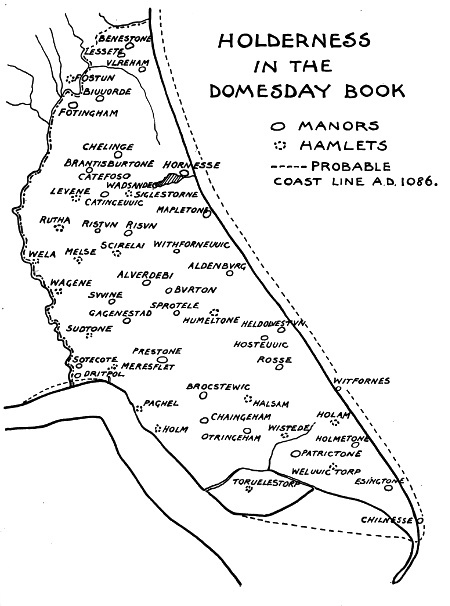
HOLDERNESS IN THE DOMESDAY BOOK
The land on which wheat, barley and oats are grown measures three miles by one and a half miles, and there are thirty-two acres of meadow land.
In King Edward’s time the annual value of the manor was £600, but is now only £205.[24]
The value of the manor of Patrington was, in 1086, only just over one-third of its value twenty-five years earlier. This is one example of the results of the ‘Wasting of the North.’ Others are to be found in the records given of the manors of Burstwick and Kilnsea, each of which had been worth fifty-six pounds, but was then worth only ten pounds. The manors of Withernsea and Hornsea had similarly decreased in value from fifty-six pounds to six pounds. All these belonged in 1086 to Drogo de Bevrere, Lord of Holderness. The manor of Beeford had experienced a still greater decrease in value; for it had sunk from twenty pounds to ten shillings. Others again, such as estates at Barmston, Drypool, Routh, and Sigglesthorne are recorded by the ominous word ‘waste.’ Such entries tell a very sure tale of the effects of King William’s vengeance.
On the map on page 93 are shown most of the manors and a few of the hamlets recorded in that part of the Domesday Book which deals with the Holderness division of Yorkshire. In many cases the spelling is very quaint; but most of the names are recognisable if we remember 95that U and V are different forms of the same letter, and that our letter W was then what, according to its name, it ought still to be. We must remember also that the men who took down the records were Frenchmen, who found it difficult in many cases to pronounce the names they heard the English witnesses use, and who had to spell these names as best they could according to their sound.
For more than nine hundred years the Domesday Survey remained the only survey made of English lands as a whole, and not till 1910 was an attempt made to compile the second Domesday Book. In that year commissioners started on the same task as was performed by the King’s officers in the year 1086; and the task has been undertaken for the same purpose—to enable the King’s taxes to be gathered in correctly.
In these days of bicycles most of us have experienced the pleasure of seeing, over the tree-tops in the distance, the spire or the square-capped tower of one of our village churches. For us on that occasion, perhaps, it marked the goal of a long journey, and we therefore hailed it gladly. Then probably we thought no more about it.
Yet that village church was worth a few minutes of our thoughts. To one who knows how to see it was worth walking round, and worth also looking into. For it had a tale to tell—a tale that stretches back into the centuries 96long past, a tale of the joys and sorrows of the people whose places we now fill, a tale which ought to make us realise that we of the twentieth century are not the only clever people who have lived in the East Riding of Yorkshire.

| Photo by] | [C.W. Mason |
| A Norman Font in Kirkburn Church. | |
Let us learn how to read the tale aright. In the first place we must know the names of the different parts of a church. If it is small, it will be simply a rectangular building, running east and west, and divided by an open arch or by a woodwork screen into two parts, a nave and a chancel. The former is, on service days, occupied by the congregation of worshippers, the latter by the clergy and the choir. At the east end of the chancel is the altar or communion-table, at the east end of the nave are the lectern and pulpit, at the west end of the nave is the font.
If the church boasts a tower, this will be at the west end, where also will probably be the main entrance door. This may, however, be on the south of the nave near the west end. On the south of the chancel may be another smaller door, once the priests’ door; and by it in the wall may be the sedilia, or priests’ seats, three in number. Close to these may be the piscina, or drain, at which the holy vessels were once washed; and in the wall on the opposite side may be the aumbry, or cupboard, in which the holy vessels once stood.
97But such small churches are not common. Generally the nave has along each side what is called an aisle, in which case its central roof is supported on a double row of pillars. Possibly the chancel also has aisles. The walls above the lines of pillars may be pierced with windows, which thus look out above the roofs of the aisles. These windows are known as clerestory windows.
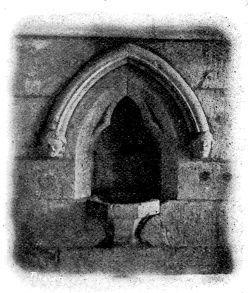
| Photo by] | [C. W. Mason |
| A Piscina in Patrington Church | |
In cathedrals and very large churches there is a story which runs along each side of the nave and chancel, between the capitals of the pillars and the clerestory. This is called the triforium. Beverley Minster has a triforium, but there is no passage round it, and it is really a blind story. A portion of it can be seen in the photograph of the Percy Tomb on page 230. Bridlington Priory Church has a triforium on the north side only.
In churches of large size the building is not simply a rectangular one with or without aisles, but is formed of two rectangular buildings crossing each other at right angles. The nave and chancel have added to them a north transept and a south transept, and above the crossing-place rises a central tower on four huge piers.
These transepts, as well as the nave and chancel, may have aisles. But this is customary only in cathedrals. 98Holy Trinity Church, Hull, the third largest church in Britain,[25] has aisles only to the nave and chancel; Patrington Church—the ‘Queen of Holderness’—has aisles to the nave and to each transept; and Hedon Church—the ‘King of Holderness’—now has aisles only to its nave, though its transepts formerly had an aisle on the east.
Many were the difficulties that the builders of our ancient churches had to overcome. In the East Riding one difficulty was the obtaining of suitable building-material. Stone blocks were costly, for these had to be brought by water from the quarries of the West Riding. So usually the builders had to make the best use they could of the materials they obtained locally—boulders from the cliffs of the sea-shore, blocks of chalk from the Wolds, or clay bricks from the low-lying bank of the Humber.[26]
Another difficulty was sometimes encountered in obtaining suitable foundations. The clay soil on which the church of Holy Trinity, Hull, is built was not of sufficient depth to afford foundations for the heavy central tower which it was intended to build.
Twentieth-century builders would drive piles down into the clay to make a firm foundation; the fourteenth-century builders solved the problem by constructing four huge rafts of trimmed oak trunks, each consisting of two rows of trunks crossing at right angles. On these rafts they raised the piers for their tower; and when, in 1906, it became necessary 99to take out the tree-trunks and replace them with steel girders and cement, many of the trunks were found to be as sound as on the day that they were placed in position six hundred years ago.
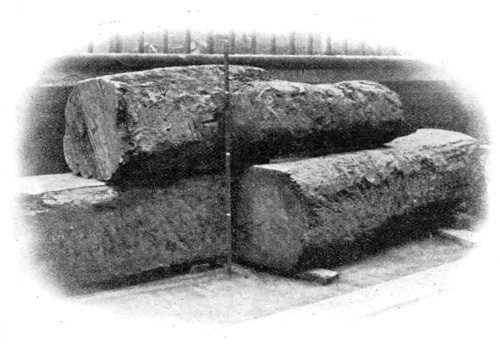
| Photo by] | [J. Ball |
| Part of the Foundations of the Tower of Holy Trinity Church, Hull. | |
The greatest charm of our ancient churches lies in the fact that, except in a very few instances, a church is not built in the same style throughout. It is quite evident, if we have a seeing eye, that additions and alterations have been made at different times. The nave and the chancel were plainly not designed by the same architect; the north side of the church differs from the south; here has been added a new door, there a new window; the roof has been taken off, the worn ends of the rafters sawn away, and the 100rafters used again, so that the roof has to be of less slope than it was before.
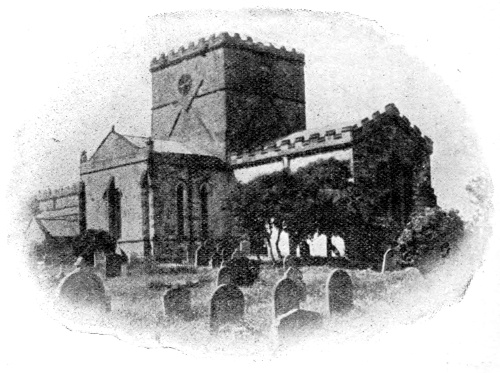
Filey Church, showing the lines of the original roof.
All these are the signs of life and growth. If we wish, we can read by them how our forefathers prospered in their worldly business, and how they gave thanks to God for their prosperity; or how the coming of the Plague brought them poverty and distress, and perhaps put a stop to their building operations, which were not completed till many years afterwards, and then in a style quite different from that in which they had been begun.
Often these alterations and rebuildings were put on record, and some of the records remainremain to our day. Thus John Skinner, of Westgate, Hedon, by his will made in 1428, left the sum of forty shillings towards the building of the new tower of St. Augustine’s Church. On the south face 101of the tower of Aughton Church is an inscription which is now illegible, but which once told in the Anglo-French language that Christopher Aske, the second son of Sir Robert Aske, rebuilt the tower in 1536.
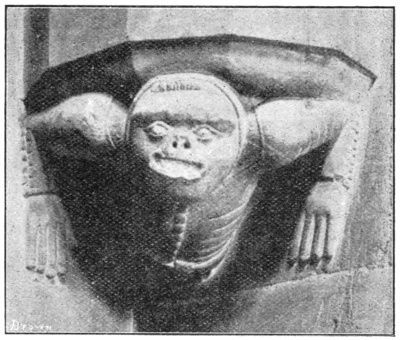
| Photo by] | [C.W. Mason |
| The ‘Beverley Imp’—St. Mary’s Church, Beverley. | |
Cut into the stone of the same tower is in two places the likeness of an aske or newt, a punning allusion to the name of the builder. In the same way, the tower of Hemingbrough Church is ornamented with a row of ‘dolly-tubs’ or ‘weshing-tuns’—an allusion to the name of Prior Wessington, in whose period of rule the tower was rebuilt.
Most interesting of all such records are the inscriptions on the pillars of the north side of the nave in St. Mary’s, Beverley. They show that when the tower fell in 1520 and destroyed that side of the nave, the destruction was repaired by a combined effort on the part of the parishioners. A family named Crosslay provided the wherewithal for rebuilding the half pillar at the west end, and the two pillars 102next to it towards the east; the ‘good wives’ of the parish rebuilt the next two pillars; and, as will be shown later, the remaining pillar was rebuilt by the Gild of Minstrels.[27]
Hence the inscriptions which we may read to-day high up on the pillars:—
But though no written or inscribed record may exist, it is yet possible to tell approximately the date at which either a church was built, or some particular portion of it was rebuilt. This is so because men built in different styles at different times—the fashionable mode of building changed as the centuries went on. Let us see how we can recognise these styles.
When the Normans came to England, they brought with them great zeal for church-building, and many churches built by them remain to our day on the Wolds of the East Riding.
The Norman style of building was one of round-headed arches and of narrow round-headed windows with the sides widely splayed, so that the window-opening inside is very much larger than the narrow slit which appears on the outside of the wall. The walls were very thick, the masonry was rough, the joints between the stones were very clumsy, and the buttresses, if used at all, did not project more than a few inches from the walls. The early Norman churches had very plain chancel or tower arches, such as we see at Speeton, Reighton, and Rudston; but those built later 103had arches magnificently carved with zigzags or chevrons, and with animal forms. Good examples of these may be seen at North Newbald, Kirkburn, Nunburnholme, Etton, and Garton-on-the-Wolds.
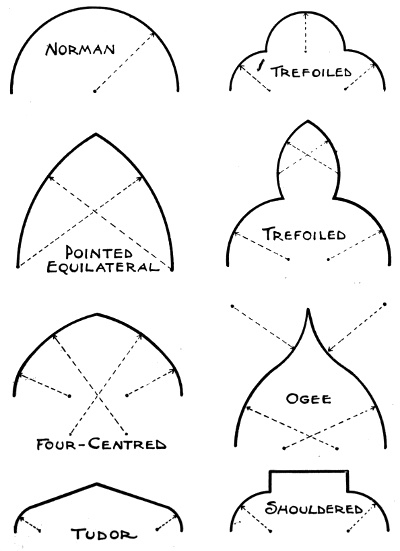
Different Forms of Arches.
The Norman style of building lasted from 1066 to 1190. Then came a change. Instead of using a semi-circular or one-centred arch, architects found out the advantages of a two-centred arch. They also made the discovery that 104the walls need not be so thick, if the thickness of the buttresses was increased. Thus came about what we call the Early English or Lancet style of building, which was fashionable for the ninety years from 1190 to 1280. Beautiful examples of this style can be seen in the churches of Filey, Hedon, Middleton-on-the-Wolds, and Kirk Ella.
Again came a change, a growth of ideas. Men grew tired of the simple form of Lancet window, which we to-day consider so beautiful because of its simplicity. First they experimented by piercing an ornamental hole through the stonework above a group of lancets. This gave what we call Plate Tracery, examples of which are not numerous in our Riding.
Then a further experiment was made. Instead of building the head of a group of lancets in solid stone, some architect-builder hit upon the idea of making a pattern of shaped bars of stone, and of filling in the pattern with glass cut to fit the spaces. This at once proved popular, and an entirely new fashion in window designs set in.
At first the patterns made in stone were simple Geometrical ones, such as those in the chancel windows at Rudston. But gradually, as one set of builders vied with another in building the most beautiful church, the patterns became more complicated and Curvilinear in form. These last two styles together made up what is usually known as the Decorated style of building, and were in fashion from 1280 to 1380.
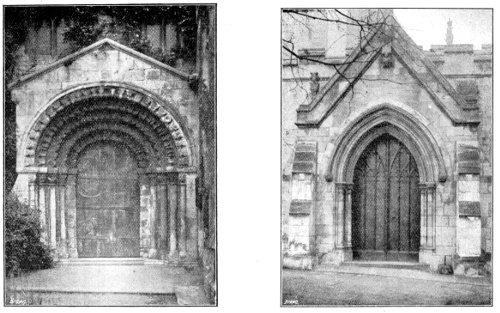
‘Norman’ and ‘Early English’ South Doors.
Stillingfleet. Hessle.
Lastly came another great change, due to the discovery of methods for producing stained glass. The windows of Norman churches had been very small, and the interiors of the churches had been very dark. How dark they were may be judged from the present interior of the church of Garton-on-the-Wolds when the doors are both shut. Very early the worshippers experienced a desire for more light, 106and at Garton they solved the problem by knocking down some of the wall and inserting a much larger Decorated window.
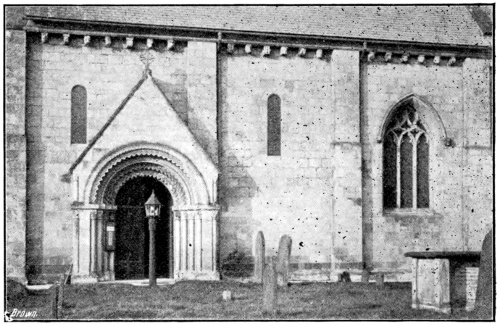
| Photo by] | [C. W. Mason |
| Part of the South Wall of the Church at Garton-on-the-Wolds. | |
But when stained glass became reasonably cheap, there were few church-people who could endure the thought that some neighbouring church had stained-glass windows when their church had none. So there began a competition among them as to who should be able to show the greatest area of stained glass in their church windows. Walls were therefore pulled down, and windows enlarged, or perhaps a nave or chancel was entirely rebuilt, for the reception of this glass; until where there had once been a stone wall with a few narrow slits in it, there was now a series of wide expanses of glass separated with narrow strips of wall.
For convenience also, the bars of stone which formed the 107window tracery were made straight instead of curved. This is the style which we call the Perpendicular style, and it grew in popular favour from 1380 until 1547, when the Reformation put an end to further growth.
All the three styles, Early English, Decorated, and Perpendicular, make up what is known as Gothic architecture. The name is unfortunately a meaningless one; for it does not in any way refer to the architecture of the Goths, as the name Norman does to the architecture of the Normans.
The great difference between the two styles is that whereas the roof of a Norman building was supported by the walls, the roof of a Gothic building was supported not by the walls, but by the buttresses, some of which might be constructed in the form of bridges. Such buttresses are known as flying buttresses.
It would be almost true to say that we might knock down every inch of wall in Beverley Minster or Patrington Church and yet leave standing the framework and roof of the buildings, with the western towers of the one and the central spire of the other. Such buildings are perfect in design, and their perfectness is due to the knowledge and skill which were possessed by their architect-builders.
Gothic architecture grew like a plant, and reached its full development in the Perpendicular style, when the enthusiasm for church-building was at its height. Most of our village churches show signs of having been in part rebuilt during the period when the Perpendicular style flourished, and one of its most marked features is a lofty central or western tower, such as we see at Hedon, Howden, and Driffield.
For a long time after the Reformation there was no fresh church-building, and little church-repair. What little attention our ancient parish churches had at the repairers’ 108hands was often of the kind that is called ‘churchwarden’ restoration, an example of which we see in the accompanying photograph of a portion of Welwick Church. Now, happily, such is a thing of the past, and our church restorers aim at a restoration which is true to its name.
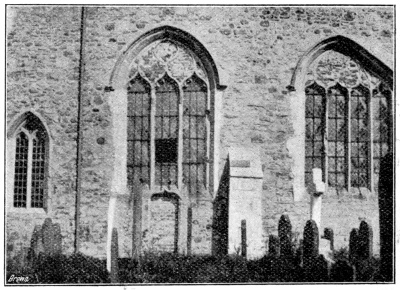
| Photo by] | [C.W. Mason |
| ‘Churchwarden’ Restoration at Welwick Church. | |
It is unusual to find an ancient parish church built in one style throughout. But Filey Church is almost entirely on the border-line between Norman and Early English; Patrington Church is almost entirely Decorated; and Skirlaugh Church, which was built by Walter Skirlaw, Bishop of Durham, about 1403, is entirely Perpendicular.
Modern churches are, on the other hand, usually in one style throughout. The churches of Kilnwick Percy, East Heslerton, and Sledmere will serve as good examples of modern Norman, modern Early English, and modern Decorated styles.
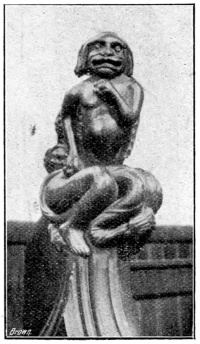
| Photo by] | [C.W. Mason |
| A Grotesque ‘Poppy-Head’ at Holy Trinity, Hull. | |
In and about many of our ancient parish churches are preserved features which remind us of the customs and beliefs of long-past days. At Easington we may see the ancient tithe barn, in which was stored the parson’s tithe of corn when tithes were paid not in money but in kind. At Barmby-on-the-Marsh, North Frodingham and Swine are preserved the church chests in which the parish records were kept. Holy Trinity, Hull, has only recently parted with the library of which its parishioners enjoyed the use long before the days of ‘Free Libraries.’
In the churches at Barmston, Burstwick, Goodmanham and Thwing may be seen the squint, or hole cut through a pier of the tower so that the people worshipping in the transept might see the ‘elevation of the host’ before the high altar. At Millington, Nunburnholme and Sancton there remain the low-side or lepers’ windows, so built that the poor unfortunates outside the walls of the church might not be deprived of the sight of the same.

Brass of Thomas Tonge, Rector of Beeford. a.d. 1472.
Just within the south door of the church at Great Givendale stands the stoup or holy-water vessel, from which all worshippers were once sprinkled; and across the chancel arches at Flamborough and Winestead stand the ancient rood screens. At Kirkburn we may see a modern replica of an ancient rood screen in all the glory of brilliant colours; and the interior surface of the walls 110and roof of the church at Garton-on-the-Wolds reproduces the ancient custom of painting in colours every square inch of available space within a church.
In several churches there are grotesque carvings in wood and stone—gargoyles, corbels, poppy-heads, and misericords—carvings so grotesque and irreligious that we can only wonder at the feelings which prompted their construction.
Brasses and altar tombs show us plainly how the lords and ladies were dressed in former days, and an occasional brass of a parish priest serves to point out the differences between the parish priest of the fifteenth century and his successor, the ‘parson’ of to-day.
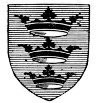
Arms of Kingston-upon-Hull.
To say exactly the date of birth of the city which to-day the inhabitants proudly call ‘The Third Port’ is one of the things that are beyond man’s power. It used to be thought that Hull was founded by King Edward I., but we know now that this was wrong; for there are in existence old title deeds which show that the city goes back in point of time more than one hundred years before ‘Edward of the Long Shanks’ became King of England.
On the other hand, we are certain that there was no town of Hull in the time of William the Conqueror. Had there been, we should find mention of it in the Domesday Book. Hessle is mentioned in this, and so is Ferriby. But, though we find in the Domesday Book no mention of Hull, we do find mention of Myton, a hamlet belonging to the Manor of North Ferriby, and recorded at the time of the survey as ‘waste.’
Later on we find this hamlet grown into a manor, and meanwhile there was growing up alongside it another small settlement to which became attached the names Wyke, Wyke-upon-Hull, and Hull. Its position was the angle formed where the small river Hull empties itself into the mighty Humber, and its first inhabitants would doubtless be fishers and other sea-faring men, who found the place 112convenient for beaching their boats. Whether they were Angles or Danes we cannot definitely tell, for its name, Wyke, might have been given by either of these peoples.
The first mention of Wyke is in a grant of land made in the year 1160, and after this date its growth must have been rapid. Less than forty years later it was one of the ports to which was given the privilege of exporting wool; and in 1203 the taxes collected on wool and other exported goods at Hull amounted to no less than £344, while those collected in London amounted to only £836.
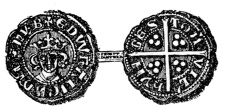
Silver Penny coined at Hull in the Reign of Edward I.
The export trade in wool grew by leaps and bounds during the thirteenth century, and Hull was the port in the north of England that derived most benefit from this growth. At the close of the century there were ‘some sixty houses in the town, mostly built of clay and timber, and one-storied, with perhaps a chamber or two in the thatched roof; a gaol; a court-house; a church[28] ...; a monastery of White Friars; with some seven acres of land set apart for markets and fairs, and lying around and about where the Market-place now runs.’
Such was Wyke, or Hull, when in 1293 the monks of Meaux Abbey, its owners, sold the greater part of it to King Edward I., in exchange for other lands. Its annual value was £81 12s. 4d., and that of the part sold was £78 14s. 8d. With it were sold some farm lands and buildings at Myton, worth not quite half as much.
When the town thus passed into the King’s hands, he had 113to appoint a Warden to collect his rents, and the first King’s Warden rejoiced in the name of Richard Oysel. Six years later the townsmen obtained from the King a charter granting them all the privileges belonging to the inhabitants of a ‘Free Borough.’ Among these was the right of holding a market twice weekly, and a fair lasting for thirty days each year.
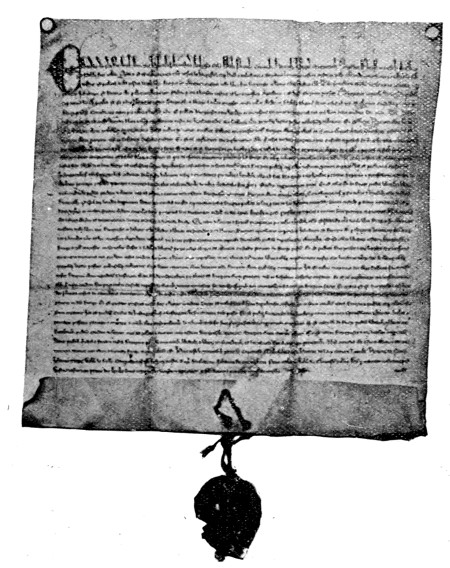
| Photo by] | [J.R. Boyle |
| Photograph of the Charter granted by Edward I. to the Townsmen of Hull in 1299. | |
| (One-fifth actual size). | |
114Under its new name of the King’s Town upon Hull the port naturally drew to itself merchants from the less-privileged towns of the neighbourhood, and among those who came to take advantage of its privileges was a wealthy merchant of Ravenser named William de la Pole. With the migration of this Ravenser merchant began an uninterrupted course of prosperity both for his family and for the King’s Town.
William de la Pole’s two elder sons, Richard and William, came into great prominence as merchants. The ‘great Hull Firm of De la Pole Brothers’ has been a modern description of their business enterprise, and the adjective ‘great’ is rightly used. For not only was Richard de la Pole King Edward III.’s wine merchant, but the two brothers were also for many years the King’s bankers. As royal wine merchant, Richard had some twenty deputies in other ports of England, and as royal bankers the ‘Firm’ lent large sums of money to the King for the carrying on of his wars with Scotland and France.
In 1327, for instance, these Hull merchants lent the King sums amounting to £10,200; and in February of the next year the King, while at York, paid two wine bills, one of two thousand marks and the other of £1,200. Later on in this year, the brothers undertook to find £20 per day for the upkeep of the King’s household, and as much wine as was necessary.
In 1337 Edward declared war against France, and that war was carried on mainly with supplies of money provided by the De la Pole Brothers.
Within two years of the opening of war, the King had borrowed money on the crown jewels, on the crown itself, and even on his own person. Edward was actually stranded in France unable to move for lack of money, when his ‘beloved merchant,’ William de la Pole, came to his assistance 115with new supplies; and the King acknowledged himself bound to him for the astonishing sum of £76,180, a sum equal to more than a million pounds in our money.
‘How was this immense sum raised?’ we may quite naturally ask. Probably a large portion of it was borrowed by the lender from others who were quite ready to put their spare cash into the hands of such a far-sighted and reliable man of business as William de la Pole. And how was the loan repaid by the King?
The answer to the second of these questions gives the secret of the wealth of the ‘Hull Firm.’ Edward repaid his loans not with money but by grants of the customs and duties payable on exported goods at the various ports of the kingdom. In other words, if the King borrowed £1000, he gave to the lender of this sum permission to collect all the dues at, say, the port of Bristol, for the next five years; and as the trade of Bristol was then rapidly growing, the lender very probably received during those five years twice as much value in dues as he had lent in money to the King.
Such services as these, rendered at a critical moment, did not go unrewarded in other ways. In 1332 Edward visited his new ‘King’s Town’ on his way to Scotland, and was the guest of William de la Pole, whom he knighted before his departure.
At the same time the townsfolk were granted the dignity of having a Mayor and four Bailiffs instead of a Warden, and Sir William was, naturally, the man chosen by them to hold this office.office. Thus the long line of Mayors of the city of Hull goes back to Sir William de la Pole, who was Mayor for three years, 1332–1335. Later on other honours were showered upon him, and when he died his body was buried in the church of the Holy Trinity, where the alabaster effigies of himself and Dame Katherine his wife may still be seen.
116As William de la Pole was a great favourite of King Edward III.Edward III., so his son Michael was equally a favourite of Edward’s grandson, King Richard II. Michael de la Pole had gone to Spain in the train of John of Gaunt, Edward’s third son, and his retinue had consisted of 140 men-at-arms, 140 archers, 1 knight banneret, 8 knights bachelor, and 130 esquires.
In 1376 Michael was not only Mayor of Hull but also ‘Admiral of the King’s Fleets in the Northern Parts.’ Seven years later he became a Knight of the Garter and Lord Chancellor of England. In another two years he was raised to the peerage as Earl of Suffolk, the first example in our history of a prosperous merchant becoming a peer of the realm. As Earl of Suffolk, Michael began the building at Kingston-upon-Hull of a mansion which was known when finished as Suffolk Palace, and which stood on the ground where has recently been built the General Post Office.
But the first Earl of Suffolk was by no means a favourite with Parliament, whatever he might be with the young King; and though he had as Lord Chancellor advised the members of Parliament to ‘avoid all corruptions,’ he was accused by them of enriching himself at the expense of the nation. As the result of the charges laid against him by his many and powerful enemies he was exiled, and died at Paris four years after the creation of his peerage.

Effigies of Sir William de la Pole and Dame Katherine in Holy Trinity Church, Hull.
From Gough’s ‘Sepulchral Monuments.’
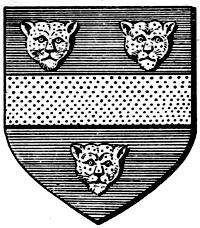
Arms of the De la Poles.
Richard II.’s deposition by Parliament followed ten years after his favourite’s death, and Henry IV. became King. This King’s son, Henry V., attempted to rival in France the exploits of his great-grandfather; and in his retinue when the English army sailed from Harfleur were two Michael de la Poles, father and son. Both were of high honour in the King’s train, both set out in hopes of winning still higher honour in the glorious conquest that was to be, but 118both were fated to die a soldier’s death on the soil of the country which they had hoped to conquer. The elder Michael, second Earl of Suffolk, died of dysentery before the walls of Harfleur in September 1415; the younger Michael, third Earl of Suffolk, fell mortally wounded in the battle of Agincourt, five weeks after the death of his father. His body was brought home to England, and lay in state in Saint Paul’s Cathedral before it was buried in Oxfordshire.
You will find an account of the Earl of Suffolk’s death in Act IV., Scene 6, of Shakspeare’s playplay Henry the Fifth; and when you next read of the wars of Edward III. and Henry V. in France, do not fail to remember, if you yourself belong to the city of Hull, that good silver crowns from Kingston-upon-Hull provided the wherewithal for the battle of Crecy, and that good honest men from Kingston-upon-Hull fought, and—in one case at least—died in the battle of Agincourt.
Two years after this battle, King Henry was again fighting in France, and in his retinue was again an Earl of Suffolk. This was William, the fourth Earl, brother of him who had been slain at Agincourt. ‘Thirty lancers and four score and ten archers’ was the portion of the army furnished by this Earl, and for seventeen consecutive years he served in France as a soldier of the King. While Henry VI. was the infant King of England, Suffolk was in command of the English army in France, and it was his misfortune to be beaten by the ‘Maid of Orleans.’ In this war he was taken prisoner by the French, and ransomed for the sum of £20,000.
119After Suffolk’s return home as a defeated soldier we find him playing the part of a successful ambassador. The marriage of King Henry with Princess Margaret of Anjou was arranged by him, and for his services he was raised to the dignity first of a Marquis and secondly of a Duke. At the same time his heirs were granted the privilege of carrying at the coronation of all the King’s successors a golden sceptre with a dove upon the top—a privilege embodied in the design of the Common Seal of the Corporation of Kingston-upon-Hull.
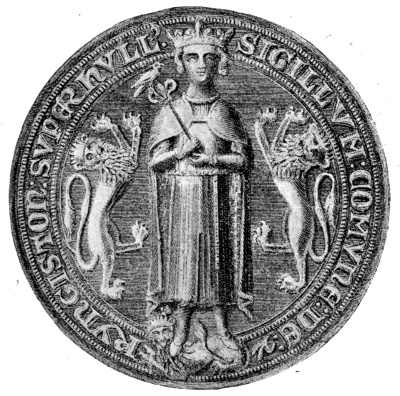
Common Seal of the Corporation of Kingston-upon-Hull.
But this marriage brought the newly-created Duke of Suffolk into great disfavour with Parliament; for he was accused of having delivered the important province of Maine into the hands of the French, this being one of the 120conditions of the marriage treaty. His enemies also accused him of having murdered the Duke of Gloucester.
To save his favourite Duke the King banished him for five years, but his enemies were determined that he should not escape their vengeance. Realizing the danger he was in, he set sail from Ipswich, and hoped to reach Calais in safety. Before his departure he wrote, on the 30th of April, 1450, the following letter to his young son:—
My dere and only welbeloved sone, I beseche oure Lord in Heven, the Maker of alle the world, to blesse you, and to sende you ever grace to love hym, and to drede hym; to the which, as ferre as a fader may charge his child, I both charge you and prei you to ... do no thyng for love nor drede of any erthely creature that shuld displese hym....
Secondly, next hym, above alle erthely thyng, to be trewe liege man in hert, in wille, in thought, in dede, unto the Kyng ... to whom bothe ye and I been so moche bounde to....
Thirdly, in the same wyse, I charge you, my dere sone, alwey, as ye be bounden by the commaundement of God to do, to love, to worshepe youre lady and moder, and also that ye obey alwey hyr commaundements, and to beleve hyr councelles and advises in all youre werks....
It was indeed the day of Suffolk’s ‘departyng fro this land,’ as the following portion of a letter written in London on the 5th of May of that year will show. The writer tells first how news had then reached London that on April 31 121the Duke of Suffolk had been captured off Dover by a ‘shippe callyd Nicolas of the Towre,’ whose master ‘badde hym “Welcom, Traitor.”’ Then—
Yn the syght of all his men he was drawyn ought of the grete shippe yn to the bote ... and oon of the lewdeste of the shippe badde hym ley down his hedde, and he should be fair ferd wyth, and dye on a swerd; and toke a rusty swerd, and smotte of his hedde withyn halfe a doseyn strokes, and toke awey his gown of russet, and his dobelette of velvet mayled, and leyde his body on the sonds of Dover.
Although the first Duke of Suffolk suffered this ignominious death, the tide of fortune for his family still rose. John, his son, the second Duke, married the sister of King Edward IV.; and in the year 1484 their son John, Earl of Lincoln, was declared heir-presumptive to the throne of England.
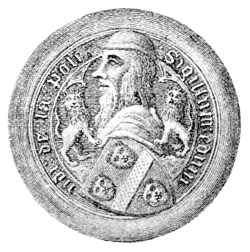
Seal of Edmund de la Pole
Earl of Suffolk.
This is the high-water mark of the family fortunes. The battle of Bosworth, and the accession of King Henry VII. a year later, altered everything. The Earl of Lincoln took up arms against King Henry on behalf of the pretender, Lambert Simnel, and was killed at the battle of Stoke in 1487. His younger brother, Edmund de la Pole, Earl of Suffolk, was considered a man too dangerous to be allowed to live and was beheaded by Henry VIII. in 1513; and his remaining brother, Sir Richard de la Pole, having fled to Italy, was killed in the battle of Pavia in 1525.
| Sir WILLIAM DE LA POLE. | ||
| A merchant of Ravenserodd, who migrated to Hull. | ||
| ┌──────────────┴──────────────┐ | ||
| Sir Richard de la Pole. A merchant of Hull; d. 1346. │ |
Sir William de la Pole. A merchant of Hull, founder of the Hull Charterhouse and first Mayor of Hull (1332–5); d. 1366. | |
| │ | ||
| Michael de la Pole, Earl of Suffolk. Mayor of Hull 1376, and Admiral of the King’s Fleets in the Northern Parts; Italian Ambassador and Lord Chancellor of England; d. 1389 in exile at Paris. | ||
| │ | │ | |
| Richard, Duke of Buckingham and Chandos. d. 1889. | Michael, Earl of Suffolk. Fought at Harfleur, and died of dysentery, Sept. 18, 1415. | |
| ┌────────────────┬──────┘ | ||
| Michael, Earl of Suffolk. Slain at Agincourt, Oct. 25, 1415. | William, Earl of Suffolk. Commander of the English army in France; became Marquis, and later Duke, of Suffolk; was accused of various crimes, exiled, and murdered at sea, 1450. | |
| │ | ||
| John, Duke of Suffolk. Married Elizabeth, sister of Edward IV. and of Richard III.; d. 1491. | ||
| ┌─────────────────┬────────┴─────┐ | ||
| John de la Pole, Earl of Lincoln. Declared heir-presumptive to the English throne 1484; Commander-in-Chief in Lambert Simnel’s rebellion; killed at Stoke 1487. | Edmund de la Pole, Earl of Suffolk. Beheaded by Henry VIII., 1513. | Sir Richard de la Pole. Fled to Italy, and was killed at Pavia, 1525. |
123In all English history there is no stranger family history than that of the De la Poles. For had there been no battle of Bosworth, the great-great-great-great-grandson of a Hull merchant would, in all probability, have become King John II. Such, however, was not to be, and there is now living no descendant of the first William de la Pole in the male line. A few years ago the female line was represented in the Duke of Buckingham and Chandos, who was lineally descended from Richard de la Pole, the elder partner in the ‘great Hull Firm of De la Pole Brothers.’

Arms of Bridlington Priory.
Scattered over some of the pleasantest parts of Yorkshire are to be found the ruined homes of men and women who centuries ago formed a very distinct class among the people of our country. These men and women were the monks, friars, and nuns of mediæval England, and their homes were known as monasteries and friaries.
The foundation of monasteries was due to the growth of an idea that men and women could serve God better by withdrawing entirely from worldly affairs, and by giving themselves up to a life of continual prayer and worship. Many were established in England during the tenth and eleventh centuries, but the great period of their foundation was that from 1066 to 1216. During these years no fewer than 556 monasteries were founded in our country, and 65 of these were in Yorkshire.

A Cistercian Monk.
According to whether a monastery was independent of all 124others or not, it ranked as an Abbey or a Priory; and according to the particular code of rules under which its inmates lived, it was inhabited by Benedictines, Cistercians, or Carthusians. The monks of the Order of St. Benedict were popularly known as Black Monks, and their three Abbeys in Yorkshire were at Whitby, Selby and York. They had no House in the East Riding, but there were Benedictine nunneries at Nunburnholme, Nunkeeling, Wilberfoss and Yedingham.
The Order of the Cistercians, or White Monks, received its name from the Abbey of Citeaux in Normandy. In this the rules were stricter and the life harder than among the Benedictines. The Cistercians believed that the work of a man’s hands was as acceptable an offering to God as the recitation of prayers and the chanting of psalms, and hence they became great farmers and wool-growers.[29] Yorkshire was particularly their county, and the great Abbeys of Fountains, Rievaulx, Jervaulx and Byland were some of the wealthiest and most 125powerful in England. In the East Riding the Cistercians had an Abbey at Meaux and a nunnery at Swine.
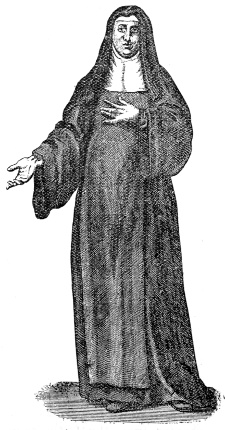
A Benedictine Nun.
A still stricter Order of monks was that of the Carthusians, who received their name from the Abbey of Chartreuse in the south-east of France. From the popular corruption of the word ‘Chartreuse’ into ‘Charterhouse,’ their monasteries became generally known as Charterhouses. One of these was established at Hull by Sir Michael de la Pole,[30] and there was in the North Riding another at Mount Grace, near Northallerton.
The life of a monk or a nun was one spent apart from the world but, at the same time, in common with all other inmates of the monastery or nunnery. The inmates worked together, prayed together, had their meals together, and slept in a common dormitory.
Their life was also one of absolute devotion to carrying 126out the rules of their Order. Each inmate took, on entering the religious life, the three vows of poverty, chastity, and obedience. By the first, no monk or nun might own separate possessions except the necessary clothing and bedding. Thus, one mattress, two pairs of blankets, two counterpanes, one cowl and frock, two tunics, two pairs of vests, four pairs of breeches, two pairs of shoes, four pairs of socks, two pairs of day-boots, one pair of night-boots, one night-cap, two towels, one soiled-linen ‘pokett,’ and one shaving cloth formed the wardrobe of a Black Monk. In addition he might possess a silver spoon, and then his outfit was complete. By the second vow he bound himself never to marry, and by the third to obey implicitly the orders of his superiors.
The Houses of these monks and nuns were, with slight exceptions here and there, constructed on certain definite lines, which can best be illustrated by a plan of the Cistercian Abbey of Kirkstall, near Leeds. Surrounding all was a wall, not shown in the plan.
The arrangement of the various buildings was very simple. Foremost in importance ranked the church, which was always the first building to be erected and that on which the greatest wealth was lavished. To the south of this were attached the domestic buildings, grouped round a central cloister court. Of these the most important were the chapter house, in which the monks assembled each morning to hear a chapter from the Latin rules of their Order; the four cloisters or covered walks in which the daily tasks of the monks were performed; the frater or refectory, in which their midday meal was served; and the dorter or dormitory, in which they slept. This last ran above the line of buildings to the south of the south transept, and had a staircase leading directly into this as well as one leading into the east cloister.
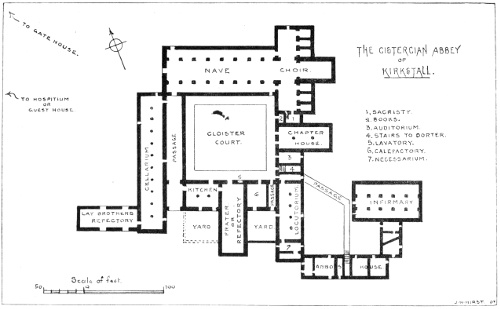
THE CISTERCIAN ABBEY OF KIRKSTALL.
From ‘Transactions of the East Riding Antiquarian Society,’ Vol. III.
128The other buildings included the sacristy or treasure-house; the library; the locutorium or parlour, which was a meeting-place for conversation as well as a school for the novices; the infirmary for sick monks; the calefactory, or warming-house, where a fire was kept burning from the first day in November till the following Easter; the kitchen; the cellarium or store-room; the hospitium or guest-house; and the Abbot’s house.
Attached to each House of the Cistercians was a band of conversi, or lay brethren, the uneducated portion of the community, who did all the rough work of the House. Their frater and dorter were separate from the other buildings, the dorter running over the cellarium; and they attended service in the nave of the church, whereas the monks used the choir or chancel.
Such was the general plan of a Cistercian monastery or nunnery. That of the Benedictines did not differ from it except that their churches were larger and more magnificently built than those of the Cistercians, and their fraters ran east and west instead of north and south.
Look at the outer wall of the south aisle of Bridlington Priory Church, and you will at once notice something strange. The windowless wall and blocked arches are due to the fact that the Abbot’s house adjoined the church at this spot. Look along the wall farther to the east, and you will see plainly the brackets on which once rested the roof beams of one of the four cloisters.
In some cases the domestic buildings lay to the north of the church, but this was exceptional. Advantage was usually taken of the protection afforded by the church against the biting north winds of winter, an advantage not to be despised by those who had to live in unwarmed stone buildings on the bleak moorlands of Yorkshire. One can imagine a shivering monk returning from his two hours’ service in the 129church at two o’clock on a cold winter’s morning, and piling on the bed his whole wardrobe in a vain endeavour to keep the marrow of his bones from freezing into solid ice. It was worth something to be an Abbot. For the Abbot’s house had fire-places, and there would be little fear of his forgetting to make use of such a comfortable privilege.
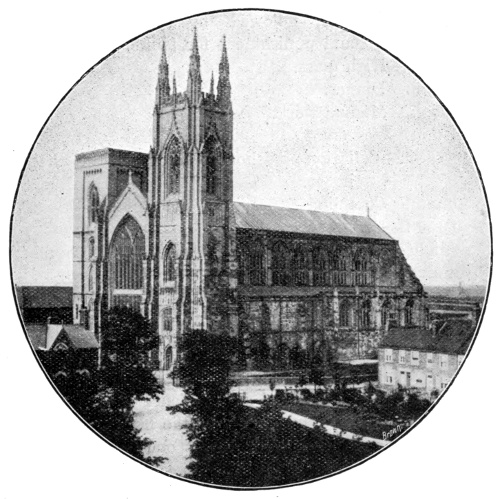
The Priory Church, Bridlington.
As was mentioned earlier in the chapter, the monk lived 130in common with his fellows. In winter his time-table was as follows:—
Strict regulations were made with regard to the church services, manual work, and meals. Each monk had some definite occupation for his working hours. He was a stonemason, a carpenter, a worker in metals, a scribe, or a farmer; and his work must be carried out in silence—a very needful exception being made in the case of the blacksmiths.
Each monk’s dinner allowance was one pound of bread and a pint of wine or ale, with two cooked dishes and fruit or salad. Mondays, Wednesdays, Fridays, and all the days in Lent were fast days, when no meat might be eaten. On these fast days there were allowed as cooked dishes to every two monks either two plaice or mackerel, or four 131soles, or eight herrings or whiting, or ten eggs. No breakfast was the rule on fast days, and to avoid excess of blood due to good living, each monk was ‘cupped’ four times a year.
Table manners were also looked after. ‘No one was to clean his cup with his fingers, nor wipe his hands, or mouth, or knife, upon the tablecloths.... Salt was to be taken with a knife, and the drinking-cup was to be held always in both hands.’
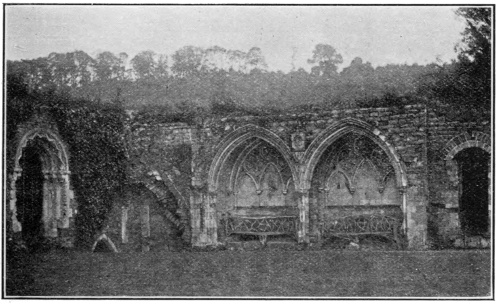
A Corner of the Cloister Court at Kirkham Priory.
The two arches at the back formed the lavatory, where the monks
washed their hands before passing into the frater by the door
on the left.
More severe by far was the life of the Carthusians. They lived solitary lives, each in his separate two-roomed cell, never talking to others, and not even seeing others except at matins and vespers. A Carthusian never ate meat and always wore a hair shirt next his skin. It is therefore not 132surprising that this Order did not become a popular one.
So far we have been dealing with monks and nuns. Besides these there were the Regular Canons—men who lived under a regula, or rule, as did the monks, and who took the same three vows, but who were generally priests, while the monks were generally laymen. The Augustinian Canons had priories at Bridlington, Haltemprice, Kirkham, North Ferriby and Warter, and there was a Gilbertine nunnery at Ellerton and a House for both Gilbertine Canons and Benedictine Nuns at Watton. Here the canons and nuns had each their separate domestic buildings, but they shared the church, the canons using one half of it and the nuns the other half.
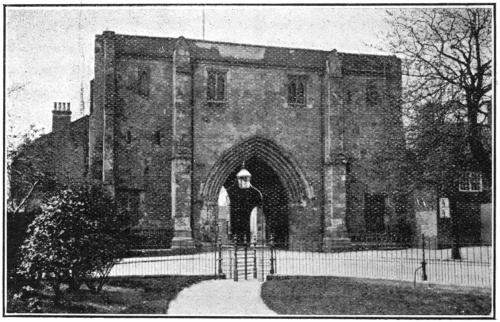
The Bayle Gate, Bridlington.
Formerly one of the gateways to the Priory grounds.
Quite distinct from monks and canons were the Friars. 133Monks were concerned with one thing only—the salvation of their own souls. Hence their monasteries were, as a rule, built in desolate spots, far removed from the centres of population. The churches of the canons were, in most cases, partly used as parish churches, the prior of the convent being also the rector of the parish. Friars were concerned 134with the salvation of the souls and bodies of other people, hence they established themselves in populous towns.towns. Fratres, or frères, they were to all poor people, whether they were Dominican Friars, Franciscan Friars, Carmelite Friars, or Austin Friars.
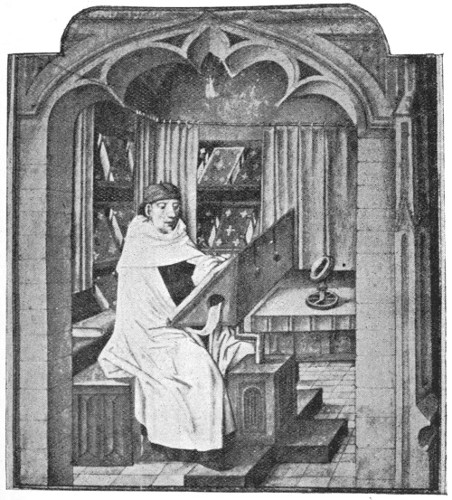
A White Friar in his Study.
(From Abbot Gasquet’s ‘English Monastic Life.’)
The followers of St. Dominic were the teachers, the followers of St. Francis the doctors, of the middle ages. Black Friars and Grey Friars they were in the language of the common people. Beverley had its Dominican and Franciscan Friaries, while Kingston-upon-Hull had its Carmelite and Austin Friaries—the names of the two latter remaining to-day in our ‘Whitefriargate’ and ‘Blackfriargate.’
It is difficult for us to realise what enthusiasm there was in the olden days for that which was called ‘the religious life.’ ‘It is good for us to be here, for here a man lives more purely, falls more rarely, rests more safely, and dies more happily’ was the honest thought of each of the religious in early days.
But as with all other human institutions, these good ideals perished in the course of time. Men did not continue to live up to the rules of their Order. Even in Chaucer’s time—that is, before the year 1400—the typical monk had travelled far away from his vows of poverty and obedience.
135Chaucer’s friar was likewise a wanton and merry man, who knew the taverns well in every town.
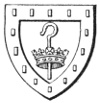
Arms of Beverley
Minster.
Each of two East Riding villages, Harpham and Cherry Burton, claims to be the birthplace of Saint John of Beverley. His date of birth is even more uncertain than his place of birth; but we know that he was sent to school at the monastery at Canterbury, and afterwards became an inmate of the famous monastery of St. Hilda at Whitby. Then he was for nineteen years Bishop of Hexham, and finally, in 705 or 706, was ‘translated’ to York, and thus became the fifth in the long line of eighty-nine Archbishops from Paulinus to Cosmo Lang.
While John was Bishop of Hexham he purchased a plot of ground in Beverley, and on it built a church which he placed in charge of a small number of canons. The surrounding country was then nothing but swamp and forest—the swamps of the river Hull and the wild woodland whose name has come down to us as ‘Beverley Westwood.’ So fond of this church was John, that in 718 he gave up his Archbishopric and retired to Beverley, where he died three years later.
136John’s church suffered the fate which came to nearly all the monasteries and churches of those far-off times. The ravaging Northmen fell upon it, and it was not till the reign of King Aethelstan that it recovered from their attacks.
Then its fame began to grow. In 934 Aethelstan was marching north to make war upon the Scots, and when at Lincoln met—so the story runs—a band of pilgrims who joyously declared that they had been healed of all manner of diseases by visiting the tomb of the blessed John of Beverley. Their story induced the King to pay a visit to the same tomb; so he journeyed directly north, crossed the Humber, and went on to Beverley, while his army went round by the longer branch of the old Roman road to York.
Arriving at Beverley, Aethelstan besought the aid of the holy Bishop John, and placed his knife on the high altar as a pledge of the rewards that he would bestow upon the church if he were successful in his journey. Thereupon a vision of John of Beverley appeared before his eyes, and he heard the words, ‘Pass fearlessly with your army, for you shall conquer’—words which certainly came true enough.
Believing that his success was due entirely to the power of the holy Bishop whose banner he had brought with him from Beverley, the King, on his return, liberally fulfilled his pledge, and endowed John’s church with grants of lands, tolls, and the right of Sanctuary.
is the way in which a charter of much later date than the time of Aethelstan describes the King’s gifts to John of Beverley’s church.
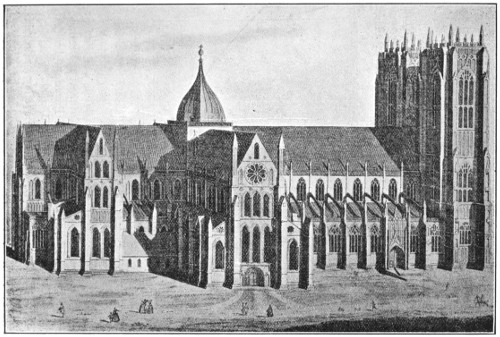
Beverley Minster in the Eighteenth Century, from the North-East.
So great after this became the fame of the miracles performed at the tomb of the founder of the church, that in 1037 the Pope ordered that John of Beverley should thenceforth be ranked as a Saint. His bones and other relics were 138then laid in a magnificent shrine in front of the high altar, and the story of the fate which came upon the sacrilegious Toustain in 1069 is sufficient evidence of their power.[33]
The charter of Aethelstan was renewed by Edward the Confessor, Henry I., and Stephen; and in the reign of the last-named King the banner of St. John was for the second time in the forefront of a battle against the Scots. This was the Battle of the Standard, when the banners of the four northern Saints—St. Peter of York, St. Cuthbert of Durham, St. Wilfrid of Ripon, and St. John of Beverley—brought victory to the English host.
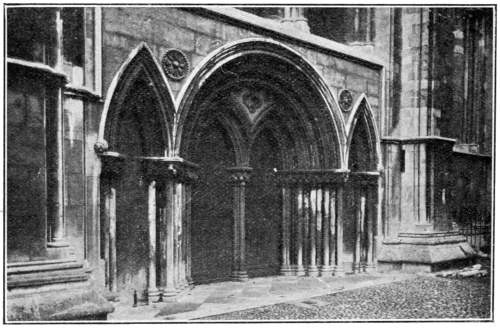
| Photo by] | [C.W. Mason |
| ‘Early English.’ Doorway in the South Transept of Beverley Minster. | |
Once again an English King visited Beverley and carried north with him the banner of St. John. The King was Edward I., the ‘Hammer of the Scots,’ and the Household 139Accounts of his reign show that in 1299 there was paid:
To master Gilbert de Grimsby, vicar of the collegiate church of St. John de Beverley, for his wages, from the 25th day of November, on which day he left Beverley to proceed, by command of the King, with the standard of St. John, in the King’s suite aforesaid, to various parts of Scotland, until the 9th day of January, both computed, 46 days, at 8½d. per diem ...
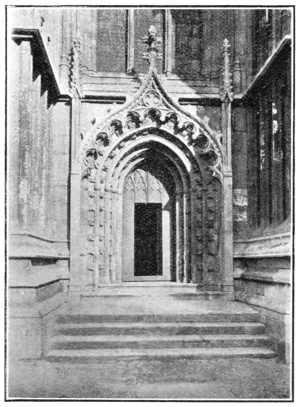
| Photo by] | [C.W. Mason |
| Small ‘Decorated’ Doorway at the west end of Beverley Minster. | |
Edward II., Henry IV., Henry V., and Henry VI. all paid visits to the shrine of St. John of Beverley, and his power was once more demonstrated in the victory of the English army at the battle of Agincourt. For during the time that the battle was being waged, did not the tomb of the Saint sweat drops of holy oil? So at least said the pilgrims to the shrine, and certainly they ought to have known whether it did or not.
Royal gifts and pilgrims’ offerings brought great prosperity to the church of St. John of Beverley. 140But evil days were fast approaching, and in 1547 Royal Commissioners were sent to report on it. They reported that there were attached to the church a Provost, 9 Canons, 7 Parsons, 9 Vicars, 15 Chantry Priests, 4 Sacristans, 2 Incense Bearers, 8 Choristers, and 22 others, a total of 77 officers, who shared among them an income of £900 derived from lands and tithes. Two years later its revenues were declared confiscated to the Crown, and its inmates reduced in number to 1 Vicar and 3 Assistants.
Of the building as it was in its earliest days we know little. In Aethelstan’s time it was probably entirely of wood. The erection of a stone church is believed to have taken place in the reign of Edward the Confessor, but we know that in 1188 the chancel and transepts of this church were destroyed by fire.
Rebuilding was commenced shortly afterwards, and a lofty tower was built on the weak foundations of the older one. As a result the new tower soon fell, and about 1225 the building of an entirely new church was taken in hand. This was the time when what we call the Early English style of building was in vogue, and there is nothing of this style in all England finer than the chancel and transepts of Beverley Minster.[34]
If you look at the old engraving of the Minster given on page 137 you will notice that this one style of building was not followed throughout the church. Just past the transepts the style changes into the Decorated style. The reason is that there was a long interval of nearly one hundred years during which the canons had not enough money to continue their building operations, so that the work came to a standstill. Meanwhile the Norman nave was still 141standing; and when at last money again became plentiful, a larger nave in the new and fashionable style was built around the old one. A curious result of this mode of building is seen to-day in that the pillars of the nave are not exactly opposite to one another, because the builders were not able to measure directly across from one to the other.
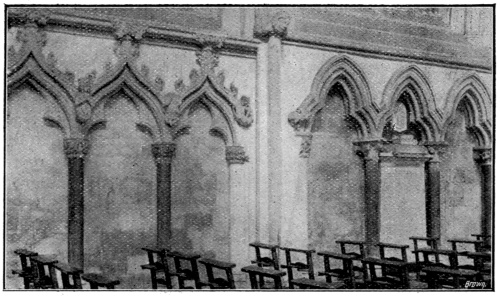
| Photo by] | [C.W. Mason |
| Part of the Arcading on the south side of the Nave in Beverley Minster, showing the change of style from ‘Early English’ to ‘Decorated.’ | |
Another glance at the old engraving will show that a further change in men’s ideas of building took place before the church was finished. The ravages of the ‘Black Death’ stopped progress for a time; and when the great twin towers of the west end were built, the Perpendicular style of building had become fashionable. Then, in order that the east window should be in fashion with the west window, it was rebuilt ‘in the latest style.’ Thus we have in the church three successive styles of building, quite different from one another, 142and yet so blended that they make one harmonious whole.
After the confiscation of the church property in 1549, the Minster fell, naturally, into sad disrepair. Its beautiful octagonal chapter house was sold and pulled down. One hundred and ten years ago the Minster was reported to be almost a ruin. So bad was its condition that the beautiful gable of the north transept had bulged outwards no less than four feet, and was saved from destruction only by the skill of a carpenter named Thornton, who erected a huge screen of timber, and forced the wall back to its upright position.
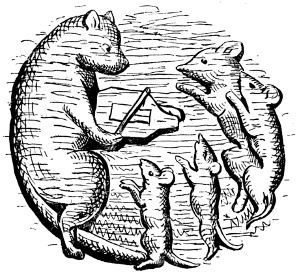
‘Hey-diddle-diddle,
The cat and the fiddle.’
A Wood-Carving in Beverley Minster.
In 1886 a great architect, Sir Gilbert Scott, was employed to make necessary restorations. First of all he took down the dome-like roof, with gilded ball above it, seen in the old engraving of the Minster. True, the Minster still lacks the central tower which, like the cathedrals of York, Durham, and Lincoln, it was originally planned to have; but better none at all than the unsuitable dome which our ancestors built a century ago. The beautiful choir screen was designed also by Sir Gilbert Scott, and was carved by a Beverley craftsman, Mr. James Elwell.
Since 1886 the main work of restoration has been the filling in of the numerous niches around the walls, 144each of which before the Reformation had its statue, great or small. Only one of these ancient statues remains, a statue of one of the Percy family, on a buttress of the north face of the north tower. There are now in position on the walls of the Minster 182 statues—108 outside and 74 inside—most of which have been provided through the generosity of Canon Nolloth.
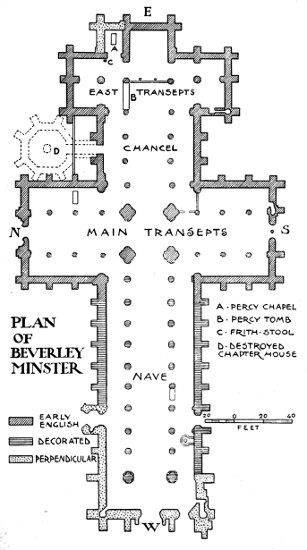
PLAN OF BEVERLEY MINSTER
There is much of interest to see around the Minster. The best view of the great towers is obtained from the entrance to Minster Moorgate; that of the interior of the nave from the upper floor at the west end, which is reached by a staircase in the north tower.
Climb to the top of the tower and you will, if the day is fine, be rewarded with a wide-reaching view over Beverley Westwood and the Plain of Holderness. Go into the chancel and examine the Percy Tomb. You are looking at the most magnificent stonework of the fourteenth century in the whole of Europe. Lift up the seats in the canons’ stalls and you will see the best collection of carved miserere seats in England. Sit in the ancient Frith-Stool and you can imagine yourself to be either an innocent victim of oppression or a criminal of the deepest dye—whichever you prefer. Stand before the great east window, and admire the beauty of the old stained glass of which it is composed. Or stand before the great west window and you will see portrayed in its coloured glass Augustine and Aethelberht of Kent and St. John of Beverley, the marriage of Edwin and Ethelburga, the baptism of Edwin by Paulinus, and Coifi, the heathen high priest, with his broken idols—an epitome of the early church history of our country.
The Church in the Middle Ages had a tremendous hold over people’s minds, and this was largely due to the power which it wielded over their bodies. Foremost amongst the rights then possessed by it was the right of ‘Sanctuary,’ by which the poor and injured could gain safety from the attacks of their oppressors, and one who had unwittingly committed a crime might save himself from a criminal’s death. This right belonged, in greater or less degree, to all the churches scattered up and down the country.
Let us imagine a by-no-means uncommon event in the years just after the Black Death. A husbandman is working for his master as a free labourer and small cottager. His father before him had also been a free labourer, but his grandfather had in his youth been a serf of the lord of a neighbouring manor. This grandfather of his, because the serfs had increased beyond their lord’s requirements, had been allowed with others to go free; and taking advantage of his freedom he had sought and obtained work as a free labourer under a new master. But now, after the Black Death, labourers are scarce; and the present lord of the manor is causing to be looked up all the descendants of those serfs whom his ancestor had set free. Thus the lord’s bailiff has been making enquiries about our freeman, and has sent two servants to arrest him and take him back to the serfdom that his grandfather had once suffered.
But our freeman is a man of spirit, and will not be taken without resistance. Knives are drawn, and he defends himself. In the scuffle one of his assailants stumbles and 146falls, and unluckily for himself and for our freeman, he happens to fall upon his own weapon, which pierces his body and so causes his death. His comrade, chicken-hearted, fears to continue the struggle alone, and makes off to the village for help.
What is our freeman to do? If he remains where he is and allows himself to be taken, not only will he be claimed as a serf by the lord of the neighbouring manor, but he will also be charged with causing the death of the lord’s servant.
Little chance is there of his proving himself innocent of his assailant’s death; for the dead man’s companion will not fail to swear that the death-blow was struck by him. In any case he will be thrown into the town jail for an indefinite length of time, perhaps not to come out alive, or to come out maimed for life. Were not three prisoners, two men and a woman, thrown into the jail last year on suspicion of having been concerned in a murder, and were they not kept there till one of the men died, the other lost a foot, and the woman lost both feet, from disease produced by the foul condition of the cell into which they were cast?
So thinks our freeman to himself. It is little comfort to him to remember that when the two prisoners who remained alive were eventually tried, they were found ‘not guilty’ of the charge laid against them, and were told by the justices that they could depart.
What can our freeman do? In a short while the lord of the manor’s other servant will come up with help against him, and he must then be overpowered. He can only flee. But whither? In the distance he can just distinguish the outline of the great church of St. John of Beverley. If he can only reach that church and knock on the small door that holds the sanctuary knocker he will be safe.
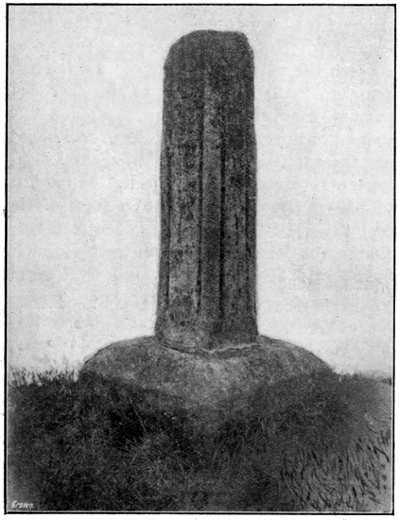
| Photo by] | Sanctuary Cross at Bishop Burton. | [C. W. Mason |
So off he sets on a six-mile run, with life before him and 147death behind. He has a good start over his pursuers, whom he can just make out half-a-mile or so away, but will he be able to hold out till he reaches the goal set before him? Nearer and nearer becomes the church, and although his pursuers are gaining on him, yet his heart is cheered by the sight of the boundary cross which tells him he has little more than a mile now to run, and which in itself gives him 148a certain amount of protection. For should he now be taken, he is under the protection of St. John, and his pursuers will lay hands on him at the risk of a fine of eight pounds payable to the Church.
Spurred on by fresh hope he reaches his goal, and has just sufficient strength to clang the knocker before he falls heavily against the heavy door. ‘Oh that the door may be opened quickly!’ His prayer is answered; for a watching priest has seen the pursuit. He draws back the bolt, drags in the senseless form, and clangs to the door again just as the pursuers reach it.
For a space of thirty days our freeman will now be safe, and during these thirty days he will be fed and lodged by the canons of the Minster. But first he will be required, with his hand placed on the great written copy of the Bible possessed by the Minster, to take an oath read out to him by the Coroner in the following words:—
‘Sir, take hede on your oth—
Ye shalbe trew and feythfull to my Lord Archbisshop of York, Lord off this towne....
Also ye shall bere gude hert to the Baillie and xij governars of this town....
Also ye shall bere no poynted wepen, dagger, knyfe, ne none other wapen, ayenst the Kynges pece.
Also ye shalbe redy at all your power, if ther be any debate or stryf, or oder sothan case of fyre within the towne, to help to surcess it.
Also ye shalbe redy at the obite[35] of Kyng Adelstan ... at the warnyng of the belman of the towne, and doe your dewte in ryngyng....’ryngyng....’
Then having taken the oath he will be required to ‘kysse the book.’
149But in the eyes of the law our freeman is a felon—a man over whose head there hangs a charge of murder, and who will have little chance of proving his innocence of this charge. He must avail himself of the law established of old and confirmed by King Edward II.—
Let the felon be brought to the church door, and there be assigned unto him a port, near or far off, and a time appointed to him to go out of the realm, so that in going towards that port he carry a cross in his hand, and that he go not out of the King’s highway, neither on the right hand nor on the left, but that he keep it always until he shall be gone out of the land; and that he shall not return without special grace of our lord the King.
Such were the rights of sanctuary possessed by the Minster at Beverley. For the space of a mile around the church in every direction the peace of St. John extended, and within this circle—the boundaries of which were marked by the erection of a ‘sanctuary cross’ on each of the roads entering Beverley—partial safety was assured to all fugitives. But the nearer a fugitive got to the high altar of the Minster the safer he became. Seated in the Frith-Stool that stood by the side of the altar he was absolutely safe; for none—not even the King himself—dare violate its sacred peace.
The Beverley frith-stool now stands in the chancel near the north-east transept. A plain, massive seat of stone it is, so massive and so simple in design that its age seems greater than that of the Minster itself. Possibly it dates back to the days of the Saxon King Aethelstan. It was once engraved, we know, with a Latin inscription, the translation of which ran thus:
This stone seat is called FREEDSTOLL, that is, chair of peace, on reaching which a fugitive criminal enjoys complete safety.
150A frith-stool very similar to the Beverley one exists at Hexham Abbey in Northumberland, and in the village church of Halsham in our East Riding there is what is thought to be another. Here, however, the ‘chair of peace’ is built into the wall of the chancel between the sedilia and the priests’ door. No other examples are known in Yorkshire.

The Beverley Frith-Stool.
Of sanctuary knockers still existing the finest is the Norman one on the north door of Durham Cathedral, but nearer home there is a good example on a door of All Saints’ Church at York. That which once existed, and which was so freely used, on a door of Beverley Minster has long ago disappeared, nor is there any known example in the East Riding.
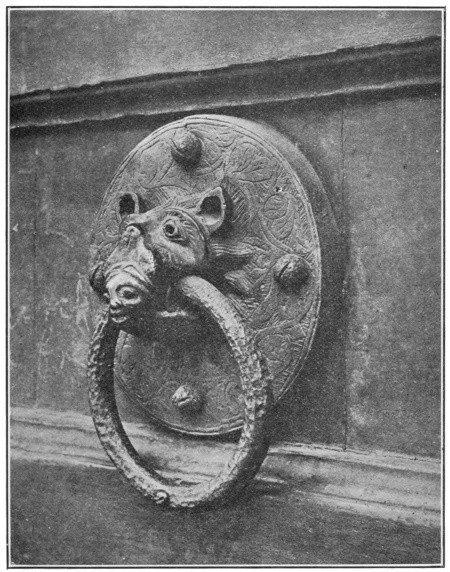
| Photo by] | [W. Watson |
| Sanctuary Knocker on a Door of All Saints’ Church, York. | |
As an instance of the protection afforded to the people by the existence of this right of sanctuary, and of the power of the Church over the minds of even such Kings as William the Conqueror, may be given the story told by Alured,[36] a 152priest of the Minster of St. John in the reign of William’s son, Henry I.:—
At the time when William was engaged on his ‘Wasting of the North’ he had once pitched his camp seven miles from Beverley, and had caused all the people of the district to flee to the church for protection. Certain soldiers coming up intent on plunder made their way to the church, and their leader, Toustain by name, did not hesitate to spur his horse within its open door. But the vengeance of St. John came down upon him for his impious deed, his horse stumbled on the threshold, and Toustain fell with broken neck. Moreover, when his men picked him up, his head was found to be twisted towards his back, and his feet and hands were distorted like those of a mis-shapen monster. Fear came upon all the Norman soldiers, and when William was informed of the miracle that had happened, fear came also upon him; so that he confirmed all the privileges of the church, gave it a grant of lands at Sigglesthorne, and decreed that the lands of the blessed Saint John should be everywhere spared from the ‘Wasting.’
In affording protection to the innocent, the injured, and the oppressed, the Church was carrying on a good work. But we must remember that the same protection was afforded to those actually guilty of all possible crimes. The registers kept at Beverley show that during a space of sixty years in the reigns of King Edward IV., Richard III., Henry VII. and Henry VIII., those who claimed the right of sanctuary included:—
| 186 | who were charged with murder, |
| 54 | ” ” ” ” felony, |
| 1 | ” was ” ” horse-stealing, |
| 1 | ” ” ” ” treason, |
| 1531 | who was charged with receiving stolen goods, |
| 7 | ” were ” ” coining, |
| 208 | ” ” ” ” debt, |
| 35 | ” ” ” ” other crimes. |
| —-- | |
| 493 | who were charged with various offences. |
In the Beverley registers there are 469 entries, of which all but a few are written in Latin. One of the English entries will give an idea of the kind of record kept:—
Memorandum, that John Spret, of Barton upon Umber, in the Counte of Lyncoln, gentilman, com to Beverlay, the ferst day of October, the vij yer of the reen of Keing Herry the vij, and asked the lybertes of Saint John of Beverlay, for the dethe of John Welton, husbondman, of the same town, and knawleg[37] hymselff to be at the kyllyng of the saym John with a dagarth,[38] the xv day of August.
It is evident from these 469 entries that the Beverley Sanctuary must have been of special repute. For the criminals who asked the liberties of Saint John of Beverley came from parts of Britain as wide apart as Lowestoft, Honiton, Haverfordwest, Anglesey, and Durham. No fewer than thirty came from London, Beverley itself provided five, Preston in Holdernes three, and Kyngestone super Hull ten; while others came from Heydon, Hezell, Hoton Cransewik, Hogett super le Wolde, Otteryngham, Wetherwyk, and fifty other towns and villages in the East Riding.
All ranks and conditions of life are represented among these entries, from the armiger or knight, and generosus or person of noble birth, down to the common laborer. The goldsmyth, 154the surgyon, the grosiar—an alderman of London—the yoman, the chapman, the shepard, and the husbondman are there. So, sad to relate, is the capellanus, or chaplain; and among the tradesmen there are the berbrower, bocher, bowyer, brykemaker, capper, coke, flecher,[39] fysshemonger, payntour, pewterer, plommer, pursor, pynner, saddiler, salter, syngyngman, and tawlowchaunler.
In the old Norse account of the life of Harold Hardrada it is stated that after the battle of Stamford Bridge Olaf, the King’s son, ‘led the fleet from England, setting sail from Hrafnseyri.’ This is the earliest mention that we have of the bank of sand and shingle which is known to-day as Spurn Point, and the name of the place—‘Hrafn’s gravel-bank’—is evidence of both its general appearance and its ownership in the year 1066.
For two centuries after this we have no mention of it, but in the meanwhile there had grown up two settlements to each of which the name Ravenser was attached. Ald Ravenser—that is, Old Ravenser—was ‘inland, distant both from the sea and the Humber’; while Ravenserodd, or as we should write it, Ravenser Point, lay ‘between the waters of the sea and those of the Humber,’ and was ‘distant from the main land a space of one mile and more.’ Connecting the two was a sandy road ‘covered with round and yellow stones, thrown up in a little time by the height of the floods, having a breadth which an archer can scarcely shoot across, and wonderfully maintained by the tides of the sea on its east side, and the ebb and flow of the Humber on its west side.’
Of the birth of the former of these towns we know nothing, but the birth of the latter was described by one of the jurors in a lawsuit brought in the year 1290 by the men of Grimsby against the men of Ravenserodd. Several years before a ship had stranded on a sand bank, and the wreck 156had been taken possession of by an enterprising fellow who used it as a store for meat and drink which he sold to sailors and merchants. Then others came to dwell on the sand-bank, and in 1235 or thereabouts the Earl of Albemarl, Lord of Holderness, began there the building of a town.
The growth of this town must have been rapid; for in 1251 the King granted to the Earl of Albemarl the right to hold in Ravenserodd a weekly market and a fair lasting sixteen days. Then trouble began between the men of the town and the men of Grimsby, and the latter complained that
the men of the said town of Ravenserodd go out with their boats into the high sea, where there are ships carrying merchandise, and intending to come to Grimsby with their merchandise. The said men hinder those ships from coming to Grimsby, and lead them to Ravenser by force when they cannot amicably persuade them to go thither.
So we see that ‘peaceful picketing’ was not altogether unknown in these parts six hundred years ago.
At intervals during the reigns of Edward II. and Edward III. the men of Ravenser were called upon to provide a ship for the King’s wars against Scotland. In each case the ship was to be furnished with from thirty to a hundred of ‘the stoutest and strongest men of the town, with armour, victuals, and other necessaries.’ In 1332, also, an expedition of five hundred men-at-arms and two thousand archers set sail from Ravenser for Scotland, having on board Edward Baliol, Lord Beaumont, Lord de Wake, and others who wished to see Baliol crowned as King of Scotland. Their wishes were fulfilled, for the expedition was successful and Baliol was crowned at Scone.
From about this time the fortunes of Ravenser began to 157decline. Probably the superior privileges granted by King Edward to his Kyngstown-svper-Hvll provided very largely the cause of the decline. The climax of its misfortunes came with a succession of extremely high tides about the year 1356—tides which ‘sometimes exceeding beyond measure the height of the town, and surrounding it like a wall on every side,’ caused its absolute destruction. In 1400 Ravenserodd was recorded to be ‘altogether consumed,’ while nothing remained of Ald Ravenser but a single manor-house.
Such was the condition of the once prosperous port when in the month of June, 1399, Henry, Duke of Lancaster, and grandson of King Edward the Third, landed on its site with sixty followers. As Henry of Bolingbroke, Earl of Hereford, he had in 1398 been banished by King Richard II. for a term of six years, in order that a duel between him and the Duke of Norfolk might be prevented. As Henry, Duke of Lancaster, he now returned to claim the estates of his father, John of Gaunt, which estates Richard had confiscated on their holder’s death.
When Henry of Lancaster landed at Ravenserespourne, he found its sole occupant to be a hermit, by name Matthew Danthorpe. This hermit was engaged in building a chapel on the desolate bank of shingle; and great must have been his surprise when a ship carrying a company of well-armed men bore down upon his hermitage instead of passing up the river, as ships were accustomed to do.
Still greater must his surprise have been when he found that the ship belonged to a royal Duke, and that its arrival was shortly followed by arrivals from inland of the great Henry Percy, Earl of Northumberland, and the Earl of Westmorland. His surprise was, probably, not unmixed with fear. For he was building his chapel without having obtained 158a license from the King, and rumours were soon flying about that Henry of Lancaster had come to claim something more than the estates which were his by right of descent.
These flying rumours soon became certainties. Other lords and barons rallied round the standard of Henry, and before long his sixty followers had become as many thousands. At the time of his landing King Richard was in Ireland; and when, after being long delayed by contrary winds, he landed on the coast of Wales, he soon fell into the hands of Henry and was taken a prisoner to the Tower of London. On the 30th of September Henry, addressing the Members of Parliament, spoke as follows:
‘In the name of the Father, Son, and Holy Ghost, I, Henry of Lancaster, challenge this realm of England ... as I am descended by right line of the blood coming from the good lord King Henry the Third.’
Then Parliament declared the abdication of King Richard the Second and the accession of King Henry the Fourth.
And what meanwhile of the hermit of Ravenserespourne? Had Henry forgotten him? On the last day of September Henry was proclaimed King, on the first day of October he signed at Westminster a royal license making known that:
Of our special grace we have pardoned and remitted to the said Matthew all manner of trespasses and mistakes committed by him in this matter....
And moreover, of our more abundant grace, we have given and granted to the said Matthew the aforesaid place, to hold to his successors, the hermits of the aforesaid place, together with the chapel aforesaid, when it shall be built and finished, and also the wreck of the sea, and waifs, and all other profits and commodities contingent to the sands for two leagues round the same place, for ever.
159The landing of King Henry IV. at Ravenser Spurn was commemorated by the erection of a cross at the place of landing. Was it a grateful Matthew Danthorpe who erected it? Very possibly. At any rate it was erected within fourteen years of Henry’s landing. Many years afterwards it was removed to Kilnsea; later still it was removed to Burton Constable, and finally to Hedon, where it stands to-day in the garden of Holyrood House.
The reign of Henry IV. was followed by that of his son and that of his grandson. Then came in 1471 one of the most curious parallels in history that it is possible to imagine. The ‘Wars of the Roses’ had been discomforting the land for sixteen years. Henry VI. had been deposed in 1461, and Edward IV. had been elected in his place. But in 1470 Henry had once more been placed upon the throne and Edward had fled to Holland. A year later the latter returned, and landed on the same spot where Henry Bolingbroke had landed seventy-two years earlier.
The parallel, however, does not end with his landing. As Henry of Lancaster proclaimed that he had come merely to claim his ancestral lands, so Edward of York proclaimed that he had returned for this same purpose only. As a Henry Percy, Earl of Northumberland, was the chief supporter of Henry of Lancaster, so a Henry Percy, Earl of Northumberland, came to the support of Edward of York. And as Henry of Lancaster was fated to depose and put to death King Richard II., so Edward of York was fated to overthrow and cause to be murdered King Henry VI.
It had been Edward’s intention to land on the coast of Norfolk. But finding a landing there impossible because of the guard kept by the Earls of Warwick and Oxford, he had headed his four large and fourteen small ships for the mouth of the Humber. The following is part of the account of 160his landing given by Ralph Holinshed, a chronicler living in the reign of Queen Elizabeth:—
The same night following, a great storme of winds and weather rose, sore troubling the seas, and continued till the fourteenth day of that moneth being thursday, on the which day with greater danger, by reason of the tempestuous rage and torment of the troubled seas, he arriued at the head of Humber, where the other ships were scattered from him, each one seuered from other; so that of necessitie they were driuen to land in sunder where they best might, for doubt to be cast awaie in that perillous tempest. The king with the lord Hastings his chamberleine, and other to the number of fiue hundred men being in one ship, landed within Humber on Holdernesse side, at a place called Rauenspurgh, euen in the same place where Henrie erle of Derbie, after called king Henrie the fourth landed, when he came to depriue king Richard the second of the crowne, and to vsurpe it to himselfe.
Richard, duke of Glocester, and three hundred men in his companie, tooke land in another place foure miles distant from thence, where his brother king Edward did land. The earle Riuers, and with him two hundred men, landed at a place called Pole, fourteene miles from the hauen where the king came on land. The residue of his people landed some here, some there, in place where for their suerties they thought best. On the morrow, being the fifteenth of March, now that the tempest ceased, and euerie man being got to land, they drew from euerie of their landing places towards the king, who for the first night was lodged in a poore village, two miles from the place where he first set foot on land.
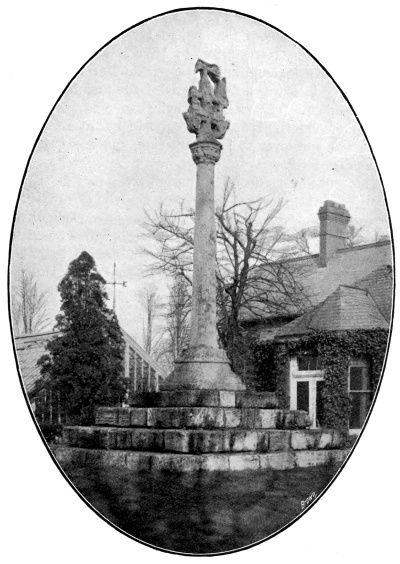
| Photo by] | [C.W. Mason |
| Henry of Lancaster’s Cross. | |
| Now in the garden of Holyrood House, Hedon. | |
162The landing of Edward IV. at Ravenser Spurn was not entirely to the liking of the men of Holderness. At first he was opposed by forces raised by ‘Syr John Westerdale,’ the vicar of Keyingham, and by a certain Martin atte See, or Martin de la Mare, a descendant of the first inhabitant of Ravenserodd. The vicar of Keyingham was afterwards cast into a London prison for his opposition, but Martin de la Mare was won over to Edward’s side, and was knighted eleven years later.
By his will Sir Martin de la Mare directed that he should be ‘beried in the queere of the parissh churche of Alhalowes in Barneston in Holdernes;’ and on the left-hand side of the chancel in this church there is an altar tomb, with a beautiful alabaster effigy, which until recently was thought to be his. It is, however, now known to be that of another knight who was buried at Barmston some fifty years before the death of Sir Martin de la Mare.
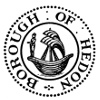
Present Seal of the
Borough of Hedon.
What sort of life did the townsfolk lead five centuries ago? Suppose the townsfolk of to-day could suddenly be transported back five hundred years, what would be the things likely to strike them as most strange?
One of these would certainly be the way in which the town was cut off, as it were, from the surrounding district. Thus Hedon was cut off by two Havens, one natural, the other artificial, and by another artificial watercourse called 163the Town Moat. Beverley was entirely surrounded by a similar moat, part of which remains in our own day, and entrance to the town was gained by Bars spanning the roads. Those at Beverley were known respectively as the North Bar, Newbiggyn Bar, Keldgate Bar, Norwood Bar, and South Bar.

| Photo by] | North Bar Without, Beverley. | [C.W. Mason |
How early these Bars were built we do not know, but there have recently been discovered the complete accounts for the rebuilding of North Bar in 1409. This is the Bar which exists to-day, and it has, in its five hundred years’ existence, undergone little change, except for the cutting through it of two side-passages for foot traffic. It still 164has the massive oak folding doors which were shut every night at sunset, and the groove can yet be seen in which the portcullis worked. If you ride on through the Bar to York, you will enter that city by the Walmgate Bar, and above your head as you pass through this you may see the bottom spikes of its still remaining portcullis.
Hull was defended even more strongly than Beverley; for in 1322 the King granted to its townsfolk leave to defend themselves with a wall as well as a moat. A portion of the wall which they built is represented on the old plan of Hull reproduced in part on the opposite page.
This plan shows the town as it was about the year 1380, and makes very clear the difference between a town and a village five centuries ago. On the left bank of the river Hull is the village of Dripole, with its church and few scattered houses; on the right bank is the town of Kyngeston-upon-Hull, with its churches, houses, and gardens closely packed together within a castellated wall, and protected by a riverside battery armed with three small cannon. The shipping on the river is seen to be also protected, and this with an iron chain drawn across the mouth of the river.
In the part of the plan not here given, there is shown a more ominous sign of authority. Outside the Beverley Gate stands a gibbet on which hang the bodies of three culprits as warnings of the fate that comes to evil-doers.
To those accustomed to the wide and well-paved streets of our modern towns, the streets of a mediæval town would appear very strange. On the plan of Hull the two main streets, then known as Aldgate and Lowgate, are shown fairly wide. But High Street, which follows regularly in its course the windings of the river Hull, is much narrower; and the by-streets of the town are so narrow as not to appear at all.
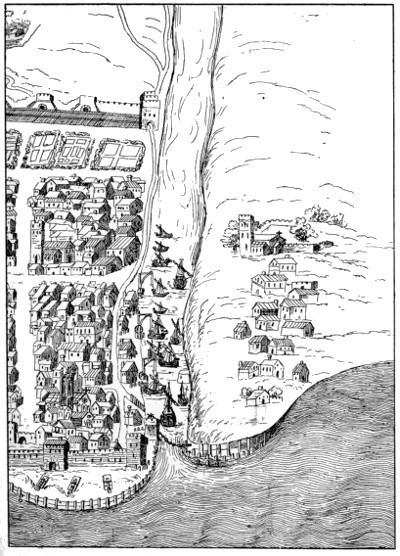
Part of a Fourteenth-Century Plan of Hull.
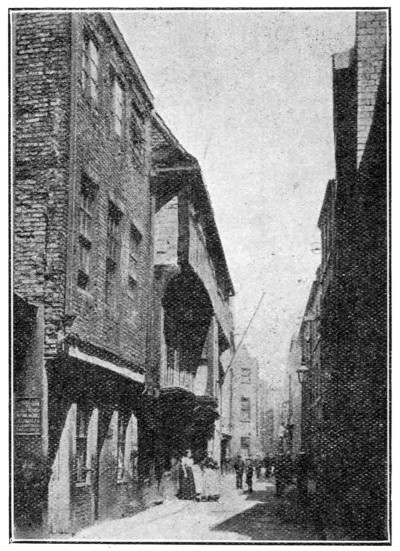
High Street, Hull.
Showing the ancient King’s Head Inn, now pulled down.
Streets in mediæval times were astonishingly narrow. The ‘High Street’ of Hull has changed little during the last five hundred years, and to-day there are portions in which two carts cannot pass each other. The extreme width of the western half of Grimsby Lane, one of the by-streets connecting High Street and the Market Place, named after Simon de Grymesby, Mayor of Hull in 1391, is only nine feet. So also the main street in Beverley now barely allows two 167vehicles to pass each other, and some of the side lanes entering it, such as Laundress Lane and Tindall Lane, are even narrower than the Grimsby Lane just mentioned.
In all these cases the roadway has remained practically the same width for a space of five centuries. But five centuries ago the condition of the road and the amount of air-space above it were very different from what they are to-day. Mediæval houses were built of thick beams of timber, with the intervening spaces filled in with brick and plaster, and security of the floors was obtained by making the second story project a foot or two beyond the first, and the third project similarly beyond the second. The result was a very firmly built house, but a very narrowly confined roadway.
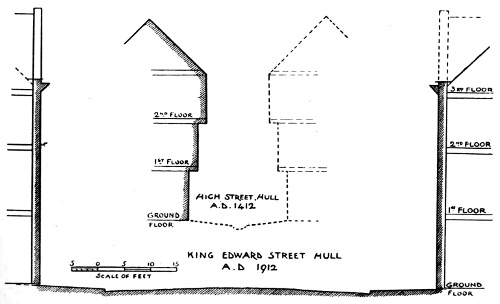
Sections of a Mediæval and a Modern Street.
The difference between the mediæval and the modern style of road planning is shown in the above diagram, which gives to scale the building-lines of High Street and King Edward Street—the oldest and the newest business streets in the city of Hull.
168Mediæval streets were paved with round cobble stones—such stones as still form the pavement of the market-places of Beverley and Hedon. It is on record that in the year 1400 two Dutch ships brought into Hull cargoes of these stones amounting to 56,000 in number. But the method of drainage was then exactly the opposite of what it is to-day; for the middle of the road was the gutter, or kennel. If we imagine that there were then no ‘dust-carts,’ and that each householder got rid of refuse by the simple process of casting it out into the kennel for the next shower of rain to wash away, we shall come to some idea of the general condition of the streets in a mediæval town.
Little wonder that in mediæval towns were bred foul diseases that broke out at intervals and sometimes carried off half the population in the course of a few months. In 1349—the year of the ‘Black Death’—1361, 1369, and 1451 the Plague visited the East Riding, and there are to be seen in the chancel floor of Holy Trinity Church, Hull, the tombstone and brasses of a merchant named Richard Byll, who was one of its victims in the last-mentioned year.
Five centuries ago one of the privileges of a free borough was the holding of a market for the sale of goods by people who were not burgesses of the town. Every free borough had its market-place, which usually lay under the shadow of the parish church, as it does to-day at Beverley, Driffield, Hedon, Howden and Hull. The markets were held on certain fixed days of the week, and Tuesdays and Fridays have been the market-days at Hull since the granting of King Edward I.’s charter in the year 1299.
While the position of the market, and probably also its general appearance, have not altered during all these centuries, certain of its adornments have entirely disappeared. Beverley is the only town in the East Riding that 169has preserved its market cross. From all the towns of the East Riding have disappeared the stocks, the pillory, and the ducking-stool.

Parish Stocks preserved in Beverley Minster.
To the stocks and the pillory went in former times such men and women as ‘John Fleshewer, butcher,’ of Hedon, who in 1420 was brought before the town bailiffs on the charge that he ‘did sell flesh not useable, old, useless, and worthless,’ and ‘Agnes, wife of John Piese, schipman,’ also of Hedon, who ‘did sell two penny wheat loaves of bread, not useable and fusty.’ In the ducking-stool went to the 170town moat or the river the scolding woman whose temper and tongue were equally beyond their owner’s control. So the stocks, pillory, and ducking-stool proved themselves to be not only ornamental but also very useful.
The daily work of wage-earners five hundred years ago was very different from what it is to-day. There were then no such things as our huge factories in which thousands of ‘hands’ are employed day after day at the same monotonous toil. Work was more varied and the conditions were much freer. But hours were longer and pay was considerably less. The legal hours of the day labourer from March to September were 5 a.m. to 7 p.m., with two hours allowed for breakfast and dinner. On the other hand, ‘Bank Holidays’—or Holy-Days, as they were then called—were far more numerous. Holy-days, in fact, reduced the working-days of the year to only 264 in number.
The building-accounts for the Beverley North Bar in 1409 give a record of all the wages paid; and from these we find that the wages of a bricklayer were 6d. per day, of a labourer 4d., and of a carter with his horse and cart 12d.[40] What would the ‘British workman’ of to-day think of the following scale of wages, which formed the statute yearly wages in 1444:—
| With food and clothing. |
|||||
| s. | d. | s. | d. | ||
| Bailiff of husbandry | 23 | 4 | or | 5 | 0 |
| Hind, carter, shepherd | 20 | 0 | ” | 4 | 0 |
| Labourer | 15 | 0 | ” | 3 | 4 |
| Woman servant | 10 | 0 | ” | 4 | 0 |
| Child under 14 | 6 | 0 | ” | 3 | 0 |
The work of the Trade Gilds in regulating the trade and 171industries of a town will be described in another chapter, but here is the place to refer to the work of the Religious or Social Gilds which were so prominent a feature of mediæval town life. These were voluntary associations of men and women, who undertook to pay sums of money into a common fund, on which all members could draw during old age or during periods of sickness. In other words they were the Friendly Societies—the ‘Hearts of Oak,’ ‘Ancient Order of Foresters,’ and ‘Oddfellows’—of our own times.
At Hull there were six of these Gilds, the most important being the Gild of St. John Baptist, the Gild of Corpus Christi, and the Gild of the Holy Trinity. In the case of the first of these a member undertook to pay two shillings of silver each year, in four instalments, and derived the following benefits, on becoming ‘infirm, bowed, blind, deaf, dumb, maimed, ... either in youth or age.’:—
(1) weekly, one halfpenny of silver;
(2) at the Festival of St. Martin in winter 5s. of silver for one garment.
The entrance fee to this Gild was 13s. 4d., but that to the Gild of Corpus Christi was 3 lbs. of silver. Here, however, the ‘sick pay’ was correspondingly higher, being 14d. weekly; and if any brother or sister was in need 20s. was ‘granted on loan.’
In the reign of Edward VI. nearly all the Religious Gilds came to an end. Henry VIII. had intended their suppression, but it fell to the lot of Protector Somerset to be their actual destroyer. On the plea that they were engaged in religious services not in accordance with Government ideas, they suffered the fate of the monasteries; and their property in lands, houses, and plate—their invested funds we should call it to-day—was diverted to other purposes.
Of the Gilds at Hull the sole one to survive was the Gild 172of the Holy Trinity, which was founded in 1369 and later became identical with the Shipman’s Gild. This identity with the Shipman’s Gild in 1547 saved its life, and in place of being swept away its privileges were increased. It had many private benefactors, chief among whom was Thomas Ferries, who in 1631 gave it the estate of the Whitefriars on which its buildings now stand. King Charles II. granted it a charter in which it is stated that the Gild
hath much tended to the furtherance of Navigation, the increase of shipping, and the well breeding of Seamen in that Town and Port.

Arms of the Hull Trinity House.
The Corporation of the Hull Trinity House consists of twelve Elder Brethren, six Assistants, and an indefinite number of Younger Brethren. From the Elder Brethren two Wardens are chosen annually. They maintain several almshouses for mariners and their dependents, and one of the best navigation schools in the country; they also grant out-pensions to a large number of worn-out seamen.
We have dealt with the work of the townsfolk in the 173fifteenth century, but what of their amusements? Here they were certainly nothing like so well off as their descendants of the twentieth century. Of theatres and kinematograph shows they had none. Football matches they had occasionally. But it was with this difference—that a football match then was not one in which thirty men played while thirty thousand looked on and yelled their applause or disapproval. A football match in those days meant one in which the ‘field’ was the main street of the town, the ‘goals’ were the town wall or moat at either end of the street, and the ‘players’ were the whole body of townsfolk. Such a match is still played annually in at least one town of Northern England.
For the rest the people had their Church-Ales, their Miracle Plays, and their Fairs. Church-Ales were parish feasts held in and around the church on the eve of the church’s saint’s-day; and to them each parishioner contributed his share—a dozen loaves, a cheese, or a few gallons of ale—the whole being then sold as required, while all present made merry. Church-Ales were, in other words, the ‘Parish-Teas’ and the ‘Knife-and-Fork Suppers’ of our own degenerate days.
As has been said, there were in mediæval towns no theatres. Still the townsfolk had their plays. In very early times the play-house was the church, the plays were representations of events recorded in the Scriptures, and the performers were the clergy.
In the thirteenth century, however, it became the custom for these Miracle-Plays, as they were called, to be performed no longer in the church, but on moveable platforms, known as ‘pageants,’ in streets and market-places, or on village greens, at the different fairs and festivals throughout the country. Yorkshire seems to have taken a prominent share in their creation; for we have to-day a manuscript of 174forty-eight plays performed regularly at York for two hundred years, and another of thirty plays performed at Wakefield. We know also that at Beverley such plays were produced each year on the festival of Corpus Christi—the Thursday after Trinity Sunday—from 1407 to 1604, and that at Hull the play of Noah was performed in the streets once each year for a space of three centuries.

A Miracle Play in the Olden Time.
What the performance of a Miracle Play was like may be judged pretty well from the accompanying illustration. The pageant was a large ‘two-decker’ vehicle, which could be drawn by men or horses from one ‘station’ to another.

Noah’s Ark.
(From an old French Miracle Play).
It was the custom at York for the first play in the series—God the Father Almighty Creating and Forming the Heavens—to begin on Corpus Christi morning at 5 o’clock. This was at the gates of the Priory of Holy Trinity. When this part of the Creation had been satisfactorily got through, its pageant passed on to take up its second station ‘at the door of Robert Harpham’; while another play showing God the Father Creating the Earth took its place. And so on through the whole series, each play being thus performed at twelve different stations during the course of the day.
The performers of these plays were the members of the various Trade Gilds of a town. So far as the number of plays allowed, each Gild might have its own play, and the plays were as far as possible appropriately distributed. Thus at York the Goldsmiths had allotted to them The Three Kings Coming from the East, the Vintners had The Turning of Water into Wine, and the Butchers had The Crucifixion. At both York and Hull the Shipmen, or Mariners, had the play of Noah.
Stage properties were well looked after. The ‘ark’ used in a French performance of The Deluge is here shown, while that used in the corresponding play produced 176each ‘Plough Monday’[41] by the Hull Shipmen was equally elaborate though built more in resemblance to an ordinary ship. It had mast and rigging, and pictures of the animals that ‘went in two by two’ hung round its sides painted on boards. From one festival to another it remained suspended from the roof of Holy Trinity Church.
Some curious items occur in the old accounts of the Hull Trinity House in this connection:—
| To Robert Brown, playing God | 6d. |
| To Noah and his wife | 1s. 6d. |
| To a shipwright for clinking Noah’s ship, one day | 7d. |
| For three skins for Noah’s coat, making it, and a rope to hang the ship in the kirk | 2s. 5d. |
When, in 1494, the Gild of the Holy Trinity had to purchase a new Ark, the accounts show also that the cost amounted to the tremendous sum of £7 4s. 11d.
The lower stage of the pageant is, in the illustration, shown to be curtained off. This lower stage was the actors’ dressing-room, and also served very conveniently as the ‘lower regions’ from which through a trap-door the Devil would emerge with horns and tail complete. God was stationed on a raised platform at the back of the upper stage, and appeared in the full dress of a Pope, saints had gilded hair and beards, and angels were dressed in white surplices through which their gilded wings projected.
Most impressive and realistic these must have seemed in the eyes of the beholders. But there were also ‘realistic effects’ to be seen—lightning, earthquakes, and the destruction 177of the world by fire—as the following items show:—
| Payd for the baryll for the yerthequake | iiijd. |
| Payd for starche to make the storm | vjd. |
| Payd for settynge the world of fyer | vd. |
How realistic also must have been the crossing of the Red Sea! For the children of Israel did actually cross it in the sight of all. ‘Halfe a yard of Rede Sea’—there it is down in black and white among the properties belonging to Israel in Egypt.
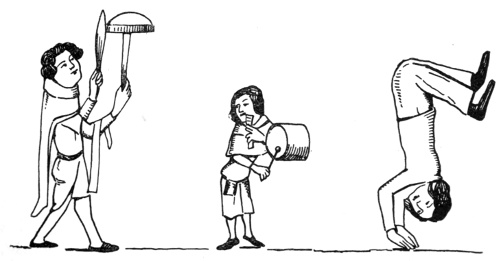
A Fourteenth Century ‘Show.’
(From an old Manuscript).
The mediæval Miracle Plays have long been dead in our country, but we still have with us the remains of the great mediæval Fairs. In the days when few people travelled if they could possibly stay at home, and when for the whole of the winter months the state of the country roads prohibited all travelling except that on horseback, fairs were a necessity. The right to hold an annual fair was therefore an eagerly sought privilege.
178Thus Beverley, Bridlington, Hedon, Howden, Hull—all these towns very early obtained the right to hold annual fairs. The Hedon townsfolk had their fair every year ‘on the feast of St. Mary Magdalen, and for seven days after,’ from the year 1162; and this fair continued to be held on Magdalen Hill down to 1878. The charter for the holding of a fair at Hull was granted in 1299, and the eleventh day of October, 1911, saw Hull Fair still in full swing.
To these mediæval fairs would come a large concourse of merchants, minstrels, pedlars, jugglers, and rogues. To them would come also householders and the stewards of manor-house and castle, eager to buy cloth, silks, ribbons, pots and pans, boots and shoes, wine, wax, malt, a store of butter to last over the winter, or a store of salt for preparing the winter meat supply.

Bear-Baiting.
A fifteenth century wood-carving in St. Mary’s Church, Beverley.
Among the entertainment providers would come the owner of the ‘wild beast show’—the show consisting of a solitary elephant or dromedary, or, much more frequently, an ape and a bear. If it is a bear that is the showman’s stock-in-trade, then there will be a chance for dogs that have grown sated with indulgence in the sport of bull-baiting to experience a new sensation.[42]
179Hither also would come that strange product of the middle ages—the pardoner. He professes to have from the Pope power to grant pardons for sins committed, or even for sins to be committed, if only satisfactory payment is forthcoming. To prove his genuineness he has a wallet full of parchments, brought straight from Rome, and all duly stamped with large seals. And if that is not enough for his credulous audience he has holy relics to show—a piece of the sail of St. Peter’s boat, and a feather from the wing of the angel Gabriel.
He has also the shoulder bone of a holy Jew’s sheep, which is guaranteed to cure disease in any cow, calf, ox, or sheep, if the bone be but washed in a bucket of water and the sick animal’s tongue well cleaned with this water. ‘One penny’ is all his charge. ‘Bring your buckets full of water. Now’s your chance! If you lose it, your sick cow, calf, ox, or sheep may be dead in the morning, and you’ll be sorry ever afterwards that you didn’t take my advice.’
Thus does the rascal do a roaring trade.
With the Trade Unions of our days almost everyone is to some extent acquainted. Certainly everyone who lives in a town is acquainted with them. For, in the first place, most workmen in a town belong to a trade union; and, in the second place, many who are not ‘workmen’, in the usual meaning of the word, are made uncomfortably aware of the existence of one or other of the Trade Unions when what is called a ‘Strike’ takes place.
180Many people, if asked their opinion, would say that Trade Unions are a purely modern institution—that it is only in our own times that workmen have found the usefulness of binding themselves together in a ‘Union’ for the obtaining of benefits which singly they could not expect to gain. But such an opinion would be wrong. Trade Unions, though called by a different name, existed in our country six, seven, and even eight hundred years ago.
What we call by the name of Trade Unions were in former times known as Craft Gilds. They had this name because they were clubs, or fraternities, or brotherhoods, of men who were engaged in some branch or branches of handicraft, and who paid a fine—originally known as gildi—to obtain the privileges of membership.
In all towns there were found these Craft Gilds. Thus in 1406 Beverley had thirty-eight, and the Craft Gilds of Kingston-upon-Hull in the sixteenth and seventeenth centuries included those of the Weavers, the Tailors, the Glovers, the Joiners, the Carpenters, the Shipwrights, the Bricklayers, the Cobblers, the Shoemakers, the Coopers, the Brewers, the Innholders, the Bakers, and the Barber Chirurgeons. Each of these crafts had its own Gild. But, on the other hand, the Goldsmiths, Pewterers, Plumbers, Glaziers, Painters, Cutlers, Musicians, Stationers, Bookbinders, and Basketmakers had to be content with one Gild among them; and a strange medley their Gild must have been.
There was one great difference between these Craft Gilds and our Trade Unions. Whereas the men who belong to the latter are the employed workmen, those who belonged to the former were both the employers and the employed, both the masters and the men. Hence the rules of the Gilds were framed not only to protect the workmen against hard and unjust masters, but also to protect the masters against dishonest and careless workmen, and, in addition, to protect 181the public from being defrauded by either dishonest masters or idle workmen. How each of these good results was effected will be seen from the following extracts, taken from the rules of different Craft Gilds belonging to Kingston-upon-Hull.
First, we will consider the protection of the workman. Before a Weaver might set up in business for himself he must pay xijd. to the Alderman of his Gild for the inspection of his workhouse by the searchers, who would search whether his workhouse were ‘good and able’ or not. If they were satisfied on this point, then the owner was permitted to begin business on payment of an ‘upsett’ of iijs. iiijd. No woman was allowed to work at this trade within the town upon pain of xls. Nor might a Tailor keep any manner of workman tailor employed within his dwelling-house. Again, no Joiner might withhold his servant’s wages over the space of six days after the same were due. If he did, the servant could get from the Warden an order for their payment, and the master’s penalty for disobeying this order was xijd.
For the protection of the masters there were corresponding laws:—
If any of the brotherhood of the Bricklayers, being at work with any man, do, in the time of his work, resort unto the alehouse or do play at dice, cards, or any other unthrifty game, he shall forfeit and pay for every time so doing viijd.
So also, in the rules of the Shipwrights, a very heavy penalty was imposed upon the workman who for mere caprice threw down his tools and left his work unfinished:—
If any person shall be lawfully retained in work by the day, and shall unjustly and unlawfully leave or 182depart from the same until such time as the same work shall be fully finished, he shall forfeit and pay to the master warden for every such offence forty shillings of lawful money of england.
The protection of the public was equally well looked after. No person might set up or keep an Inn, unless he could make and furnish four comely and decent guest beds; and every Innholder was obliged to have in his house, ready-made, four bottles of hay, to be shown to the searchers at all times when they came to make search. Thus the comfort of both man and beast was ensured to travellers.
All manufactured goods were to be open to inspection by the searchers of the particular Gild, and any scamped or fraudulent goods were ‘seized and forfeited.’ Thus a rule of the Shoemakers’ Gild stated that—
The searchers shall well and diligently search and try all boots, shoes, buskins, slippers and pantoufles,[43] whether they be made of leather well and truly tanned and curried, and well and substantially sewed with good thread, well twisted and made and sufficiently waxed with wax well rosined, and the stitches hard drawn with hand leathers.
Boots and shoes made under these regulations were intended to last in wear for a substantially long time, and brown paper inner soles and wooden heels would stand a poor chance of passing the inspection of the searchers. On the shelves of the Hull Museum may be seen some pairs of boots made and worn two hundred and fifty years ago, and still almost ‘as good as new.’
A rule of the Brotherhood of Cobblers reads quaintly. But, doubtless, it proved a very useful rule:—
If any cobbler shall keep any work brought to him 183longer than two days, without consent of the owner, he shall forfeit for every offence the sum of two shillings and sixpence.
One is bound to imagine that there was in those days a brisk trade in ‘Boots Mended While You Wait.’
Prices were also well looked after. ‘That no one presume to sell a pound of candles for more than one penny, or a gallon of the best ale for more than the same, or a gallon of small ale for more than a half-penny’—so runs one of the laws as to prices. Bakers’ charges were regulated according to the price of wheat. A farthing and a half-penny were fixed as the price of loaves, but the weight of the loaf varied. Thus in 1267, when wheat was one shilling a quarter—
| White bread | cost ½d. per 13 lbs. |
| Wheat bread | ” ” ” 20 ” |
| Horseloaves[44] | ” ” ” 27 ” |
The employment of cheap unskilled labour was expressly guarded against. In general, no master might keep more than one or two apprentices, and each apprentice must serve for a space of seven years. By the latter rule there was a kind of guarantee that an apprentice would learn his craft thoroughly before becoming a journeyman. No alien might be taken as an apprentice, and in many towns night-work was forbidden, as being usually inferior to day-work.
When an apprentice had ‘served his time’ and learned his craft, he might, in his turn, become free of his Gild and so earn the right to sell the product of his hands. But this right to sell was carefully guarded, as the following regulations of the Coopers and the Bakers show:—
No cooper, unless he be first free burgess of this town 184and free of this company, shall keep any shop in this town upon pain of 5s. weekly.
No person or persons dwelling without this town shall sell any bread or cakes within this town otherwise than on the Tuesdays and Fridays, market days, in open market.
If a craftsman was thus protected against undue competition from outsiders, so he was protected against undue competition from those who had a desire to encroach on someone else’s preserves. Carpenters might not work as joiners or as shipwrights, cobblers might not work as shoemakers, nor might shoemakers work as cobblers. ‘Every man to his own trade’ was a maxim of the middle ages, and there was then no call for a ‘William Whiteley’ or a ‘Selfridge’s, Ltd.’
Sunday labour and Sunday trading were expressly forbidden in all Gilds:—
No shopwindows of the fraternity of Shoemakers shall be opened upon the sabbath days in pain of every default viijd.
No brother exercising the crafts or mysteries of a Barber or Peruke-maker shall upon the Lord’s day, commonly called Sunday, either out or in time of divine service, work, or keep open his shop, on pain to forfeit for every time he shall be found so doing the sum of ten shillings.
Again, it is interesting to find that ‘Sunday Closing’ was provided for in the following regulation:—
No Vintner or Aleseller shall sell any ale or wine unto any one before 11 o’clock on Sunday, unless to strangers, under penalty of vjs. viijd.
Most interesting of all the thirty-eight Craft Gilds of 185Beverley is that of the Minstrels. The charter of this Gild was confirmed by ‘the gracious goodness of our most virtuous sovereign Lord and Lady, King Philip and Queen Mary,’ and is said to date ‘from the time of King Aethelstan, of famous memory.’
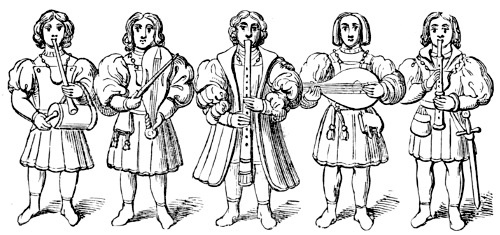
The Beverley Minstrels.
In 1520 the tower of St. Mary’s Church, Beverley, fell, and destroyed in its fall the greater part of the nave of the church. Various families of the town undertook the rebuilding of some portion of this, and one portion—the north-east pillar and the wall and roof above it—was rebuilt at the expense of the Gild of the Minstrels. This fact is recorded on a tablet placed high up on the pillar, where may be read these words:—
Attached to the east face of the pillar are also figures of five ‘meynstyrls,’ each gaudily coloured and holding his particular musical instrument—a tabor and pipe, a large viol, a shawm, a cittern, and a wait or hautboy.
186Besides these numerous Craft Gilds there were Merchant Gilds, or, as we should call them to-day, ‘Trading Companies.’
The distinction between the two kinds of Gilds is not always clear, and in some cases a trader belonged to both. But in general the Craft Gilds contained men who by their daily work changed the form of a thing, while the Merchant Gilds contained those whose daily work consisted of trading in a thing without changing its form. Thus, the Merchant Tailors bought and sold cloth, but the Tailors made the cloth into clothes. And just as to-day it is ‘much more respectable’ to be an egg-merchant than to be a pastry-cook, so, five centuries ago, it was equally ‘more respectable’ to be a merchant-tailor than a tailor pure and simple.

Arms of the Hull
Merchants’
Company.
Chief among the Merchant Gilds of Kingston-upon-Hull were the Gild of the Merchant Adventurers, originally known as the ‘Brotherhood of St. Thomas of Canterbury,’ and the Hull Merchants’ Company. During the reigns of the Tudor and Stuart Kings, these did much to foster the trade of Hull with the great ports on the other side of the North Sea.
A charter was granted to the Hull Merchants’ Company by Queen Elizabeth, and King Charles II. renewed it on receipt of ‘fifty pounds of good and lawful money of England.’ The members of the Company met in the Merchants’ Hall—the upper story of the red-brick building on the south of the Market Place, now known as the Choir School—and a ‘merchant’s mark’ is still to be seen cut in three stone panels in the front wall of the building.of the building. They were a wealthy Company, and at one time had much power. Fines or ‘upsetts’ for the privilege of membership ranged from 6s. 8d. to £20.
187It is interesting to find that the Hull Merchants’ Company acted as a Post Office for foreign correspondence. ‘Masters of ships’—so ran one of the laws governing their Exchange—must
hang up a bagg a week before their sailing, that merchants may putt their letters therein, and soe the masters to take the same away the night before they intend to saile.
Equally interesting is it to find that the Hull merchants of the seventeenth century were, evidently, firm believers in the modern doctrine of ‘Protection.’ For, by one of the statutes regulating the trade of the port, all alien merchants must bring their goods to the Exchange and must pay one penny in the pound for the privilege of sale.
What an insight into the working-lives of the townspeople, whether traders or craftsmen, we have given us in the ancient documents of the Merchant Gilds and Trade Gilds! As Canon Lambert says in his Two Thousand Years of Gild Life, they ‘bring back into view the everyday life of the town in the centuries of which they treat. As we study them we can mingle again in the vigorous life of the narrow streets. We can learn how it was that the men of that time built houses of which the mortar stands to-day as hard as stone; we can picture the barber looking askance at the upstart man who presumed as surgeon to molest his ancient right of letting the blood of his customers at the fall of the leaf; we can look into the mysteries of the brewing-vat as it was before tea had usurped the time-honoured place of the pewter at the breakfast tables of society; we can see the shipwrights who made the ships of Elizabeth at work; we can walk, as it were, along the 188small booths and shops, and judge of the quality of the goods which had come from Hamburg or Muscovy, or which had been fashioned with such care in the workshop behind the parlour.’
Of the Religious or Social Gilds, which existed at even earlier times than the Merchant and Craft Gilds, something was said in Chapter XVIII. The fate which overwhelmed the Religious Gilds during the reign of Edward VI. had, doubtless, some effect on the Trading Companies and Brotherhoods of Craftsmen. But the last-named were very largely excepted from the Suppression of the Gilds in 1547, and their gradual decay and final extinction were due to the introduction of new industries and new methods of working. The Hull Merchants’ Company became extinct in 1706, there was still existing at Beverley in 1752 the Brotherhood of the Barkers or Tanners, and the last entry in the Book of the Hull Fraternity of Coopers is dated 1788.
In a previous chapter were described the various buildings of a monastery and the mode of life of its inmates. And at the end of the chapter reference was made to the gradual loss of those high ideals which had been the origin of the many hundred monasteries that existed in our country at the beginning of the sixteenth century. The results of that loss will now be described.
The benefits to the country at large arising from the 189establishment of these religious houses had been great. They served as hotels for the rich and as almshouses for the poor. The Cistercian monks were pioneers in agriculture. Both monks and friars got together libraries of books—that at Meaux Abbey contained 324 volumes in 1539—and were mostly diligent scribes. Thus they helped to spread the means of learning.
But by the beginning of the sixteenth century many Houses had outlived their usefulness. Their inmates had decreased in numbers until only six monks remained where sixty had once been. Laxity of discipline crept in with this decrease of numbers. Hence it seemed right to suppress the small and useless religious houses, and to apply their revenues to other useful purposes.
This was the thought in the minds of both Cardinal Wolsey and the Pope of Rome when in 1524 the one applied for a certain Papal Bull and the other granted it. It was to the effect that various small monasteries to the annual value of three thousand ducats should be suppressed, and their revenues used to endow the new ‘Cardinal College’ which Wolsey was then planning to build at Oxford. Four years later permission was granted to suppress others to the annual value of eight thousand ducats. In the following year King Henry VIII. was given permission to suppress others to the annual value of ten thousand ducats, and to apply their revenues to the foundation of new cathedrals.
‘Very right and proper,’ you will probably think. ‘The money was going to be put to a better use.’ Yes, but these suppressions might point out to some unscrupulous adviser of the King a means whereby large supplies of money could easily be obtained; and if the King happened to be in need of money and was not very scrupulous as to the manner in which that money were obtained, it might become a very dangerous precedent.
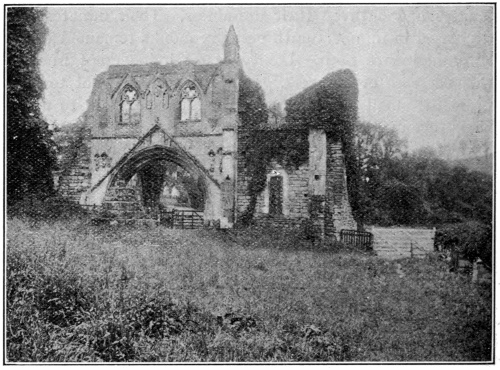
| Photo by] | The Gateway of Kirkham Priory. | [H.F. Farr |
This is just what it did become. King Henry VIII. was not a particularly scrupulous man in more ways than one, and his chief adviser after Cardinal Wolsey’s death was particularly unscrupulous. Acting on the advice of Thomas Cromwell, Parliament, at the close of 1535, ordered a ‘Visitation’ of the monasteries throughout the country, and the presentation of a report based on the results of this. Accordingly, two ‘Visitors’ were appointed, who in the short space of six weeks visited, or were said to have visited, eighty-eight monasteries in the dioceses of Coventry, Lichfield and York.
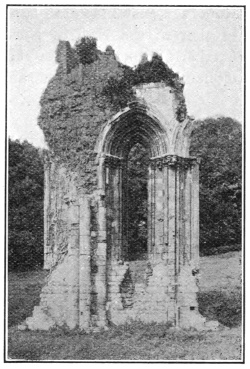
| Photo by] | [C.W. Mason |
| Ruins of the East End of the Church of Kirkham Priory. | |
The report presented to Parliament was named The Black Book, and its nature was such that in February, 1536, Parliament ordered the suppression of all monasteries that 191had an annual income of less than £200. As a result 376 religious houses were suppressed, their inmates were transferred to the larger houses or left to shift for themselves, and their lands, to the annual value of £32,000, were forfeited to the King. All the monasteries and nunneries in the East Riding thus came to an end except those at Kirkham, Meaux, Watton and Bridlington, whose annual incomes amounted to £269, £299, £360 and £547 respectively.
In most parts of the country this suppression of the smaller monasteries caused no great stir. Undoubtedly some of them needed suppression. Undoubtedly, too, the report which got about, that the confiscation of the wealth of the religious houses would provide so much money for the government that there would thenceforth be no taxes for the common folk to pay, tended to prevent an outcry from being raised by the people. But in two counties there were rebellions. The first, in Lincolnshire, proved of little account; but the second, which had its origin in Yorkshire, was a formidable rising to which was given the name of The Pilgrimage of Grace.
In this rising all the north of England was concerned. 192The great Abbeys of Yorkshire exercised a powerful influence over the minds of the people, and a widespread religious ferment broke out. Lord Darcy, Earl of Holderness, Sir Robert Constable of Flamborough, Sir Thomas Percy, brother of the Earl of Northumberland, and many other northern nobles threw in their lot with the rebellious commoners. Soon forty thousand men were enrolled under the command of Robert Aske, a Westminster lawyer and brother of John Aske, the lord of the manor of Aughton-on-Derwent.
The demands of Aske and his followers were:—
(1) The restoration of the suppressed monasteries;
(2) The expulsion of counsellors of low birth from the King’s court;
(3) The holding of Parliament and of a Court of Justice at York as well as at London.[45]
Thus the rebellion had both a religious and a political aspect, but the former was that which was most apparent. The suppression of the smaller monasteries was to be followed by the closing and pulling down of the smaller parish churches, and the church plate was to be confiscated as had been that of the abbeys and priories. That was—so people said—the intention of Thomas Cromwell, the counsellor of low birth against whom their second demand was aimed. So the men of the North were up in arms in defence of their religious liberties; and as they marched behind the processional crosses brought from their parish churches, they wore on their sleeves a roughly-made badge of the ‘five wounds of Christ.’
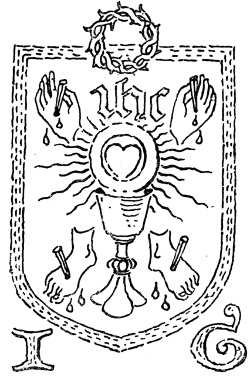
Badge of the Pilgrimage of Grace.
The letters ‘I G’ stand for the Latin
words Itinerarium Gratiae—the
Pilgrimage of Grace.
Robert Aske had been crossing by the ferry from Brough to Barton at the close of the ‘long vacation’ of 1536 when he was told by the boatmen that the Commons were ‘up’ 193in Lincolnshire. Another London barrister, William Stapleton, the son of Sir Brian Stapleton of Wighill, similarly heard of the Lincolnshire rising while he was waiting at Hull to cross the river. He had been staying with his eldest brother, ‘a very weake, craysid and ympotent man’, in the Grey Friary at Beverley. This was apparently a much-frequented health resort; for his brother was ‘lying there for chaunge of ayer as he had doon the somer before from Maye till after Mydsommer.’
It was three o’clock on the morning of October 5th when Christopher Stapleton’s servant brought word to William that
all Lyncolnshere was up from Barton to Lincoln ... and that Grauntham way was stopped as well as Lincoln, so that no man could passe to london vntaken.
So William Stapleton had perforce to remain waiting in Hull.
Meanwhile Robert Aske was sending out letters to the men of the East Riding, and on Sunday, October 8th, the 194town bell at Beverley was set ringing and the townsmen ‘took oathe to the comons.’ Then
with greate noyse, showtes, and cryes they made proclamation everye man to appere at Westwood grene the morrowe after with suche horse and harnes as they had upon payne of death.
Great was the alarm of the ‘weake, craysid’ Christopher at these doings, and he gave orders to his people that they should keep themselves within doors. But his wife had determined otherwise, and went out to talk over the hedge and learn what was happening. ‘Where is your husband and his folkes that he cometh not as other dooth?’ she was asked, and her reply made quite clear which way her sympathies lay. ‘They be in the freers, goo pull them oute by the heddes.’
Christopher Stapleton’s wife had evidently paid more heed to the advice of a certain Carthusian monk, ‘Sir Thomas Johnson, otherwise called Bonadventure,’ who was at that time an inmate of the Grey Friary, than she had to the commands of her husband.
The lady’s suggestion came very near being carried out on the following morning. But appearances were saved by William Stapleton and his brother Brian’s coming out on the ‘Westwood grene’ to take their oath, while ‘certayne honnest men’ were sent to record the oath of Christopher. Whereat Christopher’s wife and the Carthusian monk were ‘very joyous and merye,’ while outside on the ‘grene’ there were unanimous cries: ‘Maister William Stapulton shelbe our Captayne.’
William Stapleton thus became one of the leaders of the insurgents. By his orders Hunsley beacon and Tranby beacon were fired; men came in from Newbalde and North 195Cave, Brantyngham, Cottingham and Hassell; and a small army of nine thousand marched to Wighton Hill, there to meet Robert Aske, who had ‘raysed all Howdenshire and Marshelande.’
Following the plan of campaign decided upon at Weighton, Aske with the main part of the army of insurgents marched to York, which surrendered on October 16th, and thence to Pontefract, which he captured four days later. Meanwhile Stapleton laid siege to Hull, encamping his men close to the Beverley Gate. The city was being held for the King by Sir Ralph Ellerker and Sir John Constable, neither of whom would hear of surrender; for they were determined, as Sir John Constable put it, rather to ‘dye with honneste than lyve with shame.’
An easy way to effect the capture of the town was pointed out by one of Stapleton’s men, who said that
with one barell of pyche fiered and sent downe with the tyde he would sett on fyer all the shippes in the haven.
But Stapleton would have none of such methods, and, much to the disgust of the more unruly of his men, he even forbade the firing of the windmills near the Beverley Gate.
The leader of this besieging force was a strict disciplinarian. He would allow no pillaging, and gave orders that every man must pay honestly for what he took. But ‘spoylinges and prevy pickinges’ did happen, nevertheless;
wheruppon he badde watche and take some therewith, and prove what he shuld doo. And theruppon they toke one Barton a fletcher whiche the said William had put in trust to kepe their vittall, and also one nawghty fellow a saynetewary[46] man of Beverley and a comen picker taken with picking muche thinges.
196Wheruppon ... he cawsed to take the same twoo, and made them beleve they shulde dye, and theruppon assigned a freer to them being in his companye, advysing them to make them clene to God ...; after the whiche so doon the said William callid for one Spalding a waterman and in the presence of all men causede them to be called oute, and the seyntuary man was tyed by the middell with a rope to thende of the bote and so haled over the water and seuerall tymes put downe with the oore over the hedde. And thother seeing him thought to be so handiled, howbeit at the request of honest men he being a howsekeper, he was suffered to goo unponyshed and so bothe bannyshed the hoost.
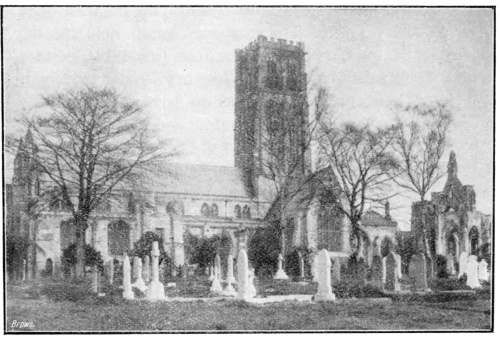
| Photo by] | [C.W. Mason |
| Howden Church from the South. | |
| Showing how the east end of the church has been destroyed. | |
A very satisfactory mode of punishment it turned out 197to be. For after this ‘there was never spoile in the company of the said William.’
The conclusion of the Pilgrimage must be briefly told. The defenders of Hull finally surrendered on honourable terms. Aske, after taking Pontefract, went south to Doncaster, where negotiations were opened with the Duke of Norfolk, Commander-in-Chief of the King’s forces. As a result of these negotiations Aske was granted a safe-conduct to visit the King in London, and returned home on January 8th, with a promise that the King would visit York next Whitsuntide and hold there a Parliament at which all grievances should be considered. Satisfied with this success Aske disbanded his men.
All might now have gone well. But unfortunately for those who had been concerned in the rebellion, a certain Sir Francis Bigod and John Hallam, a servant of Sir Robert Constable, formed plans for seizing the towns of Scarborough, Beverley, and Hull, and beginning the rebellion again. Their attempts failed, and were made the occasion of a withdrawal of the terms previously offered by the King, and the taking of ruthless measures to stamp out the insurrection.
The results of the Pilgrimage of Grace proved terrible for the ringleaders. Robert Aske was decoyed to London, arrested, tried at Westminster, exhibited as a traitor in each of the towns where he had been welcomed as a deliverer of the people, and finally hanged, drawn, and quartered at York. Sir Robert Constable was hanged in chains on the Beverley Gate of Hull, Lord Darcy was beheaded on Tower Hill, Sir John Bulmer was hanged at Tyburn, and his wife was burnt at the stake. The abbots of Fountains, Rievaulx, and Jervaulx, together with the Prior of Bridlington, were also hanged at Tyburn; and an excuse was thus made for the forfeiture of their Houses to the King.
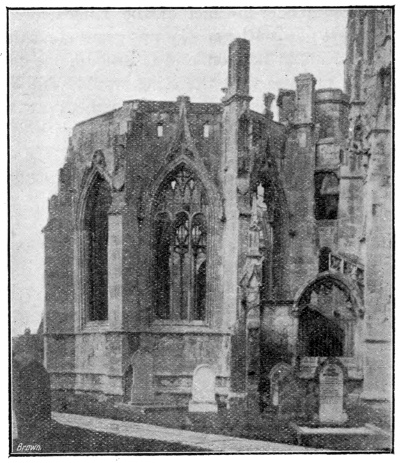
| Photo by] | [C.W. Mason |
| Howden Church—Ruins of the Chapter House. | |
When, in 1536, the decree for the suppression of the smaller monasteries was issued, Parliament thanked God that ‘in divers and great solemn monasteries of the realm, religion is right well kept and observed.’ The Abbots of some of these were induced to surrender voluntarily—‘willingly to consent and agree’ to the destruction of their Abbeys and the confiscation of all their property. The Abbots of others were convicted of high treason, and their Abbeys declared forfeited. One hundred and fifty surrendered during 1538–9, and by 1540 all had been suppressed.
199The sale of the Abbey lands realised a sum of money equal to £8,500,000 in the money of to-day, and the value of the plunder from the shrines—gold, silver gilt, and silver crosses, chalices, and candlesticks—was not less than another million pounds. The total cash value to the King amounted to nearly £15,000,000 in our money. Of this huge sum about one-half was spent on public purposes—the foundation of new bishoprics, the building of schools, and the organisation of harbours and other national defences.[47] The remainder went into the pockets of the King’s courtiers, many of whom rose from comparative poverty to a position of wealth.
What the Suppression meant to the religious houses of the East Riding may be judged from the following letter, written in 1538 by a servant of Thomas Cromwell to his master:—
Pleasythe your good Lordshipp to be advertysed. I have taken downe all the lead of Jervayse,[48] and made itt in pecys of half-foders, which lead amounteth to the numbre of eighteen score and five foders,[49] with thirty and foure foders, and a half, that were there before. And the said lead cannot be conveit, nor caryed unto the next sombre, for the ways in that contre are so foule, and deep, that no carrage can passe in wyntre. And as concerning the raising and taken downe the house, if itt be your Lordshipps pleasure I am minded to let itt stand to the Spring of the yere, by reason of the days are now so short it wolde be double charge to do itt now. And as concerning the selling of the bells, I cannot sell them above 15s. the hundreth,[50] wherein I would gladly know your Lordshipps pleasor, whether 200I should sell them after that price, or send them up to London. And if they be sent up surely the carriage wolbe costly frome that place to the water. And as for Byrdlington I have doyn nothing there as yet, but sparethe itt to March next, bycause the days now are so short, and from such tyme as I begyn I trust shortly to dyspatche itt after such fashion that when all is fynished, I trust your Lordshipp shall think that I have bene no evyll howsbound in all such things, as your Lordshipp haith appoynted me to doo. And thus the Holy Ghost ever preserve your Lordshipp in honor. At York this fourteenth day of November by your most bounden beadsman.
That Cromwell’s ‘most bounden beadsman’ faithfully kept his promise we see to-day in the condition of Bridlington Priory. What we call the ‘Priory Church’ is merely the nave of the church of the Augustinian Priory. Chancel and transepts have equally disappeared. So have the cloisters, chapter house, frater, dorter, Abbot’s house, and the numerous farm buildings which once stood within the Priory walls. Of the walls themselves nothing remains but the ‘Bayle Gate.’
A worse tale has to be told of the wilful destruction of the other monasteries, nunneries, and friaries in our Riding.
Of Kirkham Priory, on the bank of the river Derwent, there are remains only of the once beautiful gateway, the cloister court, and the east end of the church. What is now the Swine parish church was once the chancel of the nunnery church. Of the Black Friary at Beverley there are remains of the boundary wall. The oriel window of the Prior’s house is to be seen built into the modern ‘Watton Priory,’ and a few stones of the Priory of Haltemprice are built into a farmhouse which now 201occupies part of its site. Of the great Abbey of Meaux—founded in 1150 by William le Gros, Earl of Holderness, in redemption of a vow that he would make a pilgrimage to Jerusalem, and rebuilt four times during the next hundred years—there now remains not one stone in place above ground. And of the Friaries once flourishing in Hull nought remains but their mere names.

| Photo by] | [C.W. Mason |
| All that remained of Meaux Abbey in 1900. | |
‘Even where the dogs licked the blood of Naboth, even there shall the dogs lick thy blood also, O King.’ Such was the text which a certain Grey Friar used when he had occasion to preach before King Henry. A bold man he must 202have been thus to take his fate into his hands. What the fate of Friar Peto actually was is not recorded, but we know that the Grey Friars and the Carthusian Monks were treated with particular brutality.
Of the monks of the London Charterhouse five were hanged at Tyburn, and their bodies afterwards cut up. Ten were removed to Newgate on May 29th, 1537. Sixteen days later the following report was issued:—
| There are departed | 5 |
| There are even at the point of death | 2 |
| There are sick | 2 |
| There is healed | 1 |
Later on all but one are reported as dead, and three years afterwards that one was hanged at Tyburn. With his name we are already acquainted—‘Sir Thomas Johnson, otherwise called Bonadventure.’ Surely never was monk given a less appropriate name than his turned out to be.
In four different centuries has England suffered the pangs of that deplorable kind of war which we are accustomed to describe by the adjective ‘Civil.’ And in each case has the cause of the war been the same—a disagreement as to who should be the ruler of the country’s destinies. In the twelfth century it was a struggle between the King and a would-be Queen, in the thirteenth a struggle between the King and his barons, in the fifteenth a struggle between two royal families, and in the seventeenth a struggle between King and Parliament. It is the fourth of these wars that 203has gained, from the bitterness of the struggle and the catastrophe which ended it, the additional description of ‘Great.’
Both King and Parliament are among the oldest of our national institutions. In the days of the Angles and Saxons the head of the Government was the King, but his power had not been absolute. There was a body of King’s Counsellors, the Witena-gemōt, who had power to depose the King if necessary, and in whose hands rested the elections to the throne.
No idea of hereditary right to the throne then existed, and after the Norman Conquest the same right of election by the people—expressed through the Great Council—remained. It was not, in fact, till the accession of Edward I. that the principle of hereditary succession to the throne of England became firmly recognised. Edward I. was the first of our sovereigns to become King simply because he was the son of his father, and without an expression of the will of the nation.
On the death of Queen Elizabeth it happened that the throne of England fell to the King of Scotland—a King who may be described as one-fourth English, one-fourth French, and one-half Scots, in blood. It is, therefore, not altogether strange that James I., ‘the wisest fool in Christendom,’ should fail to see things from an Englishman’s point of view, or that he should be unable to understand English customs and English institutions.
Thus it was that the King began to quarrel with his Parliament, and when Charles I. became King in his father’s stead things grew rapidly worse. According to his view, he was King of England by the manifest will of God, and as the elect of God he was bound to consult none but God; while all his subjects were bound to obey his will, as they would the will of God.
204But according to the view taken by Parliament, the King was one factor only in the Government. Commons, Lords Temporal, Lords Spiritual—the ‘Three Estates of the Realm’—had the King for their head. He was, as it were, the keystone of the arch, of no power by himself, but of very great power when fitted into his place in the government of the country. Such was the view of Parliament in the early years of King Charles’ reign. Later on the Members of Parliament thought they had made a new discovery—that the arch would hold itself up without the help of its keystone.
When Charles came to the throne, England was engaged in a war upon the Continent. From his first Parliament the King demanded supplies of money to carry on this war, but was told that he must first redress the ‘grievances’ under which the nation suffered. This not being the reply that he had expected, he dissolved Parliament and began to raise money by a system of compulsory loans obtained from all townsfolk who were deemed wealthy enough to provide them. From the town of Hull the two Commissioners, who attended at the Town Hall for the purpose, demanded and received the sum of £332 13s. 4d.
At the same time seaport towns were ordered to provide armed vessels towards a fleet of one hundred ships which was being equipped. Hull’s share was three ships large enough to transport 1350 men.
As his second Parliament proved no more tractable than his first had been, the King now decided to govern without a Parliament at all; and this he did from 1629 to 1640. During this time he continued to raise money by what many people considered to be illegal taxes—such as ship money, or money provided by seaport and inland towns for the fitting out of imaginary fleets; and tonnage and poundage, a 205levy on every tun of wine imported and every pound’s worth of merchandise bought and sold.
It was only to be expected that some people would object to pay taxes which were said to be illegal. In fact many people were to be found who said, ‘We will pay no taxes which we, through our Members of Parliament, have not sanctioned.’ The famous John Hampden was one of these; and when the King’s Judges said to Hampden, ‘You and everybody else must pay,’ there were scores of people up and down the country who proclaimed openly in the market-places, 'Well, we won’t pay, that’s all.’
Matters were thus getting into a very unpromising condition when, in 1639, the King levied an army of 22,000 men to make war upon the Scots, who had shown just as strong objections to using the King’s prayer-book as the English people had shown to paying the King’s taxes. At the head of this army Charles marched north, and took up his quarters for a time at York, from which place he paid a visit to Hull.
Let us now see what Hull was like when Charles visited it for the first time.
The plan of Kyngeston-vpon-Hvll given overleaf is reproduced from the very carefully drawn plan of a famous Dutch engraver named Hollar, and shows the appearance of the town in 1640. Surrounding the town to the north and west are the town wall and the moat, repaired and cleaned out by royal orders the previous year. North Gate and Hessle Gate span the moat and thus prevent ingress from both the Humber and the Hull. At each of the intervening three gates—Low Gate, Beverley Gate, and Myton Gate—the moat is spanned by a draw-bridge, and at the ends of Postern Gate Street and Blanket Row there are in the moat stakes for the support of bridges.
208Within the town wall are plainly to be seen the chief streets and buildings. What was called The Ropery is our Humber Street, which then formed the actual bank of the Humber. Holy Trinity Church is far and away the largest of the buildings. St. Mary’s Church has now no tower, this having fallen in 1540—or, as tradition puts it, having been ‘pulled down to ye bare ground’ by order of the King. The sites of the Black Friary and White Friary are yet unbuilt upon.[51] The Suffolk Palace, begun by Michael de la Pole in 1384, confiscated to King Henry VIII., and converted by him into a ‘Sitidell and a special kepe of the hole town,’ rented of the Hildyards of Winestead by King Charles I. in 1639, and used as a magazine for military stores, forms an imposing pile of buildings. Its gardens stretch almost as far as the Beverley Gate.
On the opposite side of the river Hull, the ancient village of Dripole has disappeared, and its place is taken by a new line of fortifications consisting of a ditch and wall, the latter strengthened by the addition of two ‘Blockhouses’ and a ‘Castle.’
This line of fortifications, together with a strong bridge over the Hull, was constructed by order of King Henry VIII. when he visited Hull in 1541; and its cost, £23,000, was provided by the King from the revenues of the suppressed monasteries. Large quantities of building materials from the White and the Black Friaries were used in its construction.[52]
The welcome accorded to King Charles on this his first 209visit to Hull was most cordial. Outside the Beverley Gate he was met by the Mayor, Aldermen, and Recorder, who delivered to him the keys of the town, to be received back from the King’s hands with gracious words. In the speech made by the Recorder to his ‘Most Gracious Sovereign’ occurs this promise:—
‘We make bold, with the utmost zeal and fidelity that can be, to give your Majesty a full assurance of our most sincere loyalty, and will adhere to you against all your enemies with the utmost of our lives and fortunes.’
Then came the turn of the Mayor, who, in presenting the King with a long ribbon, which Charles at once tied in a knot and placed in his hat, said:—
‘Vouchsafe, great Sir, to accept the emblematic bond of our obedience, which is tied as fast to your Majesty, your Crown, and the Church, as our souls are to our bodies, and we are resolved never to part from the former until we part from the latter.’
But how hollow and insincere these words were was very shortly to be made apparent. Probably Charles himself recognised their tone of insincerity, and was doubtless much better pleased with the ‘purse of curious workmanship, containing one hundred guineas’ which accompanied the giving of the ‘Hull favour.’ That night the King lodged at the house of Sir John Lister[53] in High Street—that known to us as ‘Wilberforce House’—the next night he lodged at Beverley, and the following day he again reached York.
These events were happening in the month of April, 1639. On the twenty-third of the same month three years later, 210Charles paid his second visit to Hull. And what a different reception was then to await him!
During these three years the relations between King and Parliament had been steadily growing more strained. Each recognised the possibility of there being in the future an appeal to arms; and each recognised, too, the importance of possessing ‘the most important fortress in the whole kingdom, and its vast magazine, which far exceeded the collection of warlike stores in the Tower of London.’[54]
It was the King’s misfortune that Parliament, and not he, secured possession of Hull. Early in 1642 the Commons appointed Sir John Hotham, Member of Parliament for Beverley, to be Governor of Hull; and sent him down to take possession of the town, with orders not to deliver it up without the King’s authority ‘signified by both Houses.’ On April 23rd the King himself set out from York on the same errand, taking care to send forward from Beverley an officer charged with the message that the King would shortly arrive to dine with the Governor of the town.
But the result of this message was not what the King had expected it to be. Having consulted Mr. Pelham, one of the two Members of Parliament for the town, Sir John Hotham caused the bridges to be drawn up, the gates to be closed, and the walls to be lined with soldiers. The Mayor and townsfolk were ordered to keep within their houses.
It was eleven o’clock in the morning when the King, with a bodyguard of some three hundred soldiers, arrived before the Beverley Gate, where only three years before he had received such a cordial welcome. Now, when he 212commanded Sir John Hotham to open the Gate, he was met with a polite refusal. The Governor was very sorry to have to disobey the King’s command, but ‘he durst not open the gates to him, being intrusted by the Parliament with the safety of the town.’
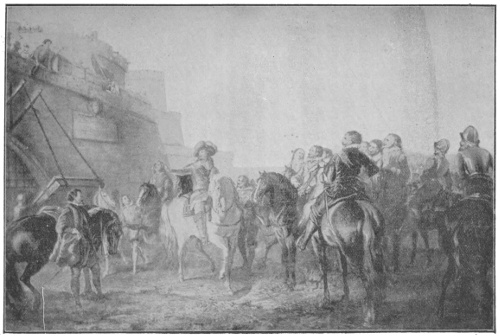
King Charles I. at the Beverley Gate, Kingston-upon-Hull, A.D. 1642.
To the offer of the King, that he would leave all his train outside the Gate, with the exception of twenty horse, the Governor proved equally unresponsive.
From eleven o’clock till four o’clock the parleying of King and Governor went on. Then the King ‘retired to a little house without the walls, and after an hour’s stay returned’ and demanded a final answer. Would Sir John Hotham admit the King to ‘a town and fort of our own, wherein our own magazine lay;’ or would he forthwith be proclaimed a traitor?
Sir John chose the latter alternative, and was at once proclaimed guilty of high treason by the King’s heralds. Then the King withdrew to Beverley, and the first act of open hostility between Parliament and King was ended. The Great Civil War had, in fact, begun.
The events of April 23rd, 1642, were immediately followed by the sending of letters to Parliament. Sir John Hotham forwarded an account of how he had obeyed the orders of Parliament to the best of his ‘understanding and utmost endeavours, though with some hazard of being misconceived by His Majesty’; while the King wrote demanding that ‘his said town and magazine might be immediately delivered 213up unto him, and that such severe exemplary proceedings should be taken against those persons who had offered him that insupportable affront, as by the law was provided.’
To the King’s letter no reply was given. But in reply to that of Sir John Hotham a deputation of members was sent to thank him and the soldiers under him for their services. Two warships were ordered to sail immediately to Hull under the command of the Earl of Warwick; and the following resolutions were passed by the two Houses:—
(1) That Sir John Hotham has done nothing but in obedience to the commands of both Houses of Parliament.
(2) That this declaring Sir John Hotham a traitor—being a Member of the House of Commons—is a high breach of the privilege of Parliament.
Copies of these resolutions, and of the ‘Declaration’ which accompanied them, were printed and spread abroad among the people. So also, from a printing-press established in St. William’s College at York, were issued pamphlets giving the King’s version of recent affairs. In one of these King Charles states his views in these words:—
We would fain be answered, what title any subject of our kingdom has to his house or land that we have not to our town of Hull? Or what right has he to his money, plate, or jewels, that we have not to our magazine or munition there? If we had ever such a title we would know when we lost it? And if that magazine and munition, bought with our own money, were ever ours, when and how the property went out of us?
The answer of the Houses of Parliament to the King’s questions was contained in A Declaration of the Lords and Commons on the 26th of May:—
By the known law of the kingdom, the very jewels 214of the Crown are not the King’s proper goods, but are only intrusted to him for the use and ornament thereof; as the towns, forts, treasure, magazine, offices, and people of the kingdom, and the whole kingdom itself, are intrusted to him, for the good and safety, and best advantage thereof; and as this trust is for the use of the kingdom, so ought it to be managed by the advice of the Houses of Parliament, whom the kingdom has trusted for that purpose.
While letters, pamphlets, and declarations were thus being composed, both King and Parliament were making preparations for actual warfare. And herein are seen the far-reaching effects of the prologue to the drama of the Great Civil War. The King had not—so the Royalist historian, the Earl of Clarendon, tells us—‘one barrel of powder, nor one musket, nor any other provision necessary for an army; and, what was worse, was not sure of any port to which they might be securely assigned; nor had he money for the support of his table for the term of one month.’
To purchase a supply of arms and ammunition by the sale of her own jewels, as well as of the Crown jewels, which Parliament was shortly to declare were ‘not the King’s proper goods,’ the Queen had sailed to Holland; and as the result of her journey a small ship, named the Providence, arrived in the Humber and was run ashore in Keyingham Creek. Sir John Hotham, hearing of its arrival, sent out from Hull a party of soldiers to seize its cargo. But his men were unsuccessful, and thus a small supply of military stores reached the King at York.
Meanwhile Parliament was busy in borrowing money ‘to raise forces which should defend the Protestant religion ... and the privileges of Parliament.’
These few words show us what was really the cause of the 215trouble. There had been growing up in the country a strong religious spirit which we call Puritanism, and the Puritans hated everything that savoured of Roman Catholicism. The Queen, Henrietta Maria, was a Roman Catholic, and the King was thought to have leanings to ‘idolatry’ himself. It was feared, in fact, that King Charles’ intention of raising an army of 22,000 soldiers for service in Ireland, and of arming them from the magazine at Hull, was only a subterfuge. What he really intended, so the Puritans said, was to overawe Parliament, and make England again a Roman Catholic country.
By the judicious spreading abroad of such pamphlets as the following—
More news from Hull; or a most happy and fortunate prevention of a most hellish and devillish plot, occasioned by some unquiet and discontented spirits against the town of Hull, endeavouring to command their admittance by casting balls of wild fire into the town, which by policy and treaty they could not obtain
—Parliament succeeded in borrowing a large sum of money, and large quantities of plate.
On June 3rd there assembled on Heworth Moor, close to the walls of York, a huge gathering of the King’s adherents, whose help was asked in ‘the defence of true religion, and of the laws and constitutions of this kingdom.’ The King was here accompanied by his son, Prince Charles, a bodyguard of 150 knights in armour, and some 800 soldiers. A month later the Court was moved to Beverley, where the King took up residence in the house of Lady Gee, a short distance within the North Bar.
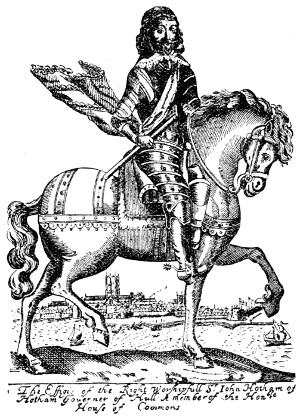
Sir John Hotham.
Now began the first of two sieges which the town of Hull sustainedsustained during the war. The King’s forces are said to have 216amounted to 3,000 foot soldiers and 1,000 horsemen. Two hundred of the latter, under the command of Lord Willoughby de Eresby and Sir Thomas Glemham, were sent to establish forts at Paull and Hessle, on the shore of the Humber, above and below the town. A similar number of the former were employed in digging trenches to divert the stream which gave the town its water-supply.
But the Royalists were no match for the defenders of the town. The Governor called a Council of War, and the Council decided on a bold stroke of defence—nothing less than the cutting of the banks of the Humber and the Hull. This was immediately carried out, with the result that the low-lying lands surrounding the town were submerged, and any widely-planned measures of attack were rendered impossible. Sir John Meldrum, a Scots officer whom Parliament had sent down to assist the Governor, also organised a surprise attack on the King’s forces. The foot soldiers 217fled at the first blow, and the horse soldiers, thus left unsupported, were compelled to retreat to Beverley.
Luck was, it seemed, entirely against the King. Off Paull one of the Earl of Warwick’s ships of war fought with and sank a vessel bringing guns and ammunition to him, and in an engagement in the village of Anlaby a barn was set on fire which contained a large portion of the ammunition which he then possessed. These reverses caused the King to decide on raising the siege, and on retiring to York.
The measures adopted by the Governor for the defence of Hull thus proved entirely successful. But an interesting side-light on these measures is thrown by The Humble Petition of the Gentry and Inhabitants of Holderness, which was signed by ‘neer three hundred’ of his ‘Majesties most loyall and oppressed subjects,’ and ‘delivered to His Majestie at Beverley the sixth of July, 1642.’ The petitioners declare that they have
for the space of four moneths (with much patience and prejudice) endured great and insupportable Losse ...
They further complain that the cutting of the river banks Drowning part, and indangering the rest of the Levell of Holderness, is a Presumption higher than was ever yet attempted by any Subject.
The answer of ‘the Kings most excellent Majestie,’ signed by Lord Falkland, contains many fair words, and a promise that he will
by drawing such Forces together as he shall be able to leavie, endeavour the Petitioners Relief in their present sufferings—
a promise which the ‘Gentry and Inhabitants of Holderness’ probably did not consider altogether satisfactory.
218Queen Henrietta Maria, who had during all this time been raising supplies of money for her husband, set sail from Holland on February 2nd, 1643, bringing with her a supply reckoned by popular rumour at £2,000,000. For nine days the small fleet accompanying her battled against a storm, and the Queen’s personal bravery was shown when she kept up the spirits of her terrified attendants with the jest that ‘Queens of England are never drowned.’
After a second start she eventually reached Bridlington Quay, and slept once more on land. But in the early hours of the February morning the little seaport was awakened with the noise of guns, and the crashing of shot among the houses. Four ships of the Parliamentarians were outside the harbour firing at the Dutch vessels which had brought over her and her supplies.
Once again the Queen showed her courage. For, hurrying to a place of safety in what scanty clothing she could lay hands on, she remembered that she had left behind her little lap-dog, and would not rest content until she had returned to her bedroom and rescued it. The rest of that night the Queen spent taking refuge in a ditch, but the morning brought to her aid some of the forces of the Earl of Newcastle, and the journey to York was accomplished in safety.
Less than twelve months after the first siege of Hull, the town came within an ace of falling into the hands of the King, and this through treachery on the part of its former defender.
Sir John Hotham, who had on more than one occasion shown a certain amount of indecision, and who was credited by some with secret leanings to the King’s party, was greatly angered by the decision of Parliament that its forces in the North of England should be under the command of another Yorkshireman, Ferdinando, Lord Fairfax. Considering himself 219and his services slighted, he now, with his son, Captain Hotham, plotted to give up the town to the Queen.
But the plot was discovered, owing to counter-treachery on the part of one of his relatives; and on June 29th Captain Mayer, in command of the Hercules, then lying in the Humber, landed a hundred men and seized the castle and block-houses.
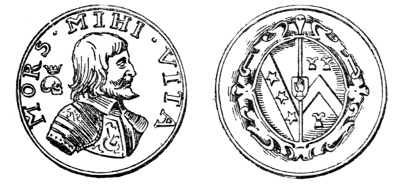
Medal Struck in Memory of Sir John Hotham.
Meanwhile the Mayor, Mr. Thomas Raikes, had placed a guard over the Governor’s house, and had secured possession of Captain Hotham. The Governor himself effected his escape, passed out of the town by the Beverley Gate, attempted unsuccessfully to cross the river Hull at Stoneferry and at Wawne, decided to attempt to reach his house at Scorborough, was met in Beverley by his nephew, Colonel Boynton, and was knocked off his horse and captured by one of the latter’s soldiers.
Both father and son were sent to London on board the Hercules, and were then committed to the Tower. After an imprisonment lasting for seventeen months they were tried at the Guildhall, and condemned to death on a charge of ‘traitorously betraying the trust imposed upon them by Parliament.’ New Year’s Day, 1645, saw the execution of Captain Hotham on Tower Hill, the following day saw that of his father.
220To return to the events of 1643—Lord Ferdinando Fairfax was appointed Governor of Hull in place of Sir John Hotham, and to raise money for the payment of his soldiers sold to the Trinity House his store of family plate. The agreement made on the occasion runs as follows:—
Whereas I Ferdinando Lord Fairfax, Lord Gen̄all of the Northerne forces raised for the Kinge, & Parlmᵗ; and Governor of the Towne of Kingston upon Hull, have received the some of ffoure hundered pownds, & foure shillings of the Guild, or Brotherhood of Maisters Pilotts, & seamen of the Trynity howse of the said Towne, for the use of the King, & Parlmᵗ: I doe hereby grant, bargaine, & sell sev̄all peices of silver plate conteining in weight one thousand six hundered ffiftie six ownces, to the said Trynity howse, & their successours for ever and have delivered the said plate to Willm Peck, & Willm Rayks Wardens of the said howse to the use thereof. In witnesse whereof, I have hereto sett my hand & seale the 4th day of September, Anno dni 1643
Two days before the signing of this agreement the second siege of Hull had been begun by the Marquis of Newcastle, with a force of 4,000 horse soldiers and 12,000 foot. This had been rendered necessary by the fact that Newcastle’s Cavaliers would not leave their Yorkshire homes on a march southward, while the hated Roundheads remained in possession of a stronghold from which they could with ease ravage the surrounding country. Hence Newcastle wanted, above all things, to gain possession of the town.
The second siege of Hull was very largely a repetition of the first. The besiegers cut off the water-supply, and also succeeded in mounting guns within half-a-mile of the 221town walls. With these guns much damage was at first done; for by constructing a furnace for the heating of balls, the gunners were enabled to fire red-hot balls over the walls of the town. But this was not for long, Lord Fairfax’s erection of a flanking battery soon putting these guns out of action.
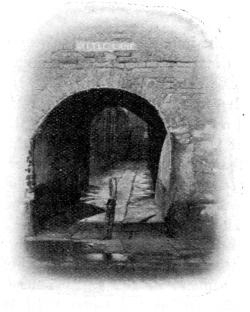
| Photo by] | [C.W. Mason |
| Hull’s Water Gate.[55] | |
At the beginning of the siege the Governor’s son, Sir Thomas Fairfax, who had been driven out of Beverley, had taken refuge within the walls with a large body of cavalry. But horse soldiers are not of much use in repelling a siege, and their horses are likely to be a severe hindrance. So it was in this case; and when the opportunity was afforded by the arrival of some of Oliver Cromwell’s soldiers at Barton, Sir Thomas and his ‘twenty troops of horse’ were ferried across to Lincolnshire.
On the 22nd of September—a day being held in the town as one of fasting and humiliation—Cromwell himself crossed over the Humber, bringing a fresh supply of muskets and powder. The town was now once more entirely surrounded by water. For a fortnight before this the former Governor’s plan of 222cutting the rivers’ banks had been carried out, and the Royalists thus compelled to abandon their positions.
Things were going badly for the besiegers. On September 28th their powder magazine at Cottingham was blown up, but whether by accident or by treachery is not known. On October 5th a reinforcement of 500 men crossed over to Hull from Lincolnshire, and six days later the garrison made a successful sally and captured one of a pair of huge guns known familiarly as ‘the Queen’s pocket pistols.’ That night the Marquis of Newcastle determined to raise the siege, and on the 12th of October the besieging army withdrew to York, smaller by one-half than it had been six weeks earlier.
The importance of the two sieges of Hull cannot be overestimated. Had the first been successful, the King would have been in the position to strike a decisive blow before the forces of Parliament were organised. In 1643 the King’s plan of campaign was that his three armies—his own at Oxford, that under Sir Ralph Hopton in Cornwall, and that under the Earl of Newcastle in Yorkshire—should converge on London, the headquarters of Parliament.
But for this plan to succeed two obstacles must be removed. The Parliamentarians held the seaport towns of Plymouth and Hull. The siege of each was undertaken; and the siege of each failed, mainly because Parliament held ‘the command of the sea.’ Thus, in the words of the great historian of the Great Civil War, ‘Hull and Plymouth saved the Parliamentary cause.’
‘My ancestor came over with William the Conqueror,’ boasts one who is proud of his long line of ancestors. ‘So did mine’—‘and mine’—‘and mine’—might say a good number of us. Perhaps we could not prove our statement, but never mind. If we cannot prove that an ancestor of ours did come over with William the Conqueror, no one can prove that he didn’t.
Of course we all of us had ancestors living somewhere or other in the year 1066, but there are very few who can identify those ancestors. How many of us can trace back our pedigree for a couple of hundred years? Few probably. But the family descent of some of our countrymen and countrywomen can be traced back for several hundred years. These are our nobles and landed gentry.
Thus the descent of the present Baron Hotham of South Dalton can be traced back, through the Sir John Hotham who defied King Charles I., to an ancestor who in the twelfth century changed his name from De Trehouse to Hotham; that of Major Chichester-Constable of Burton Constable to an Ulbert Constable who lived in the reign of Henry I.; that of the Duchess of Norfolk to a William Fitz Nigel, who was Lord of Flamborough in the same reign; that of Mr. W. H. St. Quintin of Scampston Hall to a Sir Herbert de St. Quintin who was one of the companions-in-arms of William the Conqueror; and that of the Duke of Northumberland and Earl of Beverley to a Willelmus de Perci, who ‘came over with the Conqueror’ in the year 1067.
Proudest of all the proud nobles of the North were the 224Percys, whose descent from Willelmus de Perci has just been mentioned. Willelmus took his surname from the village of Perci in Normandy, and himself boasted a descent from one of the companions of that Rolf the Viking who sailed up the Seine in the year 912. Als Gernons he was nicknamed, from his habit of wearing whiskers, whence the name ‘Algernon’ which was given generation after generation to the male members of the family.
In the Domesday Book Willelmus de Perci is recorded as the tenant-in-chief of more than a hundred manors in Yorkshire, and of twenty-three in Lincolnshire. Among the former were Leconfield, Scorborough, and Nafferton; among the latter Immingham. Willelmus was one of the Norman knights who accompanied Duke Robert of Normandy in the First Crusade, and he died at Mountjoy within sight of the Holy City.
Century after century the Percys took part in all great affairs of state. A Percy fought in the Battle of the Standard, another took part in the signing of Magna Carta at Runnymede, another was taken prisoner with the King at the battle of Lewes, another fought in the great naval victory of Sluys, and helped to win the battle of Neville’s Cross six years later.
The thirteenth Baron Percy was created Earl of Northumberland on the day of Richard II.’s coronation. But he and his son ‘Harry Hotspur’—the hero of the famous battle known as ‘Chevy Chace’—befriended Henry of Lancaster when he landed at Ravenser Spurn. Afterwards, however, both father and son rebelled, and Hotspur met his death at Shrewsbury, while his father was slain at Bramham Moor, in Northumberland. Hotspur’s son, the second Earl, fell at the battle of St. Albans which opened the ‘Wars of the Roses,’ and his grandson, the third Earl, fell at Towton six years later. Such a race of fighters were the Percys.
225Most princely of the line was Henry Algernon Percy, the fifth Earl, nicknamed ‘Henry the Magnificent.’ He took part in the Field of the Cloth of Gold, and ruined himself by the expense there entailed. This Henry Percy possessed a castle at Wressle, and a fortified manor-house at Leconfield—the latter a large house standing ‘withyn a great Mote,’ and built ‘three partes ... of tymbere,’ the fourth part being ‘of stone and some brike.’ The ‘Mote’ remains, but all traces of the ‘large House’ with its eighty-three rooms have disappeared.
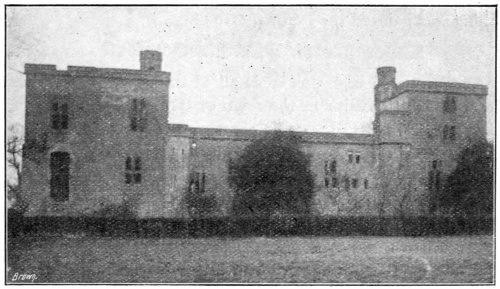
| Photo by] | Wressle Castle. | [C.W. Mason |
Wressle Castle, or rather a part of it, still exists—the only ancient castle in the whole of the East Riding. Built in the closing years of the fourteenth century, it remained the chief Yorkshire seat of the Percys till the time of the Great Civil War; when orders for its destruction were issued by a Parliamentary Committee at York, although the owner—the tenth Earl of Northumberland—had sided with Parliament against the King.
226The castle was built round a central courtyard, and in 1650 three sides of the square were pulled down, only the south side being left standing. A fire which broke out about 120 years ago completed the destruction of the interior of this remaining side, so that what exists to-day is a mere shell.
This block of buildings contained the Great Chamber or Dining Hall, the Drawing-Chamber, and the Chapel. The last was afterwards used as the Parish Church. On its ceiling was painted the Percy motto:—
Above the chapel was a small chamber which is thus described by a visitor in the reign of Henry VIII.:—
One thing I likid exceedingly yn one of the Towers, that was a Study, caullid Paradise; where was a Closet in the midle, of 8 squares latised aboute, and at the Toppe of every square was a Desk ledgid to set Bookes on Cofers withyn them, and these semid as yoinid hard to the Toppe of the Closet; and yet by pulling, one or al wold cum downe briste higthe in rabettes,[56] and serve for Deskes to lay Bokes on.
Much interesting information as to life in a mediæval castle can be gleaned from what is known as The Northumberland Household Book.[57] The original manuscript of this was prepared in 1512 by the orders of Henry the Magnificent, and gives a detailed account of the estimated household expenditure for a year and of the regulations of the household.
From this book we learn that the staff at Wressle Castle consisted of 166 persons, of whom eleven were priests, and 227that ‘the Hole Expensys ... for oone hole Yere amounted to DCCCCXXXIIJL. VJS. VIIJD.’ It is strange to find that beds, hangings, and furniture were moved from one residence to another when the Earl travelled, and that there is no mention of glass among the table requisites, vessels for eating and drinking being solely of wood or pewter.
For travelling and for hunting the Earl’s stables contained vj Gentle Hors, iiij Palfreis (one for my Lady and three for my Lady’s gentlewomen), iij Naggs, iij Sumpter Hors and Mail Hors (for carrying the bed, coffers, and coats of mail), vij Hors for the use of servants, and vij Charriot-hors to drawe in the Charriot.
Very precise rules are given for the serving of meals. Breakfast was served at eight, and dinner at eleven, each morning. Among the rules to be observed for the serving of meals are these:—
First when they go to Cover, Hee [the Usher] must go before them through the Hall, crying ‘By your leaves Gentlemen, stand by.’
If any unworthy Fellow do unmannerly sett himself down before his Betters, he must take him up and place him lower.
Let the best fashioned and apparrelledapparrelled Servants attend above the Salte, the Rest belowe.
If one Servant have occasion to speak to another about Service att the Table, let him whisper, for noyse is uncivil.
What my Lord and Lady had to eat for breakfast is shown in the following extracts:—
Furst a Loof of Brede in Trenchors ij Manchetts[58] j Quart of Bere a Quart of Wyne Half a Chyne of Mutton or ells a Chyne of Beif boilid.
During Lent no breakfast was allowed on Mondays, Wednesdays and Fridays, but on the other days of the week there were provided in place of ‘meitt’:—
ij Pecys of Saltfisch vj Baconn’d Herryng iiij White Herryng or a Dysche of Sproits.
What the Earl’s children had for breakfast in the nursery is similarly shown:—
Item a Manchet j Quarte of Bere and iij Muton Bonys boilid.
Or, during Lent:—
Item a Manchet a Quarte of Bere a Dysch of Butter a Pece of Saltfisch a Dysch of Sproits or iij White Herryng.
Among the household necessaries to be provided are:—Wheet, Malte, Beefis, Muttuns, Gascoin Wyne, Poorks, Veelis, Lambes, Stokfish, Salt Fishe, Whyt Hering, Rede Herynge, Sproits, Salmon, Saltt Elis, Fieggs, Great Rasins, Hopps for Brewynge, Hony, Oile, Waxe, Weik for Lightys, Bay Saltte, White Saltte, Parishe Candell, Vinacre, Lynnon Clothe, Brass Pottis, Mustarde, Stone Crusis, Rughe Pewter Vessel, and All Manner of Spices—Piper, Rasyns of Corens, Prones, Gynger, Clovvez, Sugour, Allmonds, Daytts, Nuttmuggs, Rice, Safferon, and Coumfetts—See Cholys, Char Cholis, Fagoots, and Greet Woode, ‘bicause Colys will not byrne withowte Wodd.’
229For the great feasts during the year xx Swannys were to be provided from the Earl’s Carr at Arram, in addition to xxix Does and xx Bukks from his Parks at Leconfield and elsewhere. So also for my Lord’s table were to be bought Capons, Geysse, Chekyns, Pegions (‘iij for jd.’), Cunys (‘ijd. a pece’), Pluvers (jd. a pece’), Mallardes, Woodcokes, Seegulls (‘jd. a pece so they be good and in season’), Styntes (‘vj for jd.’), Quaylles, Snypes, Pertryges, Redeshankes, Dottrells, Bustardes and Larkys (‘xij for ijd.’). Hearonsewys,[59] Bytters,[59] Fesauntes and Kyrlewes were to be paid for at the rate of ‘xijd. a pece’; but the most expensive dish was one of Cranys, which cost ‘xvjd. a pece.’
What high junketings there must have been at Wressle Castle in the days of ‘Henry the Magnificent’! Did the feasters afterwards pay for their over-indulgence in rich food? An answer may perhaps be supplied from the purchase of ‘xxx Saks of Charcoill for Stilling of Bottells of Waters’—Water of Roses, Water of Harts Tonge, Water of Parcelly, Water of Walnott Leeffs, Water of Prymeroses, Water of Cowslops, Water of Tandelyon, Water of Marygolds and many others—‘all worth,’ each penitent would doubtless declare, ‘xxjs. a bottell.’
In chapter XV. mention was made of the Percy Tomb in the chancel of Beverley Minster. The magnificent canopy of this was built in memory of Eleanor Fitz Alan, wife of Henry Percy of Alnwick, who died in 1328. Henry Percy, fourth Earl of Northumberland, lies buried in the Percy Chapel at the extreme east end of the Minster, and the wife of another Henry Percy lies buried in Hessle Church. But of her burial there is no record but a simple brass inscribed:—
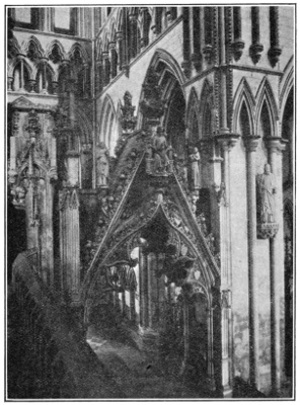
| Photo by] | [C.D. Holmes |
| The Percy Tomb, Beverley Minster. | |
Other proud nobles of our Riding were the Wakes and the Cliffords. Hugh Wac married the daughter of Gilbert of Gaunt, the first Earl of Lincoln, and his son Baldwin assisted at the coronation of King Richard I. A descendant, the first Baron Wake, fought in the Scots wars of Edward I. Thomas, the third Baron, was granted by Edward III. 231leave to convert his manor-house at Cottingham into a castle. From him the Wakes of Somerset claim descent.
On the chancel floor of Londesborough church may be seen the brass of Margaret, Lady Clifford and Vescy, the wife of the Lord Clifford whom Shakspeare calls ‘bloody Clifford.’ This Lord Clifford fought on the Lancastrian side at the disastrous battle of Towton, and was one of the many nobles there slain. During twenty-four years after the battle Henry, Lord Clifford’s son, lived in disguise as a shepherd on the moors round Londesborough and on the hills of Cumberland, thus earning the name of ‘shepherd lord.’ But the battle of Bosworth Field restored the fortunes of the family, and the ‘shepherd lord’ then regained ‘the estates and honours of his ancestors.’
The descendants of Henry, Lord Clifford, became Earls of Cumberland, and the heiress to the Earldom married Richard Boyle, the first Earl of Burlington. Their great-grandson, the third Earl of Burlington, was famed for the rebuilding of Burlington House, London, and for the planting of the ‘Londesborough Clumps.’ This was between the years 1703 and 1753.and 1753.
From the third Earl of Burlington the Londesborough estates passed in descent to the Dukes of Devonshire, one of whom pulled down its ancient Hall, and afterwards sold the estates to George Hudson, the ‘Railway King.’ By further purchase they devolved upon the present Earl of Londesborough.
Older than the Cliffords are the Constables, of whom there are in the East Riding two distinct families. Robert Constable, the son of Ulbert, possessed the manor of Halsham in the reign of King Stephen; and from him is descended Major Chichester-Constable, Lord of the Seigniory of Holderness, and owner of Burton Constable Hall.
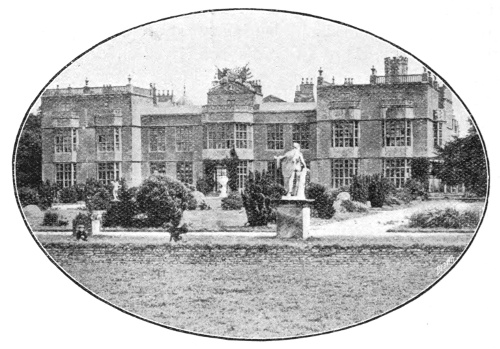
Burton Constable Hall.
In the year 1133 was living a certain William Fitz Nigel, Constable of Cheshire and Lord of Flamborough. From him descended Sir Marmaduke Constable of Flamborough, who, when seventy-one years of age, fought together with his four sons in the battle of Flodden. Sir Marmaduke lies buried in the church at Flamborough, where, on his tomb, is a brass inscription recording his exploits. Part of it is here given:—

Brass of Sir Thomas de St. Quintin in Harpham Church. About a.d. 1420.
The Sir Robert Constable who took part in the Pilgrimage 233of Grace and was hanged in chains over the Beverley Gate at Hull was Sir Marmaduke Constable’s eldest son. With his execution the fifty-one manors that he held were forfeited to the King, but some of these were restored to his descendants by Edward VI. and Queen Elizabeth. The last of the Constables of Flamborough took the side of the Parliamentarians in the Great Civil War, and signed the death-warrant of the King.
From the second son of Sir Marmaduke Constable descended the Constables of Everingham, to which house belongs the Duchess of Norfolk, daughter of the late Baron Herries. From Sir Marmaduke’s nephew descended the Constables of Wassand, whose representative to-day is Mr. Henry Strickland Constable of Wassand Hall.
Another East Riding family whose ancestor ‘came over with the Conqueror’ is that of the St. Quintins, whose name is derived from a town in the north of France. Sir Herbert de St. Quintin held the manors of Skipsea, Mappleton and Brandesburton in the reign of Henry I. 234On the floor of the chancel of Brandesburton church are the brasses of Sir John de St. Quintin, who died in 1397, and his wife Lora.
Several members of the family lie buried in Harpham Church, where are the altar tombs of Sir William de St. Quintin, who died in 1349, and his wife; the brasses of Sir Thomas de St. Quintin and his wife Agnes, dating from about 1420; and the brass of another Thomas de St. Quintin, who died in 1445.
Sir William St. Quintin was Member of Parliament for Hull in the reigns of William III., Anne, and George I.; and Mr. William Herbert St. Quintin, of Scampston Hall and Lowthorpe Lodge, is the present representative of the family.
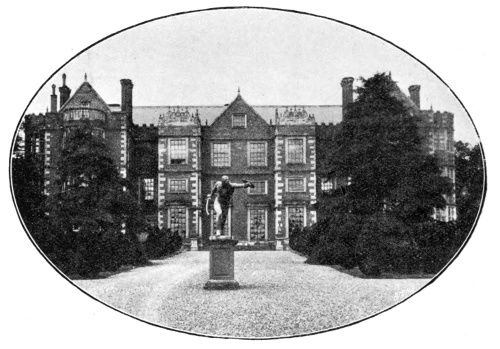
Burton Agnes Hall.
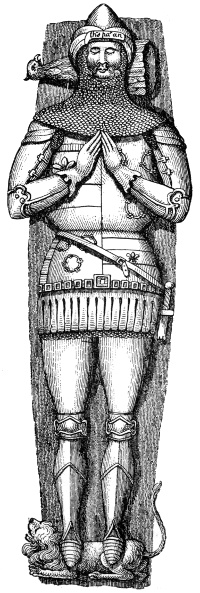
Effigy of a Knight in Plate
Armour in the Hilton Chapel at
Swine Church. About a.d. 1350.
The ancient family of Boyntons took its name from the East Riding village of Boynton. By marriage with the heiress of the Sir Martin de la Mare mentioned at the close 235of Chapter XVII., the family became possessed of the manor of Barmston; and in 1614 Matthew Boynton married Frances, daughter of Sir Henry Griffith of Burton Agnes. Four years later he was created a baronet by James I., and forty years later his son, Sir Francis Boynton, succeeded to the Burton Agnes estates. Sir Griffith Henry Boynton of Barmston, and Mrs. T. L. Wickham-Boynton of Burton Agnes Hall, are his descendants.
Burton Agnes Hall is famed as being ‘one of the most beautiful Tudor houses in Yorkshire.’ Parts of a building to the west of the Hall go back to about the year 1170, and some of its woodwork dates from the middle of the fifteenth century. But the Hall itself was built in the early years of the seventeenth century, and the date 1601 and the initials of Sir Henry Griffith and his wife are carved in the stonework over the main doorway.
Taking part in the Wars of the Roses was a Robert Hildyard of Winestead, famed widely as ‘Robin of Redesdale.’ Winestead came into possession of the Hildyards by the marriage of this 236Robert with the heiress of the Hiltons, three of whose altar tombs remain to-day in the Hilton chapel of the church at Swine.
Another Robert Hildyard had command of a King’s regiment of horse in the Great Civil War, and for his services in this was knighted and afterwards created a baronet. There are in Winestead Church fragments of large brasses, an altar tomb, and a wall monument, to different members of this family; to a younger branch of which belong the Hildyards who have for many generations been rectors of Rowley.

Effigy of a Knight in
Chain Armour in the
Saltmarshe Chapel at
Howden Church.
About a.d. 1280.
How early the Saltmarshes of Saltmarshe, near Howden, took their name is not definitely known. Sir Edward de Salso Marisco was Member of Parliament for Beverley in 1299, and a Geoffrey de Saltmersc held lands at Swinefleet about 1170. Their ancestor is said to be Lionel Saltmarshe, who was knighted by William the Conqueror in 1067. Colonel Philip Saltmarshe is the representative of the family to-day.
Last to be mentioned here are the Stricklands of Boynton. The family had its origin at Marske, in the North Riding, and a Sir Thomas de Strickland bore the banner of St. George at the battle of Agincourt.
237William Strickland, who purchased the manor of Boynton in 1549, sailed when a youth to the New World with Sebastian Cabot, and helped to discover Labrador and Newfoundland. He is said to have introduced the turkey into our country—a deed commemorated in the family crest. His descendant was created a baronet by King Charles I., and the present Sir Walter William Strickland, of Boynton Hall, is the ninth holder of the title.
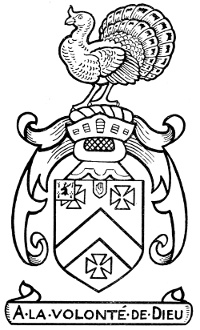
Coat-of-Arms of the Stricklands.
Readers of Tom Brown’s School-Days will all remember the hero’s friend Martin, his second in the historic fight with Slogger Williams. ‘The Madman’ was his name among his fellow school-boys, but it was as Sir Charles Strickland that he was known in the neighbourhood of Boynton.
Travelling for pleasure is something that we all understand. But our forefathers a few centuries ago would have thought a person mad if he had said he was going to take a journey for pleasure. Merchants had to travel, and so had messengers; but ordinary folk stayed at home, unless the burden of their sins moved them to undertake a pilgrimage to some far-off shrine. Such journeys were performed on horseback or afoot, but invalid women and infirm old men might use a horse-litter.
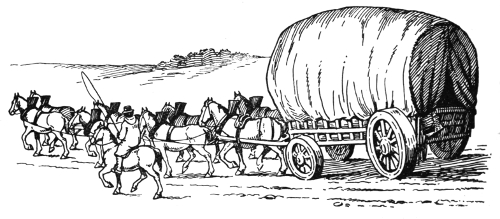
On the Road in 1812.
An East Riding Stage Waggon.
Until the reign of Queen Mary I. there was in England no such thing as a coach. The lumbering stage waggon with wheels ten or twelve inches wide, and drawn by eight or ten horses attended by a driver who rode on the back of a pony, came into use during the reign of Queen Elizabeth. Its successor, the stage coach, was not invented till the time when King Charles paid his first visit to Hull.
239Two years before the accession of Charles II., a regular coach service from London to York was announced, the coaches to make the journey three times a week in the advertised time of four days. But this time was largely exceeded as a rule, and at nearly the close of the century we find the coach taking six days to reach London from York.
The development of road travel may be said to date from the year 1662, when an Act of Parliament was passed for improving the condition of the main roads, permission being granted to those local authorities that desired it, to erect toll bars and charge travellers for the privilege of using the roads when put into repair. Yorkshire roads in particular were notoriously bad, as the letter written to Thomas Cromwell in 1538 shows.[60]
But few local authorities stirred themselves in the matter of road improvement, and an old coach bill still preserved at the Black Swan in Coney Street, York, has a very significant reminder of the dangers attending the journey to London in 1706:—
All that are desirous to pass from London to York, or from York to London ... may be received in a Stage Coach every Monday, Wednesday, and Friday, which performs the whole Journey in Four Days (if God permits).
As an example of the Turnpike Acts which became numerous as the eighteenth century slipped away, may be taken the ‘Act for Repairing the Road between the Town of Kingston upon Hull, and the Town of Beverley in the East Riding of the County of York.’ This came into force on May 1st, 1744. By it Trustees were appointed
for the surveying, ordering, amending, and keeping in Repair, the said Road ... and they ... shall and may 240erect, or cause to be erected, a Gate or Gates, Turnpike or Turnpikes, in or cross any Part or Parts of the said Road, and also a Toll-house or Toll-houses in or upon the same; and shall receive and take the Tolls and Duties following, before any Horse, Mare, Gelding, Mule, Ass, Cattle, Coach, Chariot, Landau, Berlin, Chaise, Calash, Chair, Hearse, Litter, Waggon, Wain, or Cart, or other Carriage whatsoever, shall be permitted to pass through the same.
The tolls payable varied from one-and-sixpence for a six-horsed coach, or a waggon drawn by five or more oxen, to three half-pence for an ‘Ass, not drawing.’ A drove of oxen was charged tenpence, and one of swine or sheep fivepence, per score.
Thus the users of a road paid for its upkeep, the very necessary reservation being made that no tolls were to be demanded in the case of men and vehicles engaged in farming operations; nor for waggons carrying hay or straw to be laid in the houses of the people in the neighbouring parishes and townships;[61] nor from persons attending the funeral of a parishioner, or attending ‘Church, Chapel, or other Place of Religious Worship on Sundays’; nor from voters going to and returning from the poll.
As the result of such Turnpike Acts’ being enforced, stage coaching increased considerably; and the year 1760 saw the birth of Flying Machines on Steel Springs, that got through the journey from Leeds to London in the short space of three days. But the journey was still accomplished at some considerable amount of personal discomfort; for the ‘outside’ passengers had to stand all the time in a kind of huge basket slung behind the body of the coach.
From 1785, in which year the Royal Mails began to be 242conveyed by stage coach, travel increased by leaps and bounds; and stage coaching may be said to have reached the height of its prosperity about 1835.
The old coaching roads of the East Riding are shown on the map given on the opposite page. Most frequented of all was that from Hull to York—in part the Roman road over Barmby Moor. From Beverley to Bridlington there were alternative routes used by rival coach proprietors. The announcement of one of these reads as follows:—
The BRITISH QUEEN leaves the Stirling Castle, Bridlington Quay, at Seven every morning (Sundays excepted), by way of Brandsburton and Beverley, and arrives at the Kingston and Vittoria Hotels, the George and Bull and Sun Inns, Hull, at Eleven in the Forenoon. The Coach returns in the afternoon, at four, by the same route, after the arrival of the Barton Packet with the Express Passengers from London, and arrives at the Stirling Castle, Bridlington Quay, at Eight o’clock in the evening.
The BRITISH QUEEN will be found a delightful conveyance to Bridlington Quay, on account of the Road for the last Six Miles being close to the Sea Side, and passing through a most beautiful part of the country.
So say the proprietors of the British Queen. But what have those of the rival coach to tell us?
The Public are respectfully informed that the WELLINGTON leaves the Cross Keys General Coach Office, Hull, every morning, at Six, to Beverley, Driffield, Bridlington and Quay, Hunmanby, and Filey, and arrives at the Bell Inn and Blacksmith’s Arms, Scarbro’, at Twelve; proceeds at Four to Whitby, Guisbro, 243Stockton, Sunderland, Shields, Durham, Newcastle, and Edinbro’. Seats secured at any time.
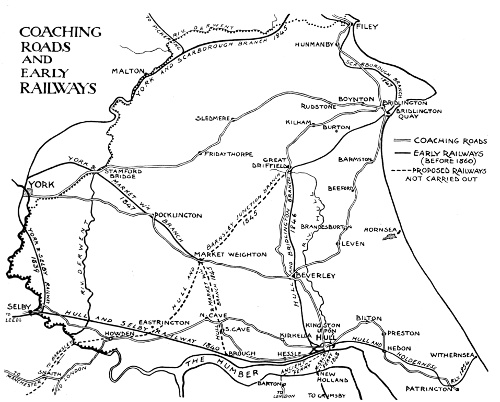
COACHING ROADS AND EARLY RAILWAYS
The Road by Driffield is so well known as to be universally recommended. The Sea having made such 244dreadful havoc of the Brandsburton Road during the last few years as to render it dangerous travelling that way, being, for five or six miles, quite at the edge of the cliff.
Both these advertisements appeared in the columns of the Hull Packet in 1833; and timorous old ladies who wished to journey from Hull to Bridlington in that year were no doubt very thankful to the proprietors of the Wellington for making so clear the dangers of the road traversed by that ‘delightful conveyance,’ the British Queen.
Still standing by the side of what is now Cardigan Road at Bridlington, there is a mile stone informing all who desire the information that Beverley is distant 22 miles. It is on the old coaching road once traversed daily by the British Queen. But a few hundred yards past this relic of the old coaching days the road now reaches the sea-shore, and the remaining portion as far as Barmston has long since disappeared under the waves of the North Sea.
Very pleasant it must have been in the ‘Thirties’ to travel by a well-appointed stage coach—say the Rockingham, Rodney, Trafalgar, Wellington, True Briton, Express, Telegraph, King William, or Queen Adelaide, all of which coaches were running from Hull in 1832.
But this would be, of course, provided the weather were fine, and one could afford to travel ‘first class.’ It would not be pleasant to have to get out and walk uphill as the ‘second class’ passengers were expected to do in the case of a coach running from North Cave to Hull through Brantingham and Hessle; and it would be decidedly unpleasant to have to get out and push behind, as was demanded of the ‘third class’ passengers by this coach.
But there was always the danger of highwaymen to be 245faced, and the Royal Mail travelled ‘with a guard well armed,’ as the coaching bill reproduced on page 241 shows.
And what of winter travelling, with the thermometer down below freezing-point and the risk every minute of the coach’s being stuck fast in a snow-drift on a part of the road ‘five miles from anywhere’? Here are two local records which testify to the existence of such discomforts:—
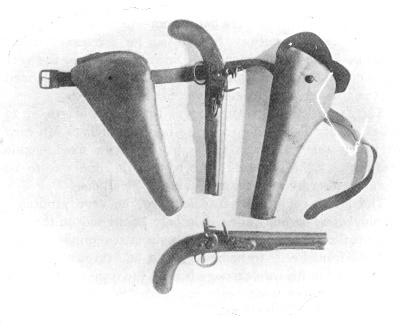
| Photo by] | [C.W. Mason |
| Pistols and Holsters formerly used on the Hull and Patrington Stage Coach. | |
| (Now in the possession of Dr. J. Wright Mason, Hull) | |
1839. Jan. 7. A dreadful storm visited the country.... For an hour and a half the Scarbro’ mail coach horses could not contendcould not contend against the wind. The inside passengers of the Beverley coach had to get out and support the vehicle from being overturned.
2461846. Dec. 15. Turnpike roads impassable with snow. Scarborough mail coach unable to proceed beyond Bridlington. Narrow escape of several persons from being frozen to death on the highways.
Ten years before stage coaches reached the height of their prosperity, a new era had begun—the era of the Railway. The first railway to be used for passenger traffic was one between Stockton and Darlington, and in the year of its opening another from Leeds to Selby was being planned by the great engineer, George Stephenson.
This, as originally planned, was to be of a length of 20 miles. Near Leeds there were to be three inclines, up each of which the train was to be hauled by a fixed engine stationed at the summit. The rest of the line was to be worked either by a travelling engine or by a horse.
The latter could, it was calculated, be very profitably employed. For his work would only be needed on the flat and up the slight inclines; and for six or seven miles on the journey from Leeds to Selby he could be ‘thrown off’ and could ride ‘in his own carriage behind the train of waggons,’ until his services were again required. Such was Railway Engineering in its infancy.
The Leeds and Selby Railway Company having been formed, work was proceeded with on plans drawn up by another engineer, Mr. James Walker, and the line was declared open for traffic in 1834.
In the following year a new Company, known as the Hull and Selby Railway Company, was formed, with Mr. Henry Broadley as Chairman. An Act of Parliament ‘for making a Railway from Kingston-upon-Hull to Selby’ was then obtained, and the work of constructing the new railway was pushed forward rapidly.
This, the first terminal railway to be constructed in the 247Riding, was expected to bring with it great advantages. By it Hull would be linked to Manchester, and Manchester was already linked to Liverpool. Thus there would be direct railway communication across England from the North Sea to the Irish Sea.
But, for all this, the scheme met with great opposition. Hull and Selby were already served by steam packets travelling along the Humber and the Ouse, and this service was deemed so satisfactory that there was little chance of the new railway’s proving a commercial success.
Objections were also raised by some of the large landowners, who feared that the introduction of the railway would very largely decrease the value of their properties along its route. Such objectors had, of course, to be conciliated—as was Mr. Raikes of Welton, by a gift of £10,000 and an undertaking to build a station at Brough instead of at Welton.
July 2nd, 1840, saw the opening of the first terminal railway in our Riding, amid scenes of wild enthusiasm at both Selby and Hull, as well as at the various stations along the line. The first train from Hull to Selby—as reported in the Hull Packet—‘started about a quarter past twelve, and was nearly two hours in going to Selby. In returning, however, the Prince performed the trip, 31 miles, in one hour and five minutes.’[62]
The first East Riding time-table was a very modest affair, as will be seen from the reproduction overleaf. The order of arrangement of the train is seen to be:—Engine and tender, goods waggon, second-class carriage, first-class carriage, and third-class carriage; but 248the last-named is on this occasion occupied by four-legged passengers. It is recorded that when the passengers in this were two-legged cattle, ‘a great number of hats were lost’ and many ‘colds and inconveniences’ were caught—facts at which we shall probably not be surprised.
Several of the regulations of the Hull and Selby Railway seem very quaint. It was the duty of a station-keeper ‘to conduct himself civilly,’ and ‘to enter on a waybill the number, class, and destination of the passengers sent by each train.’
The guard’s duties were very numerous. Among them—
He shall not allow any of the passengers to smoke in 249the trains, nor in any manner to endanger themselves by imprudent exposure. No passenger shall be allowed to ride on the outside of a carriage without leave from the general superintendent. In the event of any passenger being intoxicated, or disorderly, so as to annoy other passengers, the guard shall use all gentle means to stop the annoyance, and if he does not succeed, he shall set him down at the next or most convenient station, and report the circumstance.
The new method of travelling proved very popular. In 1841 the number of passengers carried by the Hull and Selby Railway amounted to 212,000, ‘without the slightest accident to any of them.’ This was the beginning of the days of the ‘cheap tripper,’ and it is recorded that on August 22nd, 1844—
A pleasure train from Hebden Bridge and Luddington Foot brought 3,200 persons [to Hull] in 82 carriages; being the longest train that ever visited the town.
In many cases the railway train, steam packet, and stage coach ran in conjunction. Thus the journey from Hull to Knaresborough was completed in the following three stages:—
The fares for this journey were ‘6s. 6d. outside and fore-cabin,’ and ‘10s. 6d. inside and best cabin.’ Certainly the traveller could not complain that he did not get plenty of variety for his money.
As an instance of the success of the new Railway in 250transporting ‘live stock’ may be given another extract from the Hull Directory:—
1842. December 9. A cow, which arrived here by the same steamer as the Post Office bags, outstripped those bags, 14 hours in her arrival at Manchester.
It is to be presumed that the cow travelled from Hull to Manchester by train, while the Post Office bags went by mail coach. But this is left to the imagination of the readers of the Directory.
In 1845 the Hull and Selby Railway was leased to the York and North Midland Company, a powerful company under the control of Mr. George Hudson, the ‘Railway King.’
This year and the next saw what was called the ‘Railway Mania,’ when promoters vied with one another in preparing schemes for new railways which people with money to invest were only too anxious to support. Two hundred and seventy-two Acts of Parliament authorizing new railways were obtained during the ‘boom;’ and when the ‘crash’ came, many lost the whole of the money they had so rashly invested.
The Hull and Bridlington Branch Railway was opened in 1846, and continued to Scarborough the following year. In 1847, also, the York and Market Weighton Branch Railway was opened; and the following year saw the opening of the Manchester, Sheffield, and Lincolnshire Railway ferry from Hull to New Holland. Hull and Withernsea were joined by the Hull and Holderness Railway in 1854.
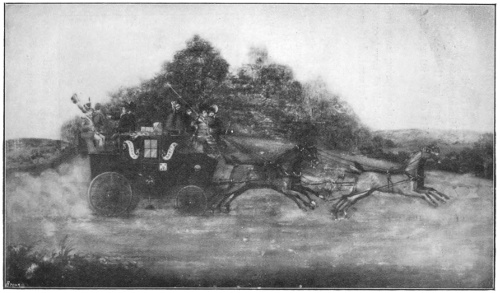
The Hull and Beverley Stage Coach—Wilson’s ‘Safety.’
Among the projected railways not carried out were the Hull and Market Weighton Railway, via Brough, and the Hull, South and West Junction Railway. One of the 252objectors to the former was the Vicar of South Cave, whose objection was that if there were a station at South Cave, ‘the scum of Hull would make it one place for their Sunday revels.’ His summary of the results of the introduction of railways was that—
The country youths go to some neighbouring town for a ‘lark,’ and the tag-rag-and-bob-tail of towns come into the country, not for sober enjoyment, but for Sunday dissipation.
Although this line of railway was not built, an alternative route from Hull to Market Weighton has long been provided. But the Hull, South and West Junction Railway, which was to cross the Humber by a tunnel at Hessle nearly forty years ago, remains as a project which will some day be successfully carried out.
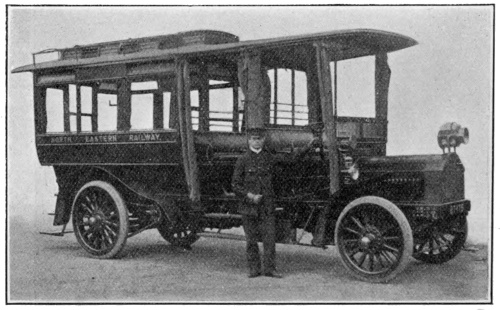
On the Road in 1912.
The Beverley and Beeford Motor Omnibus.
We have seen in some of the foregoing chapters how the small town of Wyke, or Hull, was born early in the twelfth century, how it received a charter of privileges from King Edward I., and how it was afterwards fortified with walls and ditches that withstood successfully a couple of sieges during the Great Civil War. It remains to see how the small, insignificant ‘King’s Town upon Hull’ has grown into a city so important as to take rank after London and Liverpool as ‘England’s Third Port.’
Six hundred years ago Hull was much smaller than, and nothing like so important as, its neighbours, Beverley and Hedon. Yet to-day its inhabitants number twenty-one times those of Beverley, and two hundred and thirty-nine times those of Hedon. Why should this be?
The answer is that in the first place Hull owes its greatness to its position on the northern shore of the mighty Humber. When ships were small, they could pass up the river Hull to Beverley, and could reach Hedon by its Haven. But as ships grew in size this became no longer possible, and Beverley and Hedon were left behind in the race, while Hull, because of its deep water, went ahead. For it is situate at the only spot on the north bank of the Humber where there is water sufficiently deep to allow large ships to approach the shore.
But there is one remarkable thing about the growth of Hull. This has taken place almost entirely within the 254last two hundred years. For 450 years after its walls were built, its inhabitants lived within them. Not till nearly the close of the eighteenth century did their houses begin to stretch out beyond its walls. In 1812 the area of the town was about three times that within these walls. But in 1912 the city has extended its arms so far beyond them that there are along its main roads six tram routes, each measuring from one and three-quarters to two and a half miles, while the houses of its inhabitants extend still farther.
The rapid growth of Hull within the last hundred years may be seen also by comparing the numbers of its inhabitants in different years:—
| In 1811 its inhabitants numbered | 37,000 |
| ” 1841 ” ” ” | 67,000 |
| ” 1871 ” ” ” | 122,000 |
| ” 1901 ” ” ” | 241,000 |
| ” 1911 ” ” ” | 278,000 |
These figures show that during each period of thirty years from 1811 to 1901 the population almost doubled itself, and that the greatest actual increase was between the years 1871 and 1901.
And why this sudden growth? Because of the introduction and perfection of the railway and the steamship, which together have enabled merchants to reap full benefit from the great advantages that nature herself bestowed upon their city.
If you turn to the fourteenth-century plan given on page 165, you will see that trading ships are moored in the river Hull—the ‘Old Harbour,’ as we call it to-day—on the right bank of which are the cranes for removing their cargoes. For another four centuries the river continued to be the only place for the mooring of ships.
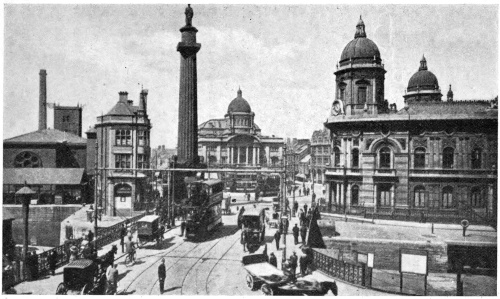
Whitefriargate Bridge and the Victoria Square, Hull.
256But when, by the revival of the whale-fishing industry in 1765, the amount of shipping greatly increased, need was felt for more accommodation. An Act of Parliament was therefore obtained in 1774 giving permission to ‘the Dock Company, of Kingston-upon-Hull,’ to make a dock extending from the river Hull to the Beverley Gate along the line of the town moat.[63]
The first stone of this dock was laid in the following year, amid scenes of great enthusiasm. Saluted with the firing of nine cannon and accompanied by ‘a large band of music, constables and flags,’ the Mayor and Corporation walked in procession to the Cross Keys, where they had, we read, ‘an excellent dinner.’ Nor did they forget their humbler townsfolk, for the workmen were given ‘fifteen guineas to drink.’
In 1778 the work of building the dock was finished, and Hull had the honour of possessing the first enclosed trading dock in Great Britain. It proved a great success, paying to its 120 shareholders good dividends out of the dues which were collected from the owners of vessels using it.
These varied from two pence per ton for a coasting vessel trading as far north as Holy Island or as far south as Yarmouth, to one shilling and ninepence per ton for vessels trading with Greenland, Africa and America—foreign vessels paying in all cases double dues.
The Dock measured nine acres in water area. In 1809 another dock was built, with an entrance direct from the Humber. This became known as the New Dock, the corresponding adjective ‘Old’ being then applied to the earlier one. In 1829 a Junction Dock was built between the two. The line of the town moat was now entirely replaced with a line of docks.
257In 1840 the railway came to Hull. The station was at that time in Kingston Street—on the site of the present Goods Station—and to give greater access to it for ships, the Railway Dock was built off the New Dock.
But the four docks that Hull then possessed proved quite incapable of dealing with the volume of trade to which they gave rise. So new ground was tapped, and in 1850 the Victoria Dock, with a water area of 20 acres, was built. At the same time the names of the three old docks were changed, and became thenceforth the Queen’s Dock, Humber Dock, and Prince’s Dock.
For nineteen years this provision was sufficient. Then there was opened the Albert Dock, four acres larger than the Victoria Dock, and in 1880 and 1883 this was followed by the William Wright Dock[64] and the St. Andrew’s Dock.
All this building of new docks was intended to provide greater facilities for shipping, and as these were provided the volume of trade went on increasing. Meanwhile new shipping companies were formed to cope with the increase of trade.
Most famous of all the shipping companies is that known to us as ‘Thos. Wilson, Sons & Co., Limited,’ which was started by Mr. Thomas Wilson about the time of the opening of Junction Dock. ‘Beckinton, Wilson & Co.’—as the firm was then called—possessed one or two sailing ships and traded with Sweden in iron ore. ‘Thos. Wilson Sons & Co.’ possess a fleet of nearly one hundred steamships, and trade with all the chief ports of the world.
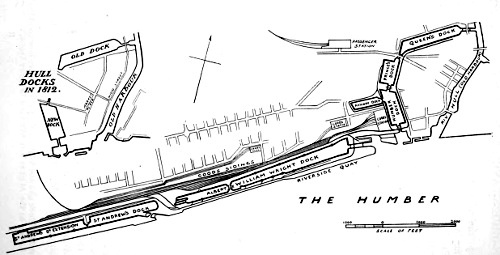
Plan of Docks West of the River Hull.
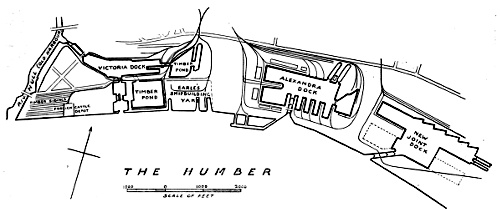
Plan of Docks East of the River Hull.
The history of the Wilson Line has been called a romance of the shipping world. Trade with Sweden was followed 260by the opening out of trade with Russia. When the building of the Suez Canal gave added importance to the Mediterranean, the Wilson Line began to trade with the ports of the Adriatic Sea, and later with Odessa and Constantinople. Next came trade with India, the Orlando, built at Hull in 1870, being the first steamship to arrive at Hull from India direct.
After this was laid the foundation of trade with New York. The success of the new venture seemed very doubtful at first, but the Wilson Line now carry more cargo to and from England and New York than the vessels of any other line of steamships. Together with all these new enterprises has gone the organisation of weekly services to the Belgian ports, and of fortnightly services to the ports of the Mediterranean Sea.
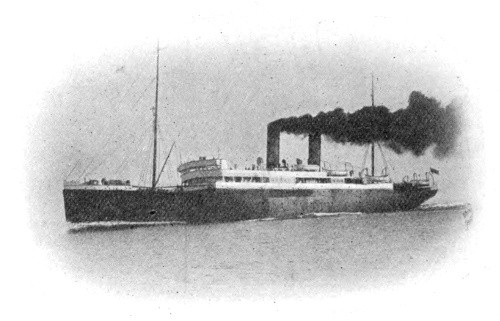
The Wilson Liner ‘Eskimo’ getting up Steam.
Early in this chapter it was stated that in the first place Hull owes its greatness to its geographical position. It is 261this position which has made it a great distributing centre for imported goods, and a great collecting centre for exported goods. The Port of Hull has thus become ‘the gateway 262for the world to the great manufacturing centres of Yorkshire, Lancashire, and the Midlands.’
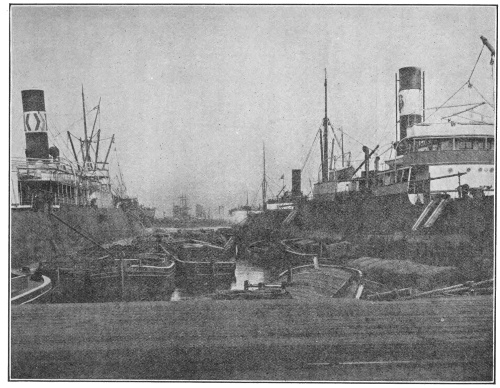
Grain Ships Discharging their Cargoes into Lighters.
Much of the transfer and despatch of goods is carried on over the side of the ocean-going steamships into or from the river-going lighters and keels, which are able to make use of two systems of inland waterways. One of these, the Aire and Calder Navigation, dates from the year 1698, and is the oldest as well as the most up-to-date waterway in Great Britain. The other system is known as the Trent Navigation.
The relative cheapness of transit by water makes these inland waterways of very great importance for all heavy traffic in which speed is not required. For fast traffic Hull is served by three railway systems, the North Eastern Railway, the Hull and Barnsley Railway, and the Great Central Railway; and other Companies have running powers over the lines of the North Eastern.
The coming of the first railway to Hull in 1840 was described in the preceding chapter. Five years after this event the merchants of Hull sought to establish a Hull and Barnsley Junction Railway; but the project fell through, and it was not till 1885 that the line now known as the Hull and Barnsley Railway was constructed.
With this new line was also constructed a new dock. This, the Alexandra Dock, is the deepest dock on the east coast of Great Britain, and has a water area of 53½ acres.
The opening of this huge dock gave a great impetus to the export trade in coal. In 1884 not more than 600,000 tons were exported, but in 1910 the quantity exported reached the enormous total of 5,000,000 tons.[65] Most of 263this went to North Russia, Germany, Holland, Sweden and South America.
Let us take a walk round some of the Hull docks, and try to realise what the import and export trade really means.
Here, in the Alexandra Dock, is a huge iron steamship into which coal is being shipped by means of electric coal hoists or by transporter belts. Its cargo of 5,000 tons is being taken on board at the rate of ten tons a minute. From the hold of another equally large ship grain is pouring into lighters ranged alongside. It will require five working-days of ten hours each to discharge its cargo of 6,000 tons. Then the ship will take its place under the coal hoists, and its empty hold will be filled with an outgoing cargo of ‘black diamonds.’
The Victoria Dock is mainly given up to vessels unloading timber from the White Sea and the Baltic, a large proportion of it being ‘pit props’ for the coal mines of Yorkshire and Lancashire.
In the Albert and William Wright Dock, as well as in the Alexandra Dock, are vessels discharging hundreds of cases of bacon and hams from the United States, or of frozen carcasses of sheep from South America. From the hold of another vessel are being brought up crate after crate of eggs from North Russia, from another bale after bale of wool from Australia. Lined up alongside another big steamship are dozens of agricultural engines and machines made by workmen in Gainsborough and Lincoln. In a few weeks’ time they will be at work in the corn-fields of Russia.
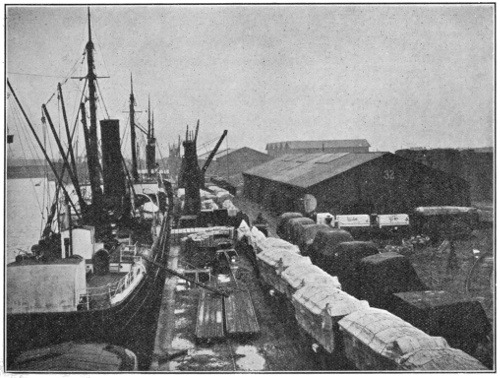
Agricultural Machinery on the way to Russia.
Every day of the week we shall find ships giving up their cargoes of linseed and cottonseed from India, Egypt, or South Russia. But if we want to see the ‘butter boats’ emptied, we must be on the spot in the very early hours 264of a Monday morning. For these boats arrive from Denmark during the Sunday, and the work of transporting their cargoes to the lines of railway waggons that await their 265arrival begins with the last stroke of midnight. By four or five o’clock on the Monday morning the butter is on its way to all parts of the north of England. The cargo of one ship alone is sometimes consigned to as many as 300 separate stations.
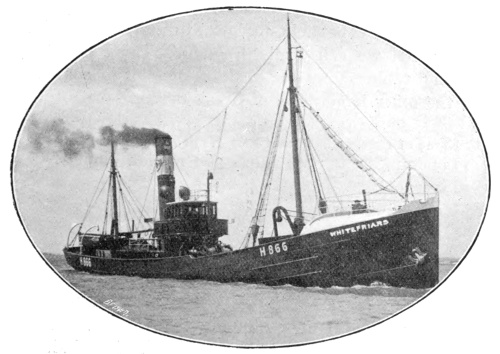
A Steam Trawler.
Come for a walk along the Humber Dock or on the Riverside Quay and, according to the season of the year, we shall see unshipped cargoes of plums from Germany; new potatoes and other vegetables from Jersey, France, and Holland; cranberries from Russia; bananas from the Canary Isles; apples from Australia, Canada, and the United States; oranges, lemons, grapes, nuts, tomatoes and onions from Spain, Portugal and Italy.
Last of all we will pay a visit to the St. Andrew’s Dock, and watch the entrance and unloading of the steam trawlers and steam carriers of the Hull fishing fleets. From the fishing-grounds of the North Sea, the White Sea, and the 266stormy seas around Iceland each brings its ‘catch.’ As quickly as it can be brought up from the hold—tubs of plaice, turbot, halibut, codfish, ling, hake or herring—it is sold at auction to the fish buyers who attend from all the large towns of the north of England; and as quickly it is packed on board the waiting ‘Fish Trains,’ which will distribute it among the fifteen million people who live within reach of the port of Hull.
We shall now be able, perhaps, to understand what is meant when we call Hull ‘England’s Third Port.’ The following table shows the position of Hull in comparison with the other large ports of Great Britain:—
| Name of Port. | Annual Value of Imports and Exports in 1910. |
||
| London | 360 | million | pounds. |
| Liverpool | 341 | " | " |
| Hull | 73 | " | " |
| Manchester | 47 | " | " |
| Southampton | 46 | " | " |
| Glasgow | 44 | " | " |
| Grimsby | 32 | " | " |
The growth of Hull’s shipping industry has meant a corresponding growth of its manufacturing industries. Most of these find their home on the banks of the river Hull, along whose winding course we can find oil and cake mills, flour mills, saw mills, paint, colour and varnish works, starch, blue and black-lead works, coal tar works, and cement works—all one after another.
Among these mills and works are some that rank as the largest in the British Isles. Thus the ‘British Oil and Cake Mills, Ltd.’ have the largest oil refinery, the ‘Hull Oil Manufacturing Co.’ are the largest producers of castor-oil, and the firm of ‘Blundell, Spence & Co.’ own the largest 267paint works. There are forty different firms engaged in the saw-milling industry, and an equal number in the manufacture of paints, colours and varnishes.
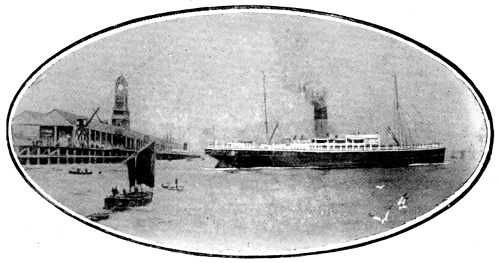
The N.E.R. Riverside Quay.
That ‘England’s Third Port’ is still going ahead may be seen in recent shipping and industrial developments. One of these has been the building of a new Riverside Quay, available for large ships at any state of the tide, and the inauguration of a daily service of steamers to and from the Belgian ports. Another is the construction of a new Joint Dock by the North Eastern and the Hull and Barnsley Railways. This is planned to have eventually a water area of 83 acres, and to be thus an imposing rival of the Great Central Railway’s new dock at Immingham on the Lincolnshire shore of the Humber.
The year 1910 saw the beginning of a new direct steamship service between Australia and Hull, a service which is expected to open out a large trade in the import of Australian wool for the looms of the West Riding. March, 1909, saw the arrival in Hull of the first large cargo of soya beans sent out from China, and the beginning in Europe 268of a new industry—the crushing of soya beans and the manufacture of soya oil and feeding cake.
Another new industry was started in 1907, when the ‘National Radiator Co.’ opened a branch of their American works. They have extended their buildings each year since the opening, and now employ nearly 1000 hands.
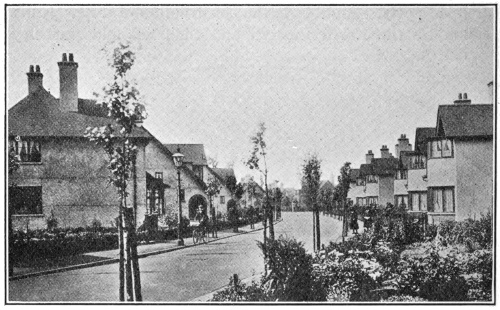
| Photo by] | The Garden Village, Hull. | [C. Bennett |
Most noticeable of all recent developments in Hull, however, have been the destruction of slum districts and the opening out of wide thoroughfares in the heart of the city—a work that was carried out during the five years’ mayoralty of Sir Alfred Gelder—the securing of an unfailing supply of pure drinking-water; the construction of a tramway system that is one of the cheapest, if not the cheapest, in Great Britain; and the planning of Garden Villages and Public Parks on the outskirts of the city.
First in the list of those who may justly be called ‘Famous Sons of the East Riding’ stand the names of Roger of Howden, William of Newburgh, and Peter of Langtoft. All these were men of learning in an age when knowledge was difficult to obtain, and each devoted himself to the work of spreading the knowledge of which he became possessed. The work that each of them bequeathed to us is a history of our country, the histories of the first and second being written in Latin, and that of the third in Norman-French rimed verse.
Roger of Howden and Peter of Langtoft took their surnames—i.e., additional names—from the places at which they were born. But William of Newburgh was born at Bridlington in 1136, and gained his surname from the fact that he became an inmate of the monastery at Newburgh in the North Riding. Peter of Langtoft was a Canon of the Priory at Bridlington.
Peter of Langtoft’s History of English Affairs takes rank as the ‘finest historical work left us by an Englishman of the twelfth century.’ It is interesting because there are introduced several of the songs sung by the peasantry and the townsfolk of Yorkshire in the thirteenth century.
But most interesting to us is the Annals of Roger of Howden. Roger was a clerk, or secretary, to King Henry II., and later became one of the King’s Justices in Yorkshire. He records several facts about his birthplace—among them that King John spent Christmas, 1191, as a guest of Hugh Pudsey, Bishop of Durham, at the latter’s palace or manor-house 270at Howden, and that in 1200 the King granted Bishop Hugh the right to hold there an annual fair.
Next in our list come the names of two famous churchmen, John Alcock and John Fisher, who were both destined to become Bishops of Rochester.
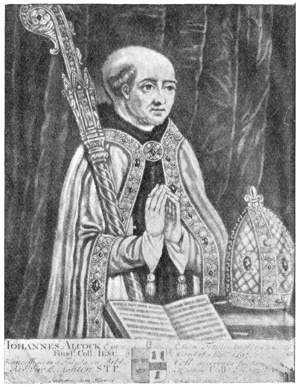
John Alcock, Bishop of Ely.
John Alcock was born at Hull about 1428, and became Bishop of Rochester in 1472. Four years later he was promoted to the see of Worcester, and after another ten years received further promotion to the see of Ely. In his time it was customary for churchmen to be at the head of all affairs of the State, and twice was Bishop Alcock appointed by the King to be Lord Chancellor of England. On the second occasion he had the duty of opening the first Parliament of Henry VII.
271Hull folk have reason to be proud of the memory of their great townsman, John Alcock. For not only did he reach the highest position in the country next to the King himself, but he was also famed as a great architect and a great patron of learning. As ‘Comptroller of the Royal Works’ he designed the wonderful ‘Henry VII.’s Chapel’ in Westminster Abbey, and as a patron of learning he founded Jesus College, Cambridge, and the Hull Grammar School.
Bishop Alcock died in 1500 at Wisbech Castle, the palace of the Bishops of Ely, and was buried in the chapel of Ely Cathedral which he caused to be built, and which is to this day known as ‘Bishop Alcock’s Chapel.’
John Fisher was twenty-nine years younger than the Bishop of Rochester whose life has just been described. He is said to have been the son of a Beverley mercer, and to have owed his high office in the Church to the favour of Margaret, Countess of Richmond.
So eager was he for the advancement of learning that he started to study Greek when quite advanced in years; and so upright and sincere was he that when confessor to Queen Catherine of Aragon he was ‘the only adviser on whose sincerity and honesty she could rely.’
Fisher was the only bishop who opposed the divorce of Henry VIII. and Catherine of Aragon, and hence he incurred the enmity of the King. This was increased fourfold when, further, he refused to recognise Henry as the ‘Supreme Head of the Church of England.’ And when, as a result of this refusal, the Pope sent Fisher a Cardinal’s hat, Henry’s wrath became ungovernable fury.
‘Yf the Cardinal’s hat were layed at his feete, he wolde not stoupe to take it up, he did set so little by it,’ were Fisher’s words when he heard of the Pope’s present to himself. But for all that he was declared to be guilty 272of treason, and was sentenced by the King to be hanged at Tyburn as a common felon.
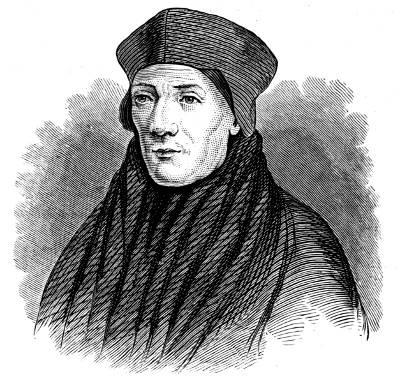
John Fisher, Bishop of Rochester.
Nothing would move Fisher from the position he had taken up. Come what might, the King was not in his eyes the ‘Supreme Head of the Church.’ So at the age of 76 he suffered the fate of most of those who ventured to oppose the will of Henry VIII. The indignity of a death at the hangman’s hands was spared him, and he was beheaded on Tower Hill, his head being afterwards spiked on London Bridge, and his body buried in St. Peter’s Chapel, by the side of that of his friend, the great statesman Sir Thomas More.
‘A pure-minded patriot in the most corrupt times.’ 273Such has been the description of Andrew Marvell—son of a rector of Winestead and master of the Hull Grammar School—who was assistant to John Milton, the Latin Secretary to the Council of State in the time of the Commonwealth, and Member of Parliament for Hull during nineteen years.
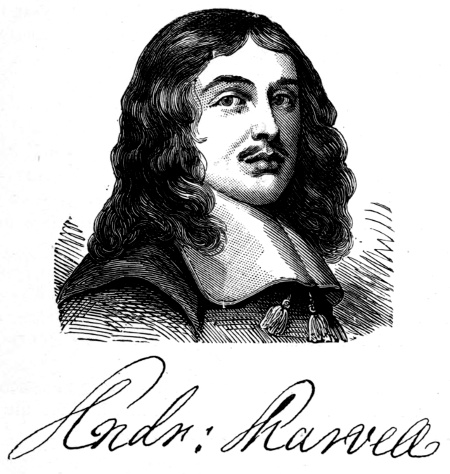
Andrew Marvell was born in 1621 at his father’s rectory, and, as an ‘old boy’ of the Hull Grammar School, passed on to Cambridge at the age of fifteen. When he was nineteen years old, his father was drowned in crossing the Humber by the ferry-boat, and as a result he was adopted by a Mrs. Skinner of Thornton, in North Lincolnshire.
In 1657 Marvell entered the service of the Commonwealth, 274and two years later he was elected a Member of Parliament for Hull, which post he continued to hold until his death. It was then the custom for Members of Parliament to be paid for their services by their constituents, and Marvell thus received from the townsfolk of Hull the sum of six shillings and eightpence per day ‘for knight’s pence.’ It is curious to notice that he was the last member for Hull to be paid for his services in Parliament until the year 1911.
Notwithstanding this payment Marvell’s means were always very limited, and for some years he lived in a state bordering upon actual poverty. But the scantiness of his means did not cause him to swerve from what he considered to be the path of honesty, and the tale is told of how Danby, the Lord Treasurer, tried unsuccessfully to bribe him with the offer of £1,000. ‘Up two pair of stairs in a little court in the Strand’ Marvell was found by the Lord Treasurer’s messenger. And there he was also left, incorruptible in his honesty.
Marvell earned considerable fame as a writer of political satires, and also as a poet. The poems by which he is best remembered are probably those entitled Thoughts in a Garden and An Horatian Ode upon Cromwell’s Return from Ireland.
In the latter poem occur the famous lines in which the author, himself a strong Parliamentarian, honours the way in which King Charles I. met his death:—
275Marvell died in 1678, so poor that his funeral expenses were paid by the Corporation of Hull. How great his worth was may be judged from the words of the great statesman William Pitt:—‘Every man has his own price; I know of but one exception, and that is Marvell, in the past.’
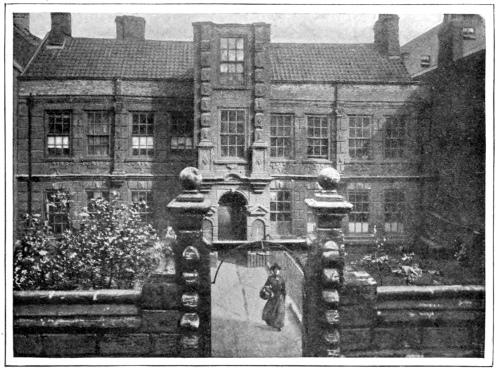
Wilberforce House, High Street, Hull.
The Birthplace of William Wilberforce.
The house in which Sir John Lister entertained King Charles on his visit to Hull in 1639 was also that in which was born Hull’s greatest son, William Wilberforce. Tradition states, further, that he was born in the room in which the King had slept.
William Wilberforce was born on August 24th, 1759, the grandson of another William Wilberforce, who had been a 276Baltic merchant and an alderman of the town. Delicate as a child, and reared in luxury, he yet grew up filled with an understanding of the earnestness of life; and after leaving Cambridge he entered Parliament at the age of twenty-one, as a member for Hull. Four years later he was chosen a member for both the county of York and the town of Hull. The former of these distinctions was the one that he selected, and thenceforth for twenty-eight years he remained one of the two members of Parliament for the ‘Shire of Broad Acres.’
Just at that time the minds of thoughtful Englishmen were beginning to be stirred by feelings of horror at the evils of the slave-trade. It had been an English seaman of Queen Elizabeth’s time who had started the traffic in human beings. And, curious as it may seem to us, that traffic had been blessed by the Church; since the negroes who were taken across the Atlantic to the West Indies were being given a chance to learn the truths of Christianity.
It had been, also, an English crew of seamen who had on one occasion thrown overboard a hundred and forty ‘niggers’ to lighten their vessel. But it was also Englishmen who first set to work to put an end to the unholy traffic.
In 1787 a small band of thinkers—Thomas Clarkson, Granville Sharp, William Wilberforce, and a few others—started to labour with this end in view. The great statesmen of the time, Pitt, Burke, and Fox, all supported their efforts, and piles of information were obtained.
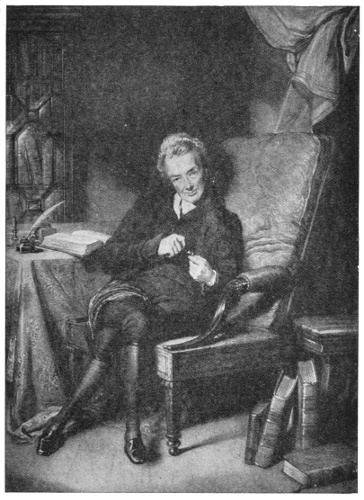
William Wilberforce.
They got together details of the bartering of prisoners by African chiefs for supplies of rum; details of voyages across the Atlantic during which the slaves lay chained on decks which had only a couple of feet of space between them, and were so closely packed together that they had hardly room to move their limbs; details of the cruel treatment meted 278out to them when they were eventually sold to work in the sugar plantations of the West Indies.
But the slave-trade was a very profitable one. Merchants did not feel anxious to give up profits of one hundred and twenty per cent.; so the opposition met by Clarkson, Sharp, and Wilberforce was great. Eleven times during the years 1791–1805 was a Bill introduced in Parliament for the abolition of the slave trade, only to be either rejected by the House of Commons, or thrown out by the House of Lords.
However, in 1806, the Bill was passed by the Lords, and afterwards carried in the House of Commons by two hundred and eighty-three votes to sixteen. Royal assent to the Bill followed on March 25th, 1807.
Almost immediately after this the Ministry resigned, and a General Election took place. This was the occasion of the historic contest between William Wilberforce, the Hon. Henry Lascelles (son of the Earl of Harewood), and Viscount Milton (son of Earl Fitzwilliam). Wilberforce and Lascelles stood as Tories, Viscount Milton as a Whig.
For fifteen days the polling went on in the Castle Yard at York, to which the voters from the whole county had to travel by stage coach or post chaise, on horseback, or afoot. From the East Riding there were 3,556 voters, and at the close of the poll the figures stood:—
| Wilberforce | 11,806 |
| Milton | 11,177 |
| Lascelles | 10,989 |
Thus William Wilberforce and Viscount Milton became the two members for Yorkshire. The defeated candidate owed his position at the bottom of the poll largely to the fact that his father owned slaves on his West Indian estates, 279and one of the election cries against him was ‘No Yorkshire votes purchased with African blood!’ The election cost Wilberforce £28,000, and each of the other two candidates about £100,000—a striking example of the difference that has come over our political life during the last century.
In 1812 Wilberforce retired from his old constituency, and thenceforth sat for a small borough in Sussex until 1825, when he withdrew from Parliament. But the good work which he had helped to start was continued by others, and two weeks after his burial in Westminster Abbey—August 5th, 1833—an Act of Parliament was passed for the Abolition of Slavery in the British Colonies, the sum of money paid as compensation to slave-owners being £20,000,000.
The memory of our great philanthropist has been perpetuated at York by the building of the Wilberforce School for the Blind, and at Hull by the erection of the Wilberforce Monument near Whitefriargate Bridge, and the opening of his birthplace in High Street as a Public Museum of Local Antiquities. The Wilberforce Monument, which towers up 102 feet above the roadway, bears on one of its sides the simple yet effective inscription:—
From William Wilberforce we turn to Sir Tatton Sykes—‘t’owd Squyer’ of Sledmere. Sir Tatton was born in 1772, the second son of Sir Christopher Sykes, and succeeded to the title and the family estates on the death of his brother, Sir Mark Masterman Sykes, in 1823.
Before this he had become widely known as a breeder of sheep and racehorses, and as a fearless sportsman. At 280the age of twenty-three he rode his first race at Malton, at the age of sixty he rode his last; and on both occasions he came in the winner.
Under Sir Christopher Sykes the cultivation of the bleak, desolate Wold country was successfully begun, and under Sir Tatton Sykes great improvements were wrought by the introduction of bone manure. Sir Tatton was for forty years a master of fox-hounds, and the discovery of the usefulness of bone manure was due to his observing that on the places near his kennels at Eddlethorpe where the hounds were fed, the grass grew more luxuriantly than it did elsewhere.
Throughout his long life of ninety-one years Sir Tatton Sykes continued to dress in the fashions of his early days—‘a long frock coat, drab breeches, top-boots, and a frilled shirt.’ And such was his reputation that sixty years ago the three things best worth seeing in the county were said by Yorkshiremen to be ‘York Minster, Fountains Abbey, and t’owd Squyer.’
Absolutely ‘straight’ in all that he did, he takes rank as a true specimen of ‘The Fine Old English Gentleman’—the Sir Roger de Coverley of the nineteenth century.
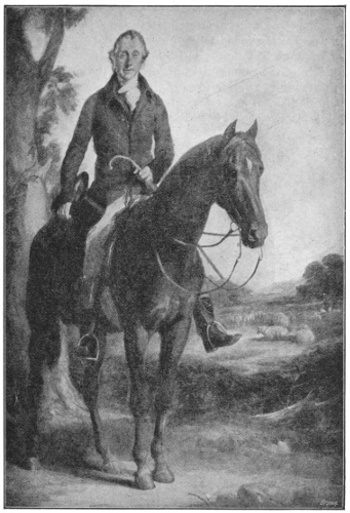
| Photo by] | [Henry Thelwell |
| Sir Tatton Sykes. | |
Last on our list of Famous Sons of the East Riding stand the names of Charles and Arthur Wilson.
The younger sons of Thomas Wilson, founder of the great shipping firm of ‘Thomas Wilson, Sons & Co., Limited,’ they were born at Hull in 1833 and 1836 respectively. On the retirement of their eldest brother David in 1867, the control of the firm came into their hands, and how it grew and prospered, and how the town of Hull grew and prospered at the same time have been described in a previous chapter.
The parallel between the ancient family of the De la Poles and the modern family of the Wilsons has been noted by 282more than one writer. It may rightly be said that as the former were the founders of the commercial prosperity of the town of Kingston-upon-Hull, so the latter were the founders of the commercial prosperity of the city of Hull.
For thirty-two years—from 1874 to 1906—Charles Wilson sat in Parliament as a representative of the burgesses of his native place. Then his political services were recognised by the Ministry, and he became the first Baron Nunburnholme of Kingston-upon-Hull.

| Photo by] | [Barry, Hull |
| Charles Wilson, First Baron Nunburnholme. | |
Arthur Wilson did not, like his brother, enter political life, but became widely famed as a sportsman. For twenty-five years he was Master of the Holderness Hunt, and the most famous Meet under his rule was that at Brantingham Thorpe, then the residence of Mr. Christopher Sykes, in 283January 1882, when more than four thousand people assembled to greet the Prince of Wales.
Charles, Baron Nunburnholme, died at Warter Priory, on October 27th, 1907, and his brother, Mr. Arthur Wilson, at Tranby Croft, on October 21st, 1909. The body of the latter was drawn to its resting-place in Kirkella Churchyard on a farm rulley by a team of farm horses, and public feeling at the time may be gauged from the following passage in one of the newspaper reports of his death:—
In Hull Mr. Wilson was known and respected as a just and honourable merchant and a philanthropist; in the county he was known and admired as a model landlord, and a keen and fearless sportsman.
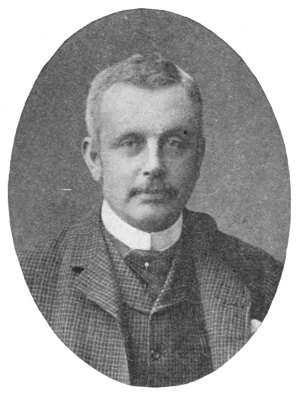
| Photo by] | Arthur Wilson. | [Barry, Hull |
Let us ask ourselves what is our idea of a ship. However we express this in words, it will be vastly different from the idea of a ship that possessed the minds of those early inhabitants of Holderness of whom we read in Chapter III. Theirs was that of a tree-trunk hollowed out partly by fire and partly by hand labour with implements of flint, until it would balance itself on the water, and could be pushed along by its occupants with some sort of paddle.
Such were the ships that men first used on the Humber. Not long ago one of them was found buried six feet below the surface of the ground at Brigg in North Lincolnshire.
At a time when the river Ancholme spread widely over the surrounding land, this boat had been deserted on the river bank, and as years went by it sank into the mud of which the bank was composed. Then the river gradually silted up, so that what had once been a wide expanse of water became merely a narrow water-channel.
This ancient ‘dug-out’ is now one of the treasures of the Hull Museum. It has been constructed of the trunk of an oak tree, split lengthwise, and is nearly forty-eight feet long from stem to stern. Its width is from four to five feet, and its depth roughly two feet six inches. There is probably no oak tree growing in our country that would be tall enough to make a similar boat of equal length.
The stern board of the boat is a separate piece of timber, fitted into a groove along each side; and originally the sides were bound across with leathern thongs to keep the board in position.
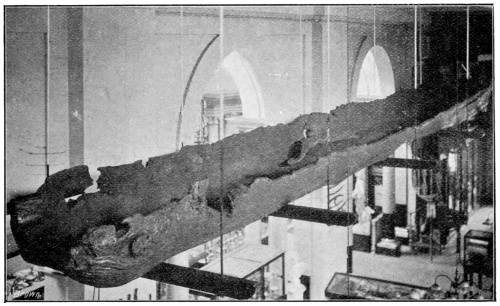
An Ancient ‘Dug-out’ found in North Lincolnshire.
Think of the immense amount of labour that the making of this early ‘ship of the Humber’ cost. The patience that its makers must have displayed would put some of us to utter shame in our frantic haste to finish a thing in the shortest possible space of time after its beginning.
Long after the days of the builders of this boat, the Romans and the Angles came to our shores. With them the knowledge of shipbuilding had greatly increased, and their ships were propelled with both oars and sails.
Later again came the Northmen, against whose attacks the Angles prayed in vain. A true sea-faring race were these Vikings of old, and they could boast, as their lineal descendants in Norway boast to-day, that they possessed more ships than any other nation in the world.
Long-ships was the name given to the Northmen’s ships 286of war, they being thus distinguished from the wider and clumsier merchant ships. But the Northmen were a poetic race, and to a Viking his ship was a ‘black horse of the sea,’ a ‘deer of the surf’ or a ‘raven of the wind.’
The largest ships of the Vikings were ornamented with a dragon’s head at the stem, and often a dragon’s tail at the stern, whence their name Dragons. The dragon’s head and tail might be covered with thin sheets of gold, if its owner were a great king. Its prow and sides might also be coated with iron to aid in ramming other vessels.
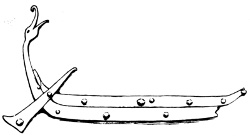
A Viking Ship on a Church Door.
Norman Ironwork at Stillingfleet.
These ships were driven along by the use of a large square sail, and also by the use of oars. Twenty or thirty rowers’ benches was the usual number allowed for, and the space between two benches was known as a ‘room.’ Each ‘room’ would hold seven or eight men; so that a thirty-seater, which would be in length about 150 feet, would have a crew of something over two hundred men. Cnut the Great had a monster ship 300 feet long, and containing sixty ‘rooms.’
The Norsemen were very fond of bright colours, and the sails of their long-ships were made of woollen material striped red, blue, green, and white. The sides were painted red, purple, and gold, and along each were ranged the warriors’ shields, alternately yellow and black.
Picture to yourself what a fleet of some two or three hundred of these long-ships must have looked like when it sailed up the Humber. What terror it must have struck into the hearts of those who watched its arrival!
287Then picture another scene. A single ship, the home of a renowned Viking, drifting slowly down the Humber on an ebb tide, with sail set, bearing in its bosom the dead bodies of its owner and his favourite horses, and alight from stem to stern with blazing tallow, tar, and oil. This is the picture that a great English poet has painted for us in his poem called Balder Dead:—
Soon, with a roaring, rose the mighty fire, And the pile crackled; and between the logs Sharp, quivering tongues of flame shot out, and leapt, Curling and darting, higher, until they licked The summit of the pile, the dead, the mast, And ate the shrivelling sails. But still the ship Drove on, ablaze above her hull with fire.
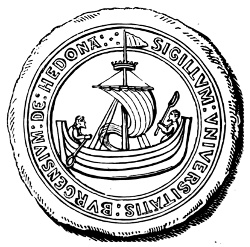
The Ancient Seal of the
Corporation of Hedon.
With the passing of centuries came more peaceful times, when the ships that passed up and down the Humber were no longer ships of war, but ships of peace. They were ships ‘that sailed from Hull ... to Bergen with English wares, and brought back cargoes of salt fish; that fetched iron from Sweden, and wine from the Rhine vineyards, and oranges and spices and foreign fruits from Bruges; and that carried out the English woollen cloths to Russia or the Baltic ports, and brought back wood, tin, potash, skins and furs.’
What the ships of the fourteenth century were like we can judge from the old plan of Hull on page 165, and from the 288drawing of the seal of the Corporation of Hedon here shown. The Humber was then noted for its ships, and in the year 1346 furnished the following ships and men to the expedition fitted out by King Edward III. for the siege of Calais:—
| Towns | Ships | Mariners |
| Kingston-upon-Hull | 16 | 466 |
| Grimsby | 11 | 171 |
| Barton | 3 | 30 |
| Ravenser | 1 | 27 |
For the same expedition London provided only twenty-five ships and 662 mariners.
Gradually the ships of the Humber increased in size; and when in 1598 the seamen of Hull first engaged in whale fishing, the kind of ship they had was one much more seaworthy than the ‘cockle-shells’ of previous centuries.
In the hall of the Hull Trinity House hangs a strange relic of the early days of the whale fishery. This is an Esquimaux canoe, built entirely of whalebone and sealskin, and picked up off the Greenland coast by the captain of a Hull whaler in 1613.
When sighted, the canoe held the dead body of its owner sitting strapped upright with his paddle across his knees. The ‘Bonny Boat’ the English sailors christened it, and there in the Trinity House it may be seen to-day, with what at first glance appears to be its owner still sitting as he sat when he died of starvation on the wide Atlantic Ocean.
During the time of the Dutch wars of the reign of Charles II., the whaling industry passed into the hands of the Dutch, but a century later—in 1765—it was resumed by the Hull 289seamen. A shipowner named Captain Standidge took a great part in this revival of the Greenland fisheries, and for his services in this direction received the honour of knighthood.
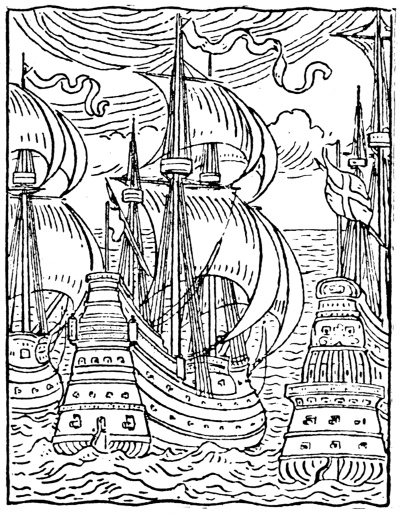
English Warships in the Time of the Armada.
From 1772 to 1852 the Whaling Industry flourished. To the icy seas around Spitzbergen, or to the Greenland seas and the Davis Straits, there went each year ships of the Humber in number from three to sixty-five. Often they 290were unlucky, and had to return ‘clean’—that is, with nothing in their holds to repay their owners and their crews. Sometimes they were still more unlucky, and did not return at all, having been gripped in the ice or captured by French privateers. Out of ten ships that sailed from the Humber in 1775, six came back ‘clean,’ and two were lost.
One of the most disastrous years known was 1835, when five of the Hull ships were frozen up, three of them being eventually lost, one with all hands.
In the following year a Hull vessel, named the Swan, was frozen up much farther north than the whalers usually went; so that it was the midsummer of 1837 before she got free. Meanwhile she had been given up as lost; and on Sunday, July 2nd, a memorial service was held on the Dock Green, and a collection of £47 taken on behalf of the families of the crew. In the midst of the service, however, news arrived that the ‘missing’ vessel was entering the mouth of the Humber.
We can imagine the excitement caused by her arrival. Among other things it meant, of course, a ‘Hextra Speshul’ edition of the News Sheet, as the photograph on the opposite page shows.
As a rule, however, a voyage resulted in fair profits for both owners and crews. The thirty-one ships that went to Greenland in 1821 took between them 204 whales, and the twenty-one that went to Davis Straits took 294 whales. These 498 ‘fish’ produced whalebone and oil to the value of £150,000. The average return per ship was here slightly lower than that for the whole period 1772–1852, which works out to £3,500.
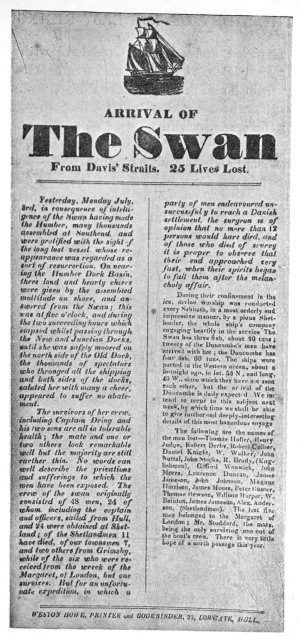
A News Sheet of 1837.
(Presented to the Wilberforce Museum, Hull, by Mr. John Suddaby).
Occasionally a ship would be particularly fortunate. In the Greenland Sea in one day the Gibraltar killed eleven whales, the Manchester ten, and the Molly six. In 1794, 292also, the Egginton arrived from Greenland with the produce of fifteen whales, 3,021 seals, and five bears. She had been away from home only a hundred days, and created a record by afterwards making two trading voyages to St. Petersburg the same season.
Such luck as this was quite exceptional. Usually the capture of a single whale meant much hard work and many dangers for the boats’ crews. In 1821 the Baffin
struck a whale which ran out fifteen lines of 240 yards each, and dragged two boats and fifteen men for a long time. When the ‘fish’ was killed, it was found to have been also dragging under water six similar lines and a boat belonging to the Trafalgar, of Hull. The 5,040 yards of line weighed a ton and a half.
Most famous of the ships of the Humber that passed to and fro in the whaling industry was the Truelove. This was a three-masted barque with a length of 96 feet and a width of 27 feet. Built at Philadelphia in 1764, the Truelove was captured by the English in the American war, and eventually sold to a merchant of High Street, Hull.
The Truelove’s first whaling voyage was to Spitzbergen in 1784. From that year till 1868 she made seventy-two voyages to Spitzbergen, Greenland, or the Davis Straits, and accounted for about 500 whales. In 1873 she was taken to her birthplace, where the captain and crew were fêted; and for several years afterwards she made trading voyages to Norway until eventually she was broken up as no longer seaworthy.
The peculiar build of the Truelove accounted to a large extent for her many hair-breadth escapes from the danger of being ‘nipped’ in the ice. Her sides bulged outwards like a barrel; or, as sailors put it, they ‘tumbled home’ to the deck.
One of the saddest events in the Hull whaling industry 293was the return home of the Diana in 1867. This was the first steamship to go to the whaling-grounds, and in her voyage of 1866 she had the misfortune to become locked in the ice for six months. The sufferings of her crew can be imagined. Captain Gravill died in December, one of her crew died in February, five died in March, and five more died in April.
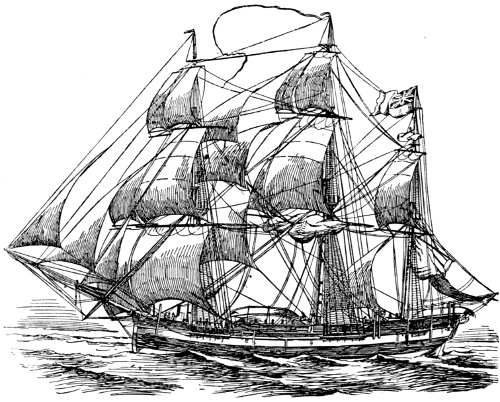
The Hull Whaler ‘Truelove’.
The Truelove was sent out from the Humber as a relief ship for the Diana, but the two vessels passed each other. With thirty-six men down with the scurvy, and only seven left fit to work the ship, the unfortunate Diana eventually reached home, her dead captain’s coffin on the ship’s bridge.
The following year this ill-fated vessel was wrecked on 294the treacherous flats of Donna Nook, off the Lincolnshire coast at the mouth of the Humber. With her loss the whaling industry of the Humber seamen came to an end.
During many of the years when the whale fisheries were providing work for East Riding seamen, France and England were at war. Men were consequently needed to man the English navy, and such notices as the following were frequently issued in seaport towns:—
For the parishes of Sculcoates, Cottingham, and Little Weighton, A few able-bodied SEAMEN or LANDMEN to serve in His Majesty’s Navy during the present War ONLY.... The Families and Friends of Volunteers will receive Monthly Pay, and the Volunteers themselves will have a bountiful supply of Cloathing, Beef, Grog, Flip, and Strong Beer, also a certainty of Prize Money, as the men entered for this service will be sent to capture the rich Spanish Galleons, and in consequence will return loaded with Dollars and Honour, to spend their Days in Peace and Plenty.
Hull, November 28th, 1796.
But the results of this ‘Recruiting for the Navy’ were not always satisfactory, notwithstanding the ‘certainty of Prize Money’ and the ‘bountiful supply of ... Grog, Flip, 296and Strong Beer.’Beer.’ So recourse was had to the Press Gang, and many were the tricks practised by the captains and crews of Hull whalers to reach home safely.
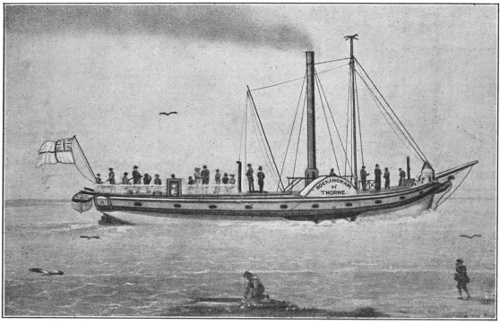
The First Steamship Built on the Humber.
A ship of war was stationed in the Humber to board incoming whalers and impress men for service in the navy. To escape, numbers of the men were landed at Easington or at lonely spots farther north, and these would make their way home as best they could by land.
Another very ingenious trick was worked successfully by the captain of a whaler which was boarded by a revenue cutter off Flamborough Head. This is how Captain Barron in his Old Whaling Days tells the story:—
A revenue cutter hove in sight off Flambro’ Head when Captain Scoresby was returning home with a full ship. When he saw it in the distance, he let four or five feet of water into the hold through a large brass tap which some whalers had in their counters on purpose to fill their casks for ballast. This was kept running, so that the pumps could not gain upon it, and when the officer boarded the ship he was told she made so much water that the crew would not be able to keep her afloat if he took any away. The officer sounded the pumps, and was satisfied in finding when they stopped pumping the water rose in the hold. He took his departure. The tap was at once turned off, and the water pumped out. This clever trick saved his men from being forced on board His Majesty’s ships.
On another occasion—in 1798—the Blenheim was boarded in the Humber by H.M.S. Nonsuch, and a free fight followed, in which two of the warship’s crew were slain. For this the captain of the whaler was brought to trial at York. But he was acquitted on the charge of murder laid against 297him; and when the York coach brought him safely home to Hull, ‘the crowd took out the horses, dragged it to the Market Place, and ran it three times round the statue of King William’ by way of showing their joy.
The warships of this period, were, of course, vastly different from the battleships of which English seamen are so proud to-day. Many were built in the Humber; the largest being the Humber, an eighty-gun ship, launched at Hessle Cliff in 1693. H.M.S. Hector was built by Hugh Blaydes fifty years later. During the years 1739–1774 three warships were built at Paull, six at Hessle, and fifteen at Hull. A memento of the Hyperion, built at Hull in 1806, still exists in the name of a small street running off Great Union Street, and a neighbouring street bears the name of a very popular whaler, the Aurora.
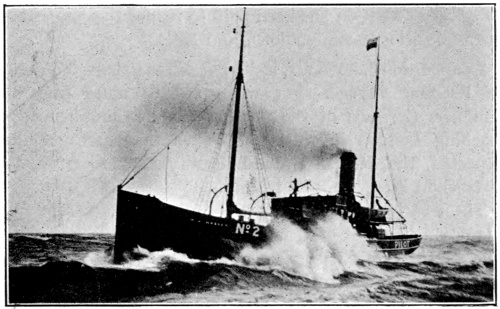
A Humber Pilot Boat.
The first steamship used on the Humber was one built 298in Scotland, and hence appropriately named the Caledonia.[66] This steam packet ran between Hull and Selby in 1815. Five years later the Rockingham was built at Thorne, and the following year the Kingston began the ‘expeditious and easy conveyance’ of passengers from Hull to London.
The Kingston was, of course, looked upon as a wonderful vessel. Its owners proudly announced to the public:—
In the construction of this elegant vessel, which will be propelled by an engine of sixty horse power every attention has been paid to render the conveyance expeditious, commodious, and safe.
‘Expeditious’, however, it did not prove to be—at any rate on its first voyage. For when twenty miles from the Humber, the axis of the paddles broke; and instead of reaching London in thirty hours, as the passengers had expected, the Kingston found its way back to Hull some forty-eight hours after its triumphant start.
These early steam packets were somewhat different from the ocean liners of our own day. Compare the portrait of the Rockingham on page 295 with that of the Bayardo on page 299. Launched in 1910 from Earle’s Shipbuilding Yard, at a cost of £67,000, the latter was for its short life the ‘Queen of the Wilson Line.’
The fate of the Diana and the Bayardo illustrates the dangers of the Humber. The latter vessel left Gothenburg on a Friday evening in January, 1912, with a cargo worth £30,000 and a small number of passengers. On the Saturday evening she was making her way up the Humber in a dense fog when she ran hard aground on a sandbank almost opposite 300the dock which was her destination. By the following evening her back was broken, and the ‘Queen of the Wilson Line’ was a hopeless wreck.
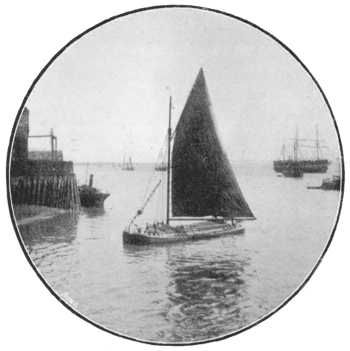
| Photo by] | [C.W. Mason |
| The Entrance to the ‘Old Harbour.’ | |
Stand on the Victoria Pier at Hull on a clear day, and watch the ships of the Humber. Of all sizes and shapes and speeds they are. There we see the keel, with its one square sail, making its way slowly along, the peaceful descendant of the square-sailed long-ship of Viking days. There are the schooners and barques that are survivals from the days when all ships depended on the wind for their motive power. There is a tug-boat taking out to its moorings the light-ship on which the safety of many other ships will depend.
There also are the ‘fast-sailing’ steam trawlers and carriers coming from, or going to, the fishing-grounds off Iceland and north of the White Sea—the representatives of the whalers of a hundred years ago—there the scurrying pilot boats and revenue cutters. And there is a great ocean liner riding at anchor and waiting the turn of the tide to allow it to enter the dock and discharge the cargo it has brought from the other side of the world.
There is a tale told of a Yorkshireman on a visit to London that he fell into argument with a bus conductor over the correct way of pronouncing the simple word ‘road.’ The cockney bus-conductor had, in his usual way, called out ‘’Toria Rowd; ’Toria Rowd!’ and the Yorkshireman was highly displeased with this obvious murder of the King’s English. ‘Rowd!’ said he in his disgust; ‘whah dooant ya speeak English? R-o-a-d—that’s hoo it’s spelt, beeant it? Whah dooant ya ca’ it Roo-ad?’
The story will serve to illustrate the fact that a man born and bred in the heart of England’s biggest shire, and one born and bred in the heart of England’s biggest city, do not sound all their words in the same manner, though they may at the same time spell them alike. Moreover, neither of the two will perhaps sound his words in the way in which custom says it is correct to sound them.
Such differences are to be found in many parts of the country. The Northumberland miner, the Sheffield steel-worker, the Nottingham lace-worker, the Norfolk grazier, and the ‘Zummerzet’ farm-labourer all speak ‘English’; but yet they would have no little difficulty in making one another understand what their respective English words meant. In other words, the districts to which they belong have each a Dialect or Folk-Speech of their own.
Let us see what are some of the peculiarities of the Folk-Speech of our East Riding:—
(1) An East Yorkshireman sounds his vowels in his own peculiar way. With him I is pronounced as ah, warm as 302wahrm, night as neet, road as rooad, cow as coo, know as knaw, pound as pund, come as coom, and ought as owt. He is, moreover, very fond of the EEA sound; for he makes cake into keeak, meat into meeat, home into heeam, sure into seear, school into skeeal, look into leeak, enough into eneeaf, and plough into pleeaf.
(2) He finds it too much of an effort to sound the whole word ‘the,’ and therefore clips it into t’; so that with him ‘the cow is in the close’ becomes t’ coo is i’ t’ clooase. If he is a Holderness man even that effort will probably be too great for him, and what he will say is coo is i’ clooase.
(3) In the same way he finds it much easier to drop the final G of words ending in ING and to drop an initial H. To make up for the latter, however, he may very possibly put in an occasional H somewhere where it would not be expected. Thus he may tell us, speaking of his companions, that hivvry yan on em is gannin t’ ’Ool t’ morn.
(4) He has a very simple method of dealing with the inflections of the verb. I am, thou art, he is; and I do, thou dost, he does, are levelled into:—
| Ah is | Ah diz |
| Thoo is | Thoo diz |
| He is | He diz |
—while, in speaking of his sheep, he may even tell us that Them’s good uns.
(5) The plural words cows, eyes, children, are not at all to his liking. He much prefers to speak of such things as ky, een, and childer. Nor does he take kindly to the ‘apostrophe s’ as a sign of the possessive case; but will tell his boy to stan bi t’ hoss heead.
(6) He is very fond of doubling his negatives, and occasionally he is not even satisfied with the doubling process. It is said of an East Yorkshireman whose apple trees were 303the aim of many a schoolboy’s stone, that his lamentation took the form of neeabody’s neea bisniss ti thraw nowt inti neeabody’s gardin.
(7) He is also very fond of ‘strong’ past tenses and of past participles ending in EN. The past tenses beat, crept, snowed, are with him bet, crop, and snew; while the past participles burst, fought, got, held, let, put, become brussen, fowten, gotten, ho’dden, letten, and putten. So firmly fixed in popular favour are these forms in EN that it is told of a small boy who had been receiving a lesson on their incorrectness, that in a state of momentary excitement he informed his mistress: Pleease, miss, Billy Jooanes ha’ putten ‘putten’ wheer he owt ti ha’ putten ‘put.’
(8) The East Yorkshireman has a host of words that are all his own. Thus he will tell us that theer war nobbut yah coo i’ t’ helm at t’ far-end o’ t’ pastur; and that he doots t’ awd meer’s boon ti dee, but happen she mud live whahl Moon da.[67]
(9) He has likewise his own way of expressing his thoughts, and no other will serve his purpose so well. ‘Well, my boy, who are you?’ a country parson freshly arrived from the South is said to have asked a village boy. Ah’s weel, hoo’s yersen? was the unexpected reply that the parson received. But, of course, he should have known that in East Yorkshire the correct way of asking his question is ‘What do they call you?’
There are very many of these special modes of expression. To spread a report is to set it aboot, to scold a person is to call him, to call a person is to call of him, to pour hot water on tea-leaves is to mash t’ tay, to be going to the bad is to be 304at a loose end, to leave off doing a thing is to give ower, and to give good promise of success is to fraame middlin.
If an East Yorkshireman wishes to make known that he saw his brother Sam, he will say Ah seed oor Sam. Of one who cannot look after himself he will say that t’ awd chap canna fend for hissen, and of one who is not getting better from an illness it will be said that he dizn’t mend onny.
Sometimes the result of the change of expression becomes ludicrous, as it was in the case of the cottager who, telling of a lodger that he prepared his own food and she did his washing for him, explained: He meeats hissen an’ ah weshes him.
The East Yorkshireman, like many other people, likes making comparisons; but he has his own idea of what forms a fit and proper comparison. Thus, in speaking of the steepness of a cliff he will tell us that it is as brant as a hoose sahd, or he will explain that his grandfather is as deeaf as a yat-stowp.[68] Concerning a person of whose capabilities he does not think highly, he will tell us that he is as fond as a billy-gooat, or as green as a yalla cabbish, or even as soft as a boiled tonnap.
Many other examples of the peculiarities of the East Yorkshire Folk-Speech might be given. What shall we say about them? Shall we smile at what we are pleased to consider mis-pronunciations and awkward attempts to speak the English language? When the farm-labourer, who had been beguiled into buying a ‘solid gold-plated keyless watch jewelled in seven holes’ from a cheap-jack in Beverley Market Place, was told by his companion to ax where the key was, and proceeded to bawl out Wheer’s t’ kay? was he to be laughed at for murdering the King’s English?
305If we wish to laugh at those who thus speak ‘broad Yorkshire’ let us do so. But at the same time let us remember that what we are pleased to call ‘broad Yorkshire’ is often much truer English than what we ourselves customarily use.
A thousand years ago our ancestors called a key cæg (pronounced kaig), and used the verb acsian where we should use ‘ask.’ They also used the word cy (pronounced kee) for the plural of cu (pronounced koo), and the word cilder (pronounced kilder) for the plural of cild.
So really the East Yorkshire farm-labourers are speaking the language of their ancestors much more truly than we who mis-pronounce words and make them into cows and ask, and who manufacture such a double plural as the word child(e)r-en.
In numerous instances is the East Yorkshire Folk-Speech nearer to the true English than is the commonly accepted ‘English’ of to-day. The following examples might be multiplied indefinitely:—
| Old English Words. | Standard English Words. | East Yorkshire Words. |
| (IN USE A.D. 912). | (IN USE A.D. 1912). | |
| AFYRHT (pron. afeert) | afraid | AFEEARD |
| GIF | if | GIF |
| GRAFAN (pron. grahvan) | to dig | GRAAVE |
| HAGOL | hail | HAGGLE |
| HRYCG (pron. hrig) | back or ridge | RIG |
| LICGAN (pron. liggan) | to lie | LIG |
| SETL | seat | SETTLE |
| SWELAN | to gutter (of a candle) | SWEEL |
| THAEC (pron. thak) | thatch | THAK |
| WANCOL | unsteady | WANKLE |
306At Beverley there are three very interesting examples of the survival of old English words, which have elsewhere dropped entirely out of use. The Beverley Frith-Stool has preserved its name unchanged from the days when the word which meant peace was frith. The street known to-day as Toll Gavel preserves memories of the time when gafol meant a tax or toll, and it is clear that tolls continued to be paid in it long after the original meaning of this word had become forgotten. Similarly the Hurn, or freemen’s pasture which was once a corner of Beverley Westwood, has kept its name from the days when hyrne meant a corner.
Another example of how the original meaning of a word may be kept in one instance only occurs in the descriptive name which is so commonly applied to England’s largest shire. Yorkshire is known far and wide as the ‘Land of the Broad Acres.’ But to how many who use this expression does it convey any meaning? Are the acres in Yorkshire ‘broader’ than they are elsewhere in Britain? If they are not, what sense is there in the expression?
As a matter of fact, the expression is a most suitable one. But it is so only if we know that the word aecer (pronounced akker)[69] originally meant not a certain area of land, but merely a ploughed field. Yorkshire is still the ‘Broad-acred Shire,’ for in no other part of our country shall we find fields of waving corn that measure as much as a hundred acres in extent.
In Chapter VIII. we read how the fierce Northmen settled in our land, and on pages 59–61 it was shown how numerous are Danish place-names in the East Riding of Yorkshire. But it is not only in the place-names of the district that we find proofs of the presence of the Northmen. 307There are in common use among the inhabitants of the East Riding scores of words that are purely Danish words, handed down from father to son, almost or quite unchanged during more than a thousand years. Some are as follows:—
| Words used by the Norsemen 1000 Years ago.[70] | Modern Standard English. | Words used in East Yorkshire to-day. |
| AT | that (conjunction) | AT |
| BAND | string, cord | BAND |
| BARN | child | BA’AN or BARN |
| BELJA | to cry, shout out | BEEAL |
| BUINN | ready | BOON |
| DALIGR | dismal, lonely | DOWLY |
| DENGJA | to strike | DING, DENG |
| FLYTJA | to change one’s abode | FLIT |
| FRA | from | FRA |
| GARTHR | yard | GARTH |
| GATA | road, way | GATE |
| GAUKR | cuckoo | GOWK |
| GYMBR | female lamb | GIMMER |
| HLAUPA | to leap | LOWP |
| HNEFI | fist | NEEAF |
| KETLINGR | kitten | KITLIN |
| KJARR | low-lying land | CARR |
| KLEGGI | horse-fly | KLEG |
| LEIKA | to play | LAIK |
| MEGIN | very | MAIN |
| MOLDVARPA | mole | MOODIEWARP |
| MUNU | must | MUN |
| REYKR | smoke | REEK |
| SKAELA | to overturn | SKEL UP |
| SKJAPPA | basket | SKEP |
| 308SLAKKI | hollow | SLACK |
| SLEIPR | slippery | SLAAPE |
| STIGI | ladder | STEE |
| THETTR | watertight | THEET |
| THRONGR | busy | THRONG |
Other proofs of the great influence of the Old Norse tongue on the language of East Riding folk are seen in their liking for the sound of K where modern standard English demands that of CH. The words benk (or bink), birk, breeks, caff, kirk, kist, pickfork, and thack, are commonly heard used in place of the Southern English forms bench, birch, breeches, chaff, church, chest, pitchfork, and thatch. So also hask or ’ask is the East Riding pronunciation of harsh, and brig is universally used for the different meanings of the word bridge.
In the Rev. M. C. F. Morris’s history of Nunburnholme the author gives an amusing example of the East Riding Folk-Speech. But it is really something more than this. For we can see from it very clearly how much truer English is spoken by the East Yorkshire farm-labourer than by the fine fellow who prides himself on his knowledge of the English language.
Let us take Mr. Morris’s story—the Fable of ‘The Bear and the Bees’—in two forms. Here is one of them:—
‘A bear happened to be stung by a bee, and the pain was so acute that in the madness of revenge he ran into the garden and overturned the hive. This outrage provoked their anger to a high degree, and brought the fury of the whole swarm upon him. They attacked him with such violence that his life was in danger, and it was 309with the utmost difficulty that he made his escape, wounded from head to tail.
‘In this desperate condition, lamenting his misfortunes and licking his sores, he could not forbear reflecting how much more advisable it had been to have acquiesced patiently under one injury than thus by an unprofitable resentment to have provoked a thousand.’
Now this version of the fable contains just over eighty different words; and, if we turn over the pages of a French dictionary, we shall find that twenty-one of the twenty-five words printed in italics were not originally English words at all, but are words introduced into our language from the French. Some of them ‘came over with the Conqueror’ undoubtedly. Others were introduced in more recent times. The remaining four words—acute, desperate, reflecting, and acquiesced—are purely Latin words.
Let us now take the East Yorkshireman’s account of what happened:—
‘Yah daay yan o’ them girt beears gat hissen sadly tenged wi’ a bee. He wer seea despe’tly ho’tten was t’ beear at he wer wahld ommeeast. Noo, they’re a varry lungeous thing is a beear, an’ seea ti mak ’em think on t’ next tahm, he maks nowt ti deea bud he off ti t’ gardin an’ clicks t’ beeskep ower wi sikan a bat. Noo, by that, mun, ther was a bonny ti-deea; t’ bees was sairly putten aboot, an’ seea they all com at t’ beear, an’ leeted on him; an’ he wer that tenged all ower, whahl it leeaked agin they wer boun ti rahve him i’ bits; an’ he wer hard set ti ger awaay frev ’em wick.
‘Varry seean he was swidgin’ an’ warkin’ awhahl he could hardlins bahd; bud, hooivver, he set hissen doon upo’ t’ grund an’ started ti beeal, an’ he shakk’d his heead an’ scratted his lugs an’ sike leyke. 310Eftther he’d gotten sattled doon a bit, thinks he tiv hissen, ah mebbe mud as weel ae tae’n neea noatis eftther t’ fo’st bee tenged ma, as ti a’e meead sikan a durdam amang t’ others, awhahl they were fit ti modther ma; an’ it wer all ti neea use at t’ finish.’
All the long French words have disappeared, and in the whole account only five French words and one Latin word are used. The difference is striking, and the reason for the difference is not far to seek.
The language of the former version is that which has come down to us from the Court, and the Court language was for centuries Norman-French. The words used by the East Yorkshire farm-labourer are those of his humble forefathers who knew no bewk-larning, and who learned their English tongue by word of mouth, picking up here and there only an occasional French word.
In other words, the language of the farm-labourer is almost exactly the same as that used by his ancestors four or five centuries ago. In fact, as Mr. Morris puts it, ‘if old Tommy Smith who died in 1500, aged 80, and old Willie Ward who died in 1900, aged 80, could come to life again and hold converse with one another, they would understand each other perfectly.’
Every ten years a census is taken of the people inhabiting the British Isles. The latest counting of the people took place in 1911, when it was found that there were living in the East Riding of Yorkshire 432,804 persons. This large number of people is made up of men, women, and children who live in groups or communities very greatly varying in size. The number of persons living in the great city of Hull was 278,024; the number living in the little village of Wilsthorpe was only one.
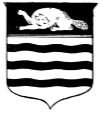
Ancient Arms
of Beverley.
But whether the inhabitants of the East Riding are living together in large communities or in small ones, they live at peace with one another; and any disorderly person who disturbs the peace of the community is quickly brought to book. Now, seeing that man is by nature somewhat inclined to be a quarrelsome animal, how is this very desirable state of affairs brought about?
The answer to this is that all the men, women, and children of the East Riding are living under certain wise laws by which their lives are governed. Probably they do not often recognise the fact that their lives are being governed or ruled. If they did, they would almost certainly begin to kick against the rules and say that it is an Englishman’s privilege to do just as he likes.
But that is just the secret of the quiet, peaceful lives led by the great majority of English people. They submit to 312be governed without their knowing it; and they do not realise that they are being governed because, very largely, they govern themselves.
The laws by which the lives of the inhabitants of the East Riding are ruled are made at Westminster by the British Parliament. This consists of two ‘Houses’—the House of Commons and the House of Lords.
Among the 670 men who make up what is called the House of Commons there are six who are chosen by the people of the East Riding to represent them in Parliament. The city of Hull supplies three of these; and the remaining portion of the East Riding supplies the other three. For voting purposes, when the elections of these Members of Parliament are held, Hull is split up into three Divisions—East Hull, West Hull, and Central Hull; and the rest of the East Riding is similarly split up into the Buckrose Division, the Holderness Division, and the Howdenshire Division.[71]
In what is known as the House of Lords the East Riding is represented—though not through the process of election—by the Earl of Londesborough, Baron Middleton of Settrington House, Baron Leconfield, Baron Deramore of Heslington Hall, and Baron Nunburnholme of Ferriby Hall.
But the British Parliament only says what the laws of the whole country shall be. To see that these laws are rightly administered, there are in London what are called ‘Government Departments,’ such as the Board of Trade and the Board of Agriculture. A great deal of the work of these Departments, however, cannot be conveniently carried on from London, and the country is therefore split up into Shires, or Counties, to each of which is given the 313work of seeing that certain of the laws made by Parliament are properly kept.
The East Riding of Yorkshire is one of these counties, and in addition to seeing that the laws of the country are properly kept, it has the duty of making less important laws which concern only its own inhabitants. The latter are known as by-laws, or, as the word is often written, bye-laws.
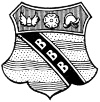
Modern Arms of
Bridlington.
Again, just as Britain is split up into different counties, each of which makes for itself the by-laws which it considers best, so the East Riding is split up into different portions, each of which makes its own by-laws.
This sort of arrangement is by no means a modern invention. A thousand years ago each ‘town,’ or group of farm dwellings, in the East Riding had its meeting to arrange the rules by which it should be governed. So also each ‘wapentake,’ or wider district, had its meeting, which was attended by representatives from the different ‘towns’ composing it. Lastly the whole ‘shire,’ the East Riding itself, had its meeting, attended by representatives from the different wapentakes.
Now we will see how this very ancient system is followed out to-day; but first we must put on one side the city of Hull, and the towns of Beverley, Bridlington, and Hedon.
Taking the rest of the East Riding, what was the tūn mōt of the Angles is our Parish Council. There are in the East Riding 131 Parish Councils, each of which is attended by chosen representatives of the village or township, and each of which looks after its own good management of affairs.
Similarly the waepentac or hundred mōt of the Angles is our Urban or Rural District Council. In the East Riding there are eight groups of townships to which the name 314‘Urban District’ is given; these have for their respective centres Cottingham, Driffield, Filey, Hessle, Hornsea, Pocklington, Norton, and Withernsea. There are also twelve groups of townships which we know as ‘Rural Districts.’
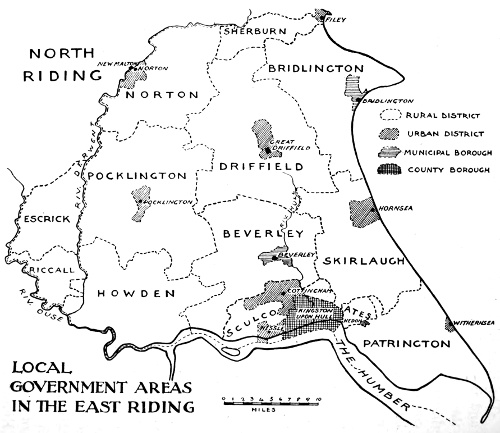
LOCAL GOVERNMENT AREAS IN THE EAST RIDING
As you will see from the map on this page, the difference between an Urban and a Rural District is that 315in the latter the people are spread over a much wider area than in the former. The Urban Districts are, in other words, the more thickly populated parts of the country.
Similarly, too, the scīr mōt of the Angles is the County Council of our day. This exercises authority over both the smaller Councils.
The East Riding County Council is made up of representatives from different districts throughout the County, and consists of:—
/* Members elected for Beverley 4 Members elected for Bridlington 3 Members elected for the rest of the East Riding 45 — Total of Elected Members 52 County Aldermen 17 — Total of Members 69 */
For purposes of local government the city of Hull is entirely, and the towns of Beverley, Bridlington, and Hedon are partly, outside the East Riding. Hull ranks as a County Borough, its full title being the ‘City and County of Kingston-upon-Hull,’ and it is governed by a Corporation, consisting of a Mayor, sixteen Aldermen, forty-eight Councillors, a Recorder, and a Sheriff.
Beverley, Bridlington, and Hedon rank as Municipal Boroughs. That is equal to saying that at some time or other each has received from the reigning Sovereign a charter granting it the right to rule its own affairs. Each Municipal Borough has a Mayor for its chief townsman.
In addition to their Mayors, Beverley and Bridlington have each six Aldermen and eighteen Councillors, while Hedon is governed by its Mayor, three Aldermen, and nine 316Councillors. For the election of Councillors Bridlington is divided into three wards—Bridlington Ward, Quay Ward, and Hilderthorpe Ward—and Beverley into two. The latter are named respectively Minster Ward and St. Mary’s Ward.
The work to be got through by a County Council or a Town Council is so large in amount that the members would not be able to carry out their duties satisfactorily if they did not arrange themselves in groups or Committees, each of which can undertake one kind of work. Often these Committees are again arranged in Sub-Committees.
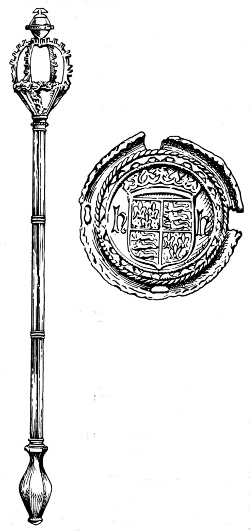
The Hedon Mace—the
Oldest Civic Mace in
England.[72]
Thus the sixty-nine members of the East Riding County Council arrange themselves in the following nine groups, each of which has its Chairman and Deputy Chairman:—
Each Committee conducts the affairs entrusted to it, and makes reports to the whole Council at stated intervals.
The Finance Committee examines and recommends for payment all bills and accounts; it also has the management and control of all County Council buildings.
The Cattle Plague Committee deals with the outbreak of contagious diseases on farms—such as swine fever, foot and mouth disease, sheep scab, and the most dreaded anthrax. It has to see that the various Acts of Parliament concerning these are fully carried out. Hence it may have to order the immediate slaughter of all the cattle or sheep on a farm, or perhaps to order that no animals are moved from one farm to any other. Should there be during a hot summer a plague of destructive insects, it issues instructions to farmers how to fight the plague, and moreover it can compel farmers to carry out these instructions.
The work of the General Purposes Committee is very varied. It is concerned with the protection of wild birds during the nesting-season, the testing of the weights and measures used in some seven thousand shops, the inspection of places where ‘Living Pictures’ are shown, the granting of licenses for these, and the choice of places at which men and women shall record their votes at the time of an election.
Under the notice of the Public Health Committee come all proposals for the planning of new town-districts and all those dealing with sanitation; under the Small Holdings Committee come all requests for allotments. The applicant for an old-age pension must prove to the Old-Age Pensions Committee that he or she is seventy years old, and has not a greater income than £31 10s. a year. The control 318and repair of roads and bridges, and the management of the County Asylum at Walkington, are in the hands of the Highways and Bridges Committee and the Asylums Committee.
But of greatest influence over the lives of schoolboys and schoolgirls is the work of the Education Committee. The work is felt to be so important that the Committee is divided into Sub-Committees. These are called respectively:—

Crest of the East Riding
County Council.
Each of these Sub-Committees has its particular work, the nature of which can be recognised from its name. The Sub-Committee which exercises, perhaps, the greatest amount of influence is that whose name stands first in the list. It is the Higher Education Sub-Committee, which provides funds for the carrying on of the Bridlington, Pocklington, and Beverley Grammar Schools; which founded the Bridlington and Beverley High Schools for Girls; which provides the villages of the East Riding with lectures on Dairy Farming, Poultry Keeping, Gardening, and Beekeeping; which organises classes for Cookery, Laundry-Work, 319Dressmaking, Carpentry, Wood-Carving, and Domestic Economy; which grants Scholarships to deserving boys and girls who wish to continue their education at a Secondary or a Technical School.
A very special kind of work carried on by the East Riding County Council is that known as the Registration of Deeds. As a result of this work the Council possesses a record of all sales of land in the East Riding since the year 1706. There are only two counties in Britain that keep such records, Yorkshire being one and Middlesex the other.
For carrying on its numerous branches of work the County Council needs large supplies of money. In the year 1901–2 its total receipts were £61,760; in the year 1910–11 they had grown to £190,927. These figures show how the work of the Council increased during the nine intervening years.
About one-fifth of this large sum of money is provided by the Government, the rest of it by the inhabitants of the Riding. The latter is made up of rates, rents, licenses for traction engines and motor cars, fees for pedlars’ and chimney sweeps’ certificates, fines imposed by magistrates, and so on.
Of course very accurate accounts have to be kept of all items of Income and Expenditure. In the accounts for 1910–11 there are such items as the following:—
| Income Account:— | £ | s. | d. |
| Charge for Loan of Hose Pipe | 0 | 15 | 0 |
| Sale of Old Hurdles, etc. | 0 | 8 | 3 |
| Cash found on Drowned Person | 0 | 16 | 6 |
| Expenditure Account:— | |||
| Caution Posts—Painting and Repairing | 18 | 9 | 6 |
| Skerne—Tree-Topping | 2 | 9 | 0 |
| Taking Samples of Bread and Expenses | 0 | 0 | 1 |
All moneys received and all moneys paid away must be 320accounted for, and the accounts for 1910–11 show that for the whole year the Receipts amounted to £190,927, while the Payments amounted to £191,161. You may, perhaps, think that you see in these figures something like a mathematical impossibility; but that is only because you have not reached the higher stages of commercial arithmetic.
The meetings of the County Council and those of its different Committees and Sub-Committees are held at the County Hall, Beverley.[73] That is the reason Beverley, though only a small town, is called the ‘Capital of the East Riding.’
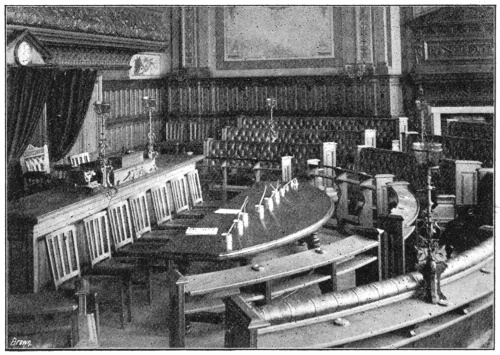
The Council Chamber at the County Hall, Beverley.
The full meetings of the Council take place in the Council Chamber four times each year—in the months of 321January, May, July, and October. Each meeting is presided over by the Chairman, or in his absence, by the Deputy-Chairman; and the conduct of the meeting is in accordance with a set of rules known as the Standing Orders of the East Riding County Council. To each resolution brought forward and put to the vote the members give their assent, or refuse it, by the words Aye and No.
Both the County Council and the Town Councils have a body of officers to see that their wishes are properly carried out. They comprise a Clerk, Treasurer, Accountant, Surveyor, Medical Officer of Health, Inspector of Weights and Measures, Analyst, and so on, down perhaps, to the Gardener. In the case of the County Council the adjective County is prefixed to the name of the office; in the case of a city or town, the word Borough. The chief officer in each is known as the Clerk of the Council and the Town Clerk.
The Urban and Rural District Councils, and also the Parish Councils, have each a smaller body of officers whose duties resemble those of the officers mentioned above.
To have behind it a history that goes back certainly for eight hundred years, and in all probability for a thousand, is something of which a school may be proud. Such is the rightful boast of the Beverley Grammar School.

Arms of Beverley Grammar
School.
As far back as the year 1100 there is mention of the schoolmaster in the Minster records. But the earliest known mention of the school is contained in a letter written in 1276 by Walter Giffard, Archbishop of York, to his bailiff at Beverley. In this letter the bailiff is directed to
maintain John Aucher and his two companions attending school at Beverley from Michaelmas last, 322with 2s. a week, and their small necessaries in fitting style; and pay 36s. for three gowns for their use.
But centuries before this the Beverley Grammar School must have been in existence. For it was part and parcel of the Collegiate Church of Saint John of Beverley, and one of the first duties of a collegiate church was to establish and maintain a school for the education of youth. Therefore, just as the Minster of St. Peter at York maintained a school—and a very famous one too—as early as the year 730, so the Minster of St. John of Beverley will undoubtedly have maintained a school for many years before the Norman Conquest. Its foundation is, in fact, believed to date from the eighth century.
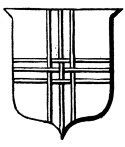
Arms of Howden
Grammar School.
(Originally the Arms of Bishop Skirlaw)
Beverley Grammar School is, far and away, the oldest school in the East Riding. But not long after, if not before, the date of the first written evidence of it, there was in existence another East Riding School—the Howden Grammar School. Its origin was similar to that of the Beverley school, for in 1265 the parish church of Howden was turned into a collegiate church, and the rector was replaced by a body of canons, whose duty it became to establish a school. This duty they fulfilled, and the 323Howden Grammar School thus came into being some time before 1312.
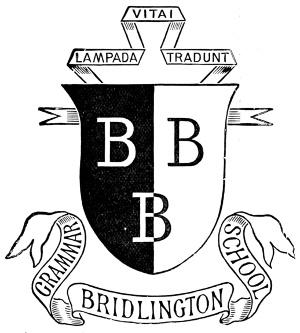
Arms of Bridlington Grammar School.
The beginnings of Bridlington Grammar School are shrouded in mystery. It was originally a school attached to the Bridlington Priory, and its earliest mention occurs in a document promising that a royal grant formerly paid to the ‘Prior and Convent of St. Marie, Byrdlington,’ should be continued, whereas other similar grants were then being withdrawn. This was in the year 1450.
The fact that this document was issued by King Henry VI. gives the Bridlington Grammar School some claim to the title of ‘A Once Royal School.’ The royal grant was made—using the King’s words—‘for the great affection and singular devotion that we have to the glorious confessor, Saint John of Bridlington’; and by it the Prior and Canons of Bridlington were bound
as in finding of XII. Quarasters, and a maister to teach them both gramer and song.
The Hull Grammar School is a notable example of a chantry school. It owes its existence to the piety of John 324Alcock, Bishop of Rochester, who in 1482 founded ‘The Chauntrie of Bisshoppe Alcocke in the parish churche of the Trinities in Hull.’
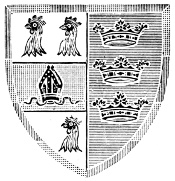
Arms of the Hull
Grammar School.
This means, in other words, that the founder purchased lands and gave them to the Church, on the understanding that the rent of these lands was for ever to be used for the stipend of a priest who should each day
at th’aulter of Our Ladie and St. John the Evangelist ... pray for the soules of King Edward IV., the founder, and all christien sowles.
But Bishop Alcock’s chantry priest was to do more than this. For the license granted by the King states that he
is bounde to kepe a fre scole of grammer within the saide towne of Hull, and teche all scolers within the saide towne of Hull, and teche all scholersscholers thither resorting, without taking any stipend or wages for the same, and should have for his own stipende £10, and shoulde paie yerelie to the clarke to teche children to sing 40s., and to 10 of the best scolers in the scole every of them 6s. 8d. by yere.
The Grammar Schools of Hull and Pocklington resemble each other in that each was founded by a distinguished churchman and associated with a parish church. As John Alcock, Bishop of Worcester, founded the one, so John Dowman, Canon of St. Paul’s and Archdeacon of Suffolk, founded the other.
But whereas the Hull school was founded in connection with a chantry, the Pocklington Grammar School was 325closely associated with a Religious Gild. Its foundation deeds—dated 1514—speak of it as the foundation of
the Master, Wardens and Brethren of the Brotherhood or Gild of the Name of Jesus, the Blessed Virgin Mary and St. Nicholas in the parish church of Pocklington.
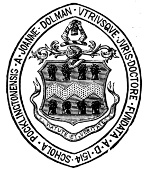
Arms of Pocklington
Grammar School.
The same deeds state that the founder, John Dowman, endowed the school with lands sufficient to pay £13 6s. 8d. a year to the Master and Wardens of the Gild for
finding with the same a fit man sufficiently learned in the science of grammar to teach and instruct all and singular scholars resorting to the town of Pocklington for the sake of education.
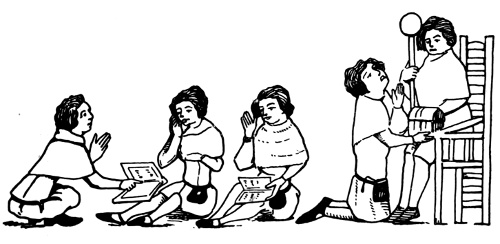
At School in the Fourteenth Century.
(From an old Manuscript).
Each of the five East Riding Schools mentioned has been spoken of as a Grammar School. This name exactly 326describes their purpose; for they existed in order that boys might learn the mysteries of Latin Grammar. Together with the study of this went the reading of Latin authors, usually taken in the following order:—Aesop and Terence, Vergil, Cicero, Sallust and Cæsar, Horace and Ovid.
If you should find yourself wondering why this great attention to the study of Latin, there is a very simple explanation to be given. Latin was then the universal language of professional men. It was written, spoken, and read by all those of the educated classes. Priests, doctors, lawyers, merchants—all used it. The building-accounts for the Beverley North Bar are written in Latin, the Minster records are written in Latin, the Town records are written in Latin. A knowledge of Latin Cwas the gateway to a commercial as well as a professional career.
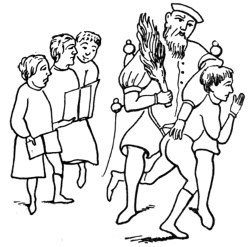
Part of the Seal of a
Lincolnshire Grammar
School, a.d. 1552.
Until 1349 it was the custom for boys to translate their Latin authors into Norman-French, this being the ordinary language of ‘gentlefolk.’ But then the change of making English the medium of translation was introduced; and thirty-six years later an English chronicler lamented that, because of the change, ‘grammar-school children knew no more French than did their left heel.’
What a lively time the schoolboy had in those ‘good old days’! Hours of study, from early morning till bedtime; subjects taught, Latin grammar and Latin authors—these being plentifully varied with such pleasant interludes as that pictured in the seal of Louth Grammar School. Little 327wonder that Shakespeare, himself an ‘old boy’ of the Stratford-on-Avon Grammar School, had memories of
Little wonder, also, that in the churchwardens’ accounts for Howden there occur numerous payments for ‘glasse for repairing the schollehouse windows.’ Boys will, of course, be boys, as long as the world lasts, and even in the seventeenth century they had to work off their excess of high spirits somehow or other.
Grammar Schools were not the only class of schools in existence during former days. There were two other kinds. Song Schools were closely connected with the services in large churches. They ranked below the Grammar Schools, and their scholars were taught to read, write, and figure, as well as to sing the various portions of the church service. The Choir School attached to Holy Trinity Church, Hull, is a modern representative of the mediæval Song School.
Of less rank, again, were the Reading Schools. Populous towns might possess a school of each kind, as did Howden in 1401. But often the Song School and the Reading School were combined in one; and sometimes, as at Bridlington, the Grammar School was also a Song School.
But generally the vicar or the chantry priest was the master of the Grammar School, while the parish clerk was the master of the Song School. Any decrepit old man who had sufficient learning, but who had fallen on evil days, might be the master of the Reading School; where it would be his duty to teach the petits, or little ones, their ABC. Sometimes the petits had their name changed into English, and were then known as the Petties, or as the ABCies. 328The latter of these two names was usually written in a very quaint form—abseies.
In the extracts from the foundation deeds of the Hull and Pocklington Grammar Schools given on pages 325 and 326 are two noticeable points. First, in both the master is to teach all boys who may come to the school, and in the one first quoted it is expressly stated that he is not to take ‘any stipend or wages for the same.’ The school was to be a Free Grammar School.
This does not mean that no charges at all were to be made. The teaching was free; but all boys were expected to pay for luxuries, such as fires, candles, writing and washing materials, cock-fights, and birchings. Cock-fights, especially on Shrove Tuesday, were a regular school institution, and Pocklington Grammar School still preserves its silver cock-fighting bell. Doubtless school cock-fights were well worth a special fee, but fancy having to pay a fee for the privilege of being birched—a sure case of insult added to injury!
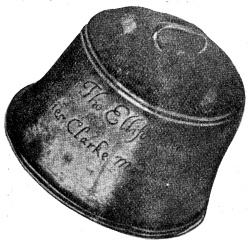
Ancient Cock-Fighting Bell of
Pocklington School, a.d. 1666.
Boarders, too, were not kept for nothing. Far from it. John Aucher and his two companions at Beverley Grammar School had their board paid for at the rate of 8d. each per week, and they were also provided with pocket-money for their ‘small necessaries.’
329The foundation of a Free Grammar School was looked upon as a great benefit to the town in which it was established. This we see clearly in the complaint made in 1660 by the Vicar of Pocklington on behalf of the inhabitants of the town. The complaint stated that there were then
not above eight or nine little boys in the school, whereas formerly, by the pains and industry of some former masters, there had been six or seven score scholars in our school, of which three or four score of them hath been tablers, gentlemen’s sons, which was a great benefit to this our town.
Secondly, the salaries paid to the masters of the Hull and Pocklington Grammar Schools are interesting. The Pocklington master was to be paid £13 6s. 8d. a year, the Hull master £3 6s. 8d. less. But in a few years’ time the salary of the latter had risen to be almost as high as that of the more-favoured master at Pocklington.
In 1548, ‘John Olyver, Bachelor of Artes, incumbente, being of thaidge of 46 yeres, of honeste conversacione and lyvinge, and well lerned,’ was to receive a ‘yerely stipend of £13 2s. 3d.’ Shameful to say, this was not paid in full, the amount actually received by John Olyver being first £13 2s. 2¾d., and later £13 2s. 2½d. Then, the source of income becoming stopped, the poor master got nothing, until the Mayor and burgesses took up his cause and successfully sued the Court of Exchequer for the amount due yearly.
With the Reformation there came in 1548 what was called the Chantries Act. This, by confiscating their revenues, put an end to all such chantries as that founded by Bishop Alcock. It proved also a death-blow to all Song Schools and to many Grammar Schools. Their ancient endowments were seized by the Government, which engaged itself to replace the endowments of the Free Grammar Schools with 330fixed annual payments; but as it promptly forgot all about its engagements these did not prove of much value.
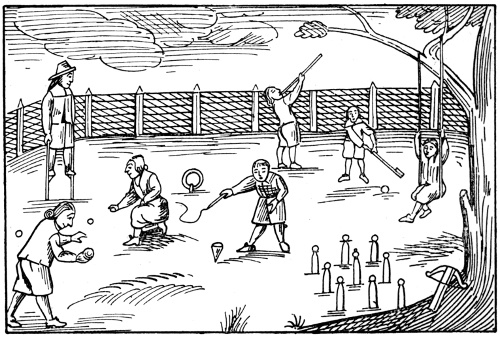
A Boys’ Play-Ground in the Seventeenth Century.
Under these circumstances the inhabitants of Beverley made known their grievances to King Edward VI. Their town was, they said—
a market towne and the greatest within all Estryding of your Majesties countie of York, having a grete nombre of youthe within the same, and fife thowsaund persons and above, whereof some of them be apte and mete to be brought up in learning, whiche are not, for so much as there is neither gramer schole, or any other schole, as yet founded, wherewith they might be brought up in any vertuous studdie.
No satisfactory reply was forthcoming to the inhabitants’inhabitants’ petition that the King would, out of the confiscated revenues 331of the Minster of St. John, found ‘one Fre Gramer Scole’ in their town. So it was left to the Town Governors to take over the finances of the old school. The school which had its origin in the Minster was thus re-established by the Town—an historic event which is embodied in its modern coat-of-arms.
The town records contain mention of many interesting payments made on behalf of the school by the Town Governors. In 1567 there occur the following:—
| Item gyven to the Schole maister his players | 17s. | |
| Item payd to the waits for playing when the Schole maister’s players played | 3s. | 4d. |
In 1606 a new school was built in the Minster Garth, and during the following years there are several records of the purchase of books for the school:—
| Item for a dictionary for the Schollers | 3s. | 4d. |
| Item for another booke bought at Crossfaier, and for bringinge one fro Cambridge | 6s. | 6d. |
| Item for a booke and for chaines for two other bookes in the schole | 18s. | 10d. |
The Beverley Grammar School still possesses its ancient library of books; among which are an edition of Vergil printed in black letter at Florence, one of Terence printed at Paris in 1552,1552, one of Cicero printed at Basle in 1553, and a very early edition of Foxe’s Book of Martyrs, containing gruesome illustrations of practical methods of torture. But there is now no need for chains to preserve these books from being surreptitiously ‘borrowed.’
The Grammar School at Hull also had its revenues confiscated, but these were afterwards in part restored. In the reign of Queen Elizabeth the school was rebuilt, mainly at the expense of Alderman Gee, who contributed for the 332purpose the sum of eighty pounds and twenty thousand bricks. In his will, Alderman Gee put a further bequest thus:—
I give and bequeath to the schoole of Hull which I builded through God’s goodnes, two houses in the Butchery.... I give these houses for ever for and towards the said Schoolmaster’s fee for his good teachinge and bringinge upp youth.
Pocklington Grammar School was saved through the efforts of Thomas Dowman, the nephew of its founder, who obtained a private Act of Parliament to continue the existence of the school.
What happened to Bridlington Grammar School is uncertain. But we know that in 1636 an inhabitant of Bridlington, by name William Hustler, gave ‘forty pounds yearly out of his estates for the maintenance of a schoolmaster and usher in a school-house, by him to be founded and erected.’ This endowment still forms a part of the revenues of the school.
Howden Grammar School also managed to survive, and lives to-day in the side chapel of the parish church that has been its home for several centuries.
Other smaller Grammar Schools, founded by private individuals, formerly existed in the East Riding. Marmaduke Langdale founded one at Sancton in 1610, Lord D’Arcy founded another at Kilham in 1633, and John Blanchard in 1712 left funds for the salary of a grammar school master at Barmby-on-the-Marsh.
We have now reached the beginning of the eighteenth century, and there has so far been no mention made of Girls’ Schools. The reason is not far to seek. There were no schools for girls in the far-off days when the Grammar Schools of Beverley, Howden, Bridlington and Hull came into being.being.
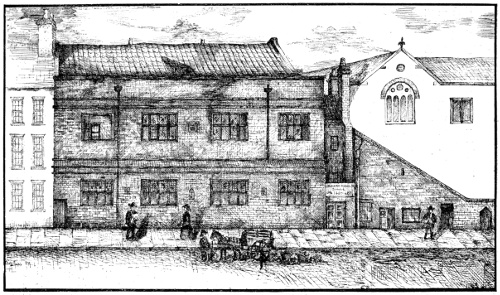
The Old Grammar School, Hull. Built 1583.
334Girls were then not considered to need any more education than that which they could get at home. To know how to cook a meal, to make wool into cloth, and to make cloth into clothes—what more was it possible for girls to learn? These very useful lessons they could learn at home. A few specially favoured girls of high birth were probably brought up and taught book-learning in some of the nunneries of the East Riding; but of this there are no records.
The first endowed school for girls as well as boys was founded in 1655, and from this date onward numerous girls’ schools came into existence. Some of these were styled Boarding Academies for Young Ladies; others of a humbler nature were known as Charity Schools.
One of the latter was that founded by Alderman Cogan at Hull in 1753. This provided clothing and instruction for twenty poor girls, each of whom could remain at the school for three years. The number of girls was afterwards increased to sixty. They wore white straw bonnets, brown merino frocks, and blue cloth cloaks, all trimmed with orange. The Cogan Charity School still flourishes, but the old-time charity costume is no longer worn.
Several old charity schools formerly existed in the towns of the East Riding. Bridlington had a Spinning School in which twelve poor girls were taught ‘carding, spinning, and knitting.’ Beverley had its Blue-Coat School for boys, a school afterwards amalgamated with the Grammar School; and three other Spinning Schools were in existence in Hull at the close of the eighteenth century.
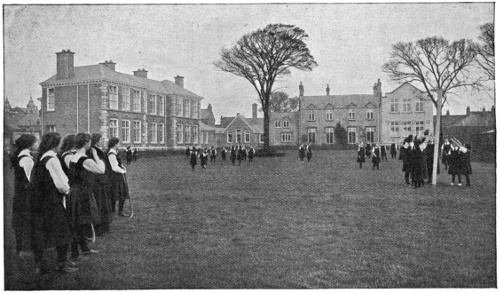
| Photo by] | [Turner & Drinkwater |
| The High School for Girls, Bridlington. | |
| (Founded 1905). | |
Of the same class is the Marine or Navigation School belonging to the Hull Trinity House. This, founded in 1786, now provides board, clothing, and education for about 150 boys, who are intended for a sea-faring life. So valuable is the education they receive in all that belongs to a sailor’s life, that each of the ‘white-ducked’ boys is said to ‘carry 336a captain’s certificate in his pocket’ when he leaves the school.
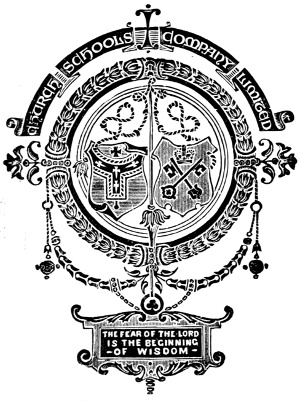
Seal of the Girls’ High School, Hull.
A school of a very special kind was that conducted on board the H.M. Training Ship ‘Southampton.’ The Southampton, an old ‘three-decker,’ after serving as a battleship in the early years of last century, was sent to the Humber to become a floating Industrial School. For forty-three years it fulfilled its duty, during which time some 2,600 boys were educated on it for a life at sea.[74]
In towns private schools of all classes were increasing rapidly when the nineteenth century opened. A Directory of Hull for the year 1831 shows that there were then in the town seven Ladies’ Boarding Academies, four Gentlemen’s Boarding Academies, twelve Classical and Commercial Academies, and no fewer than seventy-four Day Schools.
The following is the advertisement issued by the Principal of a Commercial and Mathematical Academy in 337the year 1787. In it the mysterious letters appended to the Principal’s name may be taken to stand for ‘Writing Master.’
GENTLEMENS’ CHILDREN are instructed in the first principles of English, so as to be enabled to read and write their native Language with elegance and propriety; the English Grammar agreeable to the strictest rules of Syntax, resolving a sentence into its different parts of speech. The free and natural method of Writing, and striking by command of hand; Arithmetic, Merchants’ Accounts, or the Italian Method of Book-Keeping; Mensuration; Gauging; Surveying of Land; Plain and Spherical Trigonometry; Euclids Elements; Navigation; Algebra, and the Use of the Globes.
YOUNG GENTLEMEN are Boarded and taught Geography, by familiar lectures, founded on rational principles and demonstration, and such as are of age and capacity taught to read Milton and Young, with proper emphasis and cadence.
Meanwhile many of the old Grammar Schools in England had fallen on very evil days. In 1840 some of those to which the term ‘decayed’ could be most fitly applied were 338converted into Elementary Schools. Twenty-four years later a Schools’ Enquiry Commission was appointed by the Government to enquire into the condition of the Grammar Schools throughout the country. The following are details from the report of the Commissioners.
At Beverley in 1865 there were only fifteen boys, and the school premises were ‘dirty and the furniture out of repair.’ At Hull no classics were taught; only two boys out of sixty-seven were learning French, and two German; Algebra and Euclid were ‘not attempted.’ At Sancton the children paid nothing, and ‘received instruction which was worth nothing.’ At Barmby-on-the-Marsh the vicar was receiving £97 from the Grammar School endowment, and out of it paying £2 to the village school.
Bridlington Grammar School was, we know, held in 1866 in a room near the Corn Exchange in the ‘Old Town’; and some eight or ten scholars were in attendance. It was then temporarily closed, and its funds were carefully nursed by Mr. Thomas Harland, who meanwhile succeeded in interesting others in its refoundation.
As the result of Mr. Harland’s labours, various funds were amalgamated, including those of the Spinning School previously mentioned; and eventually a site for the school was obtained, and new buildings were erected. These were opened in 1899 by Lord Herries, the Lord Lieutenant of the East Riding, and have since been twice enlarged.
It has been shown how Hull and Pocklington owe their Grammar Schools to pious founders. That the days of pious founders are not wholly past and gone, we have proved to us in the existence of Hymers College at Hull.
‘Hymers’ owes itself to two brothers, John and Robert Hymers, each a native of the North Riding and an ‘old boy’ of Sedbergh School.
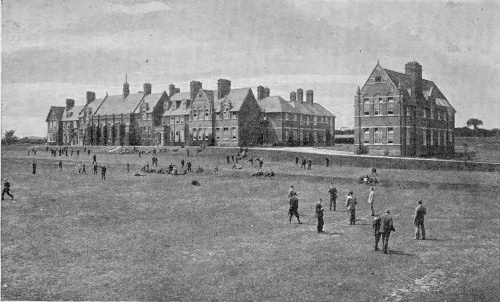
| Photo by] | [Turner & Drinkwater |
| Bridlington Grammar School. | |
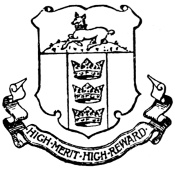
Arms of Hymers
College.
The elder of these two brothers, who was born in 1803 at Ormesby in Cleveland, became a distinguished mathematical scholar, and a Fellow of St. John’s College, Cambridge. Somewhat late in life he was appointed rector of Brandesburton, where he spent his last thirty-five years. On his death in 1887 it was discovered that he had left almost his whole fortune for the foundation of a Grammar School. The wording of a portion of his will ran as follows:—
And, subject to the payment of my debts ... I give and bequeath all the residue of my real and personal estate and effects whatsoever and wheresoever to the Mayor and Corporation of the port of Kingston-upon-Hull, in the county of York, wherewith to found and endow a Grammar School in their town on the model of the Grammar Schools at Birmingham and Dulwich, for the training of intelligence in whatever social rank of life it may be found amongst the vast and varied population of the town and port of Hull.
The amount of money thus bequeathed was roughly £200,000. But, unfortunately for the testator’s wishes, the will was declared to be null and void, because by the use of the words ‘found and endow’ it violated an ancient law. By the Statute of Mortmain, passed by Parliament in the year 1279, money might not be left to found and endow what was really a religious institution. Had the will said ‘to found or endow,’ things would have been all right. But, as it was, the Statute of Mortmain, though passed six hundred years before, was then still the law of the land; and in the eyes of the law the testator’s wishes counted for nought.
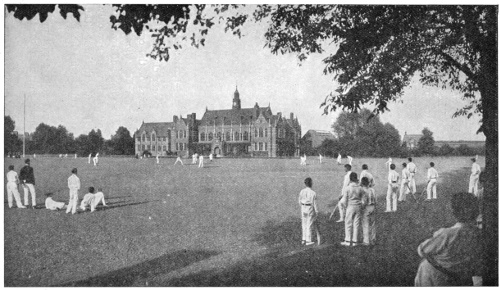
| Photo by] | Hymers College. | [Turner & Drinkwater |
342However, by the goodwill and generosity of the younger of the two brothers, a sum of £50,000 was devoted to the carrying out of Dr. John Hymers’ wishes. With this the estate known as the Botanic Gardens was purchased and the College buildings erected, a portion being set aside to provide the necessary endowment for carrying on the school. Within the last few years the Mayor and Corporation have provided funds for the addition of a wing devoted to the teaching of Science and Art.
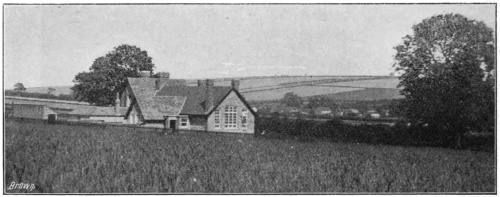
A Typical School on the Yorkshire Wolds—Luttons Ambo.
Right through the nineteenth century efforts were being made to give a real education to the poorer classes. The great force at work during the early years of the century was the National Society for Promoting the Education of the Poor. This Society was established in 1809, and by 1831 had more than 1300 schools; all of which were not only built but also carried on by voluntary subscriptions. Ten years ago there were 173 National Schools in the East Riding.
By the Education Acts of 1870 and 1880 a system of elementary education was established, and in 1891 this education became free.
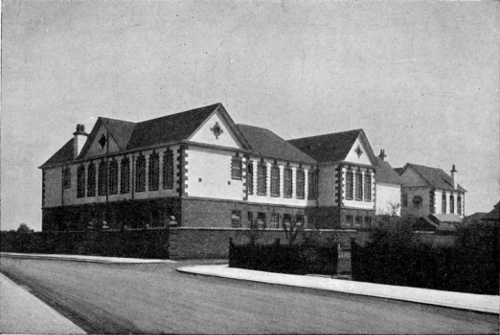
| Photo by] | [Parrish & Berry |
| A Modern City Council School, Southcoates Lane, Hull. | |
344Since the last-mentioned year the strides made have been enormous. The education of the children of the East Riding has been taken in hand by the East Riding Council, the Hull City Council, and the Town Councils of Beverley and Bridlington. Old and useless schools have been replaced by new and up-to-date ones; new Elementary, Secondary and Technical Schools, and High Schools for Girls have been built and equipped; and a School of Art and a Navigation School for adults have been established. Most important of all, however, is the system of Scholarships by which many boys and girls are now climbing from the village school to the ‘Varsity’ college.
A brief record of the most famous lives in local history. Each of the persons named was born in the East Riding, and living persons are excluded.
Saint John of Beverley. Born at Harpham, and died in A.D. 721. Became Bishop of Hexham and of York. Was canonised by the Church in 1037, and afterwards became one of the most famous saints of the north of England. See pages 135–140.
Alured, or Alfred, of Beverley. Born at Beverley in 1109. Became Treasurer of the Church of St. John of Beverley, and Abbot of the Cistercian Abbey of Rievaulx. Wrote a history in Latin, entitled Annals of the Deeds of the Kings of Britain, and a Life of St. John of Beverley.
345Roger of Howden. Born at Howden, and died in 1201. Became a Clerk, or Secretary, to Henry II., and later a King’s Justice for Yorkshire. Was the author of a Latin history of England from A.D. 732 to A.D. 1201.
William of Newburgh. Born at Bridlington in 1136. Was brought up at the Priory of Newburgh, and wrote in Latin a History of English Affairs, which takes rank as ‘the finest historical work left to us by an Englishman of the twelfth century.’ See page 269.
Peter of Langtoft. Born at Langtoft, and died in 1307. Was a Canon of Bridlington Priory, and author of a Chronicle of England, written in Anglo-Norman verse. See page 269.
John Hotham. Born at Scorborough, and died in 1336. Became Bishop of Ely, and twice Lord Chancellor of England.
John of Bridlington. Born at Thwing about 1324. Was successively Precentor, Almoner, Sub-Prior, and Prior of Bridlington Priory. Became so famed for his piety that after his death many miracles were believed to be wrought at his tomb.
Sir Michael de la Pole, first Earl of Suffolk. Born at Hull, and died in 1389. Became, successively, Mayor of Hull and Admiral of the King’s Fleets in the Northern Parts, a Knight of the Garter, Lord Chancellor of England, and the first Earl of Suffolk. His is the first example in British history of a prosperous merchant’s becoming a peer of the realm. See page 116.
Walter Skirlaw, LL.D., Born at South Skirlaugh, and died in 1406. Became Bishop, successively, of Lichfield, Bath, and Durham. Built the tower and chapter 346house of Howden, and Skirlaugh Chapel—now the parish church. Also built several bridges in the north of England, and helped to build the central tower of York Minster.
John Alcock, D.D. Born at Hull about 1428. Became Bishop, successively, of Rochester, Worcester, and Ely. Was a Privy Councillor and twice Lord Chancellor of England. Founded the Hull Grammar School and Jesus College, Cambridge. See pages 270–271.
John Fisher, D.D. Born at Beverley in 1459. Became Chancellor of the University of Cambridge, and Bishop of Rochester. Was famed for his ‘grete and singular virtue,’ and was beheaded on Tower Hill for refusing to acknowledge Henry VIII. as the ‘Supreme Head of the Church.’ Was largely instrumental in founding St. John’s College, Cambridge, and formed a library which was considered to be ‘the finest in Christendom.’ See pages 270–272.
Sir John Pickering, Kt. Born at Flamborough in 1544. Was the son of very poor parents, yet became a Privy Councillor and Lord Keeper of the Privy Seal. Was twice chosen Speaker of the House of Commons, and was knighted by Queen Elizabeth.
Sir John Lister, Kt. Born at Hull in 1585. Became twice Mayor of Hull, and was five times elected M.P. for his native city. Entertained King Charles I. on his visit to Hull in 1639. Founded in 1642 the ‘Lister Hospital’ for six poor men and six poor women.
Luke Fox. Born at Hull in 1586. Was a Younger Brother of the Trinity House, and revived the attempt to discover the North-West Passage, whence he gained the nickname ‘North-West Fox.’ Explored in 1631 the Channel west of Baffin Land which now bears his name.
347Thomas Lamplugh, D.D. Born at Octon, near Thwing, in 1615. Was a Fellow of Queen’s College, Oxford, and became successively Dean of Rochester, Bishop of Exeter, and Archbishop of York.
Sir Philip Monkton, Kt. Born at Cavil, near Howden, about 1620. Was a devoted supporter of King Charles I., for whom he fought bravely at the battles of Atherton Moor, Naseby, and Rowton Heath. Was knighted for his bravery in 1644.
Andrew Marvell. Born at Winestead in 1621. Was an ‘old boy’ of the Hull Grammar School, became Assistant Latin Secretary to the Council of State, and was M.P. for Hull for nineteen years. Also gained considerable reputation as a poet, but is best remembered as ‘a pure-minded patriot in the most corrupt times.’ See pages 272–275.
Christopher Nesse. Born at North Cave in 1621. Was the son of a husbandman, but became a notable Non-conformist preacher, and suffered much persecution after the Restoration.
Thomas Watson, D.D. Born at North Ferriby in 1637. Was the son of a seaman, and an ‘old boy’ of the Hull Grammar School. Became a Fellow of St. John’s College, Cambridge, and afterwards Bishop of St. David’s. Was a liberal benefactor to his old school, and rebuilt the alms-houses known as ‘Watson’s Hospital.’
Richard Boyle, K.G., third Earl of Burlington. Born at Londesborough in 1695. Was Lord Lieutenant of the West Riding of Yorkshire, and Lord High Treasurer of Ireland. Became famous as an amateur architect. Rebuilt Burlington House, London, and carried out large schemes of plantation at Londesborough Hall.
348Richard Osbaldeston, D.D. Born at Hunmanby, and died in 1764. Became successively Dean of York, Bishop of Carlisle, and Bishop of London.
John Green, D.D. Born at Beverley in 1706. Was an “old boy” of Beverley Grammar School, and became Dean of Lincoln and later Bishop of Lincoln. In 1772 was the only Bishop in the House of Lords ‘to vote in favour of the Bill for the relief of Protestant Dissenters.’
William Mason. Born at Hull in 1724. Was a son of the Vicar of Holy Trinity and became a Fellow of Pembroke College, Cambridge, and Chaplain to the King. Gained considerable renown as a poet, and would have been appointed Poet Laureate but for his political opinions.
Sir Samuel Standidge, Kt. Born at Bridlington Quay in 1725. Took a leading part in establishing the Greenland Fishery Trade, and fitted out a ship for the discovery of the North Pole. Was knighted when Mayor of Hull in 1795, and was four times elected Warden of the Hull Trinity House.
Sir Christopher Sykes, Bart. Born at Roos in 1749. Was distinguished as a mathematician, architect, banker, and M.P. for Beverley. Refused a baronetcy from Mr. Pitt, but asked that it should be given to his father, the rector of Roos.
Robert Thew. Born at Patrington in 1758. Was the son of an innkeeper, and became engraver to the Prince of Wales.
William Wilberforce. Born at Hull in 1759. Became M.P. for his native town at the age of twenty-one, and was for twenty-eight years one of the two M.P.’s for Yorkshire. Devoted his whole life and all his wealth to obtaining the Abolition of Slavery in the British Colonies, the Act for which was passed a few days after his death in 1833. See pages 275–279.
349Adrian Hardy Haworth. Born at Hull in 1767. Became a renowned botanist and entomologist, and formed a collection of 40,000 insects, the most important of which are now in the British Museum.
Sir Benjamin F. Outram, Kt., M.D. Born at Kilham about 1770. Entered the Medical Naval Service, and became Medical Inspector of Naval Hospitals. Was knighted in 1850.
Sir Mark Masterman Sykes, Bart. Born at Sledmere in 1771. Was M.P. for the city of York for thirteen years. RaisedRaised in 1802 two squadrons of Yeomanry, known as the ‘East Yorkshire Wold Yeomanry.’ Was a great lover of books, and formed at Sledmere ‘one of the finest private libraries in England,’ which in 1824 was sold for £20,000.
Sir Tatton Sykes, Bart. Born at Sledmere in 1772. Devoted himself to sheep-farming and the breeding of race-horses, and, by the introduction of bone manure, wrought great improvements in the cultivation of the Wolds. Was a fearless sportsman, and a true specimen of ‘The Fine Old English Gentleman.’ See pages 279–281.
Thomas Jackson. Born at Sancton in 1783. Was the son of a farm labourer, and became ‘in spite of the adverse circumstances of poverty and lack of education,’ a famous Wesleyan divine. Was twice elected President of the Wesleyan Conference.
William Spence, F.R.S. Born at Bishop Burton in 1783. Was an ‘old boy’ of Beverley Grammar School, and became one of the founders of Blundell, Spence, & Co., Ltd., Hull. Was deeply interested in Entomology, and was one of the authors of Kirby and Spence’s Introduction to Entomology, the most popular natural history book of its day.
350Sir James Alderson, Kt., M.D., F.R.S. Born at Hull in 1795. Succeeded his father as physician of the Hull Royal Infirmary, and became President of the Royal College of Physicians. Was knighted by Queen Victoria in 1869.
Frederick Huntingdon, M.D. Born at Hull in 1796. Was surgeon of the Hull Royal Infirmary for thirty-four years, and is recorded on his monument in Christ Church, Hull, as ‘one of Nature’s gentlemen, whose life was passed in doing good.’
James Hall. Born at Scorborough in 1801. Was a ‘model country squire ... and a devoted upholder of English field sports,’ and held the Mastership of the Holderness Hunt for thirty years.
Sir Henry Cooper, Kt., M.D. Born at Hull in 1807. Was physician of the Hull Royal Infirmary for twenty-seven years, and as Mayor of Hull was knighted when Queen Victoria visited the town in 1854. Was the first Chairman of the Hull School Board, and has his memory perpetuated in the ‘Sir Henry Cooper Schools.’
Thomas Earle. Born at Hull in 1810. Was a gold medallist of the Royal AcademyAcademy, and designed the statue of George the Fourth in Trafalgar Square, London, and that of Queen Victoria in Pearson Park, Hull, beside many others.
Sir James Hudson, K.C.B. Born at Bessingby in 1810. Entered the Government Service and held many important posts in the United States, South America and Italy. Was created a Knight Commander of the Bath in 1855.
Henry Dawson. Born at Hull in 1811. Was the son of poor parents, and became a self-taught artist. Struggled hard against adversity, and gained renown as a landscape painter only towards the end of his life.
351Hugh Edwin Strickland. Born at Reighton in 1811. Was a notable student of natural history, and became Reader in Geology at the Oxford University. Was accidentally killed in a railway tunnel.
Charles Henry Bromby. Born at Hull in 1814. Was a son of the Vicar of Holy Trinity, and an ‘old boy’ of the Hull Grammar School. Became the first Bishop of Tasmania.
Sir Joseph Henry Gilbert, LL.D. Born at Hull in 1817. Became a distinguished scientist, and was knighted by Queen Victoria for his discoveries in agricultural chemistry.
Humphry Sandwith, C.B., D.C.L. Born at Bridlington in 1822. Travelled widely, became Inspector-General of Hospitals in the Russo-Turkish War, and helped to defend the fortress of Kars. Was decorated by Queen Victoria as a Companion of the Order of the Bath.
John Bacchus Dykes, Mus. Doc. Born at Hull in 1823. Was a grandson of the Vicar of St. John’s, and became Minor Canon and Precentor of Durham Cathedral. Composed more than two hundred hymn tunes, and was joint editor of Hymns, Ancient and Modern. After his death, a public subscription of £10,000 was raised in his honour to found musical scholarships.
Charles Alfred Lee, M.D. Born at Hull in 1825. Took a large share in the support of the Hull Royal Infirmary and the Newland Orphan Homes, and, on his death in January 1912, bequeathed £150,000 for the foundation of ‘Rest Houses’ for the aged poor.
Sir William Christopher Leng. Born at Hull in 1825. Was an ‘old boy’ of the Hull Grammar School. 352Took up journalism after some years spent as a chemist, and became the editor of the Sheffield Daily Telegraph. Was knighted for his public services in 1887.
The Hon. Sir John Hall, K.C.M.G. Born at Hull in 1824. Emigrated to New Zealand, entered Parliament, and became Premier in 1879. Was decorated by Queen Victoria as a Knight Commander of the Order of St. Michael and St. George.
John Robert Mortimer. Born at Fimber in 1825. Devoted more than fifty years of a long life to the most thorough exploration of the earthworks and burial mounds around Driffield, and did more than anyone else to extend our knowledge of the early inhabitants of the East Yorkshire wolds.
Charles Henry Wilson, first Baron Nunburnholme. Born at Hull in 1833. Became, in 1867, senior partner in the shipping firm of Thomas Wilson, Sons & Co., and built up the largest privately-owned fleet of steamships in the world. Sat in Parliament as M.P. for his native town for thirty-two years, and was raised to the peerage in 1906. See pages 280–283.
Arthur Wilson. Born at Hull in 1836. Became a partner in the firm of Thomas Wilson, Sons & Co. in 1867. Was a great sportsman, and was M.F.H. to the Holderness Hunt for twenty-five years. See pages 280–283.
1. Thríth-yunger
2. The weight of this tooth is 9½ lbs. One side has been worn down and polished smooth by the friction of the ice in passing over it.
3. Groups of circular pit-dwellings have been discovered at Bempton and at Atwick—the latter by Mr. William Morfitt, whose house at Atwick contains many ‘treasures’ which he has unearthed in the district around Hornsea.
4. The ‘Devil’s Arrows’ is the name by which three similar huge stones are known at Boroughbridge.
5. Pronounced Eb-oo-ráh-kum.
6. Pronounced almost as Yóv-er-wik.
7. Eń-gla, Sék-sa, and Yóo-ta, in pronunciation.
8. Pronounced, respectively, toon and hahm.
9. Pronounced, respectively, Wóh-den-ez-dag, Tée-wes-dag, and Frée-ga-dag.
10. É-orl, ké-orl, and thái-ow in pronunciation.
11. The place of meeting was either York or Londesborough.
12. Kóh-i-fi in pronunciation.
13. Pronounced week and beer, respectively.
14. There are more Danish place names in Lincolnshire than in all the rest of England south of the Humber. North of the Humber the largest number is to be found in the East Riding.
15. Pronounced exactly like the Anglian word wīc.
16. Pronounced yarl
17. This is the old Norse word for our ‘Villain!’
18. The holmgang was a duel fought according to fixed rules on a piece of ground specially marked out for the purpose. In earlier times it was fought on a holm, or island, whence the name.
19. Pronounced Yór-wik.
20. To ‘gang’ meant to walk, and Rolf the Ganger was given this nickname because, being extra tall, he found it more comfortable to walk when on land than to ride one of the small ponies of his native country.
21. Pronounced Kóp-si-ga.
22. Tharlesthorp is one of the ‘lost towns of the Humber.’ Its probable site is marked on the map on the opposite page.
23. A ‘carucate’ was the amount of land that a team of eight oxen could plough each year. It varied in size according to the nature of the soil, but may be roughly taken as being equal to 120 acres. An oxgang was one-eighth of this.
24. The value of money was in 1086 approximately twenty times its value at the present day. The Domesday ‘pound’ meant, not a coin, but a pound weight of silver.
25. The following are the internal areas of the three largest churches in Britain:—
| St. Nicholas’, Great Yarmouth | 25,023 | sq. ft. |
| St. Michael’s, Coventry | 24,015 | " |
| Holy Trinity, Hull | 21,756 | " |
26. The brickwork of the chancel and transepts of Holy Trinity, Hull, is probably the ‘earliest existing example of mediæval brickwork in England.’ These portions of the church were built during the first quarter of the fourteenth century.
28. This was a chapel, dedicated to the ‘Holy Trinitie,’ which James Helward, a townsman, founded in 1285. It stood where the chancel of Holy Trinity church now stands, and was pulled down when the present transepts and chancel were built a few years later.
29. In 1280 the monks of Meaux owned 11,000 sheep and 1000 beasts.
30. Close to this Carthusian monastery Sir Michael also built—in 1384—a Maison Dieu, or Hospital, for twenty-six poor men and women, ‘feeble and old.’ Its buildings were pulled down during the second siege of Hull, but afterwards replaced by others. This is the ‘Charterhouse’ that exists to-day, the present buildings dating from 1780.
31. The prayer with which the daily life began was this: ‘O Lord God Almighty, Who hast brought us to the beginning of this day, so assist us by Thy grace, that we may not fall this day into sin, but that our words may be spoken and our thoughts and deeds directed according to Thy just commands.’
32. A violin with three strings.
34. The name Minster became attached in mediæval times to the great churches which were not parish churches but were governed by a College, or body of secular canons.
35. A service held in memory of the death of a benefactor.
36. An old spelling of ‘Alfred.’
37. Acknowledged.
38. Dagger.
39. A flecher, or fletcher, was an arrow-maker.
Under such circumstances as these, it is not wonderful that complaints of the misuse of sanctuary rights became frequent. In 1324 ten prisoners escaped from Newgate Jail, of whom five took refuge in one or other of the London churches, and thence escaped out of the country. In 1376 Parliament complained to the King that certain people got money or goods on loan, made pretended gifts of all their property to their friends, then went into sanctuary, and stayed there till their creditors were glad to accept some small portion of the debt in payment for the whole; after which they came out, received back their pretended gifts, and lived merrily on their ill-gotten wealth. Cases even occurred in which thieves and murderers left their place of sanctuary at nightfall, committed fresh crimes during the night, and returned to the ‘chair of peace’ again before daybreak.
So great did the scandal of this misuse of the privileges afforded by sanctuaries eventually become, that in 1623 Parliament passed a law that:
No sanctuarie or priviledge of sanctuary shal be hereafter admitted or allowed in any case.
The law was again passed in 1697, but it was not until the reign of George I. that the last sanctuary in our country was demolished.
40. The total cost of the building operations, from the surveying of the ground to the ‘roseynyng’ of the doors, was £96 17s. 4½d.—about £2000 in our money.
41. The first Monday after ‘Twelfth Night,’ i.e. the Monday following January 6th.
42. The old ‘bull ring’ to which bulls were tethered at a bull-baiting in the market-place of Kilham is now built into the bank of the churchyard wall.
43. The French name for slippers.
44. Horse loaves were coarse bean bread, something like the modern dog-biscuit, and used as a winter food for horses.
45. This third demand resulted in the formation of the ‘Council of the North,’ which met at York during the next hundred years.
46. Sanctuary.
48. Jervaulx Abbey, in the North Riding.
49. A foder equals 2400 lbs.
50. Hundredweight.
51. The church of the Black Friary and the tower of St. Mary’s Church are very plainly shown in the older plan given on page 165.
52. In 1681 the North Blockhouse was abandoned, and a new Citadel built enclosing the Castle and the South Blockhouse. The whole was demolished about the middle of last century, with the exception of a small turret, which still remains built into the walls of the Humber Transport Company, but is shortly to be taken down and rebuilt in the West Park.
53. The King knighted his host during his visit.
54. In 1639 the military stores at the King’s Manor in Hull included 50 cannon, 200,000 muskets, carbines, pistols, and swords, 1,800 spades, shovels, and wheelbarrows, with powder, shot, and match to the value of upwards of £6000. Other stores of armour, powder, cannon balls, and musket shot purchased in Holland were added in the same year.
55. This passage, which connects Blackfriargate and Little Humber Street, was, in the seventeenth century, the only entrance to the town from the landing-place on the Humber. It is less than seven feet wide.
56. Rabbets are grooves cut in the edge of a piece of wood.
57. A reprint was published in 1905 by A. Brown & Sons, Ltd.
58. Small loaves of white bread.
59. Herons and Bitterns are known to-day in the East Riding as ‘herrin-sews’ and ‘buttherbumps.’
61. The floor of the Council Chamber at the Hull Trinity House is still strewn with rushes, these being changed about every six weeks.
62. The Prince was one of the five engines employed on the new line. The fastest non-stop run in the British Isles to-day is that made on the N.E.R. from Darlington to York, when 44-1/4 miles are covered in 43 minutes—an average speed of 61.7 miles per hour.
63. The Hull Dock Company became extinct in 1893, when its property was purchased by the North Eastern Railway Company.
64. The Albert Dock and the William Wright Dock are now combined into one, known as the Albert and William Wright Dock.
65. It is expected that this amount will be greatly increased within the next few years by the opening of new collieries around Doncaster, and the tapping of a new ‘Eastern Coalfield,’ which is believed to extend deep down under the Humber and the Wash, right out into the North Sea.
66. The first steamboat built in England was constructed in a yard off Wincolmlee, Hull, and was launched in the river Hull. This was in the year 1787, and the engine was patented the next year. The makers, Messrs. Furness & Ashton, afterwards built a larger steam-boat, which was put together in London and bought by the Prince Regent, who rewarded them with a pension of £70 each.
67.
| nobbut=only. | boon=ready. |
| helm=shed. | happen=possibly. |
| far-end=opposite side. | mud=might. |
| doots=fears. | whahl=until. |
68. Yat-stowp=gate-post.
69. The local pronunciation of ‘acre’ in the East Riding is yakker; so that the old sound of the word has been here kept, even though its meaning has universally changed.
70. In reading these, it should be remembered that the Norse J=y, AU=ow, EI or EY=ai, and V=w.
71. Hedon sent two members to Parliament from the time of Edward I. until 1832, when it was disfranchised as one of the ‘rotten boroughs.’ Beverley also was represented by two members till 1870.
72. This mace dates from the reign of Henry VI. In the enlarged portion are shown the lions of England quartered with the fleur-de-lis of France.
73. The meetings of the Hull City Council, and the Beverley, Bridlington and Hedon Town Councils are held in their respective Town Halls.
Sets out every Day about Half-past Three in the Afternoon, from Mr. BAKER’s, the Cross-Keys, in the Market-Place, HULL, and arrives at Mr. PULLEINE’s, the Tavern in YORK, in SIX HOURS; returns from thence about Half-past Twelve at Night, or immediately after the Receipt of the London Mail, and arrives at HULL early in the Morning.
No more than Four Inside and Two Outside Passengers will be taken.
Parcels from 3d. to 6d. if above a Stone Weight One Halfpenny per Pound.
For Places or Entry of Parcels, apply to Henry Cawood, at the Post-Office, Hull, Mr. Pulleine, York; Mr. Bland, Beverley, and to Mr. Gill, King’s Arms, Market-Weighton, from those Towns respectfully for Hull, York, London, or Edinburgh.
Conveyance may be secured for Passengers and Parcels from Hull to London (Fare 3l. 13s. 6d.) by the Mail Coach, the whole Way, except the Places be previously disposed of at York, in which Case Mr. Pulleine engages to send the Passengers forward in a Post-Chaise at the same Expence and accompanying the Mail Coach; the same from Hull to Edinburgh, 3l. 13s. 6d. or any intermediate Places at Fares in the Proportion of Distance.
The Public are respectfully informed that this RAILWAY will be OPENED THROUGHOUT from HULL to the JUNCTION with the LEEDS and SELBY RAILWAY, at Selby, on WEDNESDAY, the First Day of July next, and that PASSENGERS and PARCELS only will be conveyed on THURSDAY, July 2nd; thus presenting a direct Railway Conveyance from Hull to Selby, Leeds, and York without change of Carriage.
| AT SEVEN O’CLOCK, A.M. | AT THREE O’CLOCK, P.M. |
| AT TEN O’CLOCK, A.M. | AT SIX O’CLOCK, P.M. |
The Trains from LEEDS and YORK, for HULL, will depart from those Places at the same Hours; and Passengers and Parcels may be Booked through at the Leeds, York, and Hull Stations. Arrangements are also in progress for Booking Passengers to Sheffield, Derby, Birmingham, and London.
| First Class. | Second Class. | Third Class. | |
| Hull to Selby | 4s. 6d. | 4s. 0d. | 2s. 6d. |
| Hull to York | 8s. 0d. | 6s. 6d. | 4s. 6d. |
| Hull to Leeds | 8s. 0d. | 6s. 6d. | 4s. 6d. |
No Fees are allowed to be taken by the Guards, Porters, or any other Servants of the Company.
The Trains, both up and down, will call at the Stations on the Line, viz.:—Hessle, Ferriby, Brough, Staddlethorpe, Eastrington, Howden, and Cliff.
Arrangements for carrying Goods, Cattle, Sheep, &c., will be completed in a short time, of which due Notice will be given.
By Order,
GEORGE LOCKING, Secretary.
Railway Office, Hull, June 24th, 1840.
The table of illustrations has the wrong page (p. 116) for the image on p. 117, and has been corrected.
On pp. 206 and 207, a double-page view of Kingston-upon-Hull has been joined. A larger version of it can be viewed by clicking on the image..
Likewise, the map printed on the inside of the back cover, spanning two pages, has been joined, however imperfectly, given the original images. A larger version of it can be viewed by clicking on the image.
On pp. 241 and 248, there are facsimiles of documents. The caption of each serves as a link to a text transcription, which is included at the end of the text.
Errors deemed most likely to be the printer’s have been corrected, and are noted here.
| 52.5 | we have no means of knowing[.] | Added. |
| 100.12 | the records remain[s] to our day. | Removed. |
| 115.28 | to hold this office[.] Thus | Added. |
| 116.2 | Edward III[.], so his son | Added. |
| 118.16 | Shakspeare’s [P/p]lay | Replaced. |
| 134.2 | themselves in populous towns[.] | Added. |
| 148.30 | your dewte in ryngyng....[’] | Added. |
| 187.31 | of the building[.] They were a wealthy | Added. |
| 215.32 | [s]ustained during the war. | Added. |
| 227.24 | Let the best fashioned and apparrell[ /e]d Servants | Replaced. |
| 231.21 | This was between the years 1703 and 1753[.] | Added. |
| 245.11 | horses could not[,] contend against the wind. | Removed. |
| 296.1 | and Strong Beer.[’] | Added. |
| 324.20 | teche all [scholers] thither | sic |
| 330.14 | to the inhabitants[’] | Added. |
| 331.24 | at Paris in 1552[./,] one of Cicero printed | Replaced. |
| 332.33 | Bridlington and Hull came into being[.] | Added. |
| 349.11 | R[o/a]ised in 1802 two squadrons of Yeomanry | Replaced. |
| 350.22 | Royal A[d/c]ademy | Replaced. |